Physical Address
304 North Cardinal St.
Dorchester Center, MA 02124
According to the Centers for Disease Control and Prevention (CDC), unintentional injuries are the leading cause of death in Americans under the age of 45 years, with motor vehicle collisions, firearms, falls, cutting/piercing instruments, and burns among the leading mechanisms. Decreasing mortality in trauma requires an understanding of the trimodal distribution in the timing of death after a trauma. The first peak encompasses over half of all trauma deaths, occurring minutes after the injury as a result of catastrophic central nervous system injuries and major vascular trauma. The initial trauma assessment focuses on identifying ongoing bleeding, managing traumatic brain injury (TBI), and preventing the potentially survivable deaths that occur in the second peak. The second peak occurs hours following the trauma, in which a patient may be transported to a trauma center where interventions can be enacted. The third peak occurs days to weeks after the injury, with deaths resulting from late complications and infections. With the improvement in critical care, there has been a notable decrease in late trauma mortality.
A rapid, systematic, and thorough initial trauma assessment is paramount to providing care to the critically injured trauma patient. Effective trauma care begins with a complete team and facility preparation before the arrival of the patient. Although the basic principles of Advanced Trauma Life Support (ATLS) are taught and used across the country, each hospital has unique considerations in the delivery of care to their region and population. Each trauma team leader should have an understanding of the center’s resources, personnel, and limitations in caring for a critically ill patient. The logistic considerations at a level I trauma center will be different from a rural level III or IV trauma center. Level II, III, and IV centers may require more coordination in obtaining equipment and personnel who may be offsite. Additionally, trauma centers should have a good understanding of severe mechanisms of injury and injury patterns that should warrant a transfer to a level I trauma center if able.
The trauma facility should have a designated room for trauma assessment and resuscitation with space for personnel and equipment. Standard available equipment should include personal protective equipment, x-ray and an x-ray–compatible stretcher, and cardiac and vital sign monitors. Necessary ancillary equipment for procedures including airway supplies, chest tubes in a variety of sizes, instrument trays, thoracotomy trays, nasogastric tubes, urinary catheters, central venous catheters, fluid warmers, a massive transfuser, and ultrasound should be available and easily accessible. This equipment list is not comprehensive and should be thoughtfully composed and audited by the multidisciplinary trauma team.
General and trauma surgeons play a critical role on trauma teams as the leaders of the initial evaluation and resuscitation. A trauma team should consist of a prerequisite number of personnel to perform the primary survey and necessary procedures. All team members should have clearly defined roles before reception of the trauma patient. Emergency medicine physicians also play an integral part in triage and assessment. A trauma system requires a strong working relationship between emergency medicine physicians and surgeons to provide coordinated care for injured patients. The role of an emergency medicine physician may be variable including performing much of the primary evaluation and procedures before the availability of a surgeon. Nursing staff are additionally vital to the initial care of a trauma patient. As the team is performing the assessment, nursing staff should be placing intravenous (IV) catheters, drawing blood samples, connecting monitoring, and administering medications. Furthermore, ancillary team members in a trauma team should include respiratory therapists, x-ray technologists, and pharmacists. The immediate availability of consulting services is variable and often a consideration in determination of the necessary level of trauma care. Assigning and understanding the roles of each trauma team member is critical to conducting an efficient trauma evaluation, one in which each person functions in parallel to complete the assessment.
As the patient is in the prehospital setting, the emergency medical services (EMS) team should be working with the emergency department team to ensure transport to an appropriate level of care. In the prehospital triage process, consideration should be given to the proximity of the hospital, availability of higher levels of care, and the needs of the patient based on severity of injury. This process is most optimally coordinated through regional trauma systems with a systematic approach that fits the needs of each geographic and patient environment.
With adequate preparation, triage, and team assembly, each team will be ready to receive the patient and be aware of the facility’s limitations and workflow. This will allow for a consistent, complete, and rapid initial assessment of the trauma patient during each new patient encounter. The principles of advanced trauma life support (ATLS) serve as the framework for performing the primary and secondary survey with a goal of identifying and treating immediate life-threatening injuries. Upon arrival of the patient, the EMS providers should have dedicated time to give a brief patient handoff. Although the report should be concise, it often provides important information regarding the observed scene and potential injury patterns. This report should take less than 1 minute as the team intakes and transfers the patient to the stretcher. At this point, the team proceeds to the primary and secondary survey followed by adjunctive diagnostic modalities.
The primary survey is framed to rapidly identify and treat life-threatening injury through a well-established sequence:
A—Airway management with cervical spine immobilization
B—Breathing and ventilation
C—Circulation
D—Disability, assessment of neurologic status
E—Exposure and environment
This sequence allows clinicians to systematically assess and manage injuries in their order of lethality. Beginning with airway management is critical and may lead to death within minutes if an airway is unable to be secured. Although the progression seemingly happens in a discrete fashion, if a patient presents in extremis, a well-functioning trauma team should simultaneously manage the airway, breathing, and circulation under the guidance of a trauma team leader. It is important to realize that the number one cause of preventable deaths in trauma patients is hemorrhage. Thus in a patient with brisk external bleeding, prompt control of bleeding (direct compression or tourniquet) must be prioritized. Patients in severe shock frequently have poor mental status, but the underlying problem in this setting is brain hypoperfusion rather than a primary airway or pulmonary issue. Attempting to intubate these patients and starting mechanical ventilation, rather than prioritizing hemorrhage control and resuscitation, can precipitate cardiac arrest (caused by a sharp drop in preload and an abrupt increase in afterload).
The patient’s airway can quickly and easily be assessed by asking the patient to state his or her name and what happened. This will allow for a very rapid assessment of the airway and will also gauge the patient’s mental status. If the patient is unable to make a verbal response or has an altered level of consciousness, the airway is at risk and requires a definitive airway. In assessing the airway, trauma providers should be on high alert for injury patterns and objective signs of an airway obstruction. Injuries or burns involving the head, neck, or face should signal the providers to be particularly cognizant of a potential airway compromise. Hypoxia or airway obstruction can manifest in various presentations including agitation, belligerence, anxiety, use of accessory respiratory muscles, or upper airway sounds (stridor, hoarseness, gurgling). Patients require frequent reassessment of airway patency and may require preemptive intubation in the setting of burns or potential obstruction.
Prehospital endotracheal intubation remains a topic of debate, but in patients who are spontaneously breathing, able to maintain adequate oxygen saturation with supplemental oxygen, and have a relatively short prehospital transport time, it is prudent to avoid prehospital intubation. Patients may present to the trauma bay with nasal or oral airways. Inspecting the type of airway the patient has on arrival is paramount to ensure its security. The physical examination is also critical in examining whether a patient appears to have loose teeth, active bleeding into the airway, or vomitus that may have been aspirated during the trauma. Before intubation, the airway should be suctioned with optimization of the view as is required for a successful intubation. Intravenous access should be obtained for administration of drugs and fluids, and patients should be preoxygenated and resuscitated (whenever possible) before attempting intubation. Translaryngeal endotracheal intubation via rapid-sequence induction should be the approach of choice for trauma patients. Providers should be cognizant of the potential for hemodynamic collapse with induction and positive-pressure ventilation. If this cannot be accomplished, a surgical airway (cricothyroidotomy) must be performed. A secure airway should be confirmed post-placement through end-tidal capnography and pulse oximetry to rapidly ensure adequate ventilation and oxygenation, and a chest x-ray should be obtained as soon as feasible.
In the setting of blunt trauma, in-line stabilization of the cervical spine must be maintained while securing the airway. If a cervical collar is removed during the intubation process, the cervical spine stabilization should be held in place by a trauma team member. When spinal stabilization is not required, a patient may benefit from protection of his or her own airway in the upright position.
The breathing assessment is a rapid assessment of the patient’s ventilation. Ventilation can be impaired as a result of torso trauma or misplacement of an endotracheal tube (ETT). This can be quickly assessed by auscultation of bilateral breath sounds and inspection of chest rise. The ETT should be adjusted if there is a possibility of right main stem tube placement on examination postintubation. Absent breath sounds typically indicate a hemothorax or pneumothorax with a confirmed ETT placement, while the presence of breath sounds does not rule out the presence of a hemothorax or pneumothorax. Ultrasound examination at the bedside can quickly diagnose even a subclinical pneumothorax (absence of pleural sliding). If there are clinical signs of tension pneumothorax (i.e., tracheal deviation, jugular venous distension, cyanosis, hemodynamic instability), rapid decompression of the pleural space using a needle or chest tube insertion is necessary. Pneumothoraces can often expand with the addition of positive-pressure ventilation, which also highlights the importance of an assessment of breath sounds postintubation. Patients presenting in extremis can benefit from bilateral finger thoracostomies for rapid evaluation of the chest. Significant chest trauma including a large flail chest, large underlying pulmonary contusions, or significant aspiration may also require ventilatory support despite an intact airway on presentation.
The early recognition, rapid assessment, and management of hemorrhagic shock, is critical and life saving in trauma. Clinicians should have a high index of suspicion for bleeding on evaluation of any trauma patients. Physical examination findings of weak or absent peripheral pulses, cool or pale skin, and decreased capillary refill are signs of hemorrhage. The peripheral pulses can provide an estimate of the patient’s systolic blood pressure. Although previously suggested that palpable dorsalis pedis pulses correlated with systolic blood pressures over 100 mm Hg, femoral pulses 70 to 80 mm Hg, and carotid pulses over 60 mm Hg, small studies have shown that these numbers may overpredict the patient’s blood pressure. Thus as pulses are examined, a noninvasive blood pressure should be obtained and correlated.
Shock is defined as hemodynamic collapse with impaired end-organ perfusion. In a trauma patient, the most likely cause of shock is hemorrhagic, which should be recognized in an expedited fashion. The severity of the patient’s hemorrhagic shock can be classified by the class of hemorrhage I to IV ( Table 1 ). As evidenced by Table 1 , the patient’s systolic blood pressure is not an early indicator of hemorrhagic shock and should not be a sole indicator for ongoing bleeding. The physiologic manifestations of shock including tachycardia and systolic blood pressure should not be waited on before initiation of management. The shock index (SI) [heart rate (HR) divided by systolic blood pressure (SBP)] is a better predictor of shock than either HR or SBP alone. A SI >0.9 is highly suggestive of critical bleeding. Although the majority of shock in a trauma patient is hemorrhagic, a clinician should continue to evaluate for additional possible etiologies of shock. Differential diagnoses, evaluation, and management of shock are listed in Table 2 . Differentiating the cause of shock dictates the appropriate management for the patient.
| Parameter | Class I | Class II (Mild) | Class III (Moderate) | Class IV (Severe) | ||||
|---|---|---|---|---|---|---|---|---|
| Approximate blood loss | <15% | 15%-30% | 31%–40% | >40% | ||||
| Heart rate | ↔ | ↔/↑ | ↑ | ↑/↑↑ | ||||
| Blood pressure | ↔ | ↔ | ↔/↓ | ↓ | ||||
| Pulse pressure | ↔ | ↓ | ↓ | ↓ | ||||
| Respiratory rate | ↔ | ↔ | ↔ / ↑ | ↑ | ||||
| Urine output | ↔ | ↔ | ↓ | ↓↓ | ||||
| Glasgow Coma Scale score | ↔ | ↔ | ↓ | ↓ | ||||
| Base deficit † | 0 to –2 mEq/L | –2 to –6 mEq/L | –6 to –10 mEq/L | –10 mEq/L or less | ||||
| Need for blood products | Monitor | Possible | Yes | Massive transfusion protocol |
* From the American College of Surgeons. Advanced Trauma Life Support Student Course Manual. American College of Surgeons; 2018.
† Base excess is the quantity of base (HCO 3 – in mEq/L) that is above or below the normal range in the body. A negative number is called a base deficit and indicates metabolic acidosis. Data from Mutschler A, Nienaber U. Brockamp T, et al. A critical reappraisal of the ATLS classification of hypovolaemic shock: Does it really reflect clinical reality? Resuscitation 2013, 84(3):309–313.
| Signs/Symptoms | Diagnostic Studies | Management | |
|---|---|---|---|
| Hemorrhagic shock | Tachycardia Hypotension |
||
| Chest | Respiratory distress Absent breath sounds Flat neck veins Dullness on percussion Flail chest/rib fractures |
CXR eFAST Chest CT Finger or tube thoracostomy |
Chest tube thoracostomy Thoracotomy |
| Abdomen | Peritonitis Abdominal distension Seat belt sign Flank bruising |
FAST CT abdomen/pelvis DPA |
IR embolization (hemodynamically stable, solid organ injury) Laparotomy |
| Pelvis | Pelvis instability Blood at urethra Scrotal hematoma Lower extremity length discrepancy or rotation |
FAST CT abdomen/pelvis |
IR embolization Laparotomy |
| Extremity | Swelling of extremity Trauma near major vascular supply Closely associated long-bone fracture Hard signs of vascular injury (bruit/thrill, loss of pulses, active pulsatile bleeding, expanding hematoma) Soft signs of vascular injury (decreased/mismatching blood pressure distal to the injury site, decreased pulse strength, hematoma, neurologic deficit) |
Clinical CT extremity angiogram Angiogram |
Angiogram Open vascular repair/bypass/ligation |
| Cardiogenic shock (blunt cardiac injury, myocardial infarction, air embolus) | Tachycardia/dysrhythmias Chest pain |
CXR (associated injury- sternal fracture) EKG Continuous telemetry Troponin Echocardiogram |
Supportive care Cardiac catheterization (if myocardial infarction) |
| Cardiac tamponade | Beck’s triad (muffled heart sounds, jugular venous distension, hypotension) Tachycardia Narrow pulse pressure Electrical alternans |
Ultrasound | Subxyphoid periocardial window if ultrasound is equivocal Sternotomy, repair of cardiac injury |
| Tension pneumothorax | Tachycardia Jugular venous distension Subcutaneous emphysema Respiratory distress Tracheal deviation Tympanic to percussion Absent breath sounds |
Clinical diagnosis eFAST CXR |
Chest tube thoracostomy (needle decompression could be a temporizing step) |
| Neurogenic shock | Cervical and upper thoracic cord injuries Hypotension (without tachycardia) Nonresponsive to fluid |
Clinical; other causes must be ruled out before diagnosis | Fluid resuscitation and vasopressors Supportive care |
| Septic shock | Peritonitis Fever Tachycardia Symptoms and timeline consistent with sepsis (e.g., delay of diagnosis of abdominal injuries, infection leading to later fall) |
Clinical Laboratory findings (leukocytosis, inflammatory markers) Urinalysis Blood cultures CXR |
Fluid resuscitation Broad-spectrum antibiotics Supportive care Treatment of the underlying etiology |
| Imaging Modality | Indications | |
|---|---|---|
| X-ray | ||
| Chest x-ray | Abnormal chest physical examination Decreased breath sounds To confirm endotracheal or chest tube placement As part of routine trauma evaluation |
|
| Pelvis x-ray | Pelvic instability Signs of pelvic hemorrhage Unexplained hypotension |
|
| Ultrasound | ||
| FAST eFAST | As part of routine trauma evaluationAbnormal chest physical examination Decreased breath sounds As part of routine trauma evaluation |
|
| CT Scan | ||
| Brain | Altered mental status Headache External signs of head trauma Loss of consciousness Penetrating head trauma Blunt trauma on anticoagulation CSF leak from nose or ear |
|
| Cervical spine | Midline neck pain Inability to clear cervical collar (altered mental status, distracting injury) |
|
| Neck angiogram | Penetrating anterior or posterior zone I–III neck injuries (in conjunction with CTA chest) Cervical spine fracture Neurologic symptoms or deficits (lateralization) Le Fort fractures Cervical bruit Horner’s syndrome Raccoon eyes (bruising around eyes, sign of basilar skull fracture) |
|
| Maxillofacial | Periorbital ecchymosis Evidence of eye trauma, extraocular eye movement derangement Crepitus Bony displacement Facial instability Motor or sensation deficits to face |
|
| Chest, angiogram | Penetrating neck injury Penetrating injury near subclavian and axillary artery Posterior chest penetrating wound Mechanism with risk for blunt aortic trauma (rapid acceleration/deceleration, sudden compression of chest) Suspicious chest x-ray findings (widened mediastinum, left apical cap, large left hemothorax, indistinct aortic contour, depression of left main bronchus, deviation of trachea or nasogastric tube to right) |
|
| Chest, IV contrast | Abnormal chest physical examination Hemothorax or pneumothorax Flail chest Significant mechanism of injury Scapular fracture Multiple rib fractures or sternal fracture Clinical suspicion for thoracic spinal injury Suspicion for diaphragmatic injury |
|
| Abdomen/pelvis, IV contrast | Abdominal pain or tenderness Seat belt sign Abdominal distension Flank bruising Abnormal FAST in a hemodynamically stable patient Pelvic fracture Lower rib fractures Suspected lumbar or sacral spinal injuries |
|
| Extremity, angiogram | Soft sign of vascular injury with penetrating trauma near major vessel (see Table 2 ) Long bone injury pattern with associated possible vascular injury (posterior knee dislocation, supracondylar femur fracture, supracondylar humerus fracture) |
|
Treatment of hemorrhagic shock requires a simultaneous double-armed approach: resuscitation and definitive hemorrhage control. It is imperative to realize that resuscitation is an adjunct to hemorrhage control, and not a substitute .
The initial resuscitation strategy depends upon multiple variables, such as: (1) degree of blood loss, (2) whether there is ongoing bleeding, (3) presence or absence of TBI, (4) mechanism of trauma, and (5) age and comorbid status of the patient. Two large-bore IV lines should be placed in all trauma patients and blood sent for type and crossmatch. If IV access cannot be obtained promptly, intraosseous or large-bore central venous access is required for transfusion of fluid and blood.
In adult patients who may have stopped bleeding, 1 L of warmed isotonic fluid can serve as the initial fluid resuscitation. Response to this fluid bolus (sustained response versus no/transient response) can differentiate the patients who have already stopped bleeding from those who either have ongoing blood loss, lost more blood than anticipated, or have other reasons for shock. Aggressive resuscitation in the absence of hemorrhage control does not improve survival and can, in fact, worsen outcomes by causing additional bleeding (“pop the clot”) and creating hemodilution, hypothermia, thrombocytopenia, coagulopathy, acidosis, and edema. A controlled resuscitation strategy (250-mL boluses to target a systolic blood pressure of 70 mm Hg or palpable radial pulse) with permissive hypotension has been shown to decrease mortality compared with a standard resuscitation strategy (2-L bolus to target systolic blood pressure of 110 mm Hg). Thus prehospital providers and transport teams should allow for permissive hypotension until definite hemorrhage control can be achieved.
Following initial administration of crystalloid fluids, blood products should be used if any additional resuscitation is required in the acute phase. Blood that is type-specific but not crossmatched can be used in an emergency setting. Type O negative blood should be used in pregnant females and is preferred in females of childbearing age if available. In patients with active bleeding who are in shock, the principles of damage control resuscitation should be followed ( Box 1 ). In patients with large-volume (or ongoing) blood loss, early transfusion of balanced blood products (red blood cells, plasma, platelets, and clotting factors) using a structured massive transfusion protocol is the most logical approach ( Fig. 1 ). There is strong evidence to support transfusion of packed red blood cells, fresh-frozen plasma, and platelets in a 1:1:1 ratio. The role of prehospital plasma administration in patients with early signs of hemorrhagic shock have been investigated in two randomized controlled trials: Prehospital Air Medical Plasma (PAMPer) and Control of Major Bleeding After Trauma (COMBAT). Although there remain logistical challenges to full implementation in the civilian sector, prehospital plasma has been demonstrated to be safe and improves survival, particularly when longer transport times are required. Tranexamic acid (TXA) is a procoagulant hemostatic adjunct that has also been shown to reduce the risk of death in trauma patients with bleeding and TBI. TXA should be given as soon as possible and no later than 3 hours postinjury.
Apply direct pressure to the bleeding site, or a tourniquet proximal to the site of hemorrhage in the extremities; pack junctional wounds with hemostatic dressings.
Facilitate early transfer to the operating room or angiography suite for definitive hemorrhage control.
Minimize crystalloid infusions, and utilize a controlled resuscitation strategy with permissive hypotension until time of definitive hemostasis.
Utilize a massive transfusion protocol early to ensure that sufficient blood products are in appropriate ratios rapidly available.
Transfuse blood products using a balanced resuscitation strategy with plasma, platelets, and red blood cell transfusions.
Use functional laboratory measures of coagulation (e.g., thromboelastography or rotational thromboelastometry) to transition from empirical transfusions to targeted therapy.
Selectively administer pharmacologic or procoagulants adjuncts (e.g., tranexamic acid, prothrombin complex concentrate) to reverse anticoagulants.
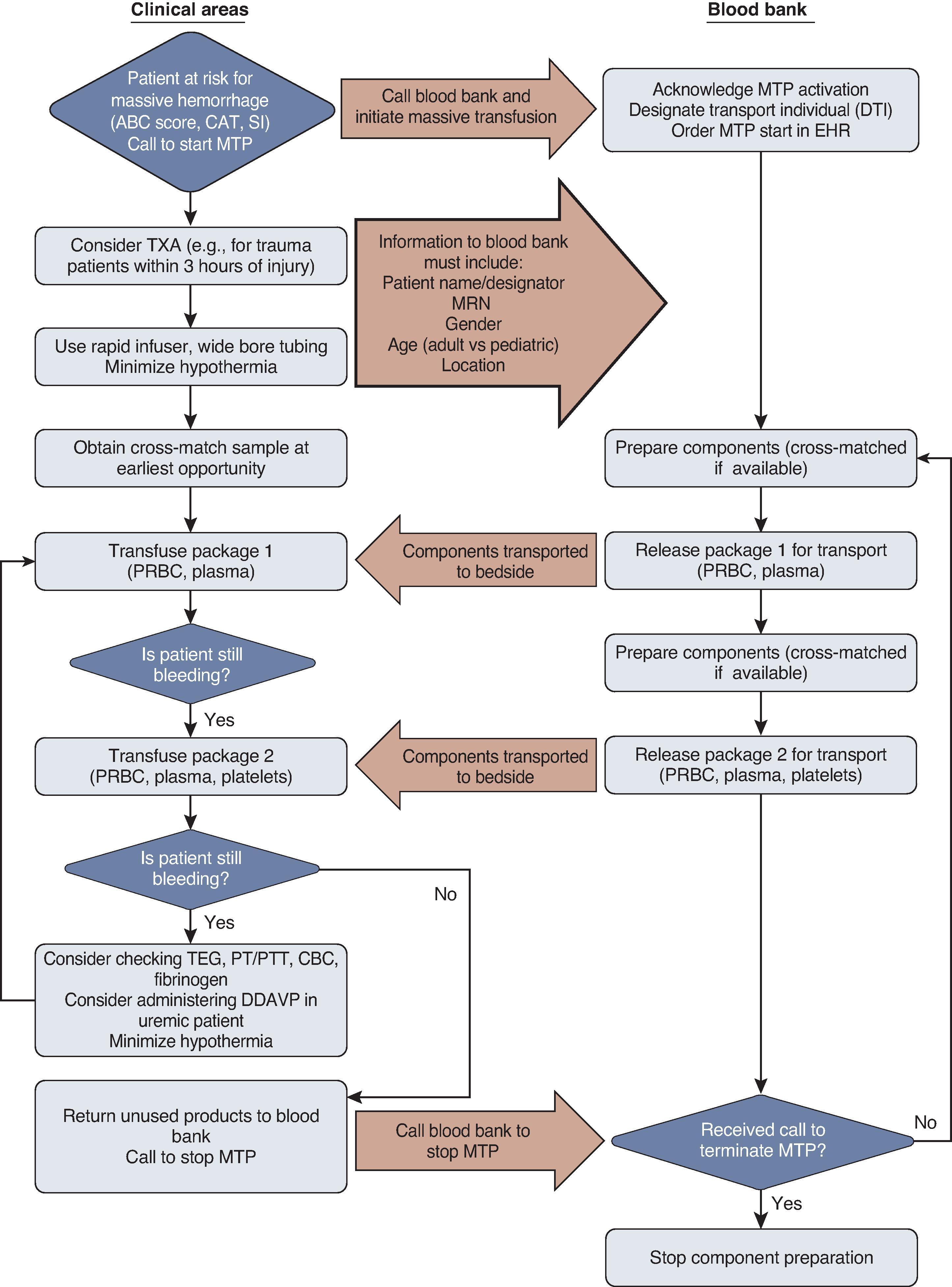
Military studies provided the first investigations of utilizing whole blood in trauma resuscitation. With promising results suggesting there may be an improved mortality and decrease in blood product utilization, some civilian level I trauma centers have begun testing the use of whole blood. Additional ongoing studies examine the use of vasopressors in trauma. Although there is typically no role for vasopressors in hemorrhagic shock, animal studies have suggested a potential role for vasopressin in improving tissue perfusion and decreasing blood product requirements. The 2019 AVERT-shock trial demonstrated that the use of low-dose arginine vasopressin in hemorrhagic shock decreased blood product requirement without increasing complications or mortality. Currently, the utilization of vasopressin or other vasopressors remains a topic in need of further studies.
Hemorrhagic shock must be managed by rapidly pursuing hemostasis as delays have been linked to increased mortality. The sites of hemorrhage in a patient are the chest, abdomen, pelvis, long bones, or externally. Diagnosis of the location of hemorrhage drives the following steps in management, namely to stop the ongoing bleeding. Obvious external signs of bleeding can be managed with manual pressure, packing, or a tourniquet if feasible. The American College of Surgeons (ACS) Stop the Bleed campaign provides community outreach, teaching the principles of controlling external hemorrhage in a stepwise approach to decrease preventable prehospital deaths from external, particularly compressible, extremity hemorrhage.
Numerous modalities and clinical examination findings can assist in differentiating the source of bleeding. Diagnostic adjuncts including imaging and procedures should be performed to rapidly localize the body cavity with bleeding ( Table 3 ). Once the source of bleeding is identified, the patient should quickly be moved to the operating room for hemorrhage control. A patient in extremis may ultimately require an emergency thoracotomy or resuscitative endovascular balloon occlusion of the aorta (REBOA) to temporize bleeding before proceeding to the operating room.
An assessment of disability and neurologic status begins with the Glasgow Coma Scale (GCS). A preliminary GCS score should be calculated on initial assessment of the patient. A GCS score of 8 or below suggests that the patient is unable to protect his or her own airway and requires intubation. However, unless apneic, this intubation should be carefully planned and executed with deliberate attention to adequate preoxygenation, pre-intubation resuscitation, and judicious use of vasoactive agents to prevent secondary brain injury (e.g., caused by hypotension, hypoxia, or hyperventilation). This is also the time to evaluate for spinal cord trauma and other signs of TBI including lateralizing signs. The mental status should be continuously reevaluated throughout the primary and secondary survey.
The GCS score has long been used as an initial determinant of disability; however, the score also has utility in predicting outcomes post-TBI. It has also become a component of numerous other trauma outcomes prediction scoring systems including the Trauma and Injury Severity Score (TRISS), Acute Physiology and Chronic Health Evaluation II (APACHE II) score, and the Revised Trauma Score (RTS).
If TBI is suspected, prevention of secondary brain injury should be a priority. Prevention of hypoxia, hypercarbia or hypocarbia (target CO 2 35–40 mm Hg), maintenance of adequate perfusion, correction of coagulopathy, and management of intracranial hypertension should be integrated in the management of patients with a TBI.
To perform a thorough examination of a trauma patient, the patient must be fully exposed. All clothing must be removed to perform a complete examination and minimize missed injuries. Upon completion of the physical examination, the patient should be covered with warm blankets to minimize hypothermia, which should be aggressively avoided, particularly in the setting of likely coagulopathy of trauma in hemorrhagic shock. Use of forced-air warming blankets, warmed intravenous fluids, and an elevated room temperature are measures that should be implemented in a hypothermic patient.
The secondary survey is a complete history and physical examination of the patient following the primary survey. The secondary survey should be performed only when there is normalization of patient vital signs. A systematic head-to-toe assessment of the patient should ensue to gain a full understanding of all of the patient’s injuries, particularly when patients are altered or sedated. Additionally, a full patient history should be obtained including past medical history, allergies, and medications when able.
Imaging has become a critical adjunct in the diagnosis and management of surgical and trauma patients. A variety of rapid and accurate imaging modalities can significantly guide management of trauma patients.
Plain radiographs are an important adjunct to the initial assessment. In the optimal setting, trauma stretchers should be x-ray–compatible allowing for placement of the x-ray cassette without further mobilization of the patient. This will facilitate anteroposterior (AP) chest and pelvis x-rays, which can be immensely beneficial in the initial diagnostics and resuscitation. As noted in Table 3 , a chest x-ray (CXR) can quickly diagnose many life-threatening injuries. Additionally, a CXR should be performed after intubation and chest tube placement to confirm placement of tubes. The role of routine CXRs has been questioned and will remain a source of debate. In patients who are hemodynamically stable and have a mechanism of injury that will warrant a CT scan of the torso, there may be minimal added benefit to performing a CXR. However, we feel that CXRs should be liberally obtained as most trauma patients will not be candidates for CT. In fact, available data suggest that with a normal physical examination of chest and thoracic spine along with a normal CXR, yield on chest CT is extremely low. Clinicians should use clinical judgment to decide on the necessity of CT, keeping in mind the radiation exposure and hospital costs associated with CT. A pelvic x-ray (PXR) should be used as an adjunct when there is clinical suspicion of hemodynamic shock as a result of pelvic bleeding. In a hemodynamically stable patient who otherwise meets criteria for obtaining a CT abdomen and pelvis, there is little utility to a PXR in the trauma bay.
One indication to plain radiography that should not be overlooked is the ability to detect retained radio opaque foreign objects quickly. Gunshot wounds are often highly variable in course because of the significant amount of kinetic energy. A CXR, abdominal x-ray (AXR), and PXR before going to the operating room can reveal retained bullets and potentially guide the surgeon to the body cavity requiring exploration.
Ultrasound has inherent advantages in imaging trauma patients. It is a noninvasive, radiation-free, rapid, and accurate diagnostic modality that has become readily available in nearly all trauma resuscitation rooms. As a result, focused assessment of sonography in trauma (FAST) scan has become a staple in trauma training. A FAST examination entails using ultrasound to investigate four locations in which there may be hidden bleeding. The views to examine are the pericardium, the right upper quadrant, the left upper quadrant, and the pelvis. The strongest indication to perform a FAST examination is in hemodynamically unstable patients with blunt trauma. When free fluid is seen on FAST, particularly in a hemodynamically unstable patient, it can be presumed that there is blood in the cavity in question.
The sensitivity and specificity vary significantly in the literature because of differences in patient cohorts, injury patterns, and study variations. In a 2018 meta-analysis, the sensitivity and specificity of FAST in abdominal trauma were 68% and 95%, respectively, and there was a 96% sensitivity and 99% specificity in thoracic trauma. The results across numerous studies have shown that although a positive FAST examination is likely trustworthy when clinically correlated, a negative FAST examination does not rule out the possibility of intraabdominal or pelvic bleeding. Additionally, the FAST examination is limited by the experience level of the ultrasonographer and the body habitus of the patient.
Ultrasound has now been expanded to use in identifying pneumothoraces through an extended FAST (eFAST) examination. The eFAST examination has also been shown to have variable sensitivities and specificities. Similar to the FAST examination, there is a consistently higher specificity than sensitivity, suggesting that a negative eFAST should be confirmed if there is clinical suspicion for thoracic trauma. eFAST examination also has variable sensitivity in comparison to chest x-rays. Again, the eFAST examination is limited by operator experience and patient body habitus. The role of eFAST examination has yet to be fully delineated in the trauma assessment.
Cross-sectional imaging has become a highly valuable imaging adjunct to surgeons including in the setting of trauma. CT is rapid and accurate in the diagnosis of pathology in both blunt and penetrating trauma. CT allows for classification and characterization of solid organ injuries, which has improved prognostication and intervention in blunt abdominal trauma. Administration of CT contrast can opacify different structures and improve visualization of bleeding or extravasation. Intravenous contrast is beneficial and should be utilized in trauma scans. The contrasted scans can be performed to visualize arteries (CT angiography) with smaller cross-sectional slices or in portal venous phase as a standard CT with IV contrast. With the improvement in CT technology, there is also a decreased need for traditional angiography for solely diagnostic purposes. Given the invasive nature of angiography, noninvasive CT angiography has allowed for a more judicious use of angiography for intervention for those who have a higher likelihood of vascular injury. In general, oral and rectal contrast have fallen out of favor in CT for trauma. However, rectal contrast may have some use in select cases with penetrating flank injuries for evaluation of the retroperitoneal colon.
CT is not an appropriate diagnostic modality in a hemodynamically unstable patient. A patient in the CT scanner is relatively poorly monitored and has an increased risk of aspiration when lying flat for the examination. More importantly, in case of worsening hypotension, airway compromise, expanding pneumothorax, or other acute life-threatening events, CT scan suites typically lack the tools and resources for appropriate interventions. There also remains a risk of radiation exposure. The radiation exposure in a whole-body CT scan is approximately 3 times that of the average background atmospheric radiation exposure. Although the benefit often outweighs the small risk of radiation exposure, the future cancer risk from a CT scan is difficult to quantify and increases with a larger number of CT scans performed in a lifetime. In special populations (i.e., children and pregnant women), a CT scan in trauma should be obtained only when clinically indicated.
Trauma care requires standardized and coordinated care to continue decreasing potentially survivable injury-related deaths. Moreover, work should continue in the prevention of trauma, injuries, and violence as the only way to prevent the majority of trauma deaths is to prevent the occurrence of trauma. As we pursue quality improvement in trauma resuscitation, implementation of trauma video review has increased in trauma centers across the country over the past decade. Reviewing trauma resuscitation videos can allow for improvement in communication, team dynamics, and coaching at all levels of providers.
Future directions and innovations in early hemorrhage prevention are the use of novel pro-survival drugs and preserved plasma products in the prehospital setting and development of hemostatic agents or local hemorrhage control.
Trauma remains a leading cause of death and disability worldwide. The epidemiology of mortality traditionally followed a trimodal distribution, with the majority of deaths occurring within minutes of injury from either hemorrhage or devastating traumatic brain injury (TBI); a second peak occurring within hours of hospital arrival as a consequence of the severity of their injuries; and a third peak occurring days or weeks after the initial insult secondary to organ failure and sepsis. However, with advances in care, a bimodal distribution is more common in modern trauma systems, with death occurring either immediately or within a few hours of injury; late deaths have dramatically diminished.
A key component of an effective trauma system of care is the prehospital care provided from the point of injury to hospital arrival. This can be delivered by bystanders as well as trained members of a trauma system’s Emergency Medical Services (EMS). These elements create a chain of survival from the point of injury to delivery to in-hospital care.
There exists a period of time, sometimes termed the disaster gap, from the initial incident to the arrival of trained help. Members of the public who are near the point of injury can be termed spontaneous responders. They may be able to provide critical first aid, including simple measures such as opening of the airway or control of bleeding through application of direct pressure or a tourniquet, if available.
The fact that this group of individuals can provide critical support in the period before skilled help arrives and could reduce potentially preventable mortality was recognized in 2013 as part of a multiagency review by the Joint Committee to Create a National Policy to Enhance Survivability from Intentional Mass Casualty and Active Shooter Events convened in the wake of the Sandy Hook Elementary School shooting the year before. The committee’s recommendations were published in a report termed the Hartford Consensus.
This directly resulted in a call for implementing bleeding control training. Although initially aimed at the management of mass-casualty incidents, this was extended to include smaller incidents. Programs such as the American College of Surgeons Committee on Trauma (ACS-COT)–sponsored Stop the Bleed campaign and the American College of Emergency Physicians (ACEP)–sponsored Until Help Arrives course are designed to empower members of the public to be effective spontaneous responders by training them in basic hemorrhage identification and control techniques, scene safety, and effective communication with emergency medical dispatchers. Public spaces such as airports and schools are now more likely to have bleeding control kits, often alongside automated external defibrillators.
Emergency medical responders and emergency medical technicians (EMTs) form critical parts of a trauma system’s prehospital response capability. The National Registry of Emergency Medical Technicians defines the curriculum to credential prehospital clinicians at each of these levels. They are trained to safely assess scenes, provide basic trauma life support, and transport patients expediently to hospital-level care. They can support the care provided on scene by working alongside advanced life support teams.
Broader trauma care can be provided at the scene by appropriately trained advanced life support clinicians. Interventions include advanced airway management such as drug-assisted endotracheal intubation, hemorrhage control, splinting including pelvic binder application, needle or open thoracostomy, intravenous access, and fluid administration. Typically, in the United States this level of prehospital care is provided by EMTs who undergo more extensive training to the paramedic level. Many international systems as well as some in the United States also incorporate specialty-trained prehospital physicians as part of their prehospital care system. Such physicians can provide an even higher level of procedural skill and clinical decision making on scene in specific circumstances such as complex trauma and delayed extrications.
Oversight of a trauma system’s prehospital response (including training, communications, protocol development, clinical response, and quality assurance) is the remit of the EMS medical director. Increasingly, this person is an EMS–board-certified emergency medicine physician, though trauma surgeons and other allied specialties may also carry out this role in some systems. The medical director also acts as a crucial liaison between EMS and other prehospital services (including police and fire departments) and hospital specialists. Local protocol development should include input from those specialties involved in trauma management.
Prehospital trauma evaluation and management generally follows principles used during in-hospital care. One approach has been codified in the Prehospital Trauma Life Support (PHTLS) course created jointly by the ACS-COT and the National Association of Emergency Medical Technicians. This framework promotes critical thinking and standardized patient evaluation and treatment, and it includes a primary survey addressing airway (with cervical spine control), breathing, circulation, disability, and exposure/environmental control. Scene assessment and safety precedes this evaluation. A momentum to rapidly and safely transport to the most appropriate treatment facility should underline prehospital management.
As a direct result of experience from the military conflicts in Iraq and Afghanistan, the approach to time-critical priorities in trauma assessment has been revised. The ABCDE principles are arranged in a different mnemonic: MARCH (Massive hemorrhage, airway management, respiratory support, circulation, head injury and hypothermia). An alternative mnemonic that follows the same premise is (C)ABC: Control of exsanguinating hemorrhage, Airway, Breathing, Circulation.
On arrival, the prehospital responder should initially determine whether the scene poses any ongoing threat to themselves, their colleagues, or the patient. Threats can include structural instability, traffic, fire or environmental challenges, electrical hazards, hazardous materials, or the presence of a violent offender. Information can be gathered from personal observation, bystander reports, technical specifications, and allied agency responders. Scene safety may be dynamic, and the prehospital responder must maintain situational awareness and open communication with colleagues regarding evolving threats.
The principal mechanism of potentially preventable mortality from trauma is hemorrhage. Rapid identification and temporary control of massive, exsanguinating hemorrhage is life saving. Sources may be obvious, such as a bleeding extremity, but can also be less obvious, such as the junctional areas (groin and axillae), scalp, and the back. Rapid removal of clothing may help facilitate identification of these injuries. Bleeding may be managed through the use of direct pressure, wound packing (including the use of hemostatic agents and dressings), and tourniquets.
Hemostatic agents have evolved over time, with civilian use being informed from military practice. These typically incorporate chitosan, zeolite, or kaolin. Examples include HemCon bandages, QuickClot combat gauze, X-Stat sponges, and Celox gauze. They can be used to pack wounds and can be incorporated into pressure dressings. Civilian studies have reported largely favorable outcomes with minimal complications.
Similar civilian adoption has occurred with tourniquets. Although initially a controversial adjunct, extensive experience from recent military conflicts has demonstrated safety and survival benefit without increasing amputation rates directly resulting from tourniquet use itself. Recent civilian data demonstrated an almost six-fold mortality reduction when utilized in peripheral vascular injury.
Tourniquets are indicated in extremity injuries if bleeding is not controlled by direct pressure; the source here is usually arterial. They should be placed as proximal as possible on a part of the limb with a single bone (upper arm or thigh) to allow direct compression, and then tightened until hemorrhage stops. The time of application should be clearly documented, and this information is given to the hospital team on arrival.
Splints (including box, vacuum, and traction splints) and pelvic binders can be applied in the prehospital setting. These devices not only reduce pressure on skin and neurovascular structures, but they also can decrease bleeding by stabilizing fractured bones.
The prehospital clinician should actively evaluate for signs and symptoms of airway compromise and respiratory distress. Simple airway maneuvers such as a jaw thrust, in conjunction with supplemental oxygen and, when required, basic airway adjuncts such as oral or nasal pharyngeal airways can allow support of the airway, oxygenation, and ventilation.
Advanced airway management through endotracheal intubation (including drug-assisted rapid sequence intubation) has been controversial in prehospital trauma management. Although this is deemed a definitive airway, the success of prehospital intubation is dictated by type and intensity of training and skill maintenance. This can vary widely from one EMS system to another. In both retrospective and prospective studies of prehospital intubation, often in the setting of TBI, patient-centered outcomes such as neurologically intact survival have been variable and likely dependent on multiple variables including the development of hypoxia or hypotension during intubation, inadvertent hyperventilation, prolonged scene times, and aspiration events. Systems in which clinicians are appropriately trained and have a high frequency of procedural use likely have more favorable outcomes. Therefore, in many EMS systems, basic airway maneuvers en route to the hospital may be more appropriate. This can be supplemented by the use of supraglottic devices such as a laryngeal mask airway.
Surgical airways may be required in situations where oxygenation and ventilation are impossible. However, many prehospital clinicians lack significant experience in this technique. EMS systems seeking to include this in the clinician’s scope of practice must pay close attention to training, protocol development, and quality assurance.
End-tidal carbon dioxide monitoring (capnography) should be considered the standard of care in confirming the correct placement of an advanced airway. Both colorimetric and waveform capnography devices exist. Waveform capnography allows for continuous monitoring of ventilation and is particularly useful in identifying significant hypoventilation or hyperventilation. Both of these can be detrimental in the setting of prehospital trauma, in particular TBI.
Life-threatening pathologies such as a tension pneumothorax should be actively looked for by prehospital personnel. Clinical signs can include diminished breath sounds, deviation of the trachea, presence of subcutaneous emphysema, and distended neck veins, especially when accompanied by hemodynamic instability. Several recent studies measuring chest wall thickness have found that there is a higher incidence of successfully reaching the pleura in adults with a standard 2.5-inch (5-cm) needle when placed in the fifth intercostal space, anterior axillary line, as opposed to the traditionally taught second intercostal space, midclavicular line. Longer (8-cm) needles are also commercially available and useful in larger adults. In children, the second intercostal space, midclavicular line is still recommended, with depth of insertion guided by the patient’s body size and response to insertion. Complications include inadequate drainage of the pneumothorax caused by not reaching the pleural, kinking of the catheter leading to reaccumulation of the pneumothorax, and damage to surrounding structures, including the neurovascular bundle of the rib, the lung, and nearby great vessels.
An alternative to needle thoracostomy is open thoracostomy. This utilizes steps similar to surgical chest tube insertion except for the actual placement of a chest tube. This technique has been incorporated successfully in some EMS agencies. Although more training is required, open thoracostomy is more likely to lead to successful decompression of the pneumothorax. There is further potential of injury to the neurovascular bundle of the rib if care is not taken with dissection technique.
Open thoracic wounds causing a simple pneumothorax can be managed by early application of a chest seal. This can be through the use of a three-sided dressing, although in clinical practice these are not very effective. Commercially available vented chest seals such as the Asherman chest seal are more efficacious, allowing for the release of accumulated air without allowing reentry. Thus, progression to a tension pneumothorax can be prevented.
If intubated, consideration should be made of using a transport ventilator. All ventilators, regardless of complexity, allow a set rate and tidal volume to be delivered. This has the benefit of preventing inadvertent hypoventilation or hyperventilation and reduces the risk of barotrauma through delivery of set tidal volumes. These factors can be beneficial in the injured patient, especially in the setting of TBI.
In addition to managing massive hemorrhage, the prehospital clinician can attempt to obtain vascular access. This is preferentially obtained through placement of two short, large-diameter intravenous catheters (size 14- or 16-guage) in the upper extremity veins. Although large-volume resuscitation is no longer recommended, obtaining venous access in the field may be easier as the patient is encountered at an earlier stage of shock, when veins are more prominent than by the time they arrive to hospital. However, the prehospital clinician should be mindful of the time spent on scene and consider performing this task en route.
If venous access is not possible after two attempts, EMS personnel can attempt to place an intraosseous (IO) line. IO access was once reserved only for children, but it has gained importance in all age groups when intravenous access is challenging or impossible. Newer devices allow rapid placement. Typical sites include the proximal tibia and the humeral head, although the distal femur and the sternum are also options. Sternal IO access requires a needle specific for this site. The IO route has similar plasma kinetics to intravenous medications and fluids. Recent cadaveric study has demonstrated mean flow rates of normal saline of 93.7 mL/min via the sternal route, 57.1 mL/min via the humeral route, and 30.7 mL/min by the tibial route when the fluid was administered under pressure.
The infusion of (often cold) normal saline in particular presents challenges from both worsening hypothermia as well as acidosis secondary to its high chloride content. Therefore, if a crystalloid is to be administered, a more balanced solution such as lactated Ringer’s is preferred. However, there has been a significant move away from large-volume crystalloid volume resuscitation over the past several decades. Several studies have demonstrated that patients may have higher mortality when large volumes are administered in the field, especially in the setting of uncontrolled hemorrhage and penetrating trauma. The development of acute respiratory distress syndrome, coagulopathy, and pneumonia are all associated with large-volume fluid resuscitation.
Targeting a “normal” systolic blood pressure should be avoided in the setting of uncontrolled hemorrhage. Rather, a systolic goal of 80 to 90 mm Hg is preferable and may decrease mortality. This goal avoids excessive arterial pressure and venous dilation at bleeding sites and the disruption of an establishing clot. This systolic blood pressure goal should be increased in the setting of TBI to 100 mm Hg to allow maintenance of cerebral perfusion. Small fluid boluses (250–500 mL) can be administered if necessary to achieve these goals.
Waveform capnography is a useful adjunct to determine adequate perfusion. Both hospital and prehospital studies show that low or decreasing levels of end-tidal carbon dioxide correlate with increasing mortality in trauma. A recent, retrospective prehospital trial showed that capnography was at least as useful if not more predictive of mortality or of the need for massive transfusion than systolic blood pressure or shock index.
Blood being lost from a victim of major trauma should be replaced by blood. The survival benefit of early blood product administration has been reiterated in the recent military conflicts in Iraq and Afghanistan, but was in fact common practice in major conflicts predating this. As a result, several civilian studies have reviewed the benefit of prehospital blood products. The Prehospital Air Medical Plasma (PAMPer) trial investigators showed significantly lower mortality and median prothrombin-time ratio in their 230 trauma patients randomized to receive plasma as opposed to usual care (typically crystalloid). However, this benefit is likely most apparent when transport times exceed 20 minutes. This was demonstrated by the Control of Major Bleeding After Trauma (COMBAT) trial carried out in urban systems with short transport times to a level I trauma center. In this study, there was no significant difference in 28-day mortality between the two groups.
Secondary analysis of the PAMPer trial patients showed that, when compared with patients who received only crystalloid, only plasma, or only packed red blood cells (PRBCs), the group that received both plasma and PRBCs showed the most significant mortality benefit, with a hazard ratio of 0.38. This aligns with the Pragmatic Randomized Optimal Platelet and Plasma Ratios (PROPPR) trial evaluating a 1:1:1 ratio versus a 1:1:2 ratio of plasma, PRBC, and platelets for civilian trauma patients in the hospital. The 1:1:1 group showed improved hemostasis and fewer deaths resulting from exsanguination.
In an attempt to further achieve optimum replacement of blood lost, low-titer cold-stored whole blood has been proposed as a more ideal blood product in civilian trauma. Whole blood offers the advantage of having a smaller volume, higher hematocrit and platelet content, and lower citrate content when compared with equivalent amounts of component therapy. Military data have shown a mortality benefit with the use of whole blood. Several observational civilian trials have shown an indication to improved mortality, especially early in resuscitation, as well as a lower overall need for blood products. Some EMS agencies have therefore started incorporating whole blood in their systems.
Inclusion of blood products in prehospital systems requires consideration of training, cost, coordination with local blood banks, and specific protocol development. Duration of storage may be a limiting factor. European and military systems have incorporated freeze-dried plasma, which can be reconstituted. This has a longer shelf life, but it is awaiting approval by the US Food and Drug Administration.
Tranexamic acid (TXA) is an antifibrinolytic drug that can be utilized as an adjunct to resuscitation of massive hemorrhage. The randomized controlled Clinical Randomization of an Antifibrinolytic in Significant Hemorrhage (CRASH-2) trial studied its use compared with placebo in 20,211 civilian trauma patients internationally. They showed significant reductions in all-cause mortality in the TXA group (14.5% vs. 16.0%, number needed to treat of 67) as well as mortality secondary to hemorrhage (4.9% vs. 5.7%). The Military Application of Tranexamic Acid in Trauma Emergency Resuscitation Study (MATTERS) trial retrospectively evaluated 293 consecutive admissions with combat-related injuries who received TXA. The authors showed significantly lower unadjusted mortality in the TXA group (17.4% vs. 23.9%), with the largest benefit in those who required a massive transfusion (14.4% vs. 28.1%). The more recent Study of TXA During Air Medical and Ground Prehospital Transport (STAAMP) trial, while underpowered to show an overall mortality benefit, did show a trend to benefit in patients with severe shock and also demonstrated that prehospital TXA could be safely administered.
TXA shows most benefit when given early after injury. Initial recommendations advise administration of 1 g as a loading dose within 3 hours of the injury, followed by 1 g infused over 8 hours. Administration later than 3 hours postinjury is not recommended. The Committee on Tactical Combat Casualty Care has, however, recently changed its prehospital dosage to a single 2 g dose. Prehospital guidelines supported by ACS-COT and ACEP recommend incorporating objective measures as guides to when to administer TXA, such as heart rate >120 beats/minute and/or systolic blood pressure <90 mm Hg. While showing improvements in measures of coagulopathy, TXA may also increase incidence of venous thromboembolism. Therefore, protocol development should ensure documentation of administration to allow outcomes to be tracked.
Hypocalcemia has recently been noted to be a common finding in trauma patients suffering from hemorrhagic shock. Several studies have highlighted that patients with hypocalcemia have a higher associated mortality and suggest that calcium should be administered early (with the first unit of blood as opposed to after several units have been administered as previously recommended) in an attempt to address the coagulopathy of trauma.
Impact brain apnea is an underappreciated contributor to morbidity and mortality in trauma. Following a concussive head injury, there is a short period of apnea. In severe impacts, recovery from this apnea does not occur spontaneously, resulting in direct neuronal injury from hypoxia and hypercapnia. Concurrently, massive catecholamine release causes hypertension, which worsens vasogenic edema secondary to hypercapnia and results in elevated intracranial pressure. Unless rapidly recognized and managed, this can lead to early death. Opening the airway and correcting hypoxia and hypoventilation can lead to favorable neurologic outcomes.
TBI is a significant cause of mortality in the injured patient. The primary goals of the prehospital clinician are to prevent secondary brain injury through the management of hypotension and hypoxia. Hyperventilation is detrimental to cerebral perfusion and should be avoided. Performing a prehospital rapid neurologic assessment provides useful information that the hospital treatment team can utilize in their management and prognostication. Validated scoring systems like the Glasgow Coma Scale (GCS) should be utilized.
Blunt trauma patients were often immobilized using rigid cervical collars and long spinal backboards because of concern for spinal injury. True spinal immobilization, however, does not occur with these techniques, and a growing body of evidence has shown significant complications from these measures including the development of pain, pressure injuries, and respiratory compromise. Thus, the routine use of long spinal backboards should be discontinued. The ACS-COT, ACEP, and the National Association of EMS Physicians recommend the term spinal motion restriction and provide guidance on its use in blunt trauma. These include (1) acutely altered level of consciousness (such as GCS score <15 or evidence of intoxication), (2) midline neck or back pain and/or tenderness, (3) focal neurologic signs and/or symptoms (such as numbness or motor weakness), (4) anatomic spinal deformity, and (5) distracting circumstances or injury that impairs the patient’s ability to contribute to a reliable exam.
Validated clinical decision rules, such as the National Emergency X-Ray Utilization Study (NEXUS) or the Canadian Cervical-Spine Rules, can be utilized by prehospital personnel to clear cervical spines. The criteria utilized in these two decision rules are illustrated in Figure 1 and Table 1 . However, there have been mixed results in studies comparing interrater reliability for these rules between prehospital and in-hospital clinicians.
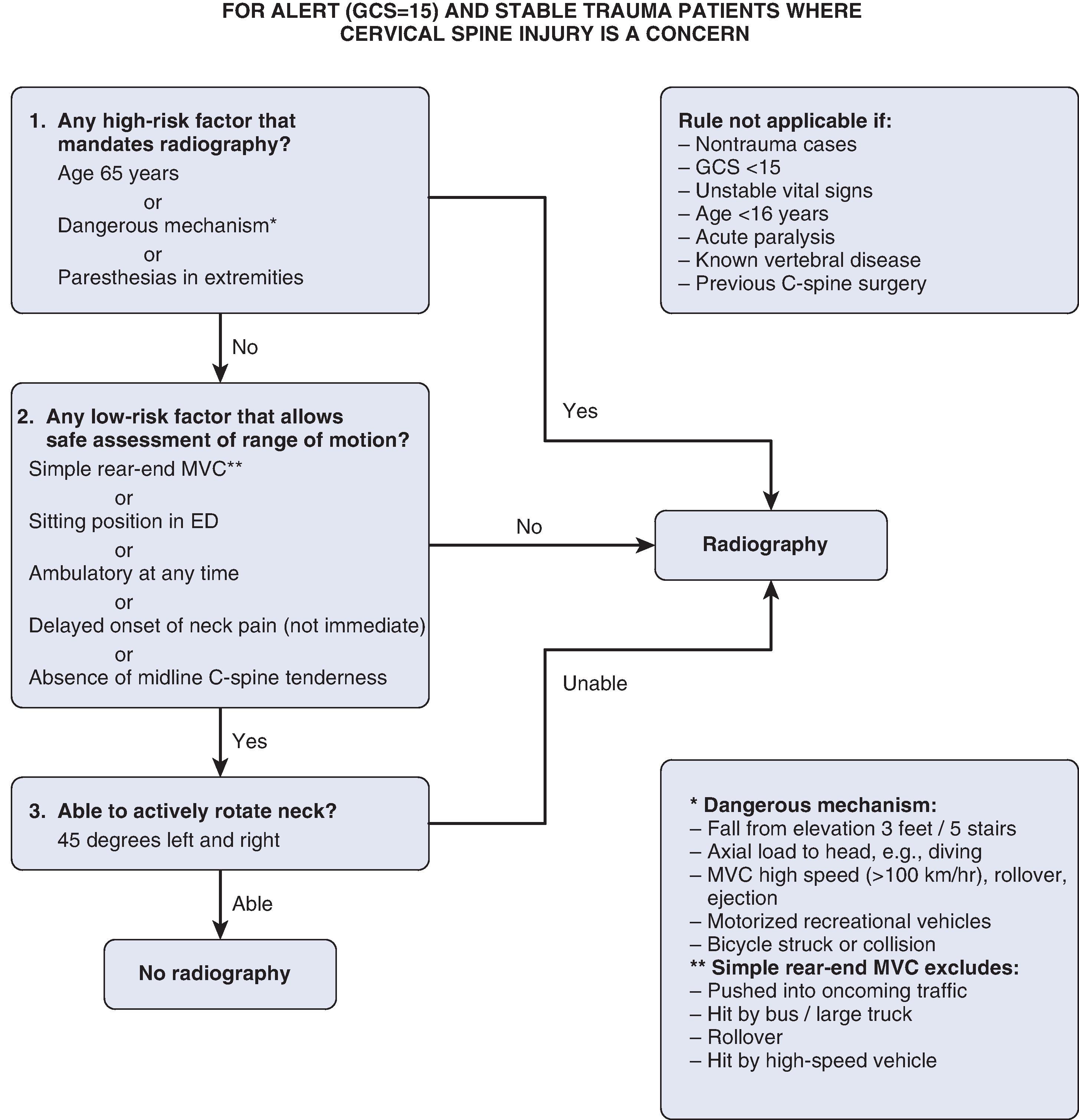
| 1 | No Midline Tenderness |
|---|---|
| 2 | No focal neurologic deficit |
| 3 | Normal alertness |
| 4 | No intoxication |
| 5 | No painful distracting injury |
For patients with penetrating trauma, the Eastern Association for the Surgery of Trauma issued a practice management guideline recommending against using cervical spine immobilization. In their systematic review, they found no benefit and higher mortality in patients who underwent spinal immobilization, even in the setting of direct neck injuries. The presence of a cervical collar may also delay the identification of critical injuries.
Hypothermia complicates approximately two-thirds of civilian trauma patients arriving to the emergency department. Hypothermia is defined as a body temperature <35°C (<95°F) and is a contributor to trauma-induced coagulopathy. Correction of hypothermia is difficult once it is established. Therefore, early anticipation, identification, and management is important. Patients can be rewarmed in the prehospital setting by using blankets, increasing the ambient temperature in transport vehicles, and incorporating the use of fluid warmers when infusing fluids and/or blood products.
Several studies have demonstrated insufficient pain management in the prehospital setting. Adequate prehospital pain management not only is compassionate to the patient, but it assists with additional pain management in the hospital. Multiple agents exist to provide prehospital analgesia. If the patient is able to take oral medications, acetaminophen can be administered. Short-acting opiates such as fentanyl are efficacious and less likely to cause hemodynamic compromise when compared with morphine. Fentanyl’s short duration may necessitate repeat dosing, and prehospital personnel should monitor for respiratory compromise. Ketamine can be given by intramuscular and intravenous routes and provides effective prehospital analgesia. It has the potential to cause a dissociated state. Despite prior practice based on poorly conducted studies, there is no convincing evidence that ketamine raises intracranial pressure.
Triage involves the process of quick and accurate patient evaluation to determine the extent of their injuries and the most appropriate level of medical care needed for those injuries. There has been a significant improvement in in-hospital and 1-year mortality in the United States through the management of injured patients in trauma centers as opposed to non-trauma centers. The ACS-COT divides trauma centers into different tiers based on capability, with level I centers having the resources for multidisciplinary trauma care including the presence of subspecialists, education, research, outreach, rehabilitation, and injury prevention. Appropriate prehospital triage is needed to ensure expedient transfer to the appropriate level of care within individual trauma systems. In achieving the balance of transporting patients to the appropriate level trauma center without overburdening them with lower severity injuries, the ACS-COT allows for an under-triage rate of 5% or lower and an over-triage rate of up to 50%.
Triage decisions vary depending on whether prehospital personnel are managing a single incident or a mass-casualty incident. For single incidents, the Centers for Disease Control and Prevention (CDC) Guidelines for Field Triage of Injured Patients provides a step-by-step algorithm to identify severity of anatomic or physiologic derangement that would warrant transfer to a higher-level trauma center ( Fig. 2 ). These variables include abnormal vital signs (such as systolic blood pressure <90 mm Hg or a GCS score <14), anatomic problems (including penetrating injuries to the torso, head, or proximal limbs; two or more proximal long bone fractures; paralysis; and pelvic fractures), or significant mechanisms of injury (such as falls >20 feet in adults, ejection from a motor vehicle collision, pedestrian struck by an automobile). Other contributing factors that can drive triage decisions include elderly patients, advanced stage of pregnancy, head injuries in patients taking anticoagulant medications, and the clinical judgment of the prehospital clinician.
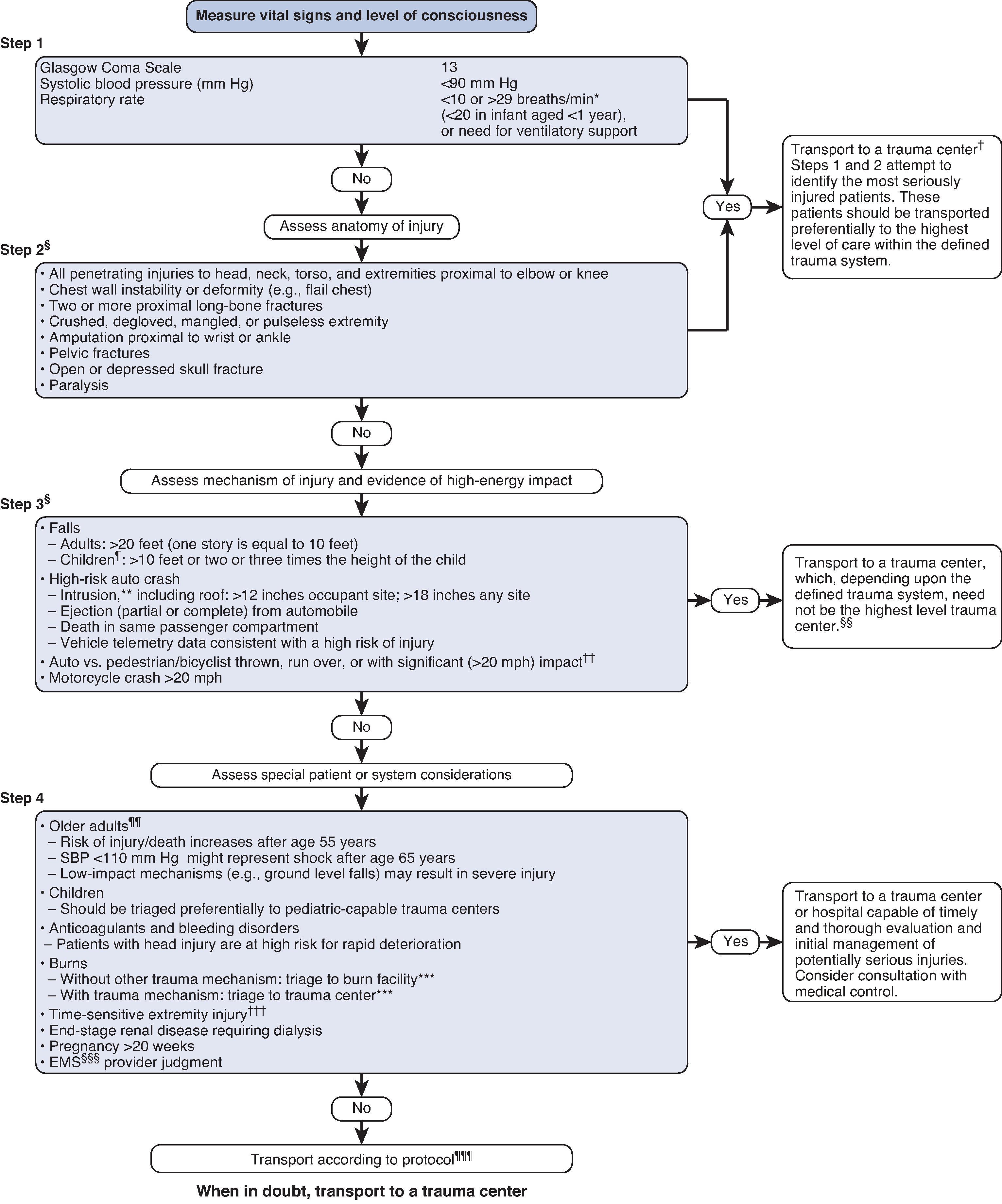
Priorities are different when prehospital clinicians are managing a MCI. Such incidents run the risk of overwhelming available resources, and priority is placed on focusing care on those victims most likely to survive so as not to disproportionately allocate resources to those with lower likelihood of survival. Planning for MCIs is key, and these plans should be activated and executed when required. They will take into account preparation, planning, incident command, interoperability with other agencies, triage, communications, response to hazardous, chemical, or biological agents, management of special populations, and recovery.
The triage tool here must be simple, rapid, and have good interrater reliability. The CDC has developed the SALT approach (Sort, Assess, Lifesaving interventions, Treatment/transport) based on expert consensus and best available evidence ( Fig. 3 ). Other systems in use include START (Simple Triage and Rapid Treatment) and RAMP (Rapid Assessment of Mentation and Pulse). Using SALT, patients are divided into five categories (dead, expectant, immediate, delayed, and minimal) using a color-coding scheme. Expectant patients (gray) are highly likely to die imminently despite attempts to address an immediate life threat. These patients are still deserving of comfort and compassion. Immediate patients (red) are often nonambulatory and have derangements of their respiration, perfusion, and/or mental status requiring immediate attention such as opening of the airway, application of a tourniquet or other control of major hemorrhage, or chest decompression. Delayed patients (yellow) may also have significant injuries, but their care can be deferred for up to 1 hour. Minimally injured patients (green) are often ambulatory and may require very minor attention. Victims are often moved to a casualty clearing area, where they should undergo a repeat triage assessment to determine the transport mode and destination.
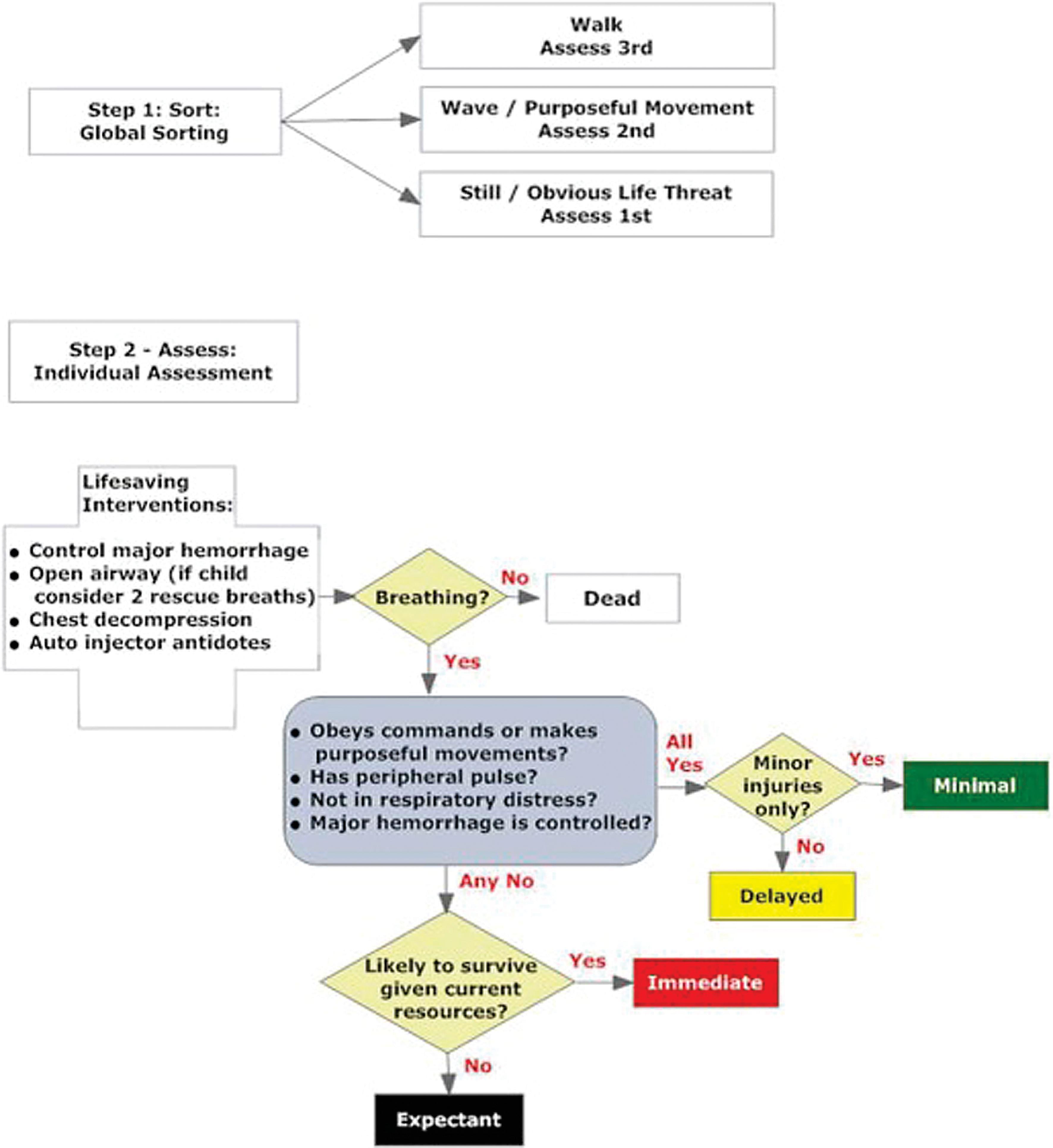
The choice of transportation mode (whether ground or air) is dependent on multiple factors including distance, the patient’s clinical condition, cumulative weight of the patient and treating personnel, weather conditions, availability of landing zones, and availability of prehospital resources. Equally important as the mode of transport is the skill set of the personnel providing that transport.
The benefit of helicopter EMS (HEMS) over ground EMS (GEMS) has been difficult to determine because of significant methodologic problems of studies attempting to answer this question. A recent retrospective study from Denmark dispatched HEMS or GEMS assets based on availability resulting from weather conditions, but found no significant difference in 1-year mortality for either critical illness or injury. Of note, the crews on both forms of transport were trained to a similar standard. It is important to understand that in the United States, HEMS and GEMS are not uniform, homogenous entities, and multiple economic and regulatory issues govern the education, training, and use of both teams. Therefore, individual trauma systems must determine the availability and capabilities of their various EMS assets and work with the EMS medical director and associated specialties to determine appropriate utilization and dispatch criteria.
Two studies recently compared alternate modes of transport for patients with penetrating trauma. Utilizing National Trauma Data Bank information, a study compared 103,029 patients transported by either GEMS or private vehicle within urban trauma systems and determined that private vehicle transport was associated with a higher survival (odds ratio of 0.38). The authors also separately studied 88,564 penetrating trauma patients transported either by EMS or police vehicle and found similar mortality rates between these two modalities.
Handoffs are a critical process of patient care involving the transfer of information and responsibility from the prehospital to the hospital team. Several studies have highlighted the varying quality of EMS handoffs, including content delivered and information received. Competing priorities including patient transport from EMS to hospital stretcher and initiation of patient assessment by the trauma team may mean that essential information is missed. Therefore, a standardized process is recommended. This can take the form of a structured D-MIST report (comprising Demographics, Mechanism of injury, Injuries sustained or suspected, Signs, and Treatment given). If there are no immediate life threats to be managed, the trauma team should give EMS teams 30 to 60 seconds of uninterrupted time to provide their handoff. To aid information retention, the handoff information should be documented in the medical record.
Prehospital traumatic arrest unfortunately carries an overall poor prognosis. In both blunt and penetrating trauma, the cause often revolves around hypoxia, hemorrhage, or an obstructive pathology such as pericardial tamponade or tension pneumothorax. Unless a termination of resuscitation protocol exists within a prehospital system, most prehospital traumatic arrest patients will still be brought to the hospital. However, durations of arrest of greater than 10 minutes in blunt trauma and greater than 15 minutes in penetrating trauma are generally thought to have a very poor chance of regaining return of circulation, let alone meaningful neurologic recovery.
The pathophysiology can be described as a low-output state in trauma, secondary to the aforementioned mechanisms. This will often manifest as pulseless electrical activity before deteriorating into asystole. The prehospital clinician should address hypoxia, obvious external hemorrhage, and tension pneumothorax as previously discussed. Notably, external chest compressions may be ineffective in the setting of hypovolemia or an obstructive pathology and can unnecessarily delay a life saving intervention such as needle or open thoracostomy. If blood products are available, they should be administered.
The use of point-of-care ultrasound (POCUS) has significantly changed the diagnostic and management approach for critically ill or injured patients in the hospital, and it can be utilized in the prehospital setting. Several studies have demonstrated that, following focused training, paramedics can utilize POCUS effectively for a number of clinical indications. For the trauma patient, these include identification of a pneumothorax and the performance of the focused assessment with sonography in trauma (FAST) exam.
The approach to noncompressible torso hemorrhage remains challenging. Despite significant advances in hospital care, a significant proportion of patients with torso hemorrhage die before they can reach that care. The peak time of death from high-grade torso hemorrhage occurs within 30 minutes of injury, with a second early peak within the first 1 or 2 hours. Both urban congestion and rural geography in the United States can preclude shortening prehospital transport times, resulting in significant periods of time elapsing from the point of injury to definitive hemorrhage control (a median time of 128 minutes in one multicenter study). Thus, in-hospital hemorrhage control may be applied after the establishment of irreversible hemorrhagic shock. Alternative approaches may therefore be considered including the development of advanced prehospital resuscitation teams, similar to those utilized recently by the military. These may provide advanced trauma critical care, deliver blood products, and employ evolving techniques such as resuscitative endovascular balloon occlusion of the aorta (REBOA) to temporarily control subdiaphragmatic hemorrhage, all while maintaining a trajectory to hospital care: “scoop and control” as opposed to “scoop and run.” REBOA has been utilized by physician-staffed prehospital teams in London and Paris, and data are evolving to support a survival advantage if utilized with strict indications within the right system of care.
Bypassing the emergency department and transporting patients directly from the field to the operating room based on predefined criteria may also shorten time to definitive hemorrhage control. This has been adapted from the military into some civilian centers in the United States. Early studies have demonstrated mortality benefits, in particular for the most severely injured and those sustaining penetrating trauma, in both adult and pediatric populations. Such policies require careful consideration and coordination between prehospital personnel and hospital teams.
Advanced Trauma Life Support (ATLS) emphasizes the rapid control of hemorrhage in the injured patient. The application of direct pressure or an extremity tourniquet is sufficient in many situations. However, noncompressible hemorrhage requires aortic occlusion for hemostasis. Noncompressible torso hemorrhage (NCTH) requires timely definitive hemostasis, equipment, and blood resources. To prevent immediate exsanguination before hemorrhage control, obtaining proximal aortic control remains the benchmark for survival in NCTH. For patients in extremis, this is typically achieved through emergency surgery coupled with resuscitative thoracotomy (RT) and descending aortic clamping. The use of resuscitative endovascular balloon occlusion of the aorta (REBOA) was first described in 1954 by Colonel Hughes to address the challenges of military traumatic hemorrhage during the Korean Conflict. Other attempts were described in the 1980s, but the technique fell out of favor because of undeveloped equipment and poor outcomes.
The past decade has witnessed an evolution in resuscitation paradigms with escalating extracorporeal capability and the introduction of precise technology. More specifically, the use of endovascular techniques to treat hemorrhage has increased significantly in civilian trauma care. REBOA is being adopted at many trauma centers as a supportive adjunct to resuscitation in the exsanguinating patient. Although the use of REBOA in trauma is relatively new, REBOA has been increasingly utilized for a more diverse patient population with hemorrhagic shock such as patients with ruptured abdominal aortic aneurysms, aortic-enteric fistulas, postpartum or abdominal/pelvic surgery hemorrhage, hemoperitoneum following splenic artery aneurysm rupture, gastrointestinal hemorrhage, and vascular injuries.
Despite emerging indications and potential in resuscitation, the true efficacy of REBOA as a temporizing hemostatic measure in hemorrhagic trauma is not yet established and the hemostatic effect may not be as profound as its hype. Currently, no high-grade empirical evidence demonstrates improvement in survival when REBOA is compared with the standard of care for severe hemorrhage. The risk-benefit ratio of this technology is still being investigated in different patient populations. Before widespread adoption, a rational and evidence-based evaluation of this tool is needed to identify its correct indications.
Proximal aortic control using REBOA is theoretically an ideal intervention to temporize life-threatening bleeding. However, these theoretical benefits are not proven empirically. To this day, REBOA protocols are derived from expert opinion and are not supported by quality data. These protocols must also be adapted to each institution depending on local trauma team facilities, resources, and strengths hindering widespread applicability. The Eastern Association for the Surgery of Trauma (EAST) issued recent practice management guidelines regarding the use of REBOA in hemorrhage control. They concluded that based on the very low quality of evidence, they could not recommend for or against REBOA.
The use of REBOA in patients with NCTH is primarily based on the patient’s physiologic status in the prehospital setting and at the time of admission. Currently reported REBOA indications and algorithms are based on the presence or absence of signs of life on admission. While some reports emphasize that patients who arrive with cardiopulmonary resuscitation (CPR) in progress should strictly undergo RT, others have highlighted the potential role of REBOA in this setting. One advantage of RT is both diagnostic and possibly therapeutic in the setting of penetrating chest trauma. REBOA does not address other etiologies of traumatic cardiac arrest such as tension pneumothorax or cardiac tamponade, both of which can be treated with RT.
In patients who present without a pulse, the decision to utilize REBOA is based on the mechanism and pattern of injury, duration of CPR, presence of an organized narrow complex cardiac rhythm, and/or organized cardiac activity by an ultrasound exam. The Joint Theater Trauma System Clinical Practice Guideline: REBOA for Hemorrhagic Shock was established in June 2014 to guide the use of REBOA in trauma. This guideline includes the Traumatic Arrest Algorithm ( Fig. 1 ) and the Algorithm for the Management of Profound Shock ( Fig. 2 ).
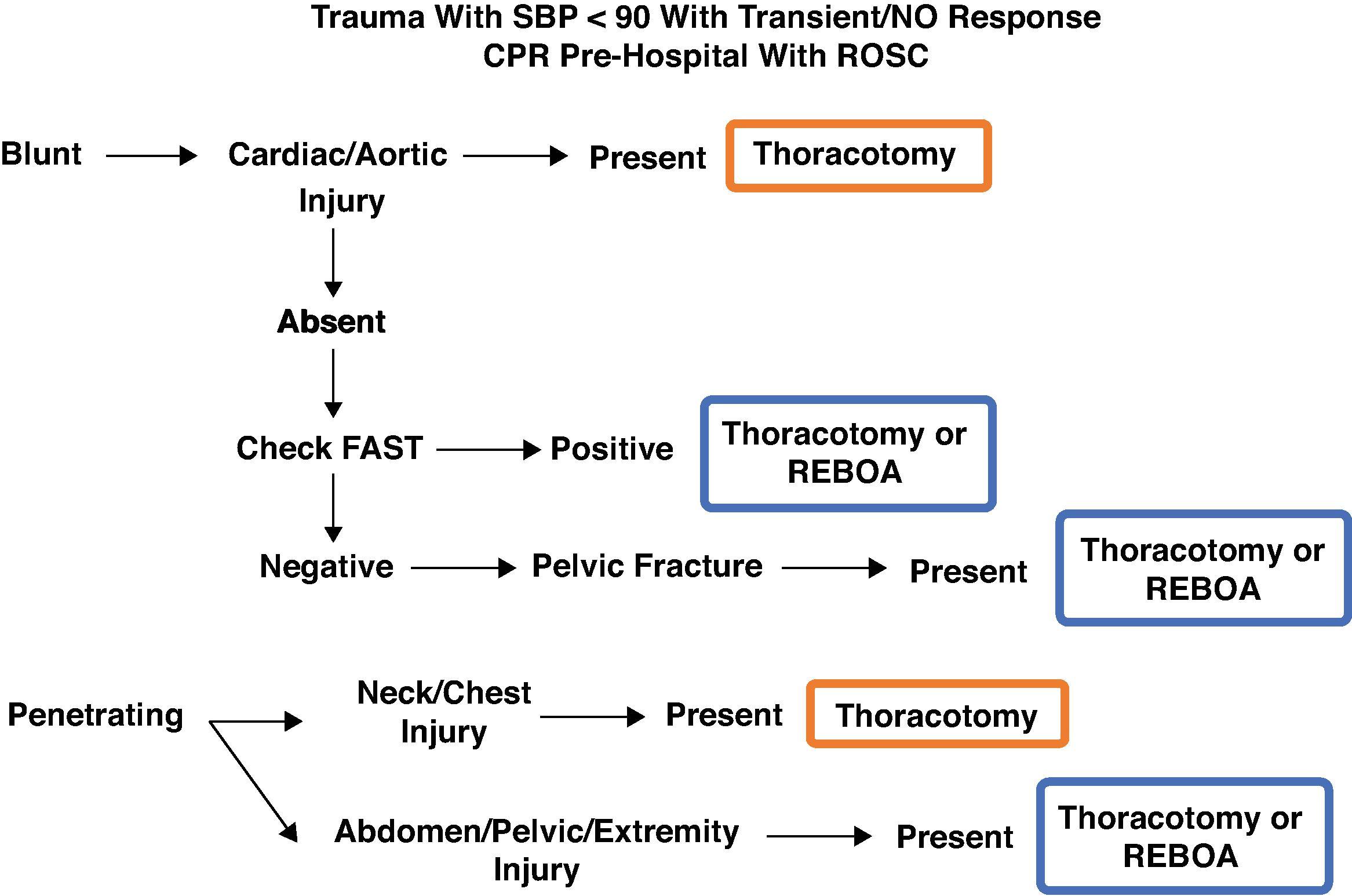
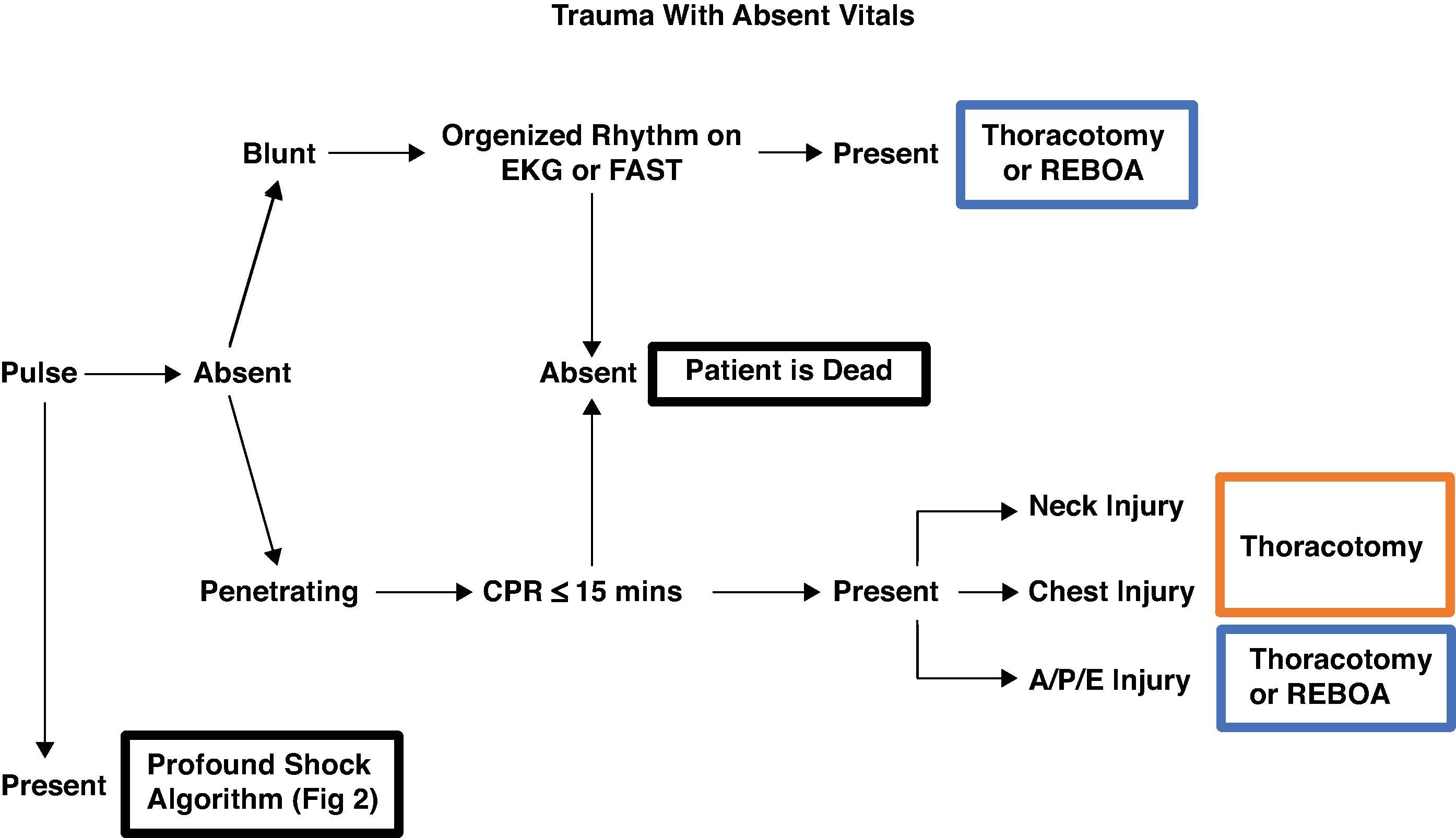
For trauma patients arriving with loss of vitals, the potential use of REBOA is primarily restricted to patients with blunt trauma with organized rhythm detected on an EKG or FAST. Also, patients with penetrating trauma who underwent CPR for less than 15 minutes with a potential source of bleeding in the abdomen/pelvis/extremity and absent devastating head injury may also be candidates for REBOA placement (see Fig. 1 ).
For trauma patients presenting with signs of life on admission in profound shock, the potential use of REBOA is determined by vital parameters, the response to resuscitation, the likely pattern of injury, and the source of hemorrhage. All of these parameters are equally important in determining the need for REBOA. In a recent study, it was reported that 55% of patients with potential anatomic indications for REBOA did not ultimately have physiologic indications once we account for response to resuscitation. Such information is readily obtained from the patient’s primary survey, clinical assessment, and imaging modalities such as focused abdominal sonographic examination for trauma (FAST), chest, and pelvic x-ray. In those patients, it is argued that REBOA may be inserted for transient responders or non-responders to resuscitation upon verification of the subdiaphragmatic source of the hemorrhage. The limitation of this argument is that there is no consensus on the definition of the transient response to resuscitation (see Fig. 2 ).
The major determinant for survival in the management of hemorrhage associated with pelvic fractures is timely hemorrhage control before exsanguination and cardiovascular collapse. An important step in the management of these patients is definitively excluding other sources of major hemorrhage. FAST and/or diagnostic peritoneal lavage (DPL) or diagnostic peritoneal aspirate (DPA) are performed to identify patients with hemoperitoneum who require immediate laparotomy. In hemodynamically unstable patients with pelvic fractures and negative FAST/DPA who have no evidence of significant thoracic bleeding or an aortic injury, the focus becomes stopping pelvic hemorrhage with options including angioembolization, REBOA, preperitoneal packing (PP), or emergent pelvic fixation.
Currently, high-quality data verifying the efficacy of zone 3 REBOA for the treatment of unstable patients with pelvic fractures does not exist. Randomized study designs are needed to verify the proposed indications and algorithms. Given that REBOA is a less invasive procedure compared with PP, its role in the management of NCTH, specifically hemorrhage from isolated pelvic fractures, merits consideration.
REBOA is strictly contraindicated in patients with traumatic aortic injury, hemorrhage proximal to zones of occlusion including areas of the neck, axilla, and superior mediastinum. Patients with extremity bleeding should have attempted hemorrhage control with the application of direct pressure or a tourniquet before REBOA placement. REBOA is also hazardous in traumatic brain injury, blunt cardiac, penetrating neck, or chest trauma where RT may have an advantage in the provision of definitive hemorrhage control. Relative contraindications include elderly age (age >70 years), pulseless electrical activity arrest longer than 10 minutes, presence of terminal illness, or profound comorbidities.
Patients with penetrating thoracic trauma who present in profound shock should undergo prompt RT. Upon accessing the thoracic cavity, definitive hemorrhage control can be directly performed and the descending thoracic aorta can be clamped above the diaphragm to augment myocardial and brain perfusion. The deployment of REBOA in the setting of thoracic hemorrhage is contraindicated and hazardous because of the potential to exacerbate hemorrhage from great vessel injury. Of particular concern are patients with penetrating injuries having a thoracoabdominal trajectory. In those patients, REBOA may be considered only after ascertaining the subdiaphragmatic source of the hemorrhage and ruling out thoracic hemorrhage using a chest x-ray and a FAST exam. Chest radiography showing a widened mediastinum in the setting of blunt trauma may indicate thoracic aortic injury, which is another contraindication for REBOA since balloon inflation could worsen the injury and cause an aortic rupture.
Assessing the risk of a procedure requires a standardized application. REBOA as an intervention is rapidly evolving and its current indications remain speculative, are based on expert opinion, and lack complete consensus. Outcomes are also confounded by the variations in catheter sizes, occlusion strategies, and occlusion durations. Quality data are limited, yet they are portrayed wrongly as being high in quality, contributing to a dazzling mirage. Selective emphasis on improved outcomes and concealing complications contributes to an illusion of improved outcomes. In addition, the excessive number of REBOA publications without standardization of outcomes and controls makes identification of risks more difficult. The greatest risk of this new technology is the potential for portraying disinformation and misinformation as facts.
The Aortic Occlusion for Resuscitation in Trauma and Acute Care Surgery (AORTA) registry is the largest prospective observational dataset examining the utility of aortic occlusion for those patients suffering from hemorrhagic shock. A 5-year retrospective analysis of this registry approved by the American Association for the Surgery of Trauma (AAST) was conducted between January 1, 2014, and November 6, 2018. During the study period, REBOA increased from 39% to 47.2% with a decreasing utilization trend in zone 1 and an increasing trend in zone 3. The catheter size also changed from a 4 to 5 French sheath (Fr) to a 7 Fr in later procedure years. The study concludes that REBOA survival increased significantly but fails to expand on the points we raise next. Procedure-related complications in the open aortic occlusion were stable; however, distal embolism, acute kidney injury, and pneumonia/acute lung injury were more frequent in the REBOA group and increased annually as the study progressed. Concerning mortality differences between REBOA over open aortic occlusion, the two groups were very different, making a direct comparison between these two cohorts unrealistic. However, while open aortic occlusion patients were more likely to expire in the emergency department or operating room, REBOA patients had a greater likelihood of expiration in the ICU or other parts of the hospital. Despite increasing expertise in REBOA, both the time from admission to hemodynamic stability and definitive hemorrhage control was lower in patients requiring open aortic control.
Thrombosis and distal embolization leading to limb ischemia are known complications from femoral arterial cannulation. This risk increases with larger catheters and with the cannulation of smaller arteries. Assessment of distal limb perfusion after REBOA placement is important to identify and mitigate ischemic complications. Suspicion of limb ischemia requires further diagnostic imaging and consultation with vascular surgery. Cannulation of the common femoral artery (CFA) rather than the SFA is a key step in avoiding ischemic complications as the CFA is larger in diameter and therefore has less risk of thrombosis. Proficient and consistent cannulation of the CFA with ultrasound guidance (if possible) is a requirement for providers placing a REBOA catheter. Inadvertent venous cannulation is another described complication of REBOA placement that underscores the importance of ultrasound guidance.
The challenging and rate-limiting step of REBOA is gaining access to the CFA. Even before the patient is deemed eligible for REBOA, establishing CFA cannulation is attempted. Reliable access proves important in avoiding limb ischemia and subsequent complications. Familiarity with the CFA anatomy in the groin is fundamental ( Fig. 3 ). The inguinal ligament runs from the anterior superior iliac spine to the pubic tubercle. The external iliac artery becomes the CFA as it crosses underneath the inguinal ligament. The CFA then bifurcates into the SFA and the deep femoral artery 3 to 4 cm distal to the inguinal ligament. To note vascular landmarks in the groin crease are not reliable.
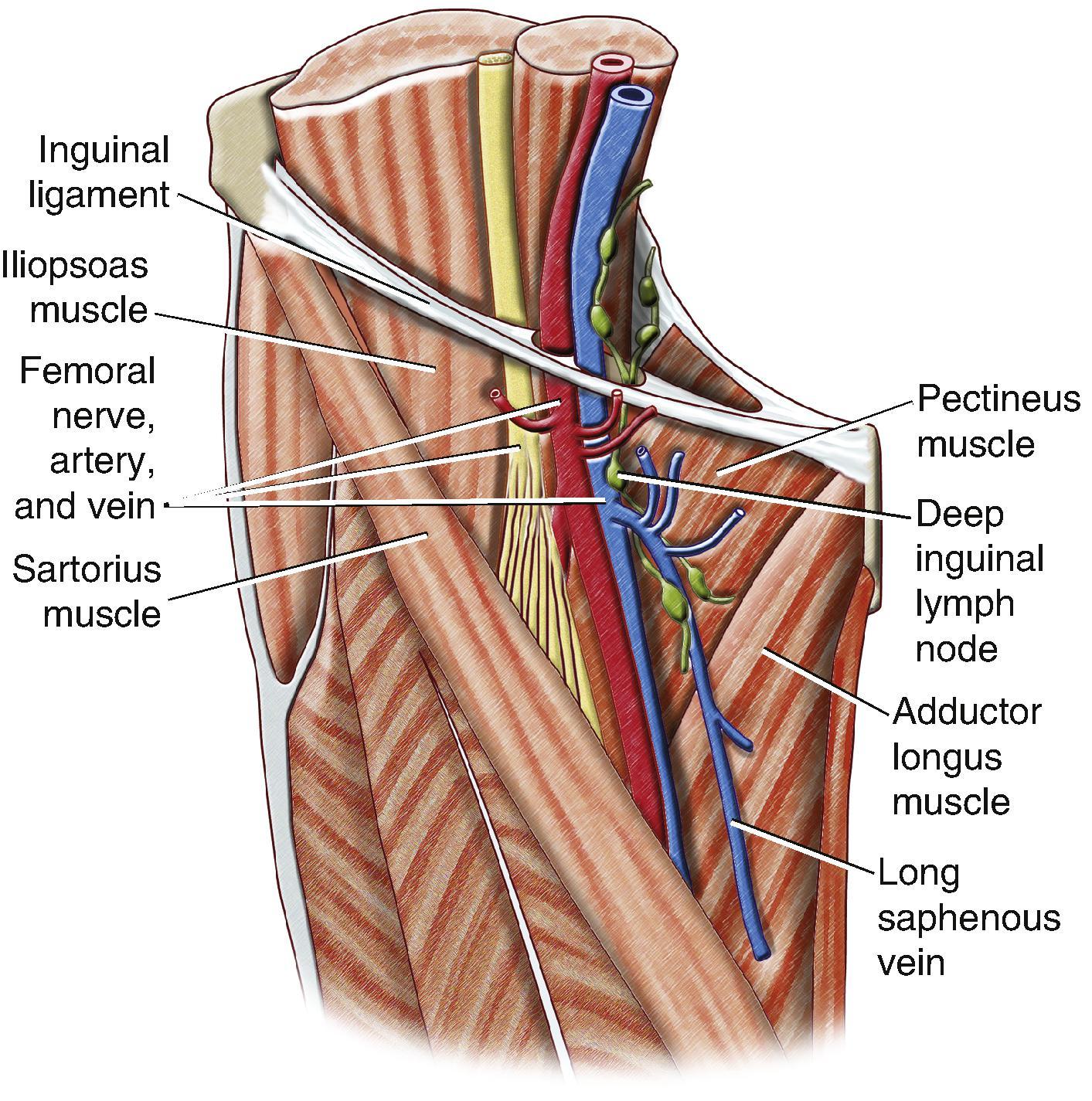
Effective cannulation of the CFA is dependent on the surgeon’s level of experience, the clinical situation, and the availability of ultrasound. One of the following three methods may be used: open cutdown, ultrasound-guided percutaneous, and blind percutaneous. Percutaneous access can be challenging in the setting of ongoing CPR, and the current practice for these patients is cannulation after open surgical exposure. Open cutdown begins with a vertical groin incision to identify the CFA as it emerges beneath the inguinal ligament and ends with cannulation under direct visualization. Even in experienced hands, blind percutaneous access has resulted in the cannulation of the wrong vessel. Blind access entails entering the vessel within 2 cm of the inguinal ligament, and this requires a skin entry site superior to the typical femoral arterial line access site. Data shows that blind access is easier to perform when a femoral pulse is present, but this is seldom the case in the exsanguinating trauma patient. If percutaneous access is desired, we highly recommend ultrasound guidance to ensure CFA cannulation, given that ultrasonography is readily available and will not delay time to hemorrhage control.
At this point, the insertion of the arterial line in the CFA does necessarily imply that we are committed to the path of REBOA insertion. One of the benefits of REBOA’s hype is that it increased comfort in inserting arterial lines in hemorrhagic trauma patients. Once the decision made is to proceed with REBOA, the catheter (arterial line or micropuncture) used for initial CFA access must be upsized to a larger sheath depending on the device being used. To this day there is neither consensus on the optimal REBOA catheter nor one standardized catheter available across all trauma centers. Devices being used range from 4 to 14 French with new devices being promoted and released regularly. Note that while external landmarks are utilized to estimate insertion lengths of the device within the aorta, this proves to be much more difficult in patients with obese body habitus. While upsizing and inserting devices, the catheter should always move liberally within the sheath and dilator. If resistance is encountered, extreme caution is required to prevent severe injury. If the utilization of tactile feedback and imaging in experienced hands fails to resolve the resistance met, the procedure should be aborted.
When we speak of REBOA, we divide the aorta into three zones ( Fig. 4 ). Zone 1 extends from the left subclavian artery to the celiac artery. Zone 2 is between the celiac artery and the lowest renal artery, and zone 3 extends from the lowest renal artery to the aortic bifurcation. The balloon should never be inflated in zone 2 to avoid the occlusion of visceral vessels. Occlusion at this level impedes retrograde flow and perpetuates a prothrombotic state. Ultimately, the goal is to inflate the REBOA catheter in zone 1 or zone 3. Choosing the location of balloon inflation requires determining the most likely source of bleeding. Such information is derived from the patient’s primary survey, clinical assessment, and imaging modalities such as FAST, chest, and pelvic x-ray. In theory, balloon inflation should occur as distally as possible but proximal to the site of bleeding. However, this does not always translate clinically. Upon verification of the subdiaphragmatic source of hemorrhage using the aforementioned modalities, effective balloon inflation at zone 1 ensures occlusion proximal to the site of hemorrhage. If the bleeding is deemed to originate from an isolated pelvic fracture, balloon inflation at zone 3 ensures occlusion of the aorta proximal to the bleeding site. In both cases, the focus should shift immediately to providing definitive hemorrhage control interventions. Whether patients in arrest who arrive with CPR in progress should strictly undergo RT or REBOA to enhance cerebral and coronary perfusion while temporizing distal hemorrhage is yet to be determined.
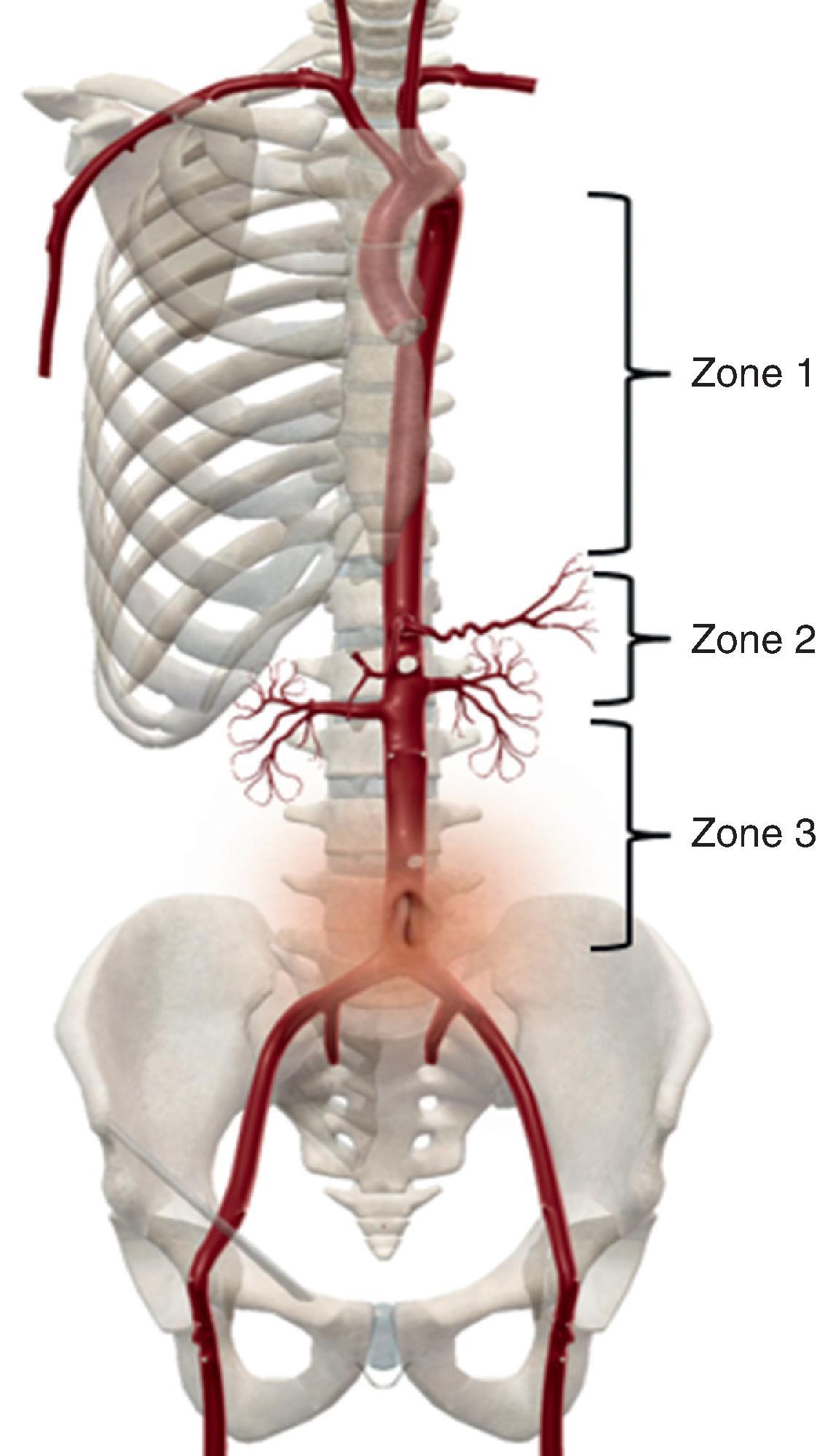
To arrive at the desired aortic zone for balloon inflation, the following surface landmarks are used to estimate the required depth of catheter insertion. The inferior border of zone 1 and zone 3 corresponds to the xiphoid process and the umbilicus, respectively. Placing the inferior edge of the balloon just above these desired landmarks and measuring the distance to the end of the introducer sheath all while tracing the path of the iliac artery and aorta may serve as a guide to the catheter’s depth of insertion. This technique is utilized for standard, over-the-wire balloon catheters. The balloon of the ER-REBOA and ER-REBOA PLUS catheters (Prytime Medical) is set back from the tip of the catheter. This allows one to estimate the required depth of catheter insertion by measuring from the sternal notch to the end of the sheath for zone 1 and from the xiphoid process to the end of the sheath for zone 3.
The depth of balloon insertion has now been determined and the distance should be labeled in the trauma flow sheet. Depending on the make and model of the catheter, it may either have distance markers on it or require manual marking with tape. If a Coda-type balloon (Cook Medical) is used, then the balloon is inserted over the guidewire and into the sheath. Alternatively, if an ER-REBOA catheter is used, then the catheter is inserted directly into the sheath without requiring a guidewire. The catheter is advanced to the previously determined depth and secured with a catheter clip, occlusive dressing, or suture. It is imperative to use imaging (x-ray or fluoroscopy) to ensure proper positioning of the catheter before balloon inflation ( Fig. 5 ). The use of ultrasound to visualize the balloon inflated in zone 3 has been reported and requires a high level of experience. However, ultrasound visualization of zone 3 placement remains technically challenging.
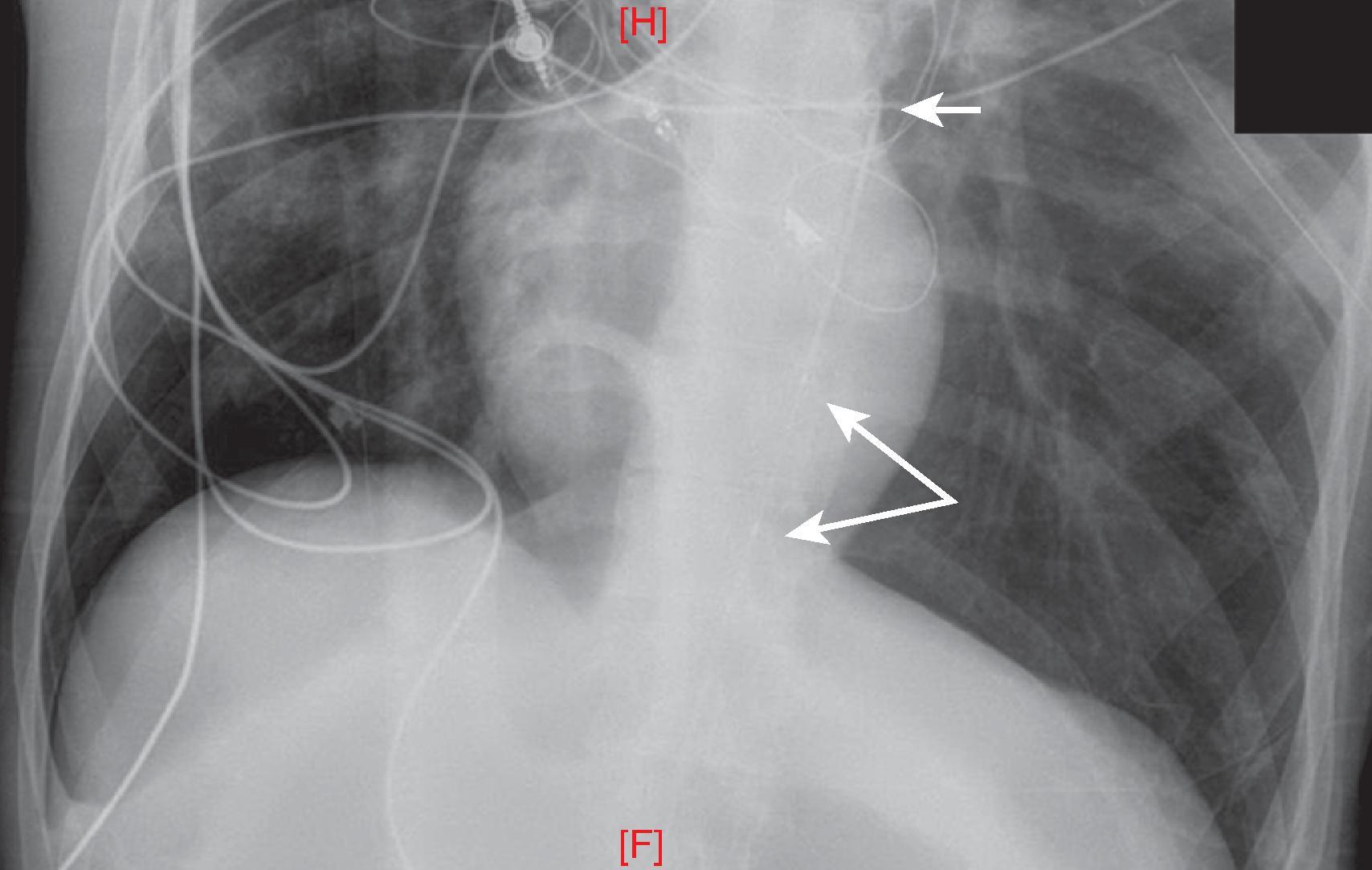
The placement of REBOA in the aorta has now been confirmed and balloon inflation with saline or dilute contrast material should begin. Full strength contrast is avoided because it is viscous and will clog the balloon lumen. Different occlusion times and strategies have been practiced at different institutions, the most common of these being complete balloon occlusion in REBOA practicing centers. Partial occlusion (pREBOA) or intermittent deflation/inflation of the balloon (iREBOA) is used at some centers to minimize complete occlusion time. This is difficult to achieve without continuous monitoring of the blood pressure both above and below the balloon along with a clinical assessment of the rate of bleeding. There are presently insufficient data to guide this practice, the pREBOA and iREBOA can potentially prolong occlusion times while mitigating occlusion-associated physiologic derangements. However, the question of whether these findings are translatable to clinical settings remains unanswered. For this section, we will restrict the technical pearls to complete occlusion of the aorta.
The balloon is slowly inflated until the contralateral femoral pulse is lost. While this is not an easy task in the hemorrhagic trauma patient, the presence of an arterial pulse waveform monitor can guide the volume of inflation. In the ER-REBOA catheter, the waveform is proximal to the balloon and similar to a floating pulmonary artery catheter. Therefore, inflation continues until a rise is noted on the tracing. If the waveform is distal to the balloon, inflation should stop when the arterial waveform disappears. If these waveform monitors are not available, some experienced endovascular surgeons stress the cessation of balloon inflation if subtle increases to resistance are encountered during inflation. How effectively this subtle increase can be detected by experienced surgeons, let alone inexperienced ones, is yet to be determined. Real-time fluoroscopic visualization as the balloon expands against the walls of the aorta can reliably determine adequate inflation. Inflation should stop once the balloon stops widening and elongates with added volumes. Similarly, portable radiography can reveal adequate aortic occlusion based on the shape of the balloon. If overinflation has ensued, the balloon will resemble an oversized oblong shape with an extension of the balloon beyond its edges.
At this point, complete occlusion of the aorta has been achieved. Establishing timely definitive hemorrhage control via surgical and/or endovascular interventions becomes the next step. According to the literature, the most frequent location of REBOA insertion is the ED followed by the operating room. If the patient is in the ED, they should be immediately transported to the operating room or angiography suite. The time to intervention should be minimized at modern trauma centers with advanced interventional facilities. If there is doubt that REBOA in the ED will significantly delay transfer to definitive management, then the rationale behind its insertion should be reconsidered. Safe duration of complete aortic occlusion is unknown, but the American College of Surgeons Committee of Trauma (ACS-COT’s) joint statement recommends complete balloon occlusion given that definitive control is within 15 and 30 minutes for a balloon inflated in zones 1 and 3, respectively. These time restraints are seldom adhered to in REBOA practicing centers. While some studies report tolerance to longer occlusion durations, it is the surgeon and his team’s responsibility to obtain definitive hemorrhage control and deflate the balloon at the earliest time possible. The aforementioned partial balloon inflation strategies in either zone 1 or 3 may extend the maximum occlusion time; however, this is not well studied and can lead to issues with intimal injury and balloon migration. Additionally, partial occlusion is difficult to accomplish in practice because small changes in balloon volume create large changes in distal blood flow.
Complete occlusion of the aorta reduces dramatically the intravascular space. This reduction rapidly and dramatically increases afterload whose effects on the heart, lungs, brain, and other proximal organs may prove deleterious. At this point, continuous monitoring of arterial pressure is mandatory and adjustment in resuscitation products may be required. With the mirage of “normal”-appearing vital signs during aortic occlusion it is easy to forget that with every minute of balloon occlusion, distal organs are experiencing ischemia.
Balloon deflation is a critical step in restoring distal tissue perfusion, but this step is not without risk. It can lead to highly labile vitals because of acidic blood washout from ischemic tissue and the abrupt fall in cardiac afterload. Hypotension ensues because of sudden vasodilation and relative hypovolemia. At this point, communication between the surgeon and anesthesiologist is necessary to ensure prompt administration of pressors and volume expanders to reverse these entities. Balloon deflation may require 15 minutes or more. It should be deflated slowly over the course of 3 to 5 minutes initially, never removing more than 1 mL from the balloon at a time. It is important to note that very minute changes in balloon volume result in large changes in blood flow distal to the balloon. For this reason, the surgeon should be extremely careful not to remove more than 1 mL at a time from the balloon. The surgeon should also make sure to assess and treat any physiologic aberrations that arise between withdrawals.
Increasing sheath dwell time predisposes to increased ischemic complications to the limb. At this point, definitive hemostasis has been established and the balloon has been successfully deflated. Standard of care mandates documentation of lower limb perfusion. This can be achieved by angiography (gold standard) illustrating patent flow to the foot or with Doppler signals symmetric to the contralateral leg. In the setting of distal flow limitations, prompt angiography and vascular surgeon consultation are necessary.
If the CFA cutdown approach is used, then surgical repair of the artery is necessary. To ensure arterial patency, a Fogarty balloon should be used to clear the proximal and distal vessel of any suspected thrombus. Documentation of lower limb perfusion, described above, is required. If CFA percutaneous approach is used, then the sheath may be pulled and pressure held for 30 minutes. Documentation of lower limb perfusion is also required. For the first 12 hours after sheath removal, lower extremity neurovascular examinations should be done every hour. Vascular ultrasound of the CFA puncture site may also be considered at 72 hours to identify possible access site complications.
At present, we do not have high-quality Level I evidence for REBOA efficacy in the treatment of traumatic hemorrhagic shock, and additional research is warranted. Furthermore, none of the proposed guidelines or algorithms adopted at trauma centers are backed by empirical evidence demonstrating a clear survival benefit when REBOA is used in comparison to the standard of care. The current indications for REBOA remain speculative and are based on expert opinion with no complete consensus.
The rate-limiting step for REBOA is obtaining safe and accurate CFA access after determining that the patient may benefit from aortic occlusion. This step is difficult and time-consuming, especially in the hemorrhagic trauma patient. We recommend early CFA access in all patients with hypotension secondary to hemorrhage. This intervention provides a more accurate systolic blood pressure measurement and secures access for REBOA if deemed necessary. Using this strategy, once the physician decides that the patient qualifies for their definition of nonresponder to transfusions, REBOA may be inserted without delay.
The aortic diameter at zone 1 varies between 15 and 38 mm and at zone 3 between 6 and 28 mm. Most balloons can tolerate large inflation volumes but will only require a fraction of their maximum volume to achieve complete occlusion. The surgeon must remain aware of these two knowledge points while managing the patient in duress. Even with close attention to signs of aortic occlusion, balloon overinflation occurs. This predisposes to intimal injury that may progress to dissection once the device is removed. The balloon may also rupture and complicate and delay valuable hemorrhage control time. The worst scenario is balloon overinflation leading to aortic rupture and immediate patient exsanguination.
In the hypotensive patient, arterial blood is not pulsatile and looks dark, similar to venous blood. Venous placement of REBOA may occur without the surgeon’s ability to discriminate because of these characteristics. This results in ongoing hemorrhage and may injure the vein after balloon inflation. Inadvertent venous access underscores the importance of using ultrasound to obtain initial vascular access. Similarly, malposition in the aorta can lead to ineffective hemostasis, continued hemorrhage, intimal injury, and injury to the origins of visceral vessels or injury to smaller iliac arteries depending on location. We recommend the use of radiographic or fluoroscopic imaging to identify and correct balloon malposition. More so, failure to secure the sheath and balloon will lead to distal migration of the balloon. This can cause a similar injury pattern to balloon mispositioning.
Aortic occlusion in an exsanguinating patient will cause a rapid and marked increase in the measured blood pressure. Vital signs may even appear normal after balloon inflation despite the significantly altered physiology. In the setting of RT, there are obvious external cues that the patient is exceptionally ill and requires emergent intervention. Due to the less invasive nature of REBOA, those external indicators are absent, and it is possible that less experienced trauma teams fail to recognize the ongoing urgency to proceed with the next phase of care. It is imperative that trauma team leaders educate all members of the team regarding the physiologic alterations and time constraints created by aortic occlusion.
REBOA is not without complications, and the risk can be substantial if this tool is used inappropriately. Studies ensuring the safety of this intervention or demonstrating an acceptable risk-benefit ratio are also lacking. The complications associated with the use of REBOA are partially attributed to the limitations of currently available devices. These limitations include the size of the catheter and the introducer sheath and catheter stability. Technical complications are divided into several categories: issues associated with arterial access, challenges associated with balloon positioning, inflation, and deflation, and difficulty with sheath removal.
Reported femoral access complications include arterial disruption, dissection, pseudoaneurysms, hematoma, thromboembolism, extremity ischemia, and the problem of prolonged occlusion time and delayed definitive control. As previously stated, reliable CFA access is paramount in reducing complications arising from vascular access. Aortoiliac injuries have also occurred; these include intimal tear, dissection, thrombosis, and rupture, which may be fatal or cause limb loss. Balloon rupture may occur with over-inflation of the balloon relative to the aortic diameter. Unintended inflation of the balloon in the iliac vessels may lead to rupture or thrombosis. In the elective setting, thrombotic complications associated with arterial cannulation are mitigated by heparin infusion. However, this is not an option in the bleeding trauma patient. Thrombus formation can occur anywhere along the length of the catheter or access site. It is crucial to check for Doppler signals after balloon deflation. Additionally, angiography should be performed before sheath removal to evaluate for distal thromboembolism. Any concerns for limb ischemia should prompt consultation with vascular surgery.
Other limitations common to endovascular occlusion of the aorta include occlusion time and physiology postrelease. Even if one’s technique is impeccable, prolonged occlusion results in significant distal ischemic reperfusion injury, predisposing the patient to organ dysfunction, cardiovascular collapse, and spinal cord ischemia. In as little as 15 minutes, the metabolic derangements can be irreversible, thus emphasizing the importance of proximity to definitive hemorrhage control, which is feasible with RT.
Recently, to mitigate the risk associated with occlusion times, pREBOA or iREBOA has been introduced. These practices utilize the same catheter, to allow limited blood flow past the balloon. Theoretically, allowing some flow may limit complications of ischemic reperfusion injury. Currently, REBOA is primarily utilized as an all-or-none flow occlusive device. Several animal studies indicate this is potentially feasible in limiting ischemic burden; however, partial occlusion is difficult to achieve without continuous monitoring of the blood pressure both above and below the balloon along with a clinical assessment of the rate of bleeding. Besides, determining and maintaining a consistent degree of partial inflation is difficult to achieve given the complex physiologic environment. Thus, at this point, there is presently insufficient data to guide this practice.
REBOA is a novel minimally invasive method to achieve proximal bleeding control in trauma patients with noncompressible torso hemorrhage. The catheter continues to evolve, balloon sizes are not final, device application (pREBOA vs. iREBOA vs. complete occlusion) is still under investigation. The ease of safely performing this procedure is a concern as well. Even the complications associated with this device have not been adequately recognized. REBOA’s utilization currently surpasses its indications and requires certification before use. Its utilization must be adapted to the individual institution’s available resources, and logistical familiarity is needed, as is greater practice with this procedure. There needs to be a well-defined population delineated before providing any strong recommendations for REBOA use. This, too, will require time and controlled prospective studies.
Early, aggressive, definitive management of the airway is emphasized as a crucial initial priority for trauma patients because hypoxia and airway obstruction are closely linked to preventable morbidity and mortality. Airway management in trauma patients is frequently complicated by cervical spine instability, brain injury, hemodynamic instability, lack of patient cooperation, risk of aspiration, time pressure, and facial injuries. For these reasons, airway management is an essential skill given the well-defined adverse clinical outcomes that ensue when trauma patients develop acute respiratory insufficiency and hypoxia caused by delays in securing the airway. This chapter will describe techniques that can be employed to rapidly establish and maintain a patent airway, with an emphasis on the importance of providing adequate oxygenation and ventilation throughout all phases of airway management.
A patient who is alert, oriented, and speaking normally in the absence of any observed injuries to the head or neck has an adequate airway. Any change in voice, complaint of a sore throat, dyspnea, tachypnea, use of accessory muscles, noisy breathing (snoring or stridor), or unexplained agitation may be ominous signs of imminent airway compromise.
For patients who are not able to safely maintain a patent airway, a focused examination should be performed while preparing the necessary equipment. The majority of the anesthesiology literature suggests that a combination of airway parameters found during an airway examination will provide the best chance for predicting a potentially difficult airway. A systematic approach to airway assessment should be employed, following the line of sight of the anesthesia provider from the upper incisors to the vocal cords, with a focus on the inside of the mouth and pharynx, concluding with examination of the mandibular space, neck, and chest. Box 1 and Figures 1 and 2 describe clinical tests that can be used to determine if a patient is likely to have a poor view of the vocal cords during direct laryngoscopy.
•Prominent incisors or abnormal dentition
•Mandibular protrusion (see Figure 1 )
•Mouth opening (>3 fingerbreadths, or 5–6 cm is normal)
•Mallampati classification (see Figure 2 )
•Thyromental distance (>3 fingerbreadths, or 5–6 cm is normal)
•Cervical range of motion (should NOT be tested in any patient with a suspected C-spine injury)
•Anatomic abnormalities (masses, swelling)
•Thickness of neck
•Length of neck (shorter neck associated with difficult intubation)

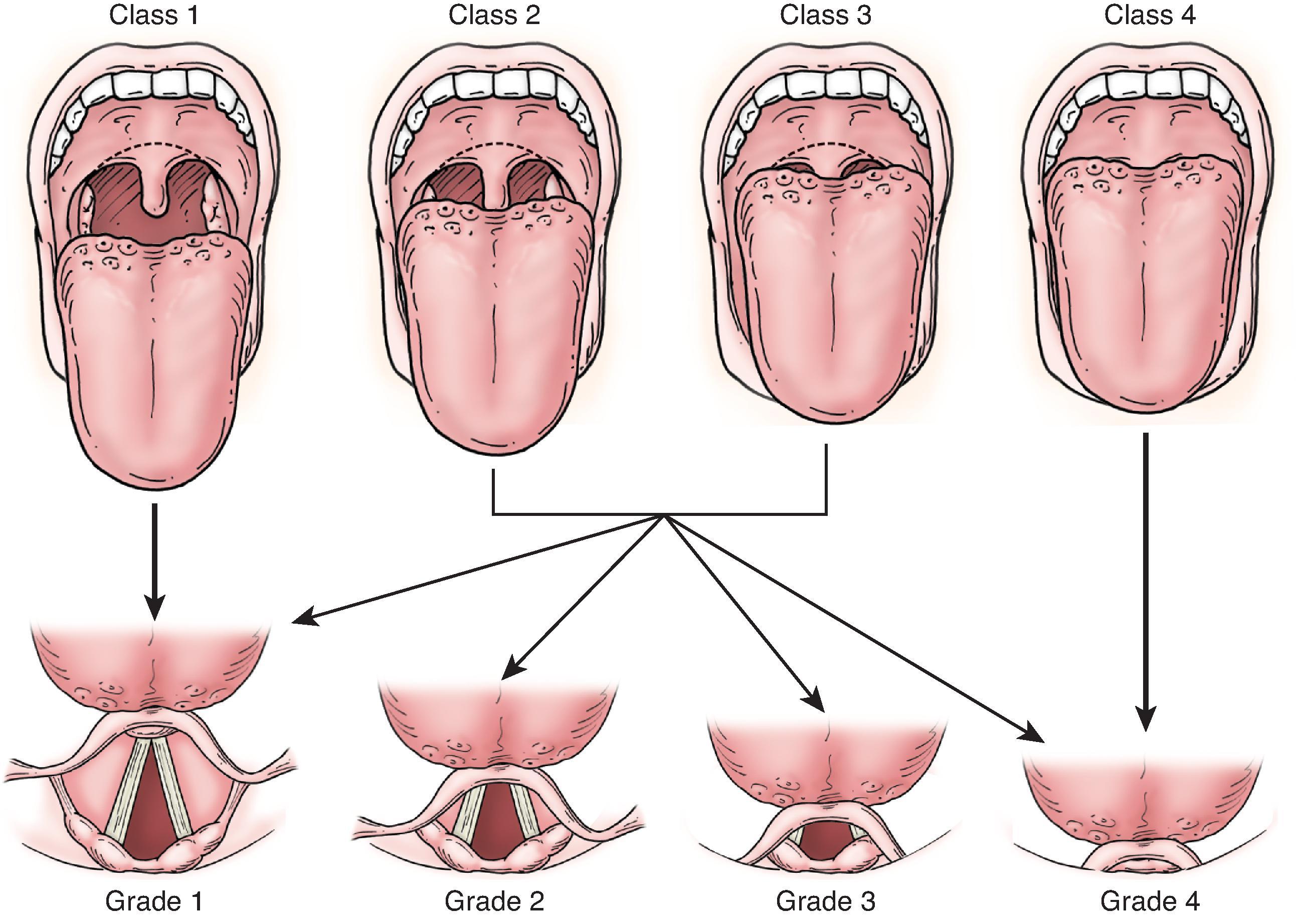
Of utmost importance during airway management is the ability to ventilate a patient with a mask. Independent risk factors for impossible mask ventilation include male sex, a history of sleep apnea, Mallampati 3 or 4 status, and the presence of a beard. Ultimately, few will argue that having an armamentarium of skills to manage the difficult airway is the most important aspect of management, especially considering the myriad factors that may preclude a thorough airway assessment in the trauma patient.
Initial interventions for airway management include provision of supplemental oxygen and a variety of noninvasive airway maintenance techniques. Complicating this process is the fact that the spinal cord must be protected until the possibility of a spinal cord injury has been excluded. Oxygen therapy should be provided to maintain the SpO 2 above 92%. A logical first step is to apply a non-rebreathing mask, which provides an FiO 2 >90%. High-flow humidified oxygen via nasal cannula is an increasingly popular mode for oxygen delivery (i.e., 60 L/min at 100% FiO 2 ) and may be delivered beneath the mask to provide additional oxygenation and some degree of positive end-expiratory pressure (PEEP). Oxygen therapy can then be deescalated accordingly after the patient has been assessed and stabilized, to a simple face mask (FiO 2 35%–55%), a Venturi mask (FiO 2 24%–60%), or a nasal cannula (FiO 2 24%–44%).
If the airway is compromised and the patient is not ventilating and oxygenating adequately, rapid noninvasive interventions are indicated during the interval preceding preparation for establishing a definitive airway. Bag-valve mask (BVM) ventilation with 15 L/min of oxygen should be initiated (FiO 2 90%–100%). Addition of a nasal cannula beneath the mask is advised when available to provide additional high-flow (>10 L/min) oxygen throughout the intubation procedure. This technique may help prevent desaturation during intubation by improving preoxygenation while also providing apneic oxygenation during the intubation attempt. Oropharyngeal or nasopharyngeal airways can be inserted to alleviate airway obstruction by the tongue. The most reliable technique for properly sizing an oral airway is to measure from the midpoint of the incisors to the angle of the mandible. Nasopharyngeal airways should not be used if the patient has a suspected craniofacial injury for fear of inserting the devices intracranially. The length of a nasopharyngeal airway should be selected based on the distance from the tip of the patient’s nose to the tip of the earlobe. The chin-lift maneuver, which is performed by gently lifting the mandible without hyperextending the neck, may help open the airway. Alternatively, the jaw-thrust maneuver can be performed by displacing the mandible forward while applying pressure to both angles of the mandible. Either technique is preferable for trauma patients because both techniques can be performed during in-line cervical stabilization.
A definitive airway in a trauma patient is defined by the placement of a cuffed tube in the trachea, attached to a source of oxygen and properly secured. Endotracheal intubation, nasotracheal intubation, cricothyroidotomy, or tracheotomy can be performed to establish a definitive airway. In the majority of trauma patients, rapid-sequence induction and endotracheal intubation (RSII) is used to establish a definitive airway.
RSII is predicated on the fact that the trauma patient has a full stomach, and excessive bag-valve mask ventilation will cause gastric insufflation with aspiration of gastric contents. RSII involves a highly organized sequence of events starting with preoxygenation for at least 3 minutes. The “6 P ’s” of RSII describe the recommended sequence ( Table 1 ). During the preparatory stage, a suction catheter is prepared and tested, an adequate source of oxygen is established and readied for connection, a pulse oximeter is attached to the patient, pharmacologic agents are prepared, and airway equipment is organized. It should be noted that proper performance of RSII ideally requires at least four providers: one to apply cricoid pressure or laryngeal manipulation, one to maintain in-line cervical stabilization, one to ventilate with a BVM and intubate, and one to administer drugs and assist with airway devices ( Fig. 3 ).
| RSII Step | Time Interval | Pharmacologic Agents |
|---|---|---|
| Preoxygenation | 0–3 minutes | Oxygen, including addition of nasal cannula |
| Premedication | 3 minutes | Induction agent +/– fentanyl, lidocaine, atropine, defasciculating agents (vecuronium, rocuronium; usually 1/10 the induction dose) |
| Paralysis | 3.5–5.5 minutes | Midazolam, ketamine, etomidate, propofol, or other induction agents FOLLOWED BY succinylcholine or rocuronium |
| Placement | 6–6.5 minutes | Oxygen |
| Performance | 7–7.5 minutes | Oxygen |
| Post-intubation management | 7.5+ minutes | Oxygen, sedatives, analgesics, and so on |
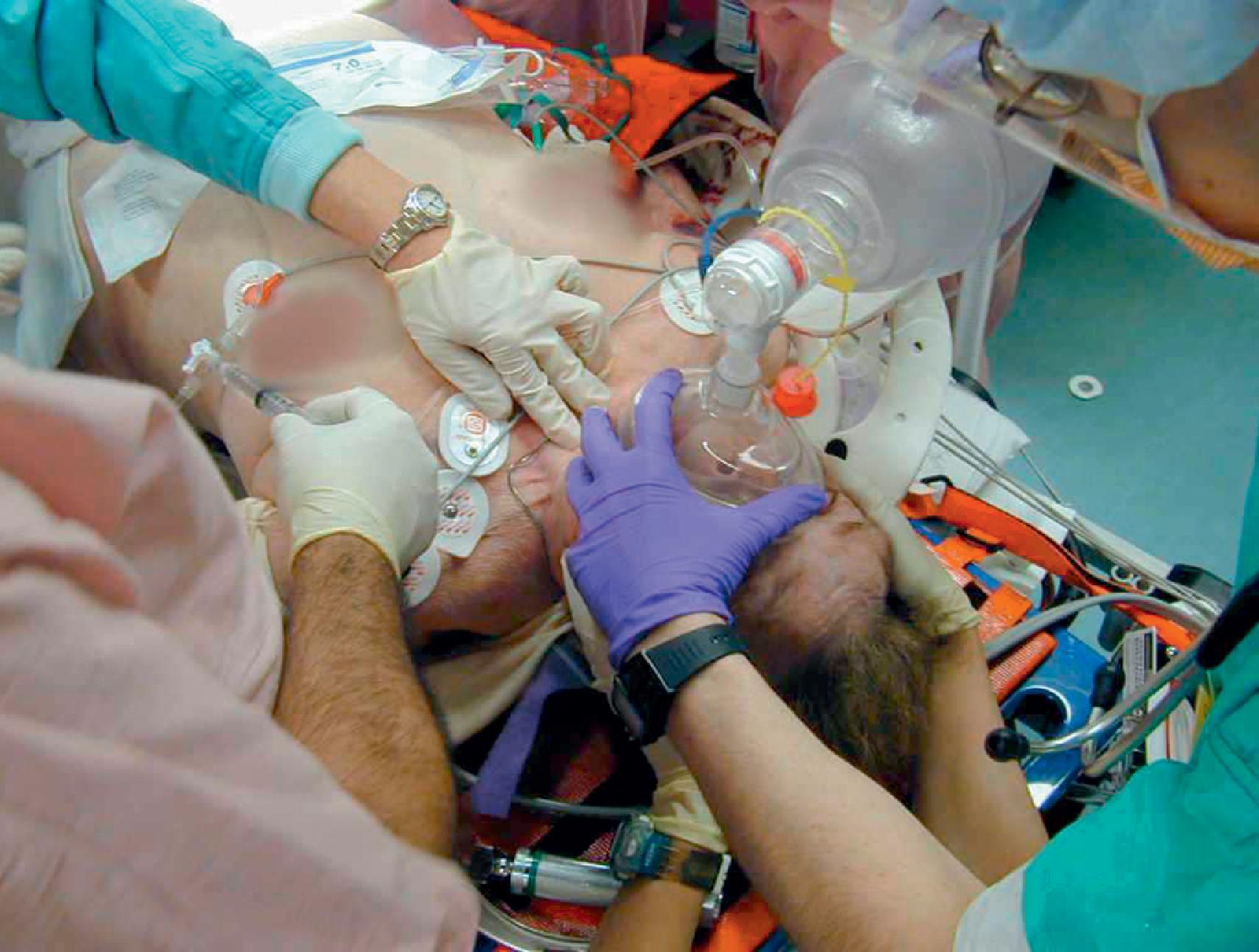
Although avoidance of BVM ventilation has been the traditional recommendation in RSII, many practitioners find that gentle mask ventilation (inspiratory pressure <20 cm H 2 O) is acceptable during the induction sequence. Gentle mask ventilation may help prevent hypoxemia in obese, pregnant, pediatric, and critically ill patients, and it also allows testing for the adequacy of mask ventilation in the event that intubation attempts fail. Additionally, to help prevent desaturation, a nasal cannula can be applied before intubation at a high flow rate (10–15 L/min) to both help with preoxygenation and to provide some degree of apneic oxygenation during intubation attempts. If a high-flow humidified nasal cannula device is available, higher rates (up to 60 L/min) can be used at higher FiO 2 (100%).
Before paralytics are given, an induction agent is administered. A review of induction agents is provided in Table 2 . Paralytics are recommended as part of RSII because omission of neuromuscular blockade has been shown to result in suboptimal intubating conditions. Either succinylcholine (1–1.5 mg/kg) or rocuronium (0.8–1.2 mg/kg) is administered for paralysis. Succinylcholine can be administered intramuscularly if an intravenous line is not established, but an increased dose of 3 to 4 mg/kg is recommended for this route. In the majority of patients, both succinylcholine and rocuronium provide optimal intubating conditions by 60 seconds when dosed appropriately. Priming doses of nondepolarizing agents are usually not considered for trauma patients because these agents must be administered at least 3 minutes before the loading dose of muscle relaxant is administered, and in elderly or debilitated patients, pretreatment with a small dose of muscle relaxant may predispose to aspiration. Succinylcholine is contraindicated in patients with burns, open globe injuries, neuromuscular disorders, hyperkalemia, pseudocholinesterase deficiency, severe crush injuries, or chronic paralysis. Rocuronium, a nondepolarizing agent, is an alternative when succinylcholine is contraindicated, but this agent cannot be administered intramuscularly, and the duration of action is much longer (typically up to 45 minutes) than succinylcholine (6–10 minutes).
| Induction Agent | Dose for RSII | Onset | Duration of Action | Comment |
|---|---|---|---|---|
| Propofol | 1–3 mg/kg | 10–30 seconds | 8–10 minutes | Dose usually reduced, sometimes by as much as 1/10 the recommended induction dose; causes decreased systemic vascular resistance and hypotension |
| Ketamine | 1–2 mg/kg IV 2–4 mg/kg IM |
30–60 seconds | 5–20 minutes | Acceptable for use in patients with increased ICP; direct myocardial depressant but has indirect stimulatory effects (best avoided in patients with coronary artery disease) |
| Etomidate | 0.2–0.3 mg/kg | 30–45 seconds | 10–20 minutes | A single dose causes adrenocortical suppression; recent evidence supports safety in septic shock |
| Remifentanil | 1 mcg/kg | 30–60 seconds | <10 minutes | 250 times more potent than morphine; may cause hypotension; not a reliable amnestic; does not accumulate; broken down by nonspecific esterases |
| Midazolam | 0.3–0.6 mg/kg | 2–3 minutes | 20–30 minutes | When combined with opioids, can cause marked hypotension and respiratory depression |
Pharmacologic adjuvants, such as opioids, may be considered during RSII, but these agents are frequently omitted because of time pressure. If administered, fentanyl (2 mcg/kg), alfentanil (20–30 mcg/kg), or remifentanil (1 mcg/kg) may help attenuate hemodynamic responses to intubation, but opioids alone do not provide adequate amnesia and are usually not recommended as sole induction agents for RSII because of a higher incidence of patient recall. Midazolam is a short-acting benzodiazepine with excellent amnestic properties that may also be given intramuscularly, but this agent may take 2 to 3 minutes to work. Following preoxygenation, intravenous lidocaine may be considered (1.5–2 mg/kg) for the theoretical benefit of preventing increases in intracranial pressure (ICP), although evidence to support the use of lidocaine is tangential and largely extrapolated from nontrauma populations. Lidocaine may precipitate hypotension—a undesirable side effect in patients with traumatic brain injury.
In many trauma centers, cricoid pressure has historically been used to prevent regurgitation. Cricoid pressure involves backward and upward application of pressure to the cricoid cartilage to occlude the esophagus; 3 to 4 kg of pressure is recommended to occlude the esophagus. The use of cricoid pressure remains controversial because the technique is often incorrectly applied, may impede laryngoscopic views, is biomechanically difficult during laryngoscopy, can cause airway trauma, and could impair bag-valve mask ventilation. If cricoid pressure is used, pressure should be released if the laryngoscopic view is poor.
Approximately 1.5% to 4% of all trauma patients may have an undiagnosed cervical spinal cord injury; hence, cervical immobilization is obligatory. Manual in-line stabilization has been shown to be superior for preventing inadvertent movement of the cervical spine during intubation compared with a cervical collar alone. During intubation, one provider is dedicated to maintaining manual in-line stabilization.
Figure 4 demonstrates the correct placement of a MacIntosh or McGill laryngoscopic blade. The laryngoscope should be held in the left hand and inserted into the right side of the patient’s mouth, displacing the tongue to the left. Video-laryngoscopes are increasingly used as alternatives to traditional laryngoscopic blades. Video-laryngoscopy offers the advantage of additional situational awareness for the trauma team and the ability to record for postprocedure quality assurance review. During laryngoscopy, the airway structures are lifted into view, avoiding using the blade as a fulcrum on the teeth, and the epiglottis and vocal cords are visualized. The endotracheal tube should be gently inserted with the cuff past the vocal cords and inflated with enough air to provide a good seal (<30 cm H 2 O). In general, intubation attempts should not take more than 30 seconds. Verification of tube placement is accomplished by auscultation of bilateral lung sounds, observation of chest rise, absence of epigastric/gastric gurgling or distension, and presence of end-tidal carbon dioxide with either a colorimetric device or continuous capnography. If a colorimetric device is used, the color indicator should change from purple to yellow, and at least six ventilations with an appropriate color change should be observed to avoid potential false positives. A chest radiograph should be obtained to confirm the position of the tube.
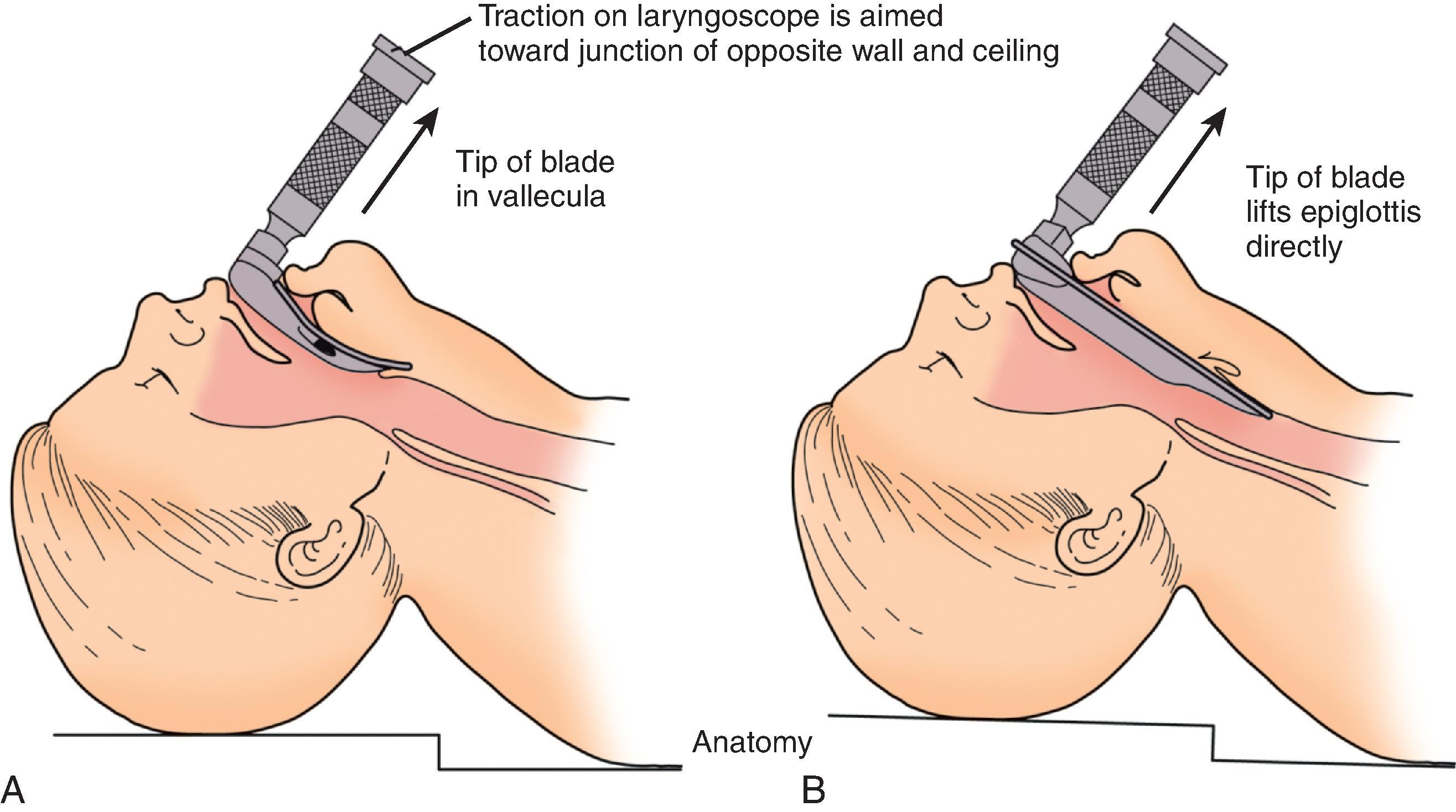
In patients with suspected cervical spine injuries, the laryngoscopic view may be impeded by the requirement of in-line cervical stabilization. For patients with a Cormack-Lehane grade 3 or 4 view, the gum elastic bougie may used to introduce the endotracheal tube. The bougie is a flexible, 60-cm, 15F introducer with a Coude tip angled at 40 degrees, 3.5 cm from the distal end ( Fig. 5 ).
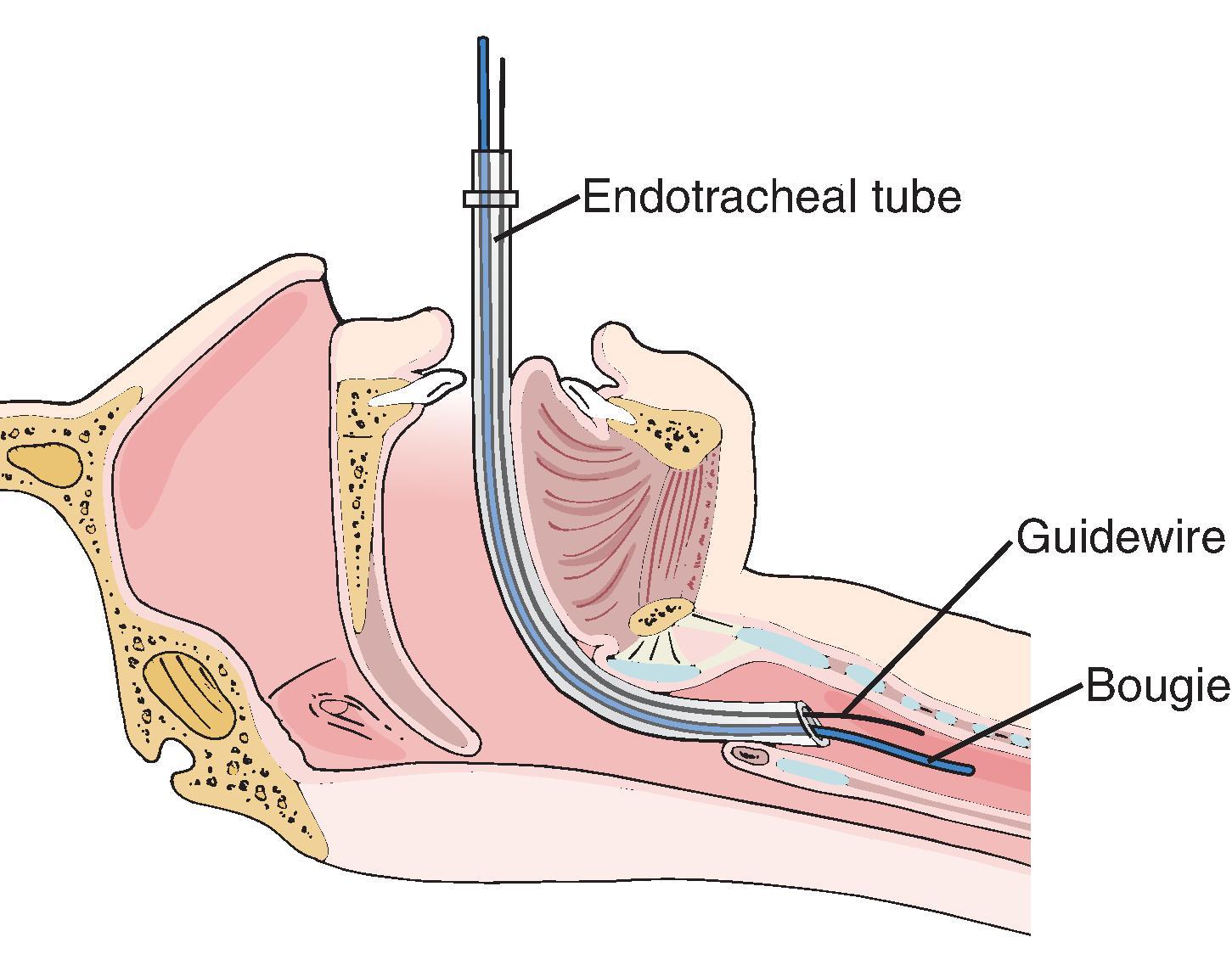
The bougie is lubricated and inserted with the Coude tip directed anteriorly, advancing until at the level of the tracheal rings. The endotracheal tube is then advanced over the bougie into the trachea.
Video laryngoscopy has evolved as a technology that allows direct visualization of the airway by all airway team members. Studies have been mixed regarding advantages for use in patients with difficult airways, but some research has shown that video laryngoscopy results in a higher success rate at first attempt compared with direct laryngoscopy, especially for less experienced airway providers. Video laryngoscopy can be used at all stages of intubation, including initial laryngoscopy, awake intubation, and to help confirm proper endotracheal tube position.
A variety of supraglottic devices exist for use when attempts at endotracheal intubation or BVM ventilation fail. Various versions of the laryngeal mask airway (LMA) are the most commonly used supraglottic airway devices currently in use. Although these devices enable ventilation, whether by providing a seal around the laryngeal inlet or occluding the esophagus, none of these devices represents a definitive airway. Each of these devices requires additional training, and all must eventually be replaced with a definitive airway in the trauma patient. In cases of traumatic arrest during prehospital management, immediate endotracheal intubation may not be feasible or safe. In these instances, placement of a supraglottic airway may be considered to prevent unacceptable pauses in chest compressions and to decrease the time to ventilation.
When patients are suspected of having cervical spinal cord injuries but do not require emergent intubation, awake fiber-optic intubation (AFOI) is one method that can be used to secure the airway. The term awake is a misnomer; the patient will maintain spontaneous ventilation throughout the procedure under sedation with amnestic agents. This method may be advantageous in patients with injuries to the cervical spine because cervical spine movements can be minimized, thus preventing neurologic impairment. Careful titration of sedation is mandatory for AFOI because abolition of spontaneous ventilation obviates any advantage when using this technique. Monitors are applied, and oxygen is delivered via a nasal cannula. Patients are premedicated with glycopyrrolate (0.2–0.4 mg) to attenuate secretions barring any known cardiac conditions in which tachycardia must be avoided. Sedation is achieved by careful administration of midazolam (0.5 mg, titrated to effect). Opioids are avoided because of the synergistic respiratory depression that occurs when these agents are coadministered with benzodiazepines; however, opioids may be used instead of benzodiazepines, keeping in mind that these opioids do not provide reliable amnesia. Alternatively, a dexmedetomidine infusion (0.2–1.5 mcg/kg/h) may be considered, but for trauma patients, this agent is seldom used because of the preparatory time required and onset of action (more than 10 minutes). For topicalization, 2 to 3 mL of 5% lidocaine ointment is applied to the posterior tongue via a tongue depressor to anesthetize the glossopharyngeal nerve. Next, 1 to 2 vials of 4% lidocaine are emptied into a specimen cup, and cotton balls (with strings attached to ensure easy retrieval from the airway) are soaked in this solution. Using either Magill forceps or a right-angle tonsil holder, the cotton balls are gently introduced deep into the pyriforms and held in place for 60 to 90 seconds. The process is repeated for each side, effectively anesthetizing both branches of the superior laryngeal nerve. Finally, an oral airway is inserted (to prevent biting of the fiber-optic scope), and the fiber-optic scope is introduced. Once the vocal cords are visualized, 1 to 2 mL of 1% or 2% lidocaine is sprayed through the injection port on the fiber-optic scope directly on the vocal cords. This anesthetizes the recurrent laryngeal nerve. Once all three nerves are anesthetized, the endotracheal tube can safely be inserted with either a video-laryngoscope (i.e., “awake” video laryngoscopy) or over a fiber-optic bronchoscope. Careful attention must be paid to the amounts of lidocaine used because a dose greater than 5 mg/kg may result in anesthetic toxicity. The technique can be modified accordingly for nasotracheal intubation with use of topical vasoconstrictors as well as anesthetics to anesthetize and mitigate bleeding in the nasal passages. It should be noted that this technique is not recommended for patients who are deemed to be at increased risk for aspiration.
For patients in need of an immediate airway, Figure 6 provides a decision algorithm. Initial priorities always include adequate preoxygenation and in-line cervical immobilization. In trauma patients, the option to awaken the patient, as one would do for an elective surgical procedure, is not feasible. After a third failed attempt at intubation by an attending anesthesiologist, an LMA can be inserted to facilitate the transition to a definitive airway via fiber-optic intubation or intubation through the LMA. However, if the airway cannot be expeditiously secured after the third laryngoscopy attempt, a surgical airway is necessary. It should be noted that in the hands of experienced trauma airway experts, the rate of conversion to a surgical airway has been reported to range from 0.2% to 2%.
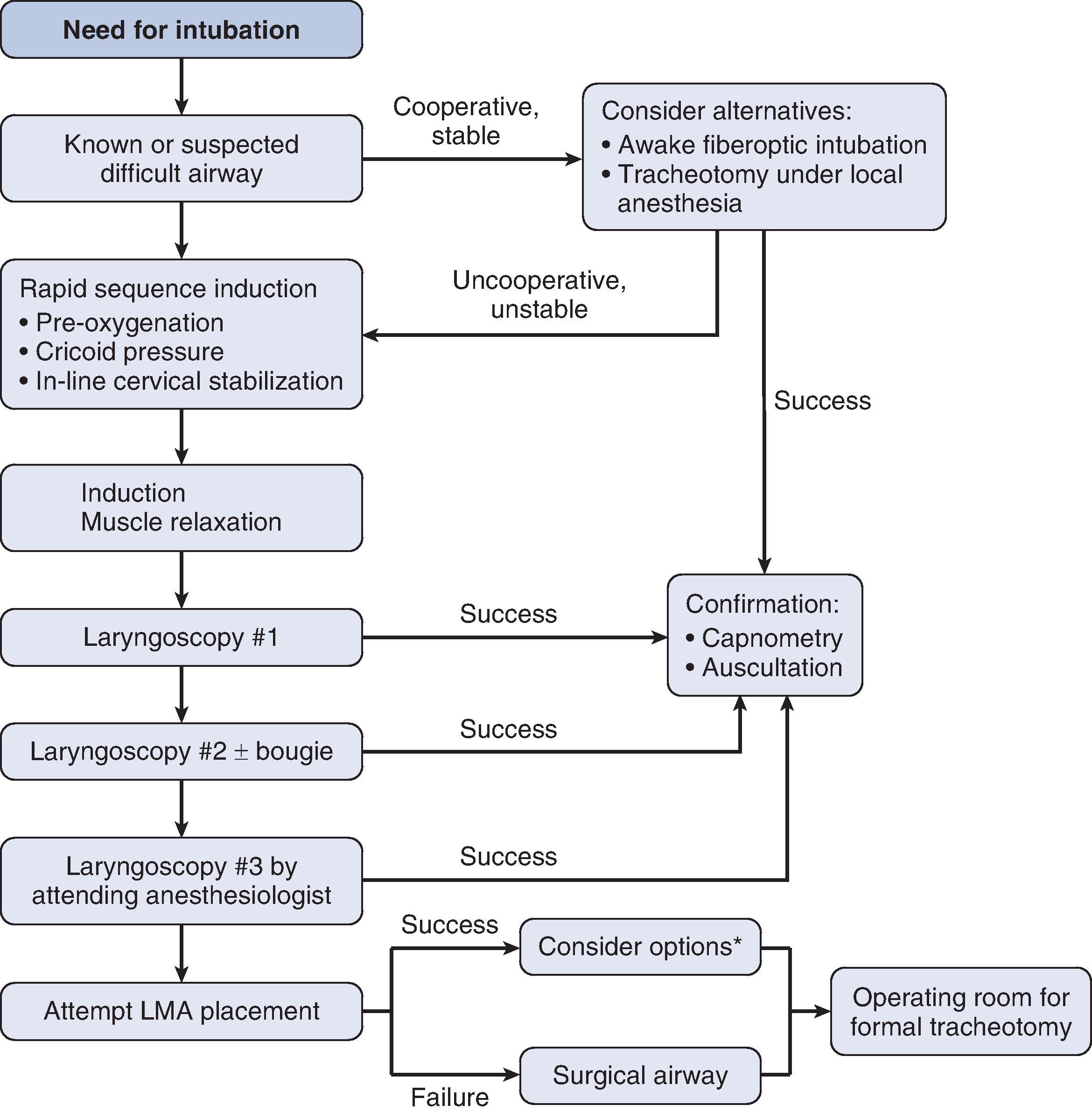
A patient committed to RSII (i.e., paralyzed), who subsequently cannot be ventilated or intubated, requires a surgical airway. Options include a surgical cricothyroidotomy or tracheostomy; cricothyroidotomy is preferred as the surgical technique of choice ( Fig. 7 ). The patient is placed in the supine position with the neck in a neutral position. After the neck is prepped and draped, the thyroid notch, thyroid cartilage, cricothyroid membrane, cricoid cartilage, and trachea are identified by palpation. Stabilizing the thyroid cartilage with one hand, a 2.0- to 2.5-cm vertical incision is made over the cricothyroid membrane with a #10 or #11 surgical blade. A hemostat or tracheal spreader is introduced into the incision and rotated 90 degrees to open the airway. Either a cuffed endotracheal tube (5.0 or 6.0 size) or tracheostomy tube is inserted through the cricothyroid membrane incision. Alternatively, a gum elastic bougie can be inserted into the opening, and an endotracheal tube or tracheostomy tube may be passed over the device into the airway. The cuff is inflated, and placement of the tube is confirmed by lung auscultation, chest rise, and end-tidal carbon dioxide detection.
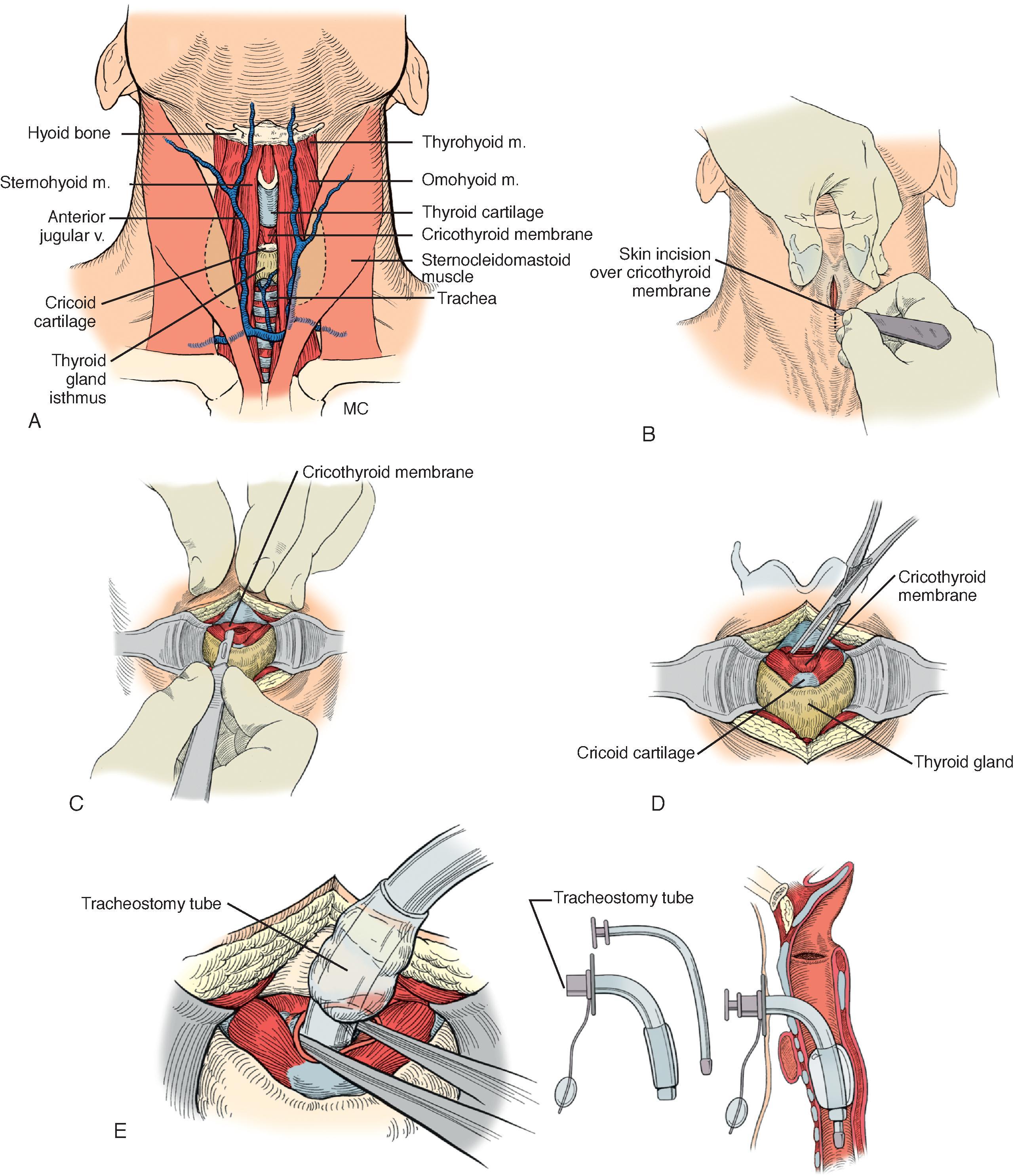
For over 30 years, surgeons in American trauma centers have successfully performed, interpreted, and taught ultrasound examinations for patients who are injured or critically ill. According to the Rogers Diffusion of Innovations Theory, surgeons are considered to be early adopters of the technology, and their presence in so many areas of the hospital helped promote ultrasound as a useful tool for the evaluation of patients in the elective and emergent settings. Real-time imaging allows the surgeon to receive instantaneous information about the clinical condition of the patient and therefore helps expedite the patient’s management. In many trauma centers, ultrasound machines are standard equipment in the trauma resuscitation rooms. Although diagnostic peritoneal lavage (DPL) and computed tomography (CT) scanning are still valuable diagnostic tests for the detection of intraabdominal injury, ultrasound is faster, noninvasive, painless, and well tolerated by adults and children. Moreover, the portability of the ultrasound machine allows for an evaluation of the patient in multiple settings, including the trauma bay and intensive care unit (ICU).
As an extension of the physical examination, surgeons routinely use ultrasound in the acute setting to determine the presence or absence of fluid in the peritoneal cavity, the pericardium, and the pleural cavities. Additional uses of this modality include the detection of pneumothoraces and sternal fractures. What follows is a discussion of the use of ultrasound in blunt and penetrating thoracoabdominal trauma with an additional discussion of the use of ultrasound in the ICU.
Developed for the evaluation of injured patients, the F ocused A ssessment for the S onographic Evaluation of the T rauma Patient (FAST) is a rapid diagnostic examination to assess patients with potential injuries to the thorax or abdomen. The test sequentially surveys for the presence or absence of fluid in the pericardial sac and in the dependent abdominal regions, including the Morison pouch of the right upper quadrant (RUQ), the left upper quadrant (LUQ) behind the spleen and between the spleen and kidney, and the pelvis posterior to the bladder.
The FAST is performed in a specific sequence; the pericardial area is visualized first so blood within the heart can be used as a standard to set the gain. Most modern ultrasound machines have presets so the gain does not need to be reset each time the machine is turned on. Occasionally, if multiple types of examinations are performed with different transducers, the gain should be checked to ensure that intracardiac blood appears anechoic. This maneuver ensures that hemoperitoneum will also appear anechoic and will be readily detected on the ultrasound image. The abdominal part of the FAST should begin with a survey of the RUQ, which is the location within the peritoneal cavity where blood most often accumulates and is most readily detected with the FAST. In a multicenter trial of 275 blunt and penetrating trauma patients, investigators found that regardless of the injured organ (with the exception of those patients who had an isolated perforated viscus), blood was most often identified on the RUQ image of the FAST. This can be a timesaving measure because when hemoperitoneum in the RUQ view is identified on the FAST examination of a hemodynamically unstable patient, then that image alone, in combination with the patient’s clinical picture, is sufficient to justify an immediate abdominal operation. In a hemodynamically stable patient, following the examination of the RUQ, the LUQ and pelvis are visualized as discussed in the following sections.
Ultrasound transmission gel is applied on four areas of the thoracoabdomen, and the examination is conducted in the following sequence: the pericardial area, RUQ, LUQ, and pelvis ( Fig. 1 ). Abdominal structures are best imaged with a lower-frequency transducer, which allows for deeper penetration into tissues (sacrificing some resolution). Most ultrasound transducers are now capable of imaging in multiple frequencies, which allows the sonographer to achieve the best balance of resolution (higher frequency) and tissue penetration (lower frequency) based on a patient’s individual body habitus.
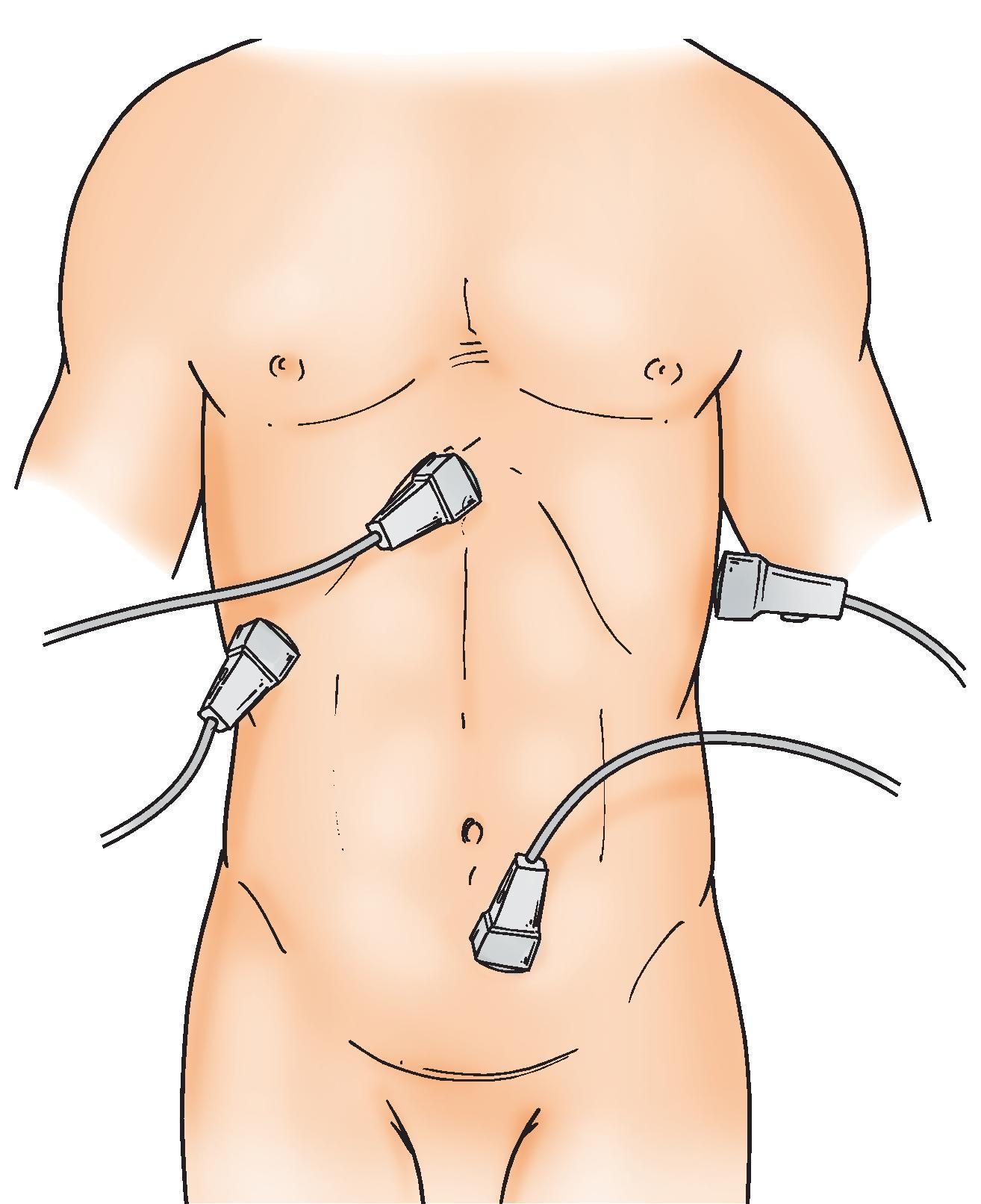
To begin the examination, a 3.5-MHz curvilinear transducer is oriented for sagittal or longitudinal views and positioned in the subxiphoid region to identify the heart and to examine for blood in the pericardial sac. The normal and abnormal views of the pericardial area are shown in Figure 2 . The subxiphoid image is usually not difficult to obtain, but a severe injury to the chest wall, a very narrow subcostal area, subcutaneous emphysema, or morbid obesity can prevent a satisfactory examination. Both of the latter conditions are associated with poor imaging because air and fat reflect the wave too strongly and prevent penetration into the target organ. If the subcostal pericardial image cannot be obtained or is suboptimal, a parasternal ultrasound view of the heart should be performed.
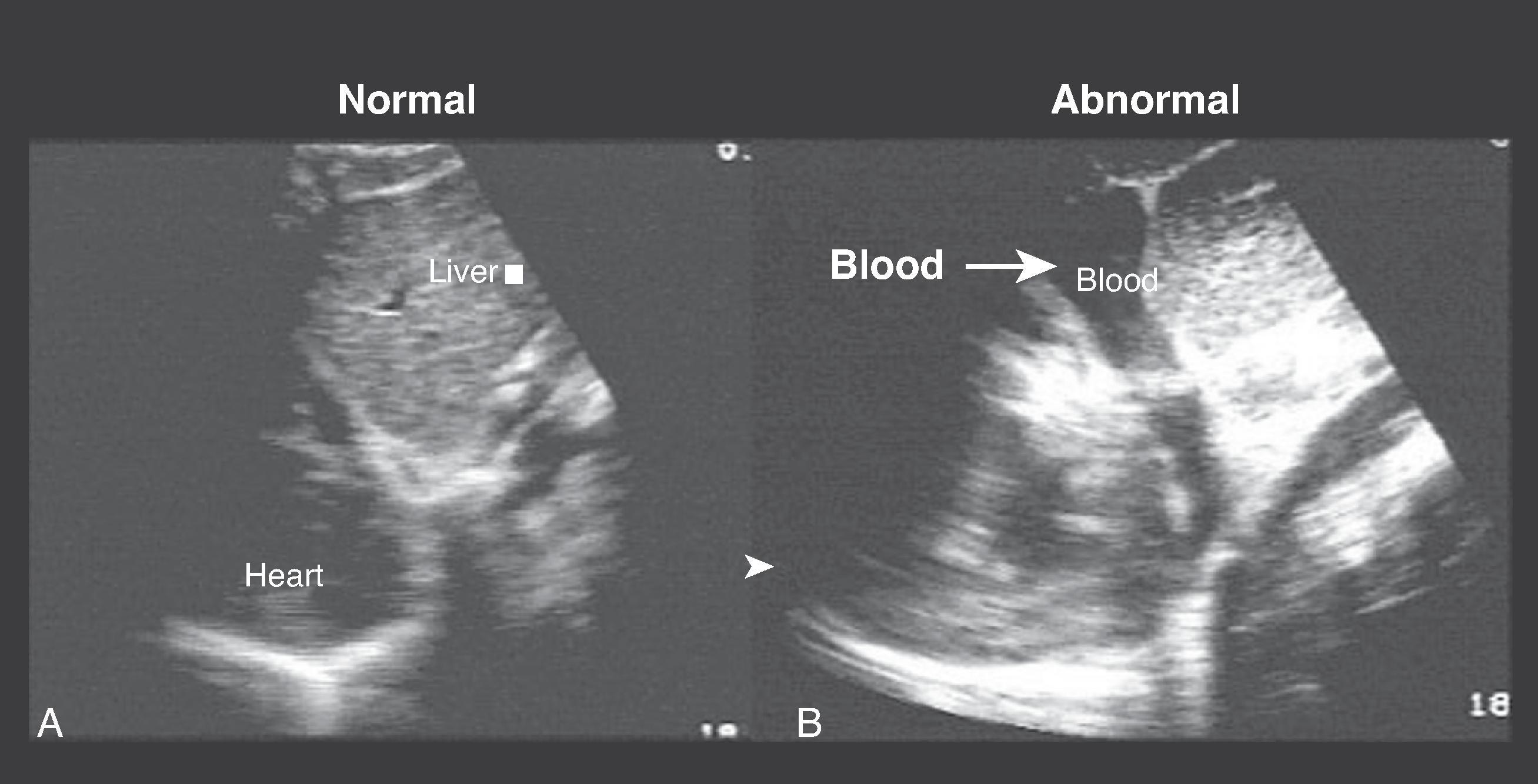
Next, the transducer is placed in the right anterior or mid-axillary line between the eleventh and twelfth ribs to identify a sagittal section of the liver, kidney, and diaphragm ( Fig. 3 ). The presence or absence of blood is sought in Morison’s pouch and in the right subphrenic space. Next, attention is turned to the LUQ. With the transducer positioned in the left posterior axillary line between the tenth and eleventh ribs, the spleen and kidney are visualized, and blood is sought in between the two organs and in the left subphrenic space ( Fig. 4 ). The splenic window is often the most difficult to obtain as the presence of gas in the stomach may interfere with the imaging. To ensure the best imaging, the stomach may need decompression with a nasogastric tube. Further, the transducer should be placed significantly more posterior (posterior axillary line) and superior (one to two rib spaces higher) than with the RUQ window.
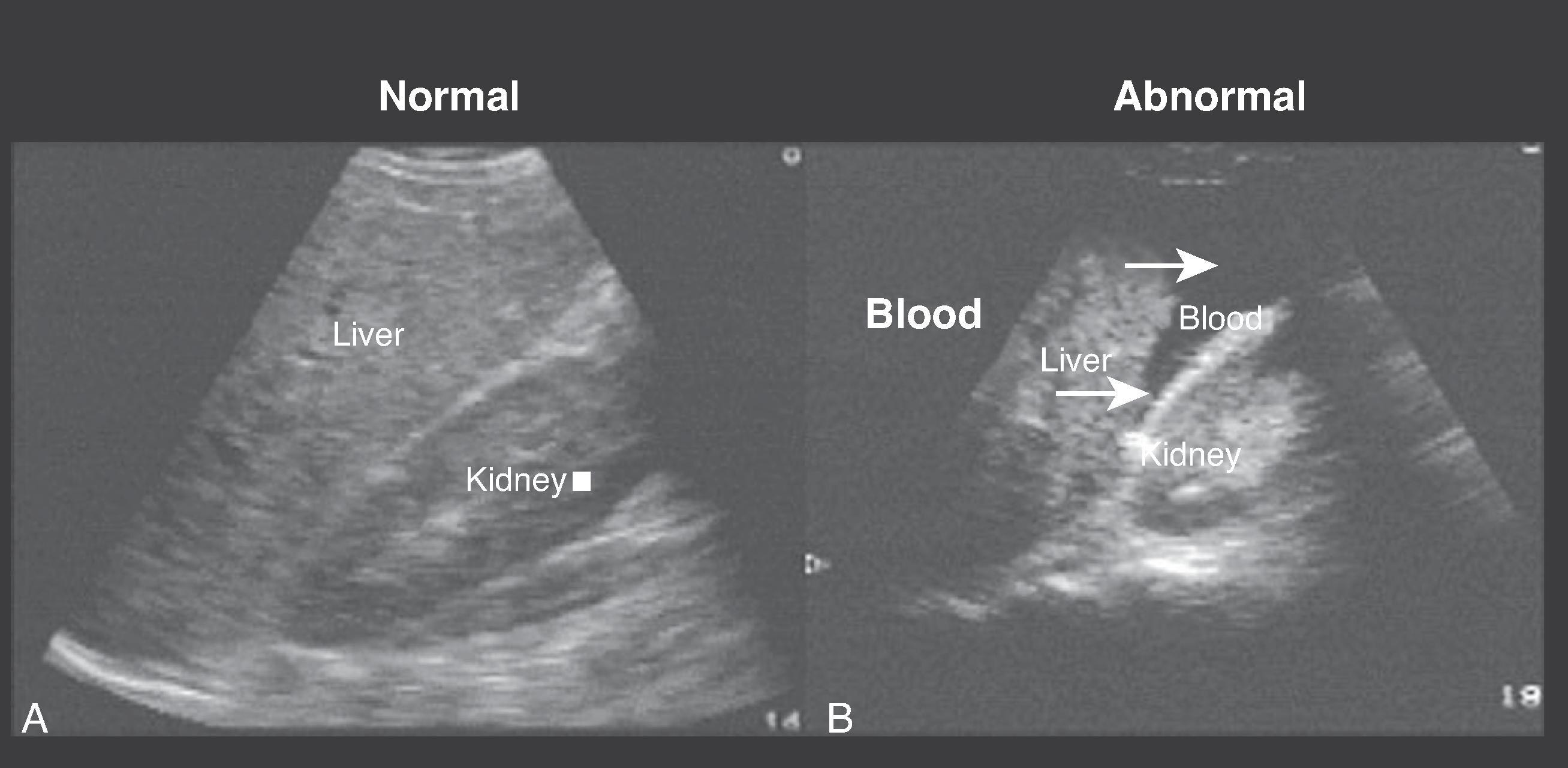
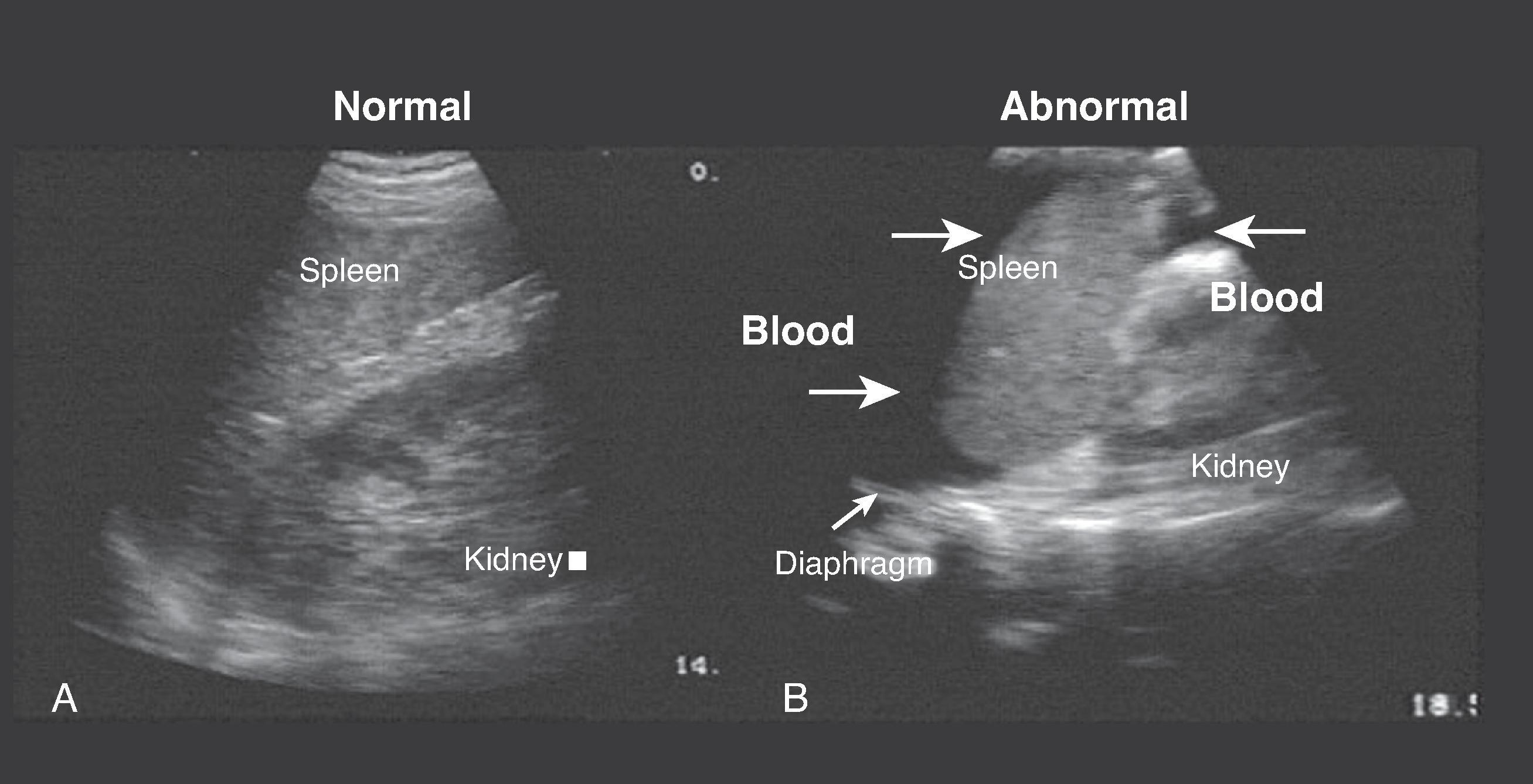
Finally, the transducer is directed for a transverse view and placed about 4 cm superior to the symphysis pubis. It is swept inferiorly to obtain a coronal view of the full bladder and the pelvis examining for the presence or absence of blood ( Fig. 5 ).
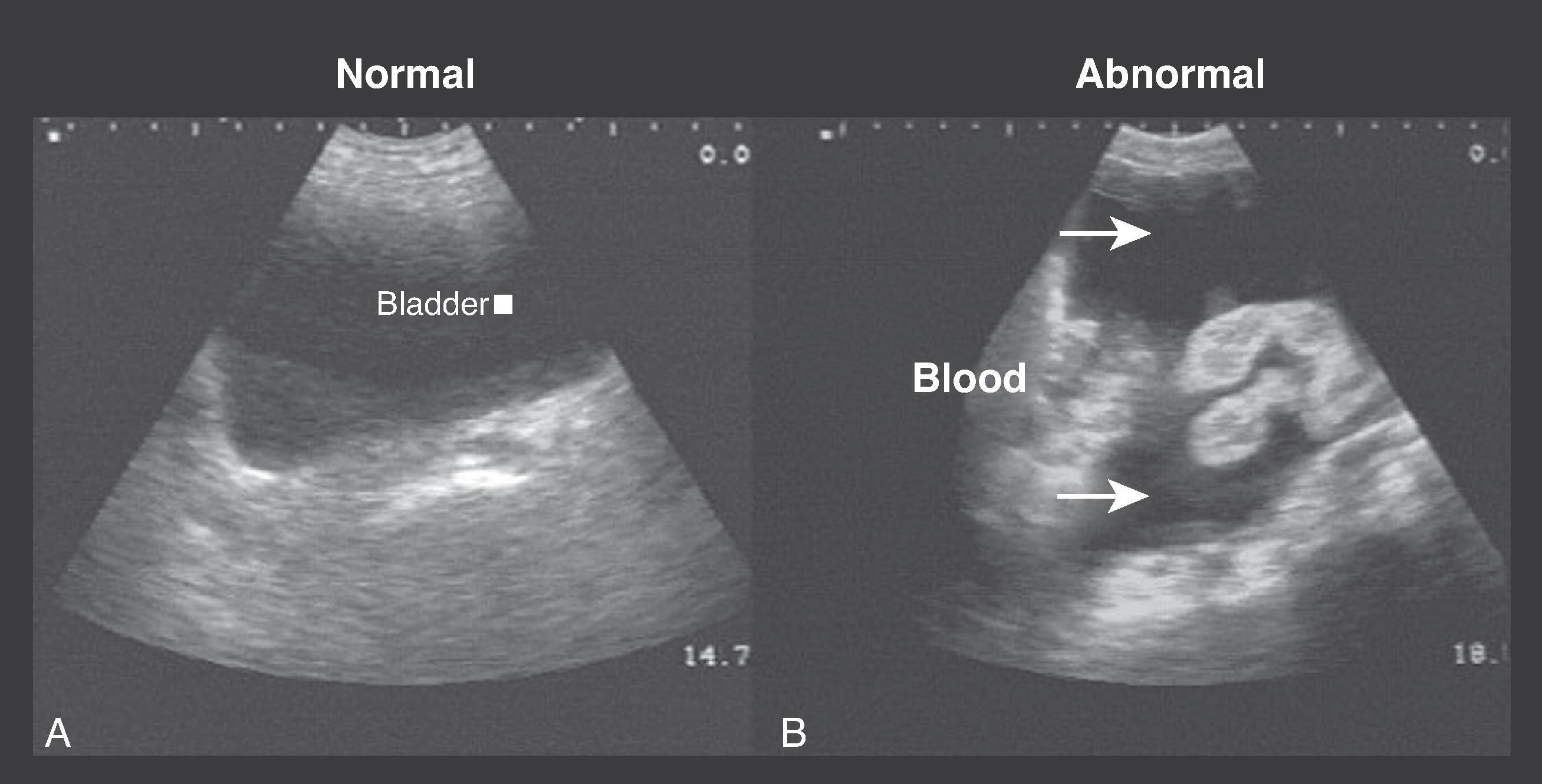
Improper technique, inexperience of the examiner, and inappropriate use of ultrasound have long been known to adversely affect ultrasound imaging. More recently, the etiology of injury, the presence of hypotension on admission, and select associated injuries have also been shown to influence the accuracy of this modality. Failure to consider these factors has led to inaccurate assessments of the accuracy of the FAST by inappropriately comparing it to a CT scan and not recognizing its role in the evaluation of patients with penetrating torso trauma. Both false-positive and false-negative pericardial ultrasound examinations have been reported to occur in the presence of a massive hemothorax or mediastinal blood. Repeating the FAST after the insertion of a tube thoracostomy improves visualization of the pericardial area and decreases the number of false-positive and false-negative studies. Notwithstanding these circumstances in which false studies may occur, a rapid focused ultrasound survey of the subcostal pericardial area is a very accurate method to detect hemopericardium in most patients with penetrating wounds in the “cardiac box.” In a large multicenter study of patients who sustained either blunt or penetrating injuries, the FAST was 100% sensitive and 99.3% specific for detecting hemopericardium in patients with precordial or transthoracic wounds. Furthermore, the use of pericardial ultrasound has been shown to be especially helpful in the evaluation of patients who have no overt signs of pericardial tamponade. This was highlighted in a study in which 10 of 22 patients with precordial wounds and hemopericardium on ultrasound examination had admission systolic blood pressures >110 mm Hg and were relatively asymptomatic. Based on these signs and the lack of symptoms, it is unlikely that the presence of cardiac wounds would have been strongly suspected in these patients; therefore this rapid examination provided an early diagnosis of hemopericardium before the patients underwent physiologic deterioration.
The FAST is a focused examination for the detection of fluid in dependent areas of the abdomen and is designed to answer the simple question of “fluid or no fluid.” Therefore, its results should not be compared with those of a CT scan because the FAST does not readily identify intraparenchymal or retroperitoneal injuries. Therefore select patients considered to be at high risk for occult intraabdominal injury should undergo CT of the abdomen regardless of the results of the FAST examination. These patients include those with fractures of the pelvis or thoracolumbar spine, major thoracic trauma (pulmonary contusion, lower rib fractures), and hematuria.
A focused thoracic ultrasound examination was developed by surgeons to rapidly detect the presence or absence of a traumatic hemothorax in injured patients. This examination is worthwhile because it dramatically shortens the interval from the diagnosis of a hemothorax to the insertion of a thoracostomy tube.
The technique for this examination is like that used to interrogate the upper quadrants of the abdomen in the FAST and uses the same type and frequency transducer. With the patient in the supine position, it is performed one to two rib spaces higher than the RUQ and LUQ FAST views. Ultrasound transmission gel is applied to the right and left lower thoracic areas in the mid to posterior axillary lines between the ninth and tenth intercostal spaces ( Fig. 6 ). The transducer is slowly advanced cephalad to identify the hyperechoic diaphragm and to interrogate the supradiaphragmatic space for the presence or absence of fluid ( Fig. 7 ), which appears anechoic. In the positive thoracic ultrasound examination, the hypoechoic lung can be seen “floating” amidst the fluid. The same technique can be used to evaluate a critically ill patient for a pleural effusion.
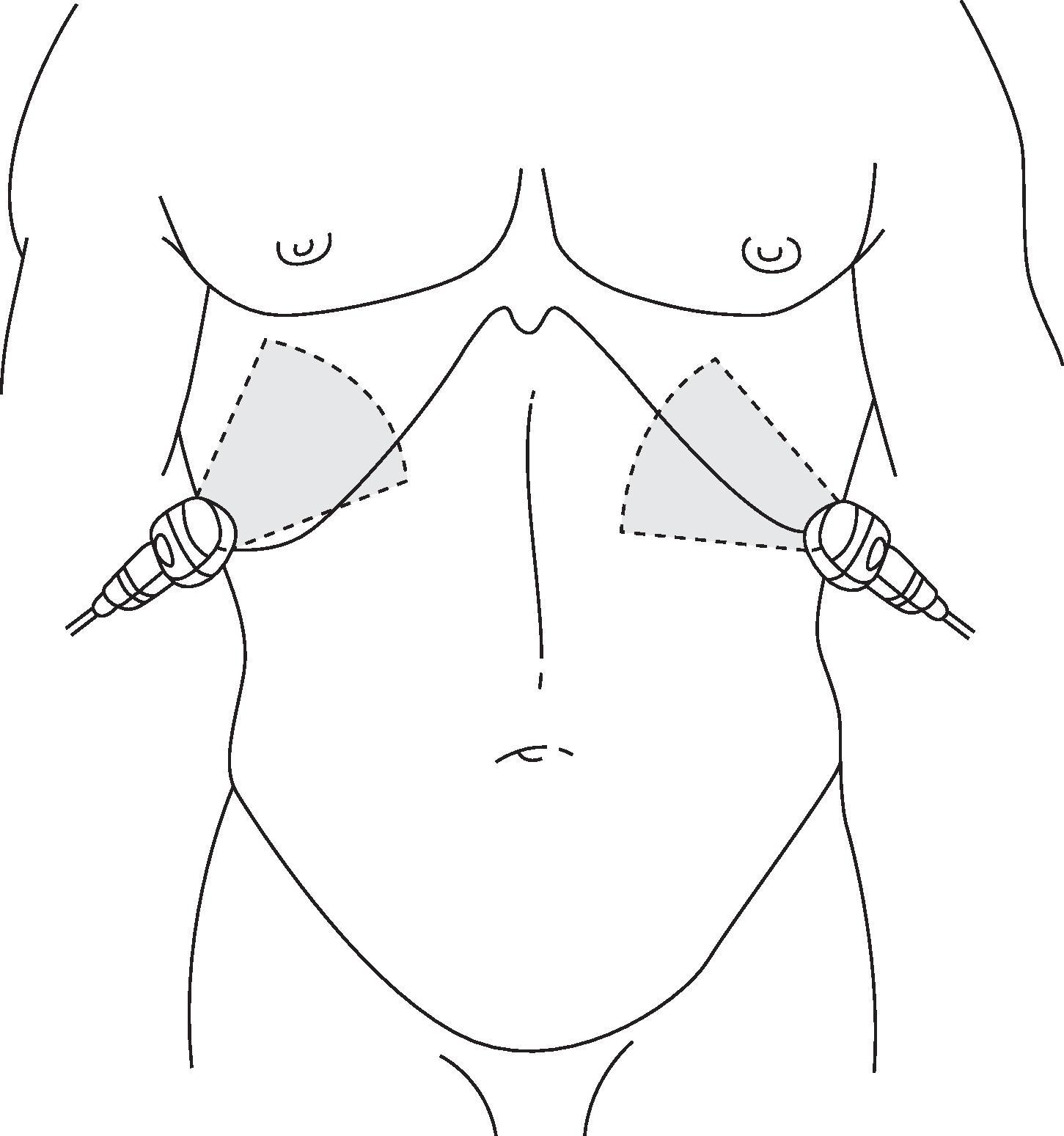
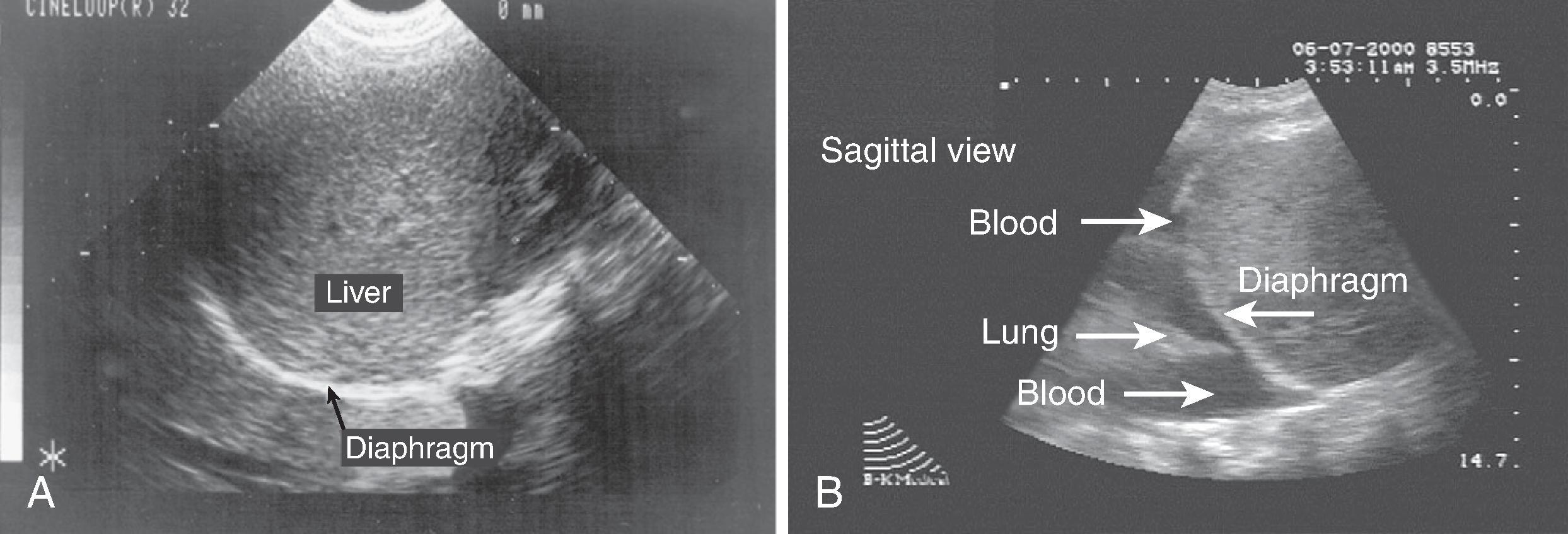
A study that compared the time and accuracy of ultrasound with that of the supine portable chest x-ray found both to have similar high sensitivities and specificities for the detection of hemothorax, but performance times for the thoracic ultrasound examinations were statistically much faster ( P < 0.0001) than those for the portable chest x-ray. Although it is not recommended that the thoracic ultrasound examination replace the chest x-ray, its use can expedite treatment in many patients and decrease the number of chest radiographs obtained.
Ultrasound examination for the detection of a pneumothorax is unique in that there is an absence of two findings. The first is a refraction artifact called a comet tail that results from the interaction of air with the lung tissue ( Fig. 8 ). The second finding is pleural sliding, which indicates that the visceral and parietal layers of the pleura are in normal apposition. Hence a pneumothorax is not visualized on ultrasound but rather diagnosed by the absence of these two normal findings.
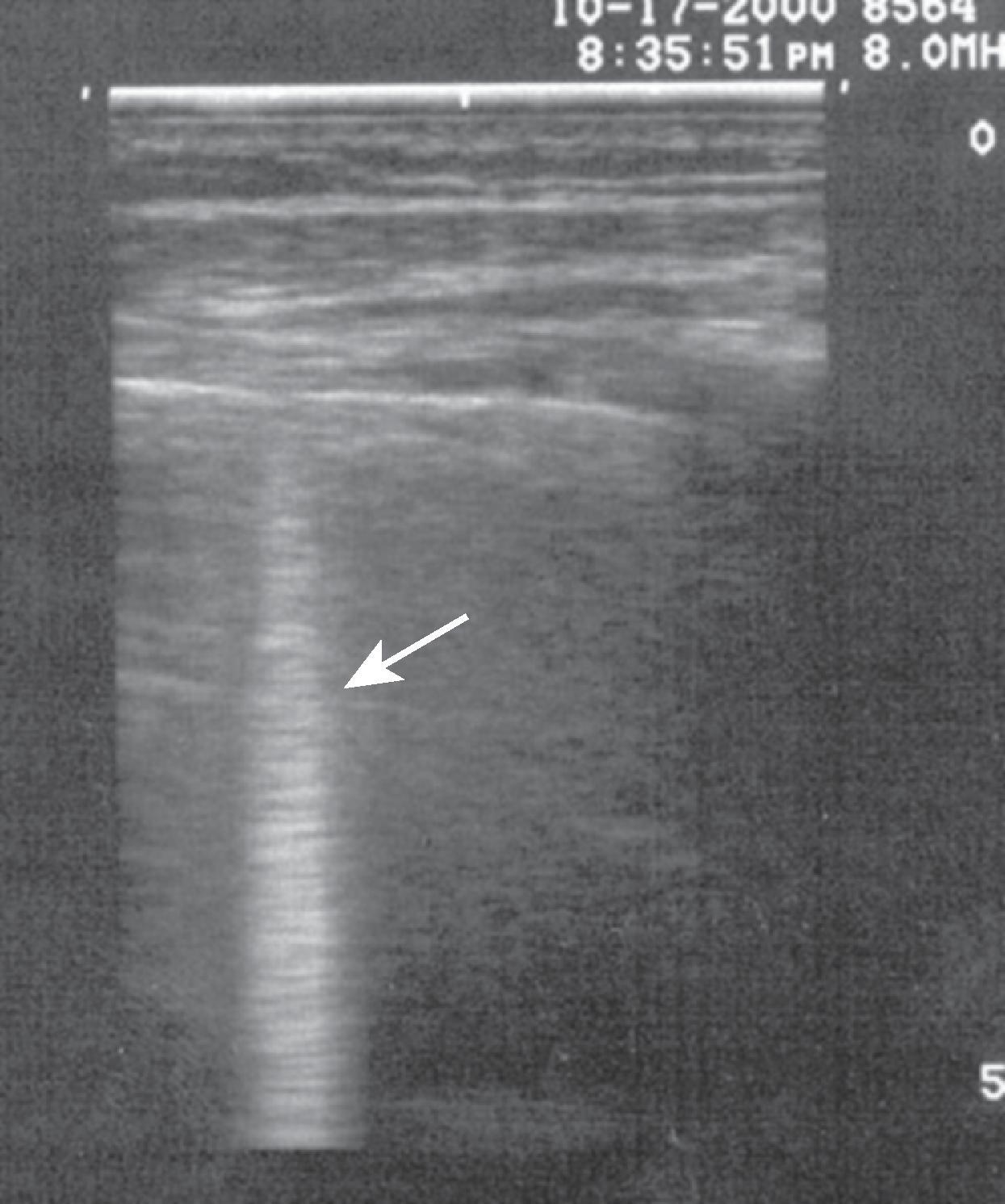
A 5.0- to 7.5-MHz linear array transducer is used to evaluate a patient for the presence of a pneumothorax. The examination may be performed while the patient is in the erect or the supine position. Ultrasound transmission gel is applied to the right and left upper thoracic areas at about the third to fourth intercostal space in the mid-clavicular line, and the presumed unaffected thoracic cavity is examined first. The transducer is oriented for longitudinal imaging, placed perpendicular to the ribs, and slowly advanced medially toward the sternum and then laterally toward the anterior axillary line. When a pneumothorax is present, air becomes trapped between the visceral and parietal pleura and does not allow for the transmission of the ultrasound waves. Therefore, the visceral pleura is not imaged, and pleural sliding and the comet tail artifact are not observed. If desired, the examination may be repeated with the transducer oriented for transverse views, with images obtained with the probe parallel to the ribs.
Several studies have documented the sensitivity and specificity of ultrasound for the detection of a pneumothorax. Dulchavsky and colleagues showed that ultrasound can be successfully used by surgeons to detect a pneumothorax in injured patients. Of the 382 patients (362 trauma; 18 spontaneous) evaluated with ultrasound, 39 had pneumothoraces, and ultrasound successfully detected 37 of them, yielding 95% sensitivity. Pneumothoraces in two patients could not be detected because of the presence of significant subcutaneous emphysema. The authors recommended that when a portable chest x-ray cannot be readily obtained, the use of this bedside ultrasound examination for the identification of a pneumothorax could expedite the patient’s management.
Fractures of the sternum are visualized on a lateral x-ray view of the chest, but this film may be difficult to obtain in a multisystem injured patient. Therefore, an ultrasound examination of the sternum can rapidly detect a fracture while the patient is still in the supine position, thus avoiding the need to obtain a lateral x-ray of the chest wall.
With the patient in the supine position, the ultrasound examination of the sternum is performed using a high-frequency linear array transducer that is oriented for sagittal or longitudinal views. Beginning at the suprasternal notch, the transducer is slowly advanced in a caudad direction to interrogate the sternum for a fracture, and then the examination is repeated with the transducer oriented for transverse views. The examination of the intact sternum is shown in Figure 9 . A sternal fracture is identified on the ultrasound examination as a disruption of the cortical reflex ( Fig. 10 ). Investigators have found that the use of ultrasound for this diagnosis is as accurate (and much more rapid) than a lateral view x-ray examination of the chest.
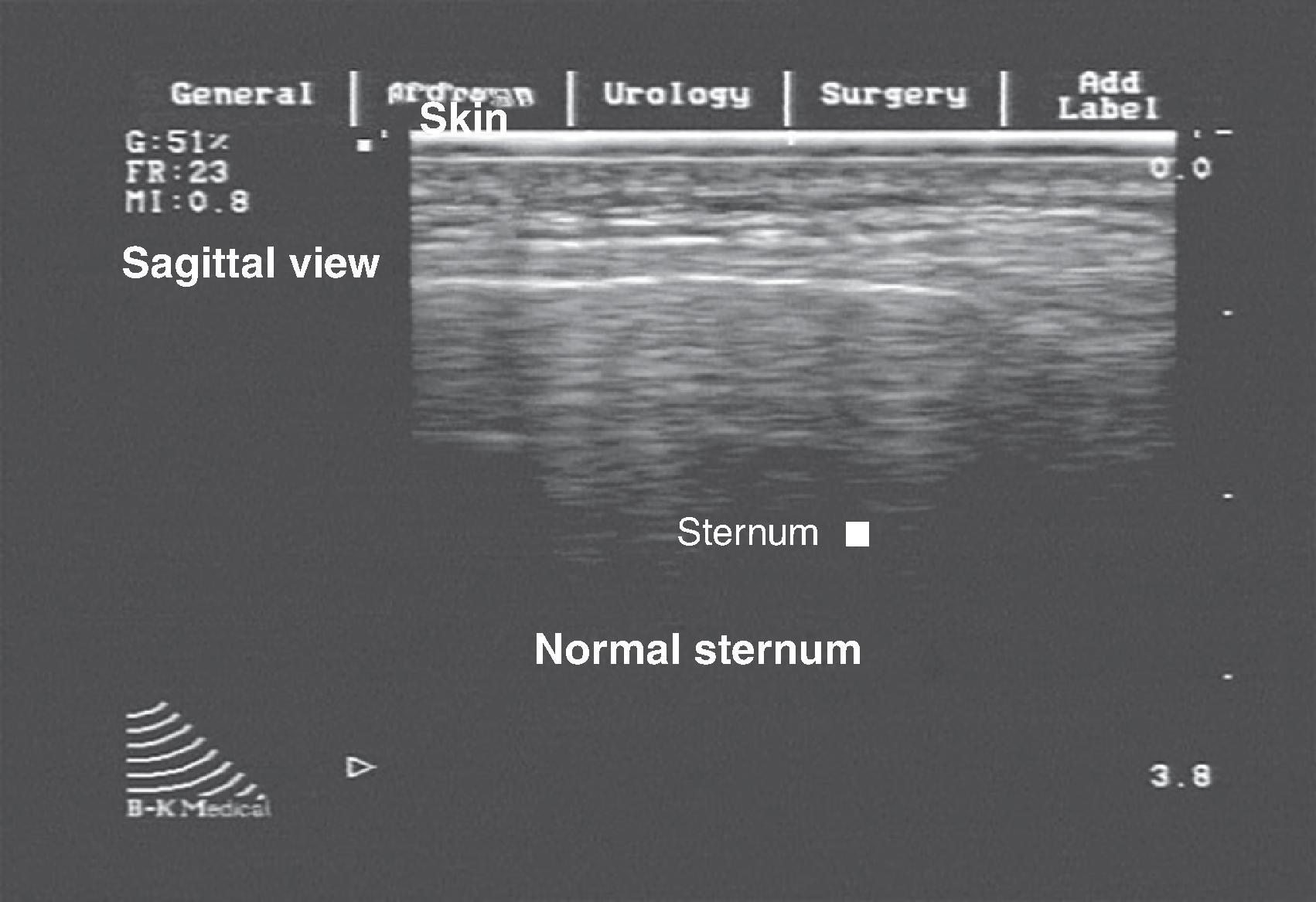
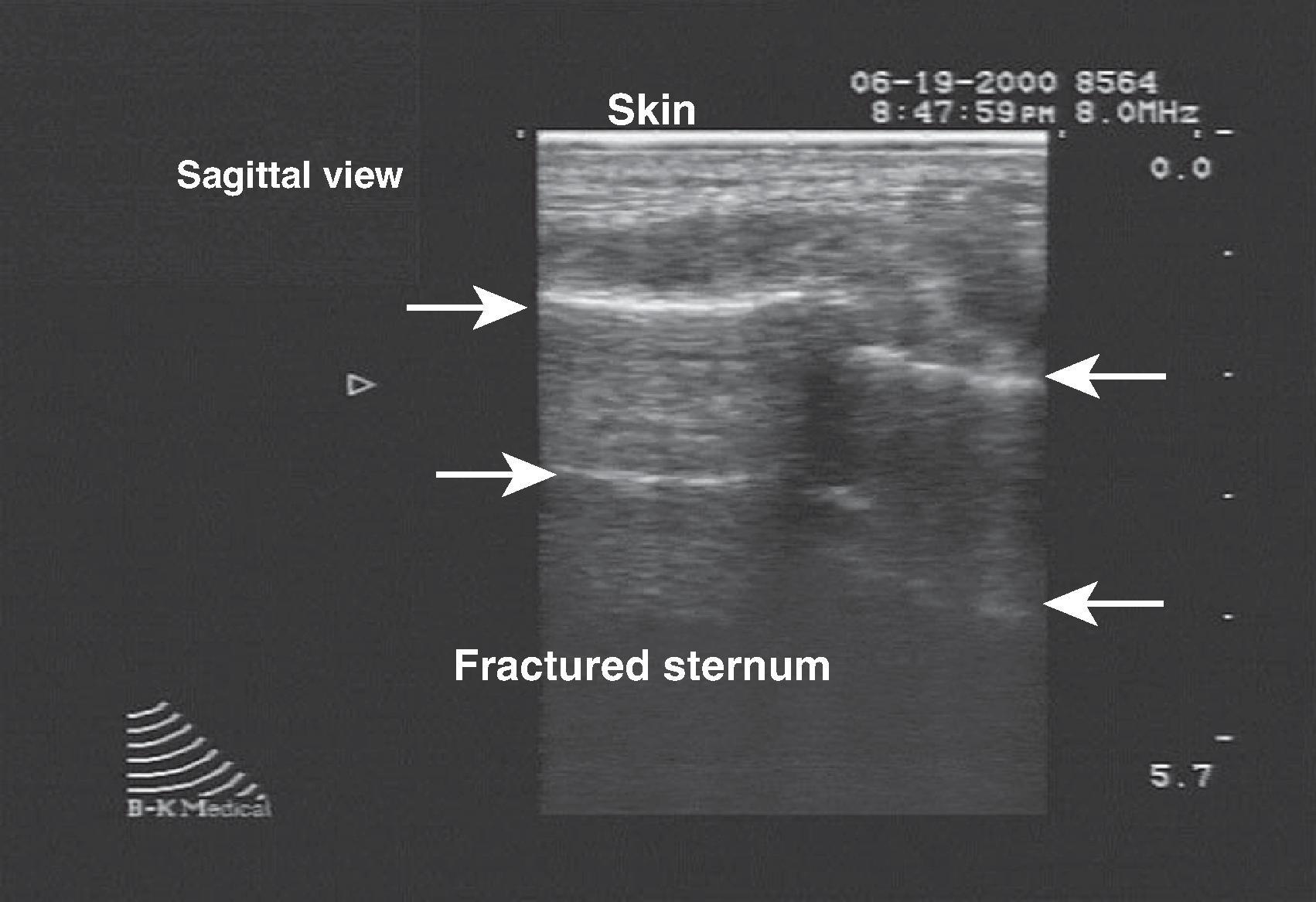
Ultrasound would seem to be an ideal method of evaluating an injured pregnant patient, but the data do not support it to be a very sensitive test for the detection of intraabdominal fluid because of the anatomic changes of pregnancy.
Ultrasound for diagnosis of injuries after penetrating trauma has been studied much less extensively than its use in blunt trauma. Ultrasound has a high sensitivity and specificity for the diagnosis of hemopericardium in patients with penetrating injury to the “cardiac box.” But, when compared with local wound exploration of a stab wound to the abdomen, the sensitivity is poor. A report by Murphy et al. examined the utility of ultrasound to diagnose fascial penetration after anterior abdominal stab wounds. In this study, 35 patients underwent ultrasonic evaluation of their anterior abdominal fascia with an 8.0-MHz linear array transducer followed by a local wound exploration. Although ultrasound had only a 59% sensitivity (13/22 patients), it did have 100% specificity with no false-positive studies. Thus, if fascial penetration is noted on ultrasound, a more invasive wound exploration is probably not needed. However, under these circumstances, a negative ultrasound evaluation is clearly less helpful and does not preclude peritoneal penetration.
With technologic advancements, ultrasound has been shown to be a valuable tool for the evaluation of critically ill patients. Performed by the intensivist at the bedside, these focused examinations are useful for a number of diagnostic dilemmas and procedures, including the detection and drainage of a pleural effusion, rapid evaluation of hypotension of unknown origin, diagnosis of deep vein thrombosis (DVT), and rapid diagnosis of central venous line complications immediately after placement. In several studies, ultrasound findings have contributed to a change in the patient’s management and, consequently, to a decrease in morbidity and length of stay.
The superiority of ultrasound over plain radiography for the detection of pleural fluid is well documented. On ultrasound examination, pleural effusion is identified as an anechoic area surrounded by the chest wall, lung, and diaphragm. Diaphragmatic motion with respiration and the movement of the lung in the surrounding pleural fluid effusion aid in the diagnosis. Once diagnosed, ultrasound-guided drainage optimizes the location, ensures complete drainage, and minimizes the complication of a pneumothorax.
The patient is placed in the supine position, and the head of the bed is elevated 45 to 60 degrees. A 3.5- or 5-MHz curvilinear transducer, oriented for sagittal sections, is placed at the 9th to 10th intercostal space in the mid to posterior axillary line. The transducer is advanced cephalad until the hyperechoic diaphragm, the subdiaphragmatic organs (liver or spleen), chest wall, lung, and effusion are seen. A felt-tipped pen is used to mark the spot where the needle will enter the chest. The image is frozen, and the distance is measured from the mark to the mid-portion of the effusion to choose the correct needle length. The needle is attached to a syringe and advanced superior to the rib (to avoid the neurovascular bundle) while aspirating until pleural fluid is returned. Using the same principles, the pleural effusion can be easily drained via a thoracostomy tube using the Seldinger technique via a wide variety of commercially available drainage kits.
Venous thromboembolic disease is a common cause of morbidity and mortality in the critical care population and has a reported incidence of 5% to 60% in high-risk injured patients. The use of a focused ultrasound examination performed at the bedside by critical care physicians can provide valuable information to potentially support or exclude the diagnosis of DVT. In 2010, Pierre and colleagues reported their results of a multicenter retrospective study of critically ill patients suspected of having a DVT. They compared a focused intensivist-performed ultrasound evaluation with the standard duplex study and found that their focused examination compared favorably with the duplex study, showing a sensitivity and specificity of 88% and 98% versus 85% and 100%, respectively. In addition, the intensivist-performed focused examination confirmed the diagnosis of DVT 14 hours sooner than the duplex study.
The patient is placed in the supine position with the leg externally rotated and the knee flexed. A high frequency, 7- to 12-MHz linear transducer is placed in the transverse position just inferior to the inguinal ligament, where the common femoral vein is identified. Compression is applied while sliding the transducer distally along the common femoral vasculature until the deep femoral vein and superficial femoral veins are visualized. The examination is repeated with the transducer oriented in the sagittal position ( Fig. 11 ). If the vein is well visualized, it is followed distally to the popliteal area. Although this focused examination does not include flow dynamics, it covers the most common areas where DVT is found, that is, common, deep, and superficial femoral veins and popliteal veins. The findings consistent with a DVT are inability to fully compress the vein and the presence of hyperechoic intraluminal material (i.e., clot; Fig. 12 ).
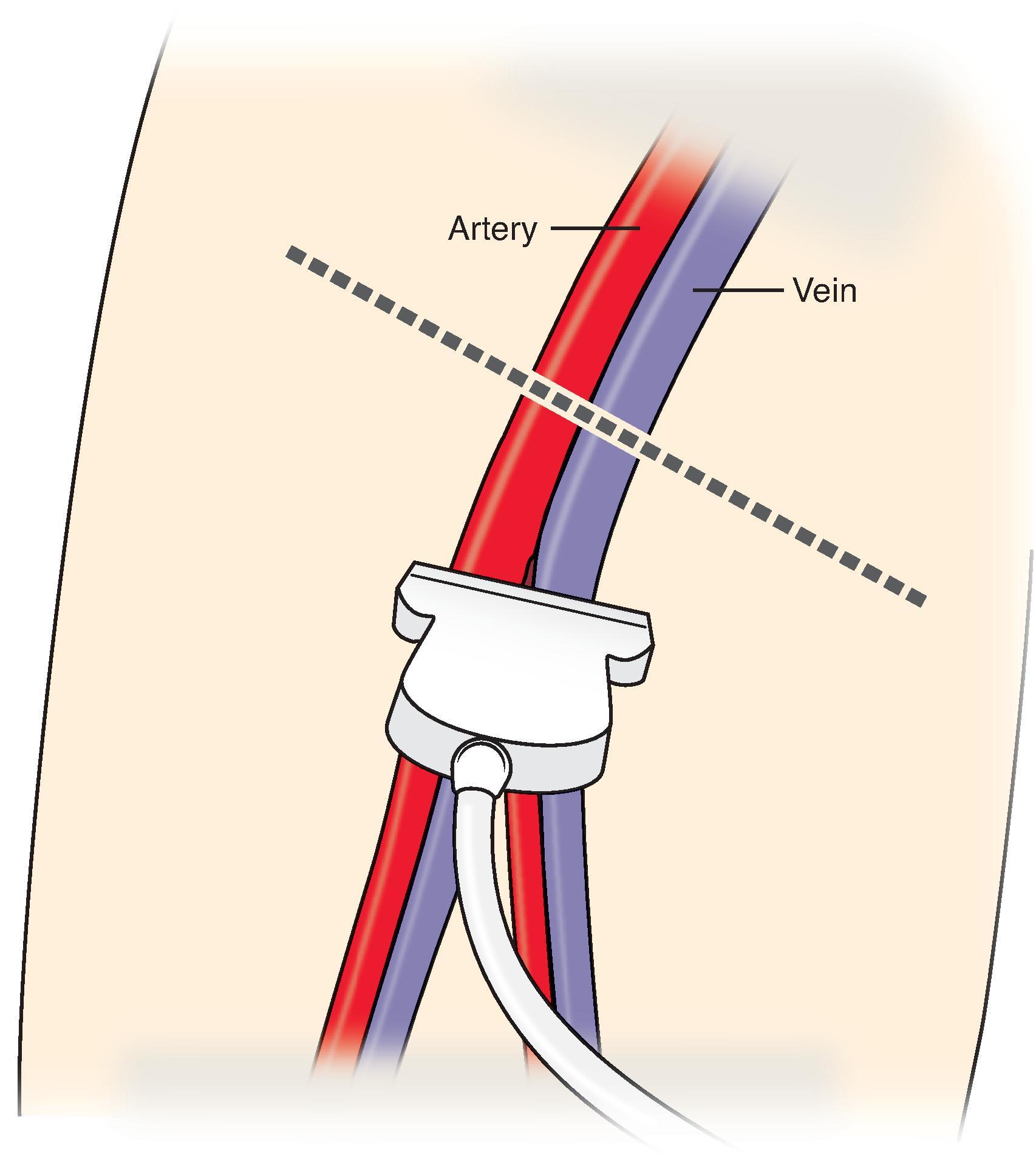
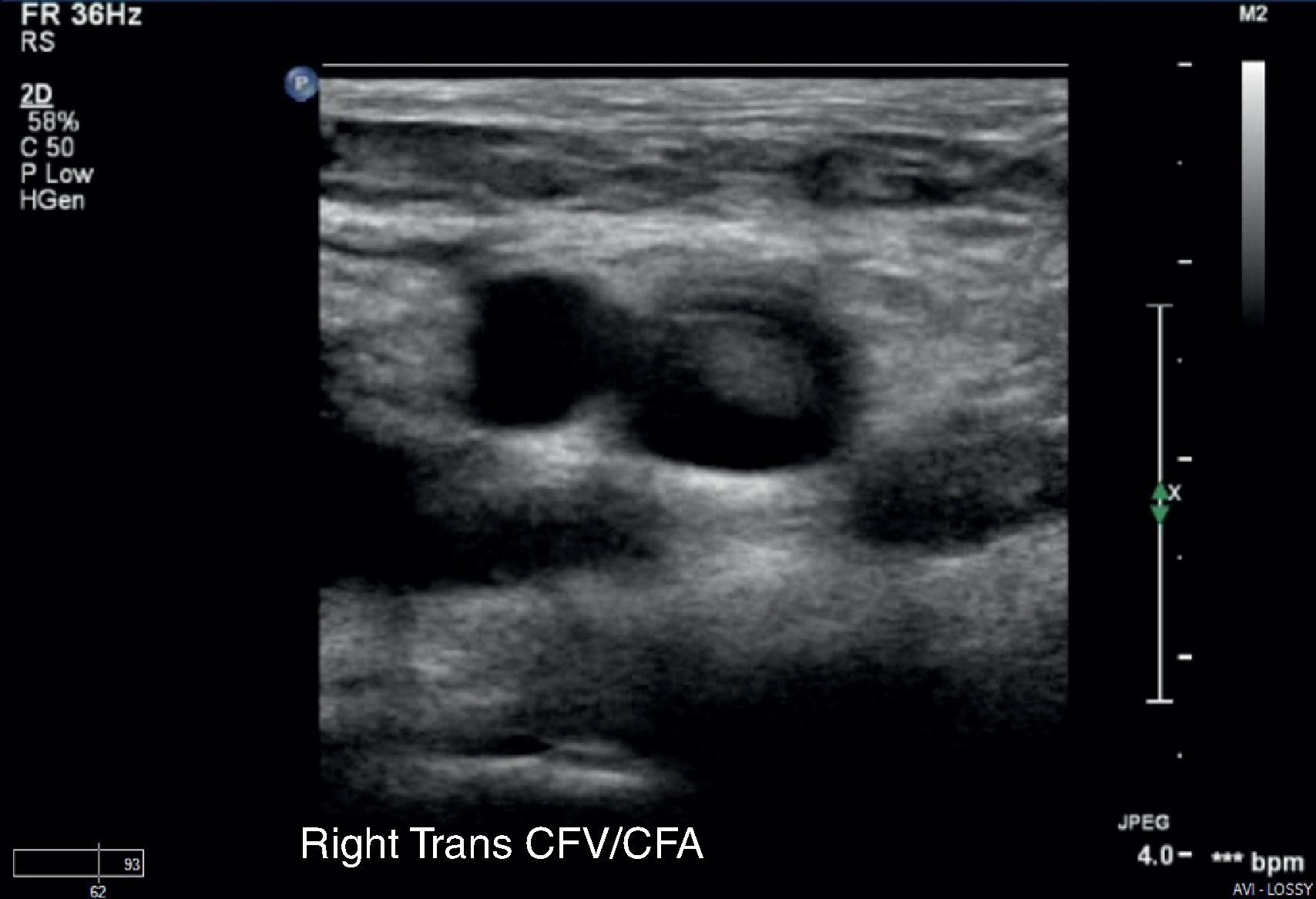
In 2001, the Agency for Healthcare Research and Quality recommended the use of ultrasound guidance for the placement of central venous lines, and these recommendations were subsequently endorsed by the American College of Surgeons. The benefits of using ultrasound for central line placement are ease of venous cannulation and fewer complications, especially arterial puncture and pneumothorax. This description is limited to internal jugular venous access as the visualization of the subclavian vein is more difficult as a result of bone artifact.
Before prepping the patient’s neck, anatomic landmarks (sternal notch, trachea, earlobe) should be marked and the internal jugular vein scanned to ensure ease of compressibility and absence of a clot. The patient’s head should be elevated about 30 degrees and slightly extended and rotated to the contralateral side. A high-frequency linear transducer is held in the nondominant hand, placed in the transverse position (i.e., perpendicular to the long axis of the neck), and oriented so the left side of the transducer correlates with the left side of the ultrasound screen. The ipsilateral carotid artery and patent internal jugular vein are identified. The insertion site is determined, and the depth to the internal jugular vein is measured. The needle (attached to a syringe) is inserted at a 45- to 60-degree angle near the center of the transducer. The needle is advanced while aspirating the syringe, and visual confirmation of the needle tip within the vein is confirmed along with venous blood return. The transducer is then rotated to the longitudinal position so the guidewire is visualized within the lumen of the vein. The remainder of the procedure follows the guidelines of the Seldinger technique. Although a chest x-ray is still recommended for the confirmation of central line position, ultrasound offers an alternative method. The 3.5- to 5-MHz curvilinear transducer is oriented for the sagittal view and placed in either the apical or subcostal pericardial areas to obtain the four cardiac chambers view. The distal port of the central venous line is flushed rapidly with 10 mL of warm saline. A rapid atrial swirl is visualized on the ultrasound real-time image as a turbulence entering the right atrium from the superior vena cava immediately after the flush and then migrating into the right ventricle. The rapid atrial swirl indicates that the central venous line is in the correct position. Turbulence initially identified in the right ventricle is consistent with a central venous line that should be withdrawn into the atriocaval junction, and lack of turbulence indicates intraarterial placement and should be removed.
For several years, ultrasound has been used by specialists to assess a patient’s intravascular volume status. An inferior vena cava that is easily compressible indicates that the patient is hypovolemic, whereas an inferior vena cava that is noncompressible or has a diameter greater than 2 cm indicates that the patient is euvolemic or hypervolemic ( Fig. 13 ).
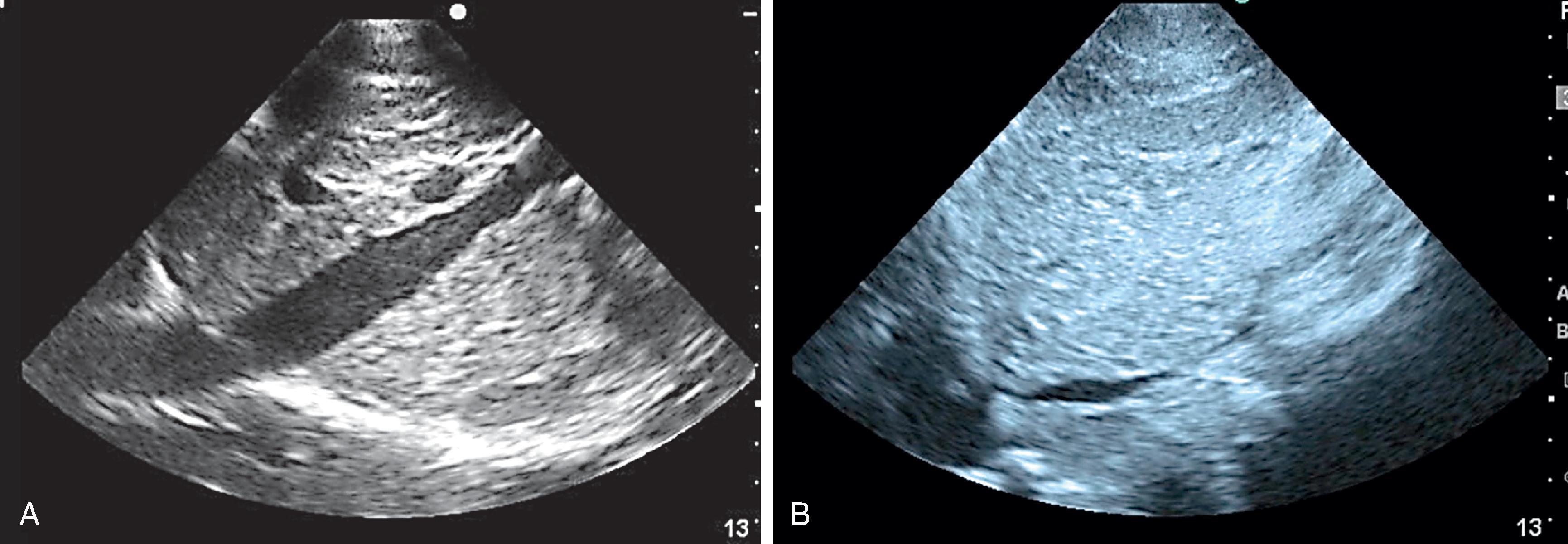
This focused examination is performed with the same transducer as that used for the FAST examination. With the patient in the supine position, the transducer is oriented for sagittal sections and placed in the subxiphoid area. The inferior vena cava is identified, and then the transducer is rotated to obtain a long axis view. The width of the inferior vena cava is measured, and then the vessel is compressed. The transducer is once again rotated to obtain a transverse view of the vessel, and the diameter is measured and the vessel compressed.
In 2011, Ferrada and colleagues reported that the Focused Rapid Echocardiographic Examination (FREE) could estimate an ejection fraction, diagnose moderate to severe cardiac dysfunction, and identify inferior vena cava compressibility and diameter during respiratory variation. In this study, findings on the FREE changed the management of 54% of the patients, and the authors concluded that the FREE was a useful adjunct in determining the treatment plan for critically ill patients. Other studies have confirmed the usefulness of bedside ultrasound as a useful tool in determining the correct therapy for hypotensive patients during the early phases of resuscitation.
The FREE is a transthoracic examination that was developed to assess the critically ill patient’s volume and cardiac status. This point-of-care ultrasound examination uses hemodynamic information to determine whether the patient needs volume, inotropes, or vasopressors.
The patient is placed in the supine position for the four critical views of the FREE examination: (1) parasternal long axis, (2) parasternal short axis, (3) apical four-chamber view, and (4) subxiphoid view to examine for the diameter and compressibility of the vena cava (described earlier). Figure 14 indicates the transducer positions and the resultant images.
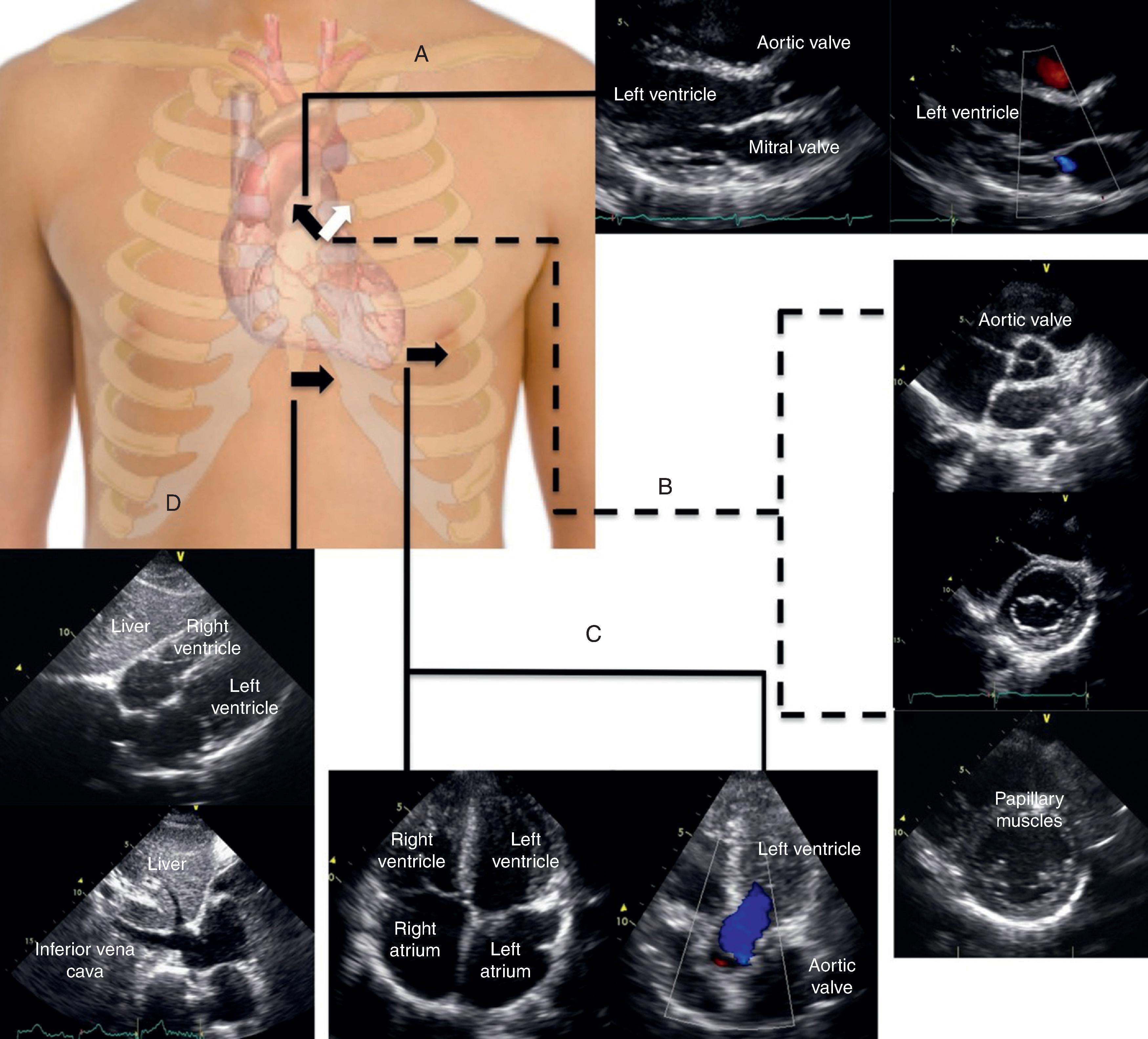
Evidence-based guidelines for the appropriate uses of ultrasound are provided by the Society of Critical Care Medicine ( Guidelines for the Appropriate Use of Bedside General and Cardiac Ultrasonography in the Evaluation of Critically Ill Patients—Part 1: General Ultrasonography; Part II: Cardiac Ultrasonography ). A summary of key recommendations is provided in Tables 1 and 2 .
| Topic | Overall Grade | Level of Training | Strength of Recommendation | Degree of Consensus | Level of Evidence | |||||
|---|---|---|---|---|---|---|---|---|---|---|
| Preload responsiveness, ventilated | 1B | Basic | Strong | Very good | B | |||||
| Left ventricular systolic function | 1C | Basic | Strong | Very good | C | |||||
| Left ventricular diastolic dysfunction | 2C | Advanced | Conditional | Good | C | |||||
| Acute cor pulmonale | 1C | Basic | Strong | Very good | C | |||||
| Pulmonary hypertension | 1B | Advanced | Strong | Very good | B | |||||
| Symptomatic pulmonary embolism | 1C | Basic | Strong | Very good | C | |||||
| Right ventricular infarct | 1C | Basic | Strong | Very good | C | |||||
| Sepsis resuscitation | 1C | Basic | Strong | Very good | C | |||||
| Asystole | 2C | Basic | Conditional | Good | C | |||||
| Pulseless electrical activity | 2C | Basic | Conditional | Good | C | |||||
| Ventricular tachycardia/fibrillation | 1B | Basic | Strong | Very good | B | |||||
| Cardiac tamponade | 1B | Basic | Strong | Very good | B | |||||
| Pericardial effusion | 1C | Basic | Strong | Very good | C | |||||
| Native valvular dysfunction | 1C | Basic | Strong | Very good | C | |||||
| Mechanical valvular dysfunction | 1C | Basic | Strong | Very good | C | |||||
| Blunt chest trauma for pericardium | 1B | Basic | Strong | Very good | B | |||||
| Penetrating chest trauma | 1C | Basic | Strong | Very good | C |
| Topic | Overall Grade of Recommendation | Strength of Recommendation | Level of Quality of Evidence | |||
|---|---|---|---|---|---|---|
| Diagnosis of pleural effusion (ruling-in) | 1-A | Strong | A | |||
| Diagnosis of pneumothorax | 1-A | Strong | A | |||
| Ascites (nontrauma setting) | 1-B | Strong | B | |||
| DVT diagnosis | 1-B | Strong | B | |||
Central venous access
|
1-A 1-B |
Strong Strong |
A B |
|||
Access location
|
1-A 2-C 1-A 2-B 2-B |
Strong Conditional Strong Conditional Conditional |
A C A B B |
* Numbers indicate the strength of recommendation: 1 = strong and 2 = weak/conditional. Letters indicate the level of quality of evidence: A = high, B = moderate, and C = low. DVT, Deep venous thrombosis.
As the role of the general surgeon continues to evolve, the surgeon’s use of ultrasound will surely influence practice patterns, particularly for the evaluation of patients in the acute setting. With the use of real-time imaging, the surgeon receives “instantaneous” information to augment the physical examination, narrow the differential diagnosis, or initiate an intervention. Algorithms for the suggested use of ultrasound in penetrating trauma and blunt abdominal trauma are provided in Figure 15 .
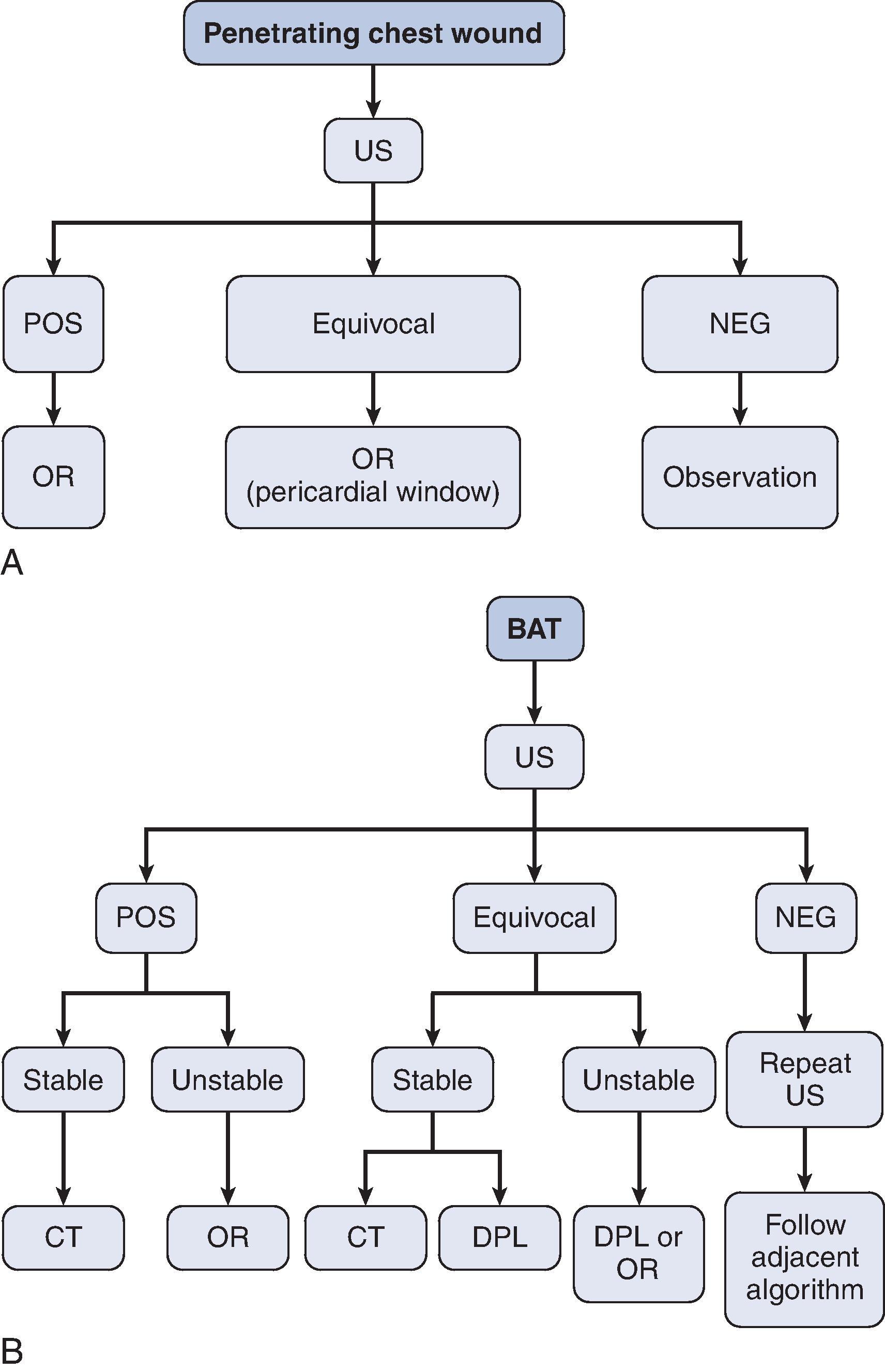
The advantages of ultrasound are easily seen in each of the following clinical scenarios. As a noninvasive, non-ionizing radiation modality, ultrasound can be used to evaluate the injured pregnant patient and simultaneously identify the fetal heart so the heart rate can be recorded. For the patient with multiple fractures who is in traction, the portable machine is wheeled to the patient’s bedside, and the FAST is performed without having to move the patient. If hypotension or an unexpected decrease in hematocrit occurs, an ultrasound examination can be easily repeated to exclude hemoperitoneum as the source of hypotension. When several patients with penetrating thoracoabdominal injuries present simultaneously to the emergency department, a rapid FAST examination with thoracic views can assess for pericardial effusion, massive hemothorax, or hemoperitoneum within seconds. This information helps the surgeon prioritize resources and triage patients. Finally, this painless noninvasive modality is well accepted, even by children, because it is performed at the bedside and is not intimidating.
Noncompressible thoracic trauma hemorrhage is the number one cause of death in organized trauma centers. The emergency department resuscitative thoracotomy (EDRT) originally described during the late 1800s remains one of the most debated procedures performed in the realm of trauma care. It is a heroic effort that has the potential to be lifesaving, if performed by an appropriately trained and skilled provider in the rapid fashion it is intended. Using minimal instrumentation, access to the thorax, pericardium, myocardium, and aorta can be achieved within minutes of patient arrival to the trauma bay.
The attraction to this procedure is the satisfaction of attempting drastic measures to save a life; however, identifying the appropriate patient is of utmost importance. Ideally, accessing the chest of those in extremis will hopefully relieve pericardial tamponade but may temporize exsanguination from either above or below the diaphragm and enhance cerebral and cardiac blood flow; even if successful, the patient may survive with unfavorable outcomes. This maximally invasive intervention, if performed by an untrained hand, is a futile effort at best and places involved personnel at risk for direct injury as well as exposure to copious amounts of body fluids. Iatrogenic injury to thoracic structures will lead to added insult including but not limited to potential further blood loss, lung parenchymal compromise, nerve transection, and direct cardiac injury. Attention to technique is therefore also vitally important.
Over the years, multiple recommendations and guidelines have been proffered and revised to specify when it is appropriate to attempt undertaking this procedure ( Tables 1 and 2 ). Although the supporting data are all retrospective in nature, the sheer number performed and reviewed by expert panels both nationally and internationally has allowed the creation of some guidance on suitable candidacy for effective intervention, defined not just as those likely to survive but those who have a chance at meaningful survival. It should be remembered that the thoracotomy is performed for two distinct reasons: (1) to access the chest for an injury that is surgically intervenable (i.e., release of tamponade and hemorrhage control) and (2) to optimize resuscitation (open cardiac massage, aortic cross-clamping, central drug administration, and internal defibrillation). Often both needs are present; however, outcomes are very different depending on the patient’s mechanism of injury, physiologic state, and presenting characteristics (age and comorbidities).
| Signs of Life on Arrival to Emergency Department | Injury Mechanism | Location of Injury | Recommendation for Emergency Department Thoracotomy | |||
|---|---|---|---|---|---|---|
| Yes | Penetrating | Thoracic | Strongly yes | |||
| No | Penetrating | Thoracic | Conditional yes | |||
| Yes | Penetrating | Extrathoracic | Conditional yes * | |||
| No | Penetrating | Extrathoracic | Conditional yes * , † | |||
| Yes | Blunt | Conditional yes * , † | ||||
| No | Blunt | Conditional no |
* Does not pertain to isolated cranial injuries.
† Poor data and largely based on speculation of patient preference.
| Blunt | Penetrating Torso | Penetrating Neck | Penetrating Extremity | Blunt/Penetrating | |
|---|---|---|---|---|---|
| Recommends EDT | <10 min prehospital CPR | <15 min prehospital CPR | <5 min prehospital CPR | <5 min prehospital CPR | Active CPR and signs of life or profound shock with systolic blood pressure <60 mm Hg |
Current guidelines rely on a few key factors to advise the practitioner on which patients would likely benefit from resuscitative thoracotomy. Type (penetrating versus blunt) and location of injury are two common starting points on various intervention models to risk stratify these patients. Time of last perfusing vital signs, electrical cardiac activity, pupillary response, and cardiac activity on bedside cardiac point of care ultrasonography can then further assist in guiding patient selection.
The patient in extremis with a single penetrating stab injury to the “cardiac box” (loosely defined as the anterior or posterior chest where a stab may penetrate the heart, confined within a rectangle with its superior border being the sternal notch, inferiorly the xyphoid process and laterally the nipples) with evidence of pericardial tamponade on bedside ultrasound and witnessed loss of vital signs in the emergency department (ED) is most likely to benefit from this intervention, with the highest proven survival rates approaching close to 35%. The chest is entered via a left anterolateral thoracotomy, the pericardium is opened and evacuated of pericardial clot, and direct repair of the cardiac injury is undertaken. In contrast, a patient who is in traumatic cardiac arrest status post blunt trauma with unwitnessed loss of vital signs in the prehospital setting have close to if not zero survival. Based on retrospective data, ED thoracotomy intervention for thoracic trauma secondary to stab injuries have improved outcomes when compared with gunshot wounds. Additionally, patients who have arrested from traumatic cardiac injuries have increased survivability as compared with those suffering noncardiac injuries.
There are “relative indications” allowing provider discretion in decision making. Penetrating abdominal, pelvic, and extremity as well as blunt thoracoabdominal trauma arrests with witnessed loss of vital signs in the field (with signs of life) or with arrest and loss of signs of life in the trauma bay are deemed appropriate candidates with survivability reaching up to 15%. ED thoracotomy performed for abdominal trauma is undertaken with the goals of cross-clamping the descending aorta, thereby prioritizing perfusion to the brain and coronary vasculature as well as proximally controlling intraabdominal arterial hemorrhage, ruling out intrathoracic pathology and allowing access to the heart for open massage and defibrillation.
Although absolute indications (and contraindications) are clear, there remains a wide swath of patients with relative indications. They are conditionally recommended for ED thoracotomy because of extremely low likelihood of survival, and for those who do survive, there is a high incidence of neurologic insult and disability. However, this is balanced against the chance for some to enjoy a meaningful survival.
It needs to be remembered that the resuscitative thoracotomy is just a beginning maneuver, and rapidly proceeding to definitive management of the “downstream” injuries is vital to the patient’s survival. Additionally, the open chest introduces another large wound to these severely injured patients. Another very important concept is that the ED thoracotomy, unlike other invasive procedures, is truly an operation. Injuries found need to be addressed, and in those who survive, thoracic wall reconstruction needs to be undertaken.
Adhering to the Advance Trauma Life Support (ATLS) algorithm approach to the trauma patient, a resuscitative thoracotomy would systematically fall into the circulatory bucket succeeding airway intubation, chest decompression, blood pressure assessment with infusion/transfusion protocols, and pulse check. In reality, a patient in arrest often requires efforts in parallel (that is, when resources permit, intubation occurring simultaneous to the performance of the thoracotomy). While an anterolateral thoracotomy may be rapidly performed, it requires familiarity with anatomy and physiology, as well as an understanding and preparedness to tackle repairs to injuries sustained.
When the decision is made to make the incision, the site is identified at the anterolateral chest wall, on the male from the left parasternal main body (as should you extend through the sternum you desire body to body wire placement) on an imaginary line along the nipple, and female on the inframammary fold in the direction of the rib in the 4th/5th intercostal space, with the intention to target the inferior border of the pectoralis major muscle group on the chest wall. The left arm is raised above the patient’s head while the patient is in the supine position, and the chest cage is rapidly painted with an antiseptic, usually betadine. If possible, placement of an orogastric tube may assist in differentiating the esophagus from the aorta. The anterior chest should be cleared of all equipment in preparation for clamshell extension should it be needed for further exposure.
Gaining access inferiorly along the pectoralis minimizes the amount of soft tissue incised, making it more efficient, allows for the best exposure of most areas of the thoracic cavity, and minimizes raw surface as a cause of intra- and postoperative bleeding should the thoracotomy be successful. When performing this procedure in a female with larger breasts, the mammary tissue should be retracted toward the ipsilateral shoulder and maintained in place to optimize exposure either by a colleague’s hand or by taping. The incision follows the natural curvature of the rib down toward the stretcher ( Fig. 1 ). This is carried out in a rapid fashion incising through the skin and subcutaneous tissue exposing serratus anterior musculature, which is transected as laterally as the latissimus dorsi allows when it is retracted laterally. This can be done to expose the underlying intercostal musculature to take in a separate incision; if you have managed to get into the chest safely medially, then it can be taken simultaneously with a heavy Mayo scissors. Special attention should be placed on maintaining the incision on the superior aspect of the inferior rib to avoid damage to the intercostal neurovascular bundle. With anatomic awareness, the internal mammary artery may be avoided when approaching the lateral sternum and, if transected, can be ligated when the patient gets a perfusing blood pressure and presents itself. Posterolaterally, the chest wall is opened well beyond the medial border of the latissimus dorsi; there is no need to divide the latissimus dorsi muscle, which again, if done, results in problematic bleeding if the thoracotomy is a success. Occasionally patients will have pleural adhesions, so attention should be paid to the lung parenchyma when entering the chest as to not cause avoidable parenchymal damage and can be bluntly dissected away from the thoracic wall and mobilized as needed for hilar, aortic, cardiac, or subclavian control.
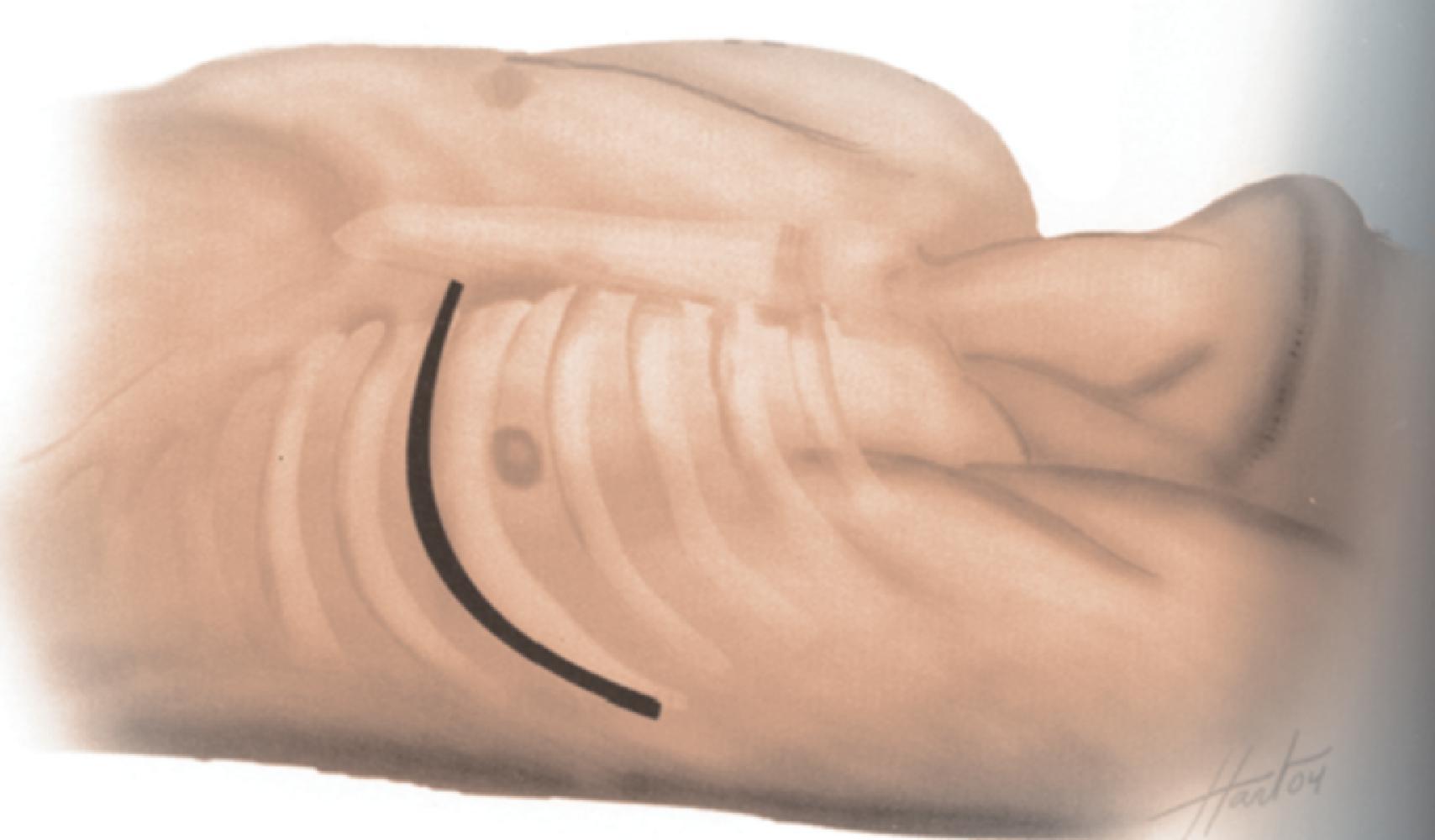
A Finochietto retractor (rib spreader) is placed, and the ribs are spread. There is debate over the optimal orientation of the retractor. If a clamshell extension is possibly required, then the handle is placed closer to the stretcher (i.e., away from the sternum as to allow extension to the contralateral side). In the event of thoracotomy extension, the incision is taken across the sternal body down to the bone and extended in the same fashion down the right hemithorax. A heavy-set shears or a Lebsche knife can be utilized to transverse the distal sternum. Unfortunately, anatomically when extending the initial thoracotomy across the sternum, both internal mammary arteries will be transected and will require ligation once blood flow has been restored.
Upon entering the chest, immediate inspection allows for assessment of pathology. The pericardium should be opened routinely to rule out cardiac injury, cardiac tamponade, and facilitate open cardiac massage. An incision on the pericardium should be made anterior to the phrenic nerve (usually well seen with its accompanying fat stripe) and extended parallel to the phrenic nerve as superiorly as possible and inferiorly to the cardiac apex ( Fig. 2 ). The pericardium is tough and fibrous and is often difficult to grasp with forceps, especially if bulging with blood. A nick with a scalpel blade is often required. Inspection alone can give a great deal of information, which helps drive therapeutic intervention. Is there cardiac injury or pericardial blood? Is the heart empty and still moving (in which case, more effective intravascular repletion may be required)? Does the heart have effective electromechanical activity (does it need cardioversion)? The heart is then delivered from the pericardial sac ( Fig. 3 ).
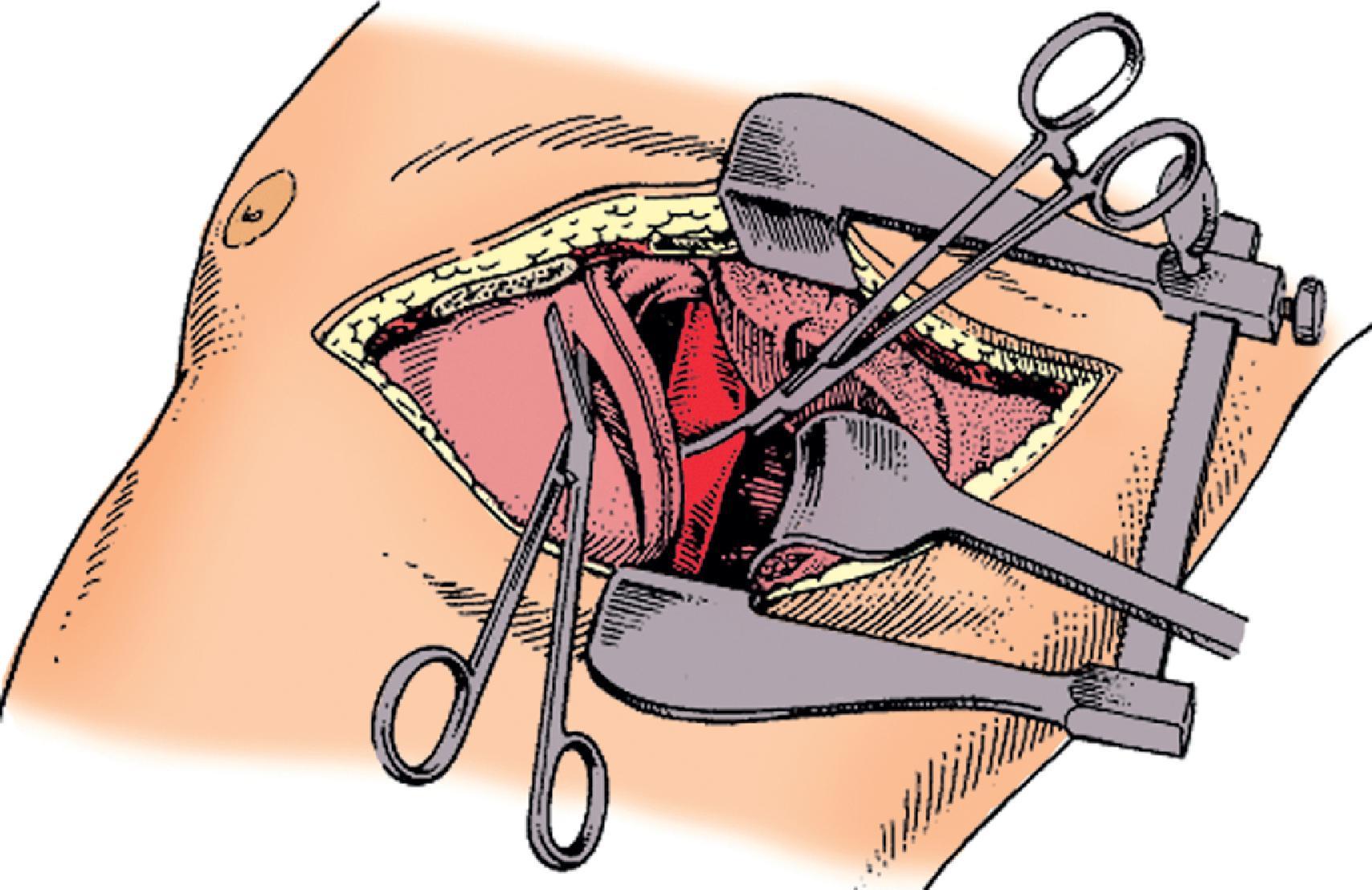
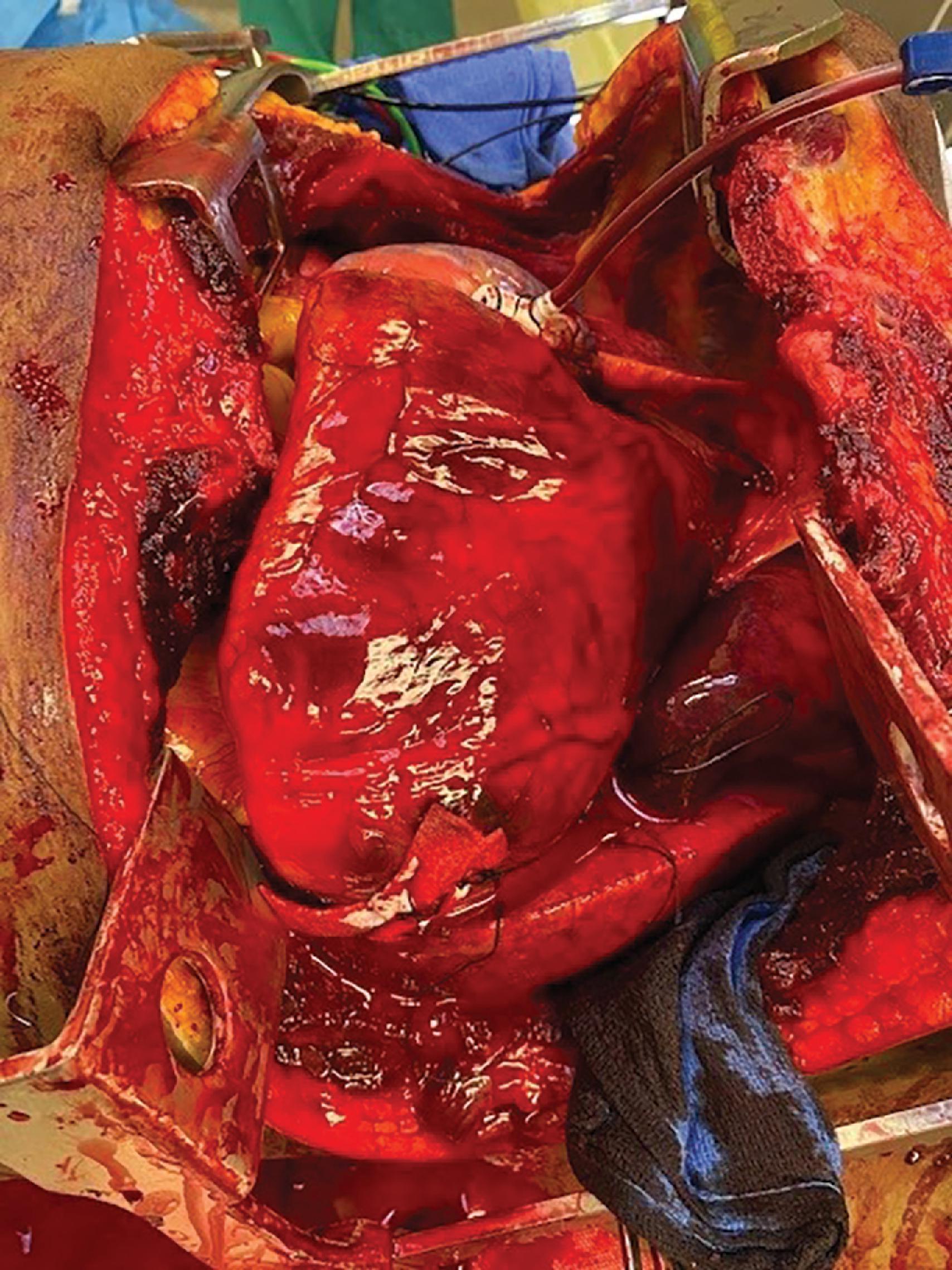
In the event of tamponade, cardiac delivery should precede clot evacuation and methodical examination of the myocardium. If cardiac injury with active extravasation is identified, prompt control with light digital pressure should be swiftly undertaken. Several options have been well described for temporary control of full thickness cardiac injuries and include Foley catheter placement (through the injury into the chamber) with balloon inflation and minimal traction, large staples, vascular clamps (may be effective on atrial injuries), or suture control until definitive cardiorrhaphy can be achieved in the operating room. One needs to remember that gunshot wounds to the heart most frequently have both entrance and exit wounds, so thorough inspection of the heart is imperative to management.
Access to the posterior thorax often requires division of the inferior pulmonary ligament. This is well identified by grasping the inferior lobe from below with one’s left hand and slipping a finger posteromedially. It will fall into the groove between the lung and the medial thoracic border. Gentle lateral retraction demonstrates the thin ligamentous tissue for sharp division. Care must be taken to stop short of the hilar vessels. This releases the left lower lobe for easy superior traction and provides access to the inferior descending thoracic aorta. Intentional collapse of the left lung further aids visualization. With the assistance of the airway management team, the endotracheal tube can be advanced into the right main stem bronchus to collapse the left lung allowing optimum exposure of the left hemi thorax.
In the event of entering the chest and encountering a significant hemothorax without evidence of cardiac or descending aortic injury, blood should be evacuated, and immediate exploration should begin for identification of the source. When identified, temporizing measures with direct pressure should be attempted if control cannot be achieved in the ED until the patient gets to the operating theatre; most of the aortic branches and mediastinal vascular injuries are nearly impossible to achieve adequate exposure for repair in the ED. Pulmonary parenchymal injury as the source of hemorrhage is another potential source of major blood loss, and these injuries when encountered should be controlled with direct finger occlusion or noncrushing vascular clamp placement until the patient is transported to the OR for formal resection and/or repair. For uncontrollable vascular or larger parenchymal disruption, pulmonary hilar clamping or complete twisting of the lung about the pulmonary hilum once the inferior pulmonary ligament has been divided can be undertaken. This maneuver is effective in the way of completely occluding vascular inflow for hemorrhage control yet will also cease aeration in the lung. This “hilar twist” has a high morbidity and mortality rate with the physiologic stress it places on the already shocked myocardium by increasing pulmonary vascular resistance and immediate right heart stress with potential resultant right heart failure.
Control of the aorta during an emergency thoracotomy is achieved by pressure at the distal descending thoracic aorta. The aorta runs anterior to the vertebral bodies and directly next to and to the left of the esophagus in this location. It is separated from the left hemithorax proper by the mediastinal pleural tissue, and posteriorly the prevertebral fascia is quite firm. The aorta is easily palpable when there is a pulse but may be difficult to feel as distinct from the esophagus in the arresting patient. As mentioned earlier in the chapter, a nasogastric verse orogastric tube helps to localize the esophagus when attempting to isolate the aorta away from it. However, when attempting to save a life with a noncrushing atraumatic aortic cross-clamp, the focus should be getting aortic control and not a meticulous dissection of the esophagus.
As with most necessary exposures for the left hemithorax, the inferior pulmonary ligament will need to be released, and lung collapse should be facilitated with main-stem endotracheal tube placement. Initial aortic control may be achieved with manual pressure of the aorta against the vertebral bodies. This has the disadvantage of blocking effective manual cardiac massage should that be required simultaneously ( Fig. 4 ).
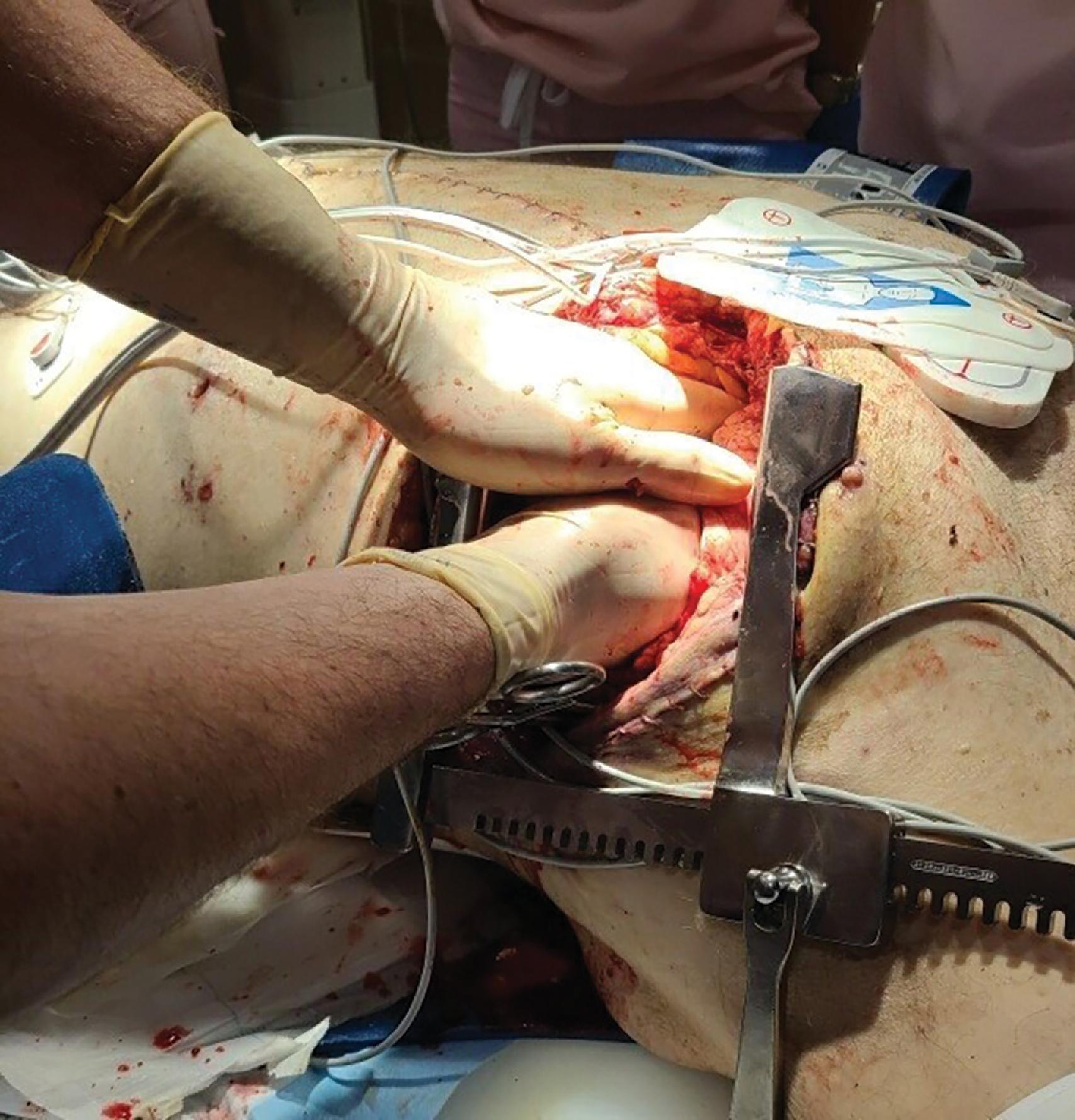
To expose the aorta for placement of a cross-clamp, the overlying mediastinal pleural needs to be opened over the aorta. This is often difficult to initiate. We use a clamp with the tips pushed against vertebral column just posterior to the aorta in the groove created between the two, scratch through the pleural membrane, and spread parallel to both structures facilitating the dissection. Finger fracturing will allow exposure of the aorta and esophagus off their respective pleural covering anteriorly, the prevertebral fascial tissue posteriorly, and will also allow separation of the two structures from one another. Once this has been achieved, the aorta should be accessible and mobile enough to allow elevation for aortic clamp placement and successful cross-clamping. When placed for presumed distal hemorrhage control, once cardiac activity is ensured, the patient must proceed expeditiously to the operating room for other definitive management.
Although this maneuver allows for preferential blood shunting to the brain and myocardium, all distal structures will in turn be exposed to prolonged ischemia with simultaneous massive physiologic changes proximally. As with all arterial clamping, an effort needs to be made to minimize clamp time. Restoration of global perfusion can be challenging given the post-clamp physiologic stress of reperfusion and reperfusion injury. Acidosis, hyperkalemia, and shock all should be anticipated, but with prolonged continual aortic clamp times (>40 minutes), this is frequently fatal.
Effective internal cardiac massage should be undertaken as soon as cardiac arrest is identified and appropriate ED surgical intervention has completed. Bimanual approach is the preferred approach to effective cardiac massage in a “hinge clapping” motion. Using the entirety of the palms of the hands and fingers, commence the compression at the apex of the heart and complete the compression at the base. This maneuver can be further described by firmly adducting the fingers and cupping the anterior hand with the posterior base hand in a rigid flat supinated position, providing a flat surface for the heart to be compressed against. Appose both palmar aspects of the hands to firmly compress the myocardium ( Fig. 5 ). This provides effective circulation and avoids direct cardiac injury.
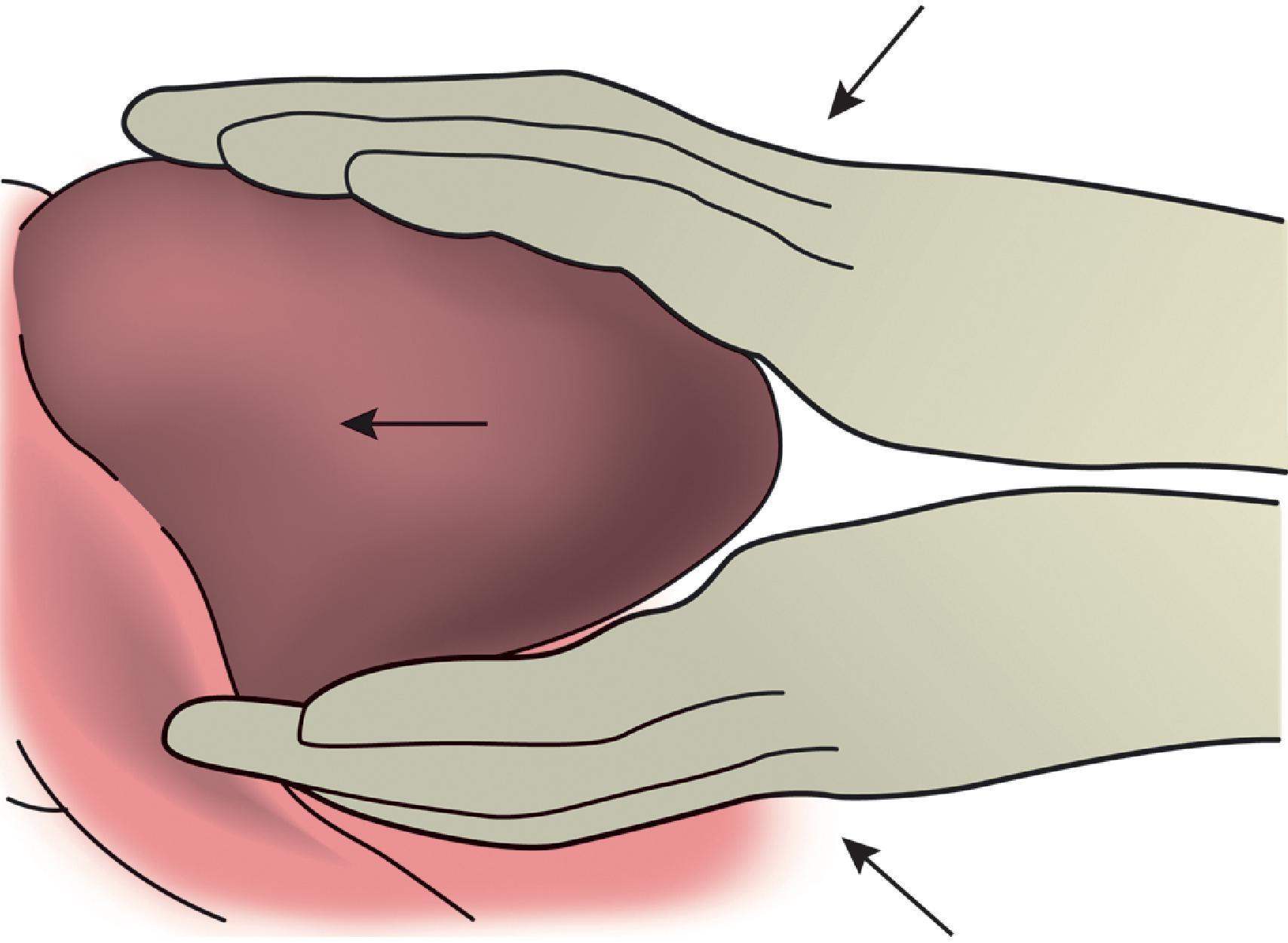
There continues to be a growing enthusiasm for the use of endovascular aortic occlusion in the management of a selected group of severely injured patients. Tried first in the early 1950s with the idea of an intraluminal rapid occlusion of the descending thoracic aorta/abdominal aorta without the morbidity of thoracotomy, there has been a resurgence of its use in the past several years primarily because of practical and specifically designed catheters ( Fig. 6 ). Brand dependent, the technique is commenced percutaneously or via vascular cut down of the common femoral artery; an arterial micropuncture needle with wire guide and Seldinger technique allows for introducer catheter insertion followed by expeditious sheath upsize and with or without guidewire assistance balloon insertion into the desired anatomic zone.
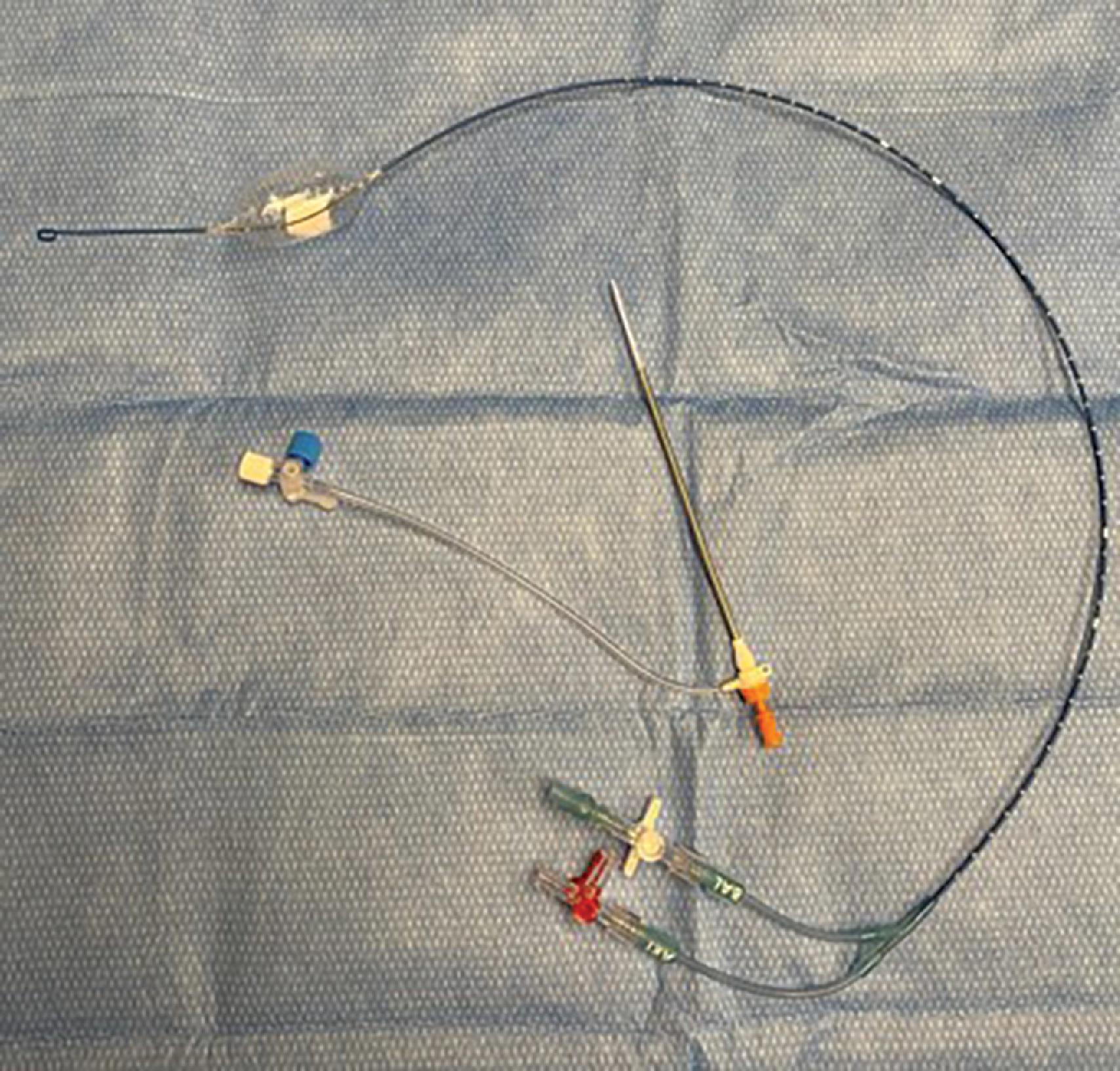
Positioning of the balloon occlusion is determined by likely anatomic location of hemorrhage in either the thoracic aorta above the renal arteries (zone 1) for intraabdominal hemorrhage control or just above the aortic bifurcation (zone 3) for control of pelvic hemorrhage. Once again, depending on the brand, positioning can later be confirmed with fluoroscopic, x-ray, or CT imaging if the balloon is filled with dye mixed with saline in place of air. It is vital to understand that the EDRT and the REBOA are not interchangeable procedures. It is obvious that REBOA would have no use in a patient who arrives with penetrating thoracic trauma, neck trauma, and blunt thoracic trauma-related hemopericardium and/or hemothorax with arrest and is in fact contraindicated. However, for patients who require subdiaphragmatic hemorrhage control with aortic occlusion, the REBOA is a very attractive alternative to the maximally invasive traditional full thoracotomy.
Multiple algorithms are being used to ascertain the optimum scenario for ED-REBOA placement. The one most fitting with the best success data is in those patients arriving in extremis (i.e., unstable vital signs) with minimal or no response to volume resuscitation, no evidence of aortic trauma on simple chest films, and a likely cause of exsanguination, for example, severe pelvic fractures. As for the ideal positioning of the device, the Focused Assessment with Sonography for Trauma (FAST) exam is undertaken with a positive result requiring positioning of the balloon occlusion in zone 1 (above the celiac artery) and a negative result requiring a pelvic plain film. Should the pelvis show any signs of instability the balloon is deployed in zone 3 (below renal arteries and above the aortic bifurcation) and if the film proves to be unremarkable, the balloon is deployed in zone 1.
There is a growing body of evidence supporting the effectiveness of the ED-REBOA and in which patient population its purpose is served best. As with any intervention, it too is associated with adverse outcomes, high mortality rates, and the potential for significant morbidity. It certainly has a place and role in acute care, being an effective tool to buy the trauma surgeon time for definitive operative intervention in a controlled setting.
Traumatic brain injury (TBI) is a leading cause of disability, healthcare resource expenditure, and death after injury. In the past year, there were over 2 million TBI-related emergency department visits, with 60,000 deaths attributable to the pathology in the United States alone. The major causes of TBI include falls, motor vehicle crashes, firearm-related suicide, and assaults. Groups more likely to be affected by TBI include military veterans, minorities, the homeless population, and those in correctional and detention facilities. The initial insult to the brain from the injury has a component that is irreversible because of neuronal cell death and a component that is potentially reversible with high-quality supportive care and interventions. Goal-directed therapies for TBI management aim to prevent progression of the initial injury by optimizing medical management and identifying select patients who will benefit from prompt surgical intervention.
The initial evaluation of all trauma patients starts with establishing an airway, confirming breathing, and optimizing circulation. For those with brain injuries, the disability step of the evaluation is essential. A focused neurologic exam centers on the patient’s ability to follow basic commands, the pupillary response to light, and identifying lateralizing signs. A simple reproducible assessment that is widely used to evaluate a patient’s global neurologic state is the Glasgow Coma Scale (GCS) shown in Table 1 . A composite score can be generated by grading a patient’s motor, verbal, and ocular response to stimuli, with scores ranging from 3 (no neurologic function/response) to 15 (normal mental status). TBI is commonly graded in severity as mild (GCS ≥13), moderate (GCS 9–12), or severe (GCS ≤8). The Western Trauma Association has provided an algorithm on how to evaluate and manage a patient with suspected TBI ( Fig. 1 ). For patients who can safely tolerate imaging, a noncontrast head computed tomography (CT) scan should be completed as soon as possible. Imaging should be reviewed to identify the presence of intracranial blood, brain parenchymal injury, midline shift, mass effect, herniation, and skull fractures to help characterize the injury and guide further interventions.
| Subcategory | 1974 Classification | 2014 Classification | Points | |||
|---|---|---|---|---|---|---|
| Eye opening | Spontaneous To speech (command) To pain None |
Spontaneous To sound To pressure None |
4 3 2 1 |
|||
| Verbal response | Orientation Confused conversation Inappropriate speech Incomprehensible speech None |
Orientated Confused Words Sounds None |
5 4 3 2 1 |
|||
| Motor response | Follows commands Localizes painful stimuli Withdraws from pain (nonlocalizing) Abnormal flexion (decorticate) Abnormal extension (decerebrate) Gives no motor response |
Obey commands Localizing Normal flexion Abnormal flexion Extension None |
6 5 4 3 2 1 |
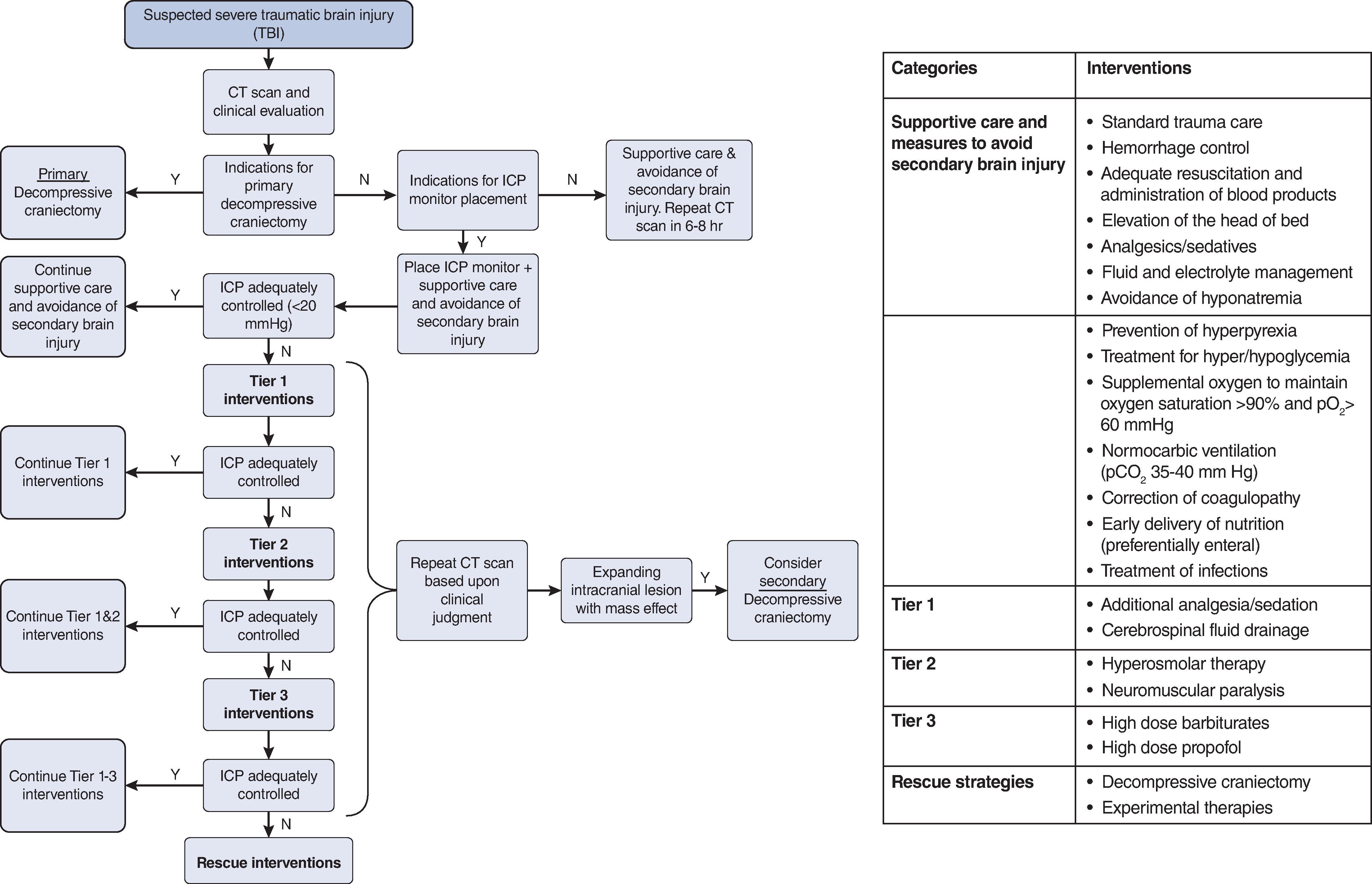
TBI encompasses a variety of lesions with different underlying mechanisms. Epidural hematomas (EDHs) are associated with temporal bone fractures and bleeding from the middle meningeal artery. There is often a lucid interval after the initial injury followed by clinical deterioration. A “lenticular-shaped” lesion that does not cross suture lines is a pathognomonic finding for EDH ( Fig. 2A ). A subdural hematoma (SDH) results from a tear in a bridging vein that causes bleeding in the layer between the dura and the brain, resulting in a “crescent-shaped” mass on CT ( Fig. 2B ). Subarachnoid hemorrhage (SAH) can also arise after trauma and appear as diffuse bleeding along the subarachnoid membrane. Intraparenchymal hemorrhage (IPH) results from contusions in the brain tissue most often found in the frontal and temporal regions ( Fig. 2C ). Intraventricular hemorrhage (IVH) is blood within the ventricles of the brain and is often associated with other brain injuries. Diffuse axonal injury (DAI) results from an acute acceleration or deceleration force that causes shearing of axons and is better characterized on MRI with an assessment of the gray-white matter junction.
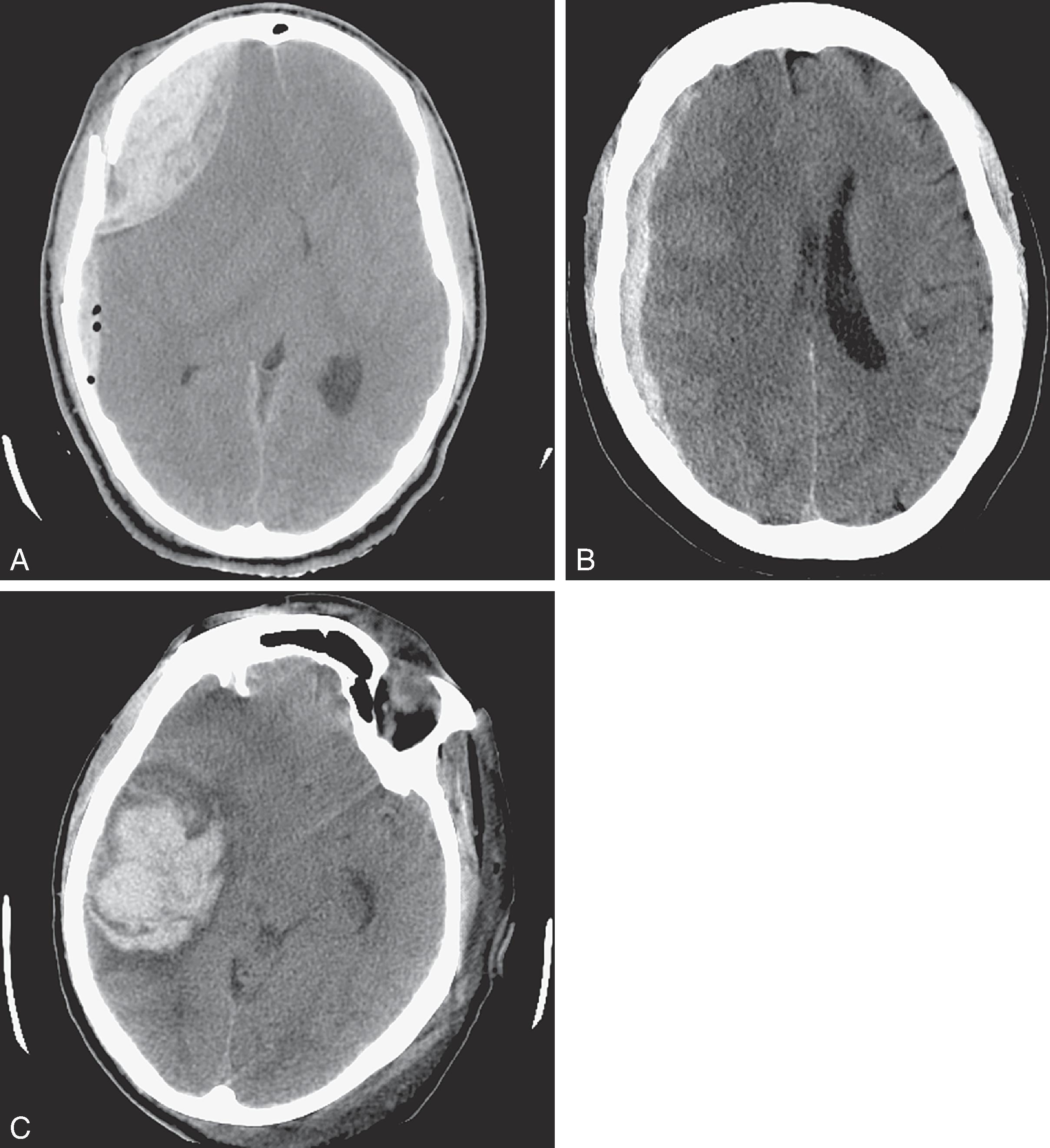
Once TBI is identified, immediate measures should be taken in the trauma bay to minimize progression of the injury or the development of secondary injuries. Maintaining oxygen delivery to the brain to minimize ischemia and additional neuronal cell injury or death is critical. Derangements in blood pressure, oxygenation, and ventilation are all independently associated with increased morbidity and mortality. Older adult patients are even more susceptible to derangements in these parameters and require higher systolic blood pressure (SBP) goals for improved outcomes. The Brain Trauma Foundation (BTF) TBI guidelines recommend an SBP ≥ 100 mm Hg for those 50 to 69 years of age and above 110 mm Hg for patients 70 years of age and older. Resuscitation with normal saline, hypertonic fluids, and blood along with early hemorrhage control is critical in preventing hypotension. Vasopressor therapy may be required to achieve and maintain these blood pressure goals and should be used liberally in conjunction with resuscitation to prevent any episodes of severe hypotension.
Hypoxemia (defined as SpO 2 less than 90%) for as little as 5 minutes can result in irreversible worsening of brain injury. All TBI patients should have continuous pulse oximetry and be provided supplemental oxygen to maintain adequate oxygen saturation. Many patients with severe TBI require intubation for airway protection, and a general rule is that intubation is mandatory if the GCS is less than 9. Target oxygen saturation should be 94% or higher with a partial pressure of oxygen in arterial blood level > 70 mm Hg. Ventilation is also critical to ensure eucapnia as both hypercapnia and hypocapnia can worsen TBI and neurologic outcomes. Hypercapnia causes vasodilation resulting in increased blood volume and intracranial pressure (ICP) elevation that can cause additional neuronal injury. Although hyperventilation to induce hypocapnia will effectively decrease ICP in most patients, this effect is secondary to cerebral vasoconstriction and decreased cerebral blood flow (CBF), which can further exacerbate ischemic injury. Continuous end-tidal carbon dioxide (EtCO) monitoring can guide respiratory management with a recommended goal of mild hyperventilation to maintain a pCO 2 of 35 to 40 mm Hg. More significant degrees of hyperventilation have been found to be associated with poorer neurologic outcomes and should be avoided other than as a brief temporizing measure for patients with severe intracranial hypertension and impending herniation.
Use of anticoagulant and antiplatelet medications has increased over the past decade and should be addressed in the setting of intracranial injury. In 2016, the Neurocritical Care Society and the Society of Critical Care Medicine put forth recommendations on how to manage common agents in the setting of TBI with intracranial hemorrhage (ICH; Table 2 ). Since that time, the dosing to reverse direct factor Xa inhibitors with four-factor PCC has been updated to 25–50 U/kg IV. Laboratory testing should be completed on all trauma patients and should include measurement of prothrombin time, activated partial thromboplastin time, platelet count, and fibrinogen level. Viscoelastic coagulation testing may also be performed using thromboelastography or rotational thromboelastometry and can identify additional dysfunction within the coagulation pathway to help guide therapy.
| Antithrombotic | Reversal Agent |
|---|---|
| Vitamin K antagonists | If INR ≥1.4:Vitamin K 10 mg IV, plus three- or four-factor PCC IV (dosing based on weight, INR, and PCC type) or fresh-frozen plasma 10–15 mL/kg IV if PCC not available |
| Direct factor Xa inhibitors | Activated charcoal (50 g) within 2 hours of ingestion, activated PCC (FEIBA) 50 U/kg IV or four-factor PCC 50 U/kg IV |
| DTIs | For dabigatran reversal:Activated charcoal (50 g) within 2 hours of ingestion, and idarucizumab 5 g IV (in two 2.5-g/50-mL vials)Consider hemodialysis or idarucizumab redosing for refractory bleeding after initial administrationFor other DTIs:Activated PCC (FEIBA) 50 U/kg IV orfour-factor PCC 50 U/kg IV |
| Unfractionated heparin | Protamine 1 mg IV for every 100 units of heparin administered in the previous 2–3 hours (up to 50 mg in a single dose) |
| LMWH | EnoxaparinDosed within 8 hours: protamine 1 mg IV per 1 mg enoxaparin (up to 50 mg in a single dose)Dosed within 8–12 hours: protamine 0.5 mg IV per 1 mg enoxaparin (up to 50 mg in a single dose)Minimal utility in reversal > 12 hours from dosingDalteparin, nadroparin, and tinzaparin:Doses within 3–5 half-lives of LMWH: protamine 1 mg IV per 100 anti-Xa units of LMHW (up to 50 mg in a single dose) orrFVIIa 90 µg/kg IV if protamine is contraindicated |
| Danaparoid | rFVIIa 90 µg/kg IV |
| Pentasaccharides | Activated PCC (FEIBA) 20 U/kg IV or rFVIIA 90 µg/kg IV |
| Thrombolytic agents (plasminogen activators) | Cryoprecipitate 10 units IV or antifibrinolytic (tranexamic acid 10–15 mg/kg IV over 20 min or ɛ-aminocaproic acid 4–5 g IV) if cryoprecipitate is contraindicated |
| Antiplatelet agents | Desmopressin 0.4 µg/kg IV × 1If neurosurgical intervention: platelet transfusion (one apheresis unit) |
Patients with severe TBI may present with clinical signs of intracranial hypertension with concern for impending herniation. The Cushing reflex or triad is a physiologic response to a sudden increase in ICP that manifests as a triad of increased blood pressure, bradycardia, and irregular respirations. Brainstem compression can present as posturing and Cheyne-Stokes ventilation (a cyclic breathing pattern marked by rapid deep breaths followed by a period of apnea). Unilateral pupil dilation and loss of light reactivity is concerning for uncal herniation on the ipsilateral side. In these cases, immediate measures must be taken to reduce ICP. In patients who do not require spinal protection precautions, the head of the bed should be elevated. If spine precautions remain, the patient can be placed into the steep reverse Trendelenburg position. Short periods of hyperventilation can be utilized to induce transient hypocarbia and cause cerebral vasoconstriction to reduce ICP. This should only be used as a temporizing measure, as prolonged hypocarbia and cerebral vasoconstriction can detrimentally reduce cerebral oxygen delivery. Hypertonic saline solutions or mannitol, an osmotic diuretic, can be used to shift fluid out of brain cells into the intravascular space and reduce cerebral edema. These measures will be discussed in further detail later in this chapter.
TBI patients are classified using a combination of clinical and radiographic findings. Table 3 details the recently developed and validated Brain Injury Guidelines (BIG) which can assist trauma surgeons in determining the necessary level of care a patient may require based on his or her clinical history, neurologic exam, and CT imaging findings. Those with mild injury are categorized as BIG 1. A patient with a BIG 1 TBI and a normal neurologic exam after 6 hours can often be discharged home without repeat imaging. Those with the most severe injury are categorized as BIG 3, and guidelines recommend ICU admission, frequent serial neurologic examinations, and immediate neurosurgical evaluation.
| Variables | BIG 1 | BIG 2 | BIG 3 |
|---|---|---|---|
| LOC | Yes/No | Yes/No | Yes/No |
| Neurologic exam | Normal | Normal | Abnormal |
| Intoxication | No | No/Yes | No/Yes |
| CAMP | No | No | Yes |
| Skull fracture | No | Non-displaced | Displaced |
| SDH | ≤4 mm | 5–7 mm | ≥8 mm |
| EDH | ≤4 mm | 5–7 mm | ≥8 mm |
| IPH | ≤4 mm, 1 location | 3–7 mm, 2 locations | ≥8 mm, multiple locations |
| SAH | Trace | Localized | Scattered |
| IVH | No | No | Yes |
| Therapeutic plan | |||
| Hospitalization | No observation (6 hr) | Yes | Yes |
| RHCT | No | No | Yes |
| NSC | No | No | Yes |
Monitoring is essential to providing timely care in TBI patients. ICP monitoring is indicated in severe TBI patients with ICH on CT scan. Additional criteria to consider placement of an ICP monitor include patients older than 40 years of age with hypotension and posturing on neurologic exam, although this is an area of significant debate. Commonly used invasive methods of ICP measurement include placement of an external ventricular drain (EVD) or “ventriculostomy” and intraparenchymal pressure monitors, often called bolts . EVDs are zeroed at the midbrain, and in addition to measuring ICP, they can also be used to drain cerebrospinal fluid (CSF) and thus lower ICP. Continuous CSF drainage can more effectively lower ICP than intermittent drainage, and the greatest benefits can be seen in patients with a GCS <6 who receive CSF drainage within 12 hours of their injury. Alternative noninvasive measures of ICP include transcranial Doppler and optic nerve sheath diameter monitors; however, these measurements are less precise and reliable. Arterial lines should be placed to obtain mean arterial pressure (MAP), which allows for calculation of cerebral perfusion pressure (CPP). Central lines can be placed for ongoing resuscitation, for delivery of vasopressor agents, and to provide hypertonic saline therapy.
Intracranial hypertension has traditionally been defined as an ICP ≥20 mm Hg. The recent update of the BTF guidelines supports interventions when ICP measures ≥22 mm Hg. CPP is calculated by subtracting the ICP from the MAP and should be maintained between 60 and 70 mm Hg to optimize CBF and oxygen delivery. In almost all cases, management of significantly elevated ICP in the ICU requires a multimodal strategy. Figure 3 shows an algorithmic approach for the management of elevated ICP using a series of tiered interventions. The key components of these include adequate sedation, analgesia, mild hyperventilation, and osmotic therapies.
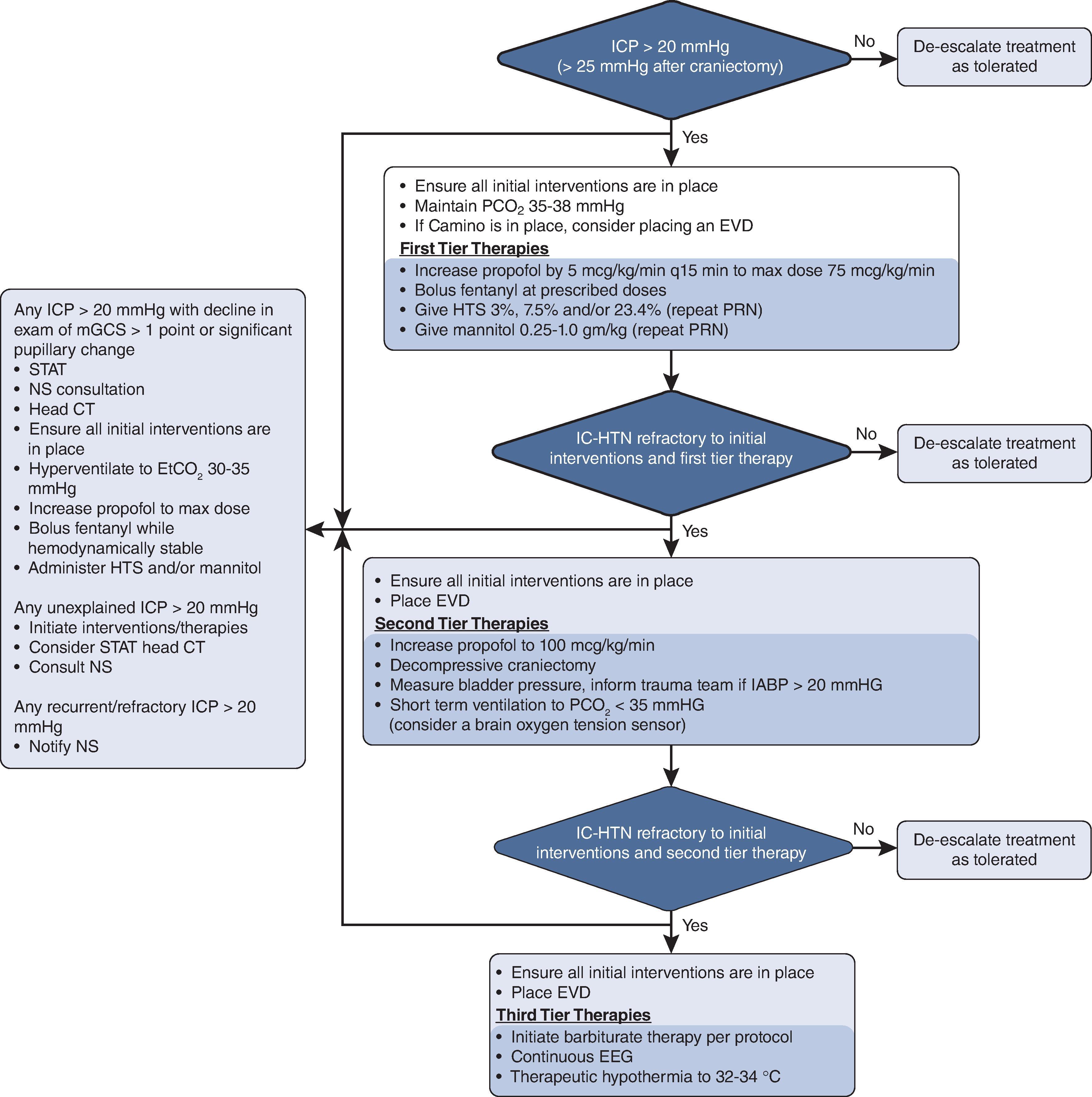
Pain and agitation often result in elevations of ICP. Commonly used short-acting sedatives include benzodiazepines and propofol, both GABA agonists. These medications can be bolused and infused in higher doses as a first-line therapy for elevated ICP. When pain is likely the inciting factor, patients can also be given a dose of analgesic. Infusions of both sedatives and analgesics are preferred to boluses as these medications tend to cause hypotension, which could worsen brain injury by lowering the CPP. Chemical paralysis is a highly effective additional adjunct that can be utilized for elevated ICP despite adequate sedation and analgesia. Continuous infusion of paralytic agents is preferred over intermittent bolusing, with close monitoring to ensure both adequate paralysis and sedation. For situations in which maximal therapies have been given and ICP remains elevated, barbiturate coma accomplished with an infusion of phenobarbital can be considered. Sedation holds or holidays should occur frequently to assess the neurologic exam provided that the ICP is well controlled. For patients requiring active interventions for elevated ICP, adequate sedation and analgesia should be maintained without interruption.
Hyperosmolar therapy using either hypertonic saline or mannitol is utilized to shift free fluid into the intravascular space and improve blood viscosity, and it remains the cornerstone of pharmacologic treatment for intracranial hypertension. Commonly used concentrations of hypertonic saline solutions are 3%, 7.5%, and 23.4%. These can be given as a bolus or continuous infusions. Mannitol is a simple sugar that is dosed at 0.25 g/kg to 2 g/kg. It works as an osmotic diuretic by increasing the tonicity of plasma and drawing fluid from cells. This is used to decrease brain cell volume and reduce ICP. However, mannitol should be used with caution in polytrauma patients with tenuous hemodynamics, as the excess fluid excreted by the kidneys can result in hypovolemia and exacerbate or cause hypotension. In head-to-head comparisons, hypertonic saline has been shown to more rapidly lower ICP and to have a more sustained response, but there is no high-quality evidence supporting the use of one versus the other for ICP management.
Prophylaxis is provided to TBI patients to prevent common complications including seizures, venous thromboembolism (VTE), and fever. Postinjury seizures are most common in the first 7 days of injury. The damaged brain tissue and hematoma can be foci for epileptiform activity. Seizures cause a sharp major increase in neuronal activity that leads to locally decreased oxygen and glucose levels that can further worsen cerebral metabolic injury. Factors that increase the risk of seizures in TBI patients include initial GCS ≤10, loss of consciousness >30 minutes, immediate seizures, depressed skull fractures, penetrating injury, age 65 years or younger, and chronic alcoholism. Antiepileptics including phenytoin and levetiracetam are now commonly given for 7 days after a TBI with ICH. The use of seizure prophylaxis has been associated with a decrease in the incidence of early post-TBI seizures, but it has no effect on late seizures. Thus, the duration of administration is usually limited to 7 days, with longer administration reserved for patients who develop early seizures or who have some additional high-risk features.
Trauma patients, especially those with TBI, are at increased risk of venous thromboembolic events. This risk increases with the severity of the TBI but must also be weighed against the risk of additional ICH. Much research has been done to assess the best time to initiate therapy while minimizing the risk of bleeding and worsening of brain injury. Multiple studies have demonstrated that the risk of additional hemorrhage does not appear to be increased when early VTE prophylaxis is administered at 48 to 72 hours after injury providing there is no evidence of ongoing bleeding. We recommend the initiation of VTE prophylaxis to all patients with a stable TBI beginning at 48 to 72 hours from the time of injury and no other contraindication to prophylactic anticoagulation.
Euthermia is ideal for TBI patients. Hyperthermia is associated with increased cerebral metabolic demands resulting in increased CBF and elevated ICP, both of which may have a negative impact on outcomes. While hypothermia has traditionally been viewed as neuroprotective, the associated complications of coagulopathy, immunosuppression, and cardiac dysrhythmias currently outweigh the benefits of induced hypothermia in most TBI patients. Current recommendations support maintaining normal body temperature with acetaminophen, cooling and/or warming blankets, and warmed fluids. Therapeutic hypothermia is not currently recommended, although it remains an area of ongoing investigation.
Many patients experience dysregulation of their autonomic system after injury. This hypermetabolic state secondary to a catecholamine release or “storm” has been called many names: neurostorming, hypothalamic dysregulation syndrome, paroxysmal sympathetic hyperactivity syndrome, and paroxysmal sympathetic storm . Associated symptoms include tachycardia, tachypnea, hypertension, fever, diaphoresis, and dystonic positioning. Recent studies indicate that the use of β-blockers, specifically propranolol, in this early period can reduce mortality and significantly improve functional outcomes.
Surgical therapy is most commonly indicated when the mass effect from ICH or cerebral edema causes elevated ICP and brain-tissue displacement with neurologic symptoms or deficits, signs of cerebral ischemia, or evidence of brain herniation. These issues are commonly addressed surgically with either craniotomy or decompressive craniectomy. During a craniotomy, a skull flap is created and then replaced at the end of the case once the blood is evacuated. Craniectomy removes a large section of the skull to accommodate additional brain volume and swelling ( Fig. 4 ), with a plan for later coverage of the bone defect. Urgent surgical intervention is indicated in patients with at least one of the following: midline shift greater than 5 mm, cisternal compression, elevated ICP refractory to medical management, low GCS score on presentation, and decline of clinical exam. Subdural hematomas thicker than 10 mm, epidural hematomas measuring 30 cm 3 , and intraparenchymal lesions larger than 50 cm 3 should also undergo primary decompression.
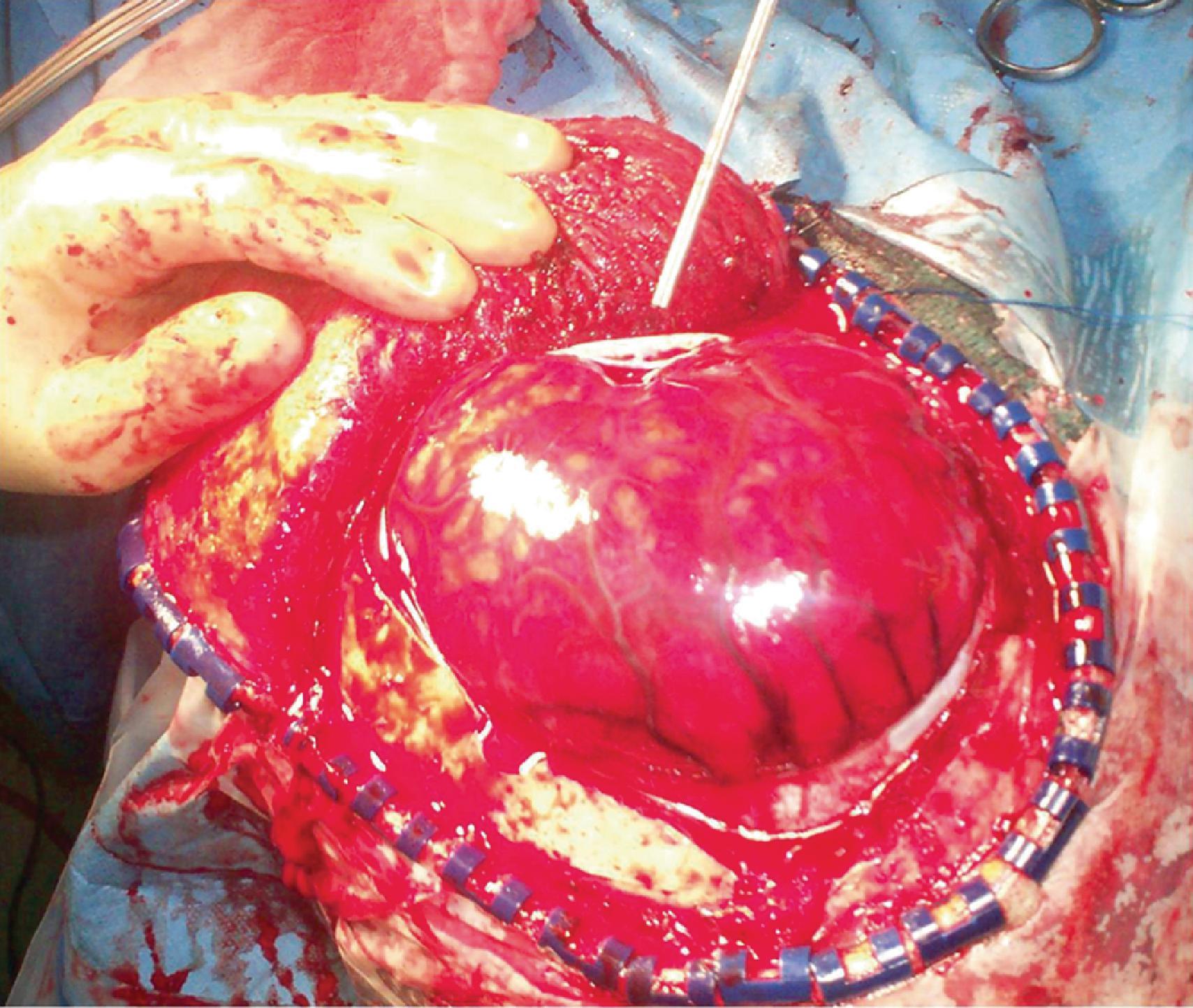
The BTF released a 2020 update regarding secondary or delayed decompressive craniectomy recommendations for refractory ICP elevations based on results from RESCUEicp (Trial of Decompressive Craniectomy for Traumatic Intracranial Hypertension) and DECRA (Decompression Craniectomy in Patients with Severe Traumatic Brain Injury). The RESCUEicp focused on patients with elevated ICP for 1 to 12 hours within 10 days of admission (late), while DECRA looked at patients with elevated ICP for 15 minutes within 72 hours of presentation (early) despite maximal medical therapy. In both groups, patients who underwent craniectomy were noted to have decreased ICP and shorter ICU stays; however, favorable mortality outcomes were only seen in the late group. Both studies noted a higher proportion of patients with resultant severe neurologic deficits compared with medical management, thus highlighting the importance of strict patient selection criteria and realistic counseling of patients and/or their families.
Many cases of severe TBI have concomitant skull fractures. Although most skull fractures do not require intervention, fixation is indicated for open fractures, skull table displacement greater than 1 cm, gross deformity, or wound contamination. Broad-spectrum antibiotic prophylaxis is used for penetrating injuries or contaminated wounds until CSF leak has resolved. Complications of emergent or urgent craniectomy in trauma include CSF leak, hygroma, hydrocephalus, hematoma expansion, and infection including meningitis, encephalitis, and brain abscess.
TBI can result in a spectrum of disabilities. An analysis of 5-year outcomes for TBI patients shows that approximately 30% improved, 20% stayed the same, 30% became worse, and 20% died. Most moderate to severe TBI patients will have some types of cognitive disturbances including difficulties with attention, learning, and memory. They may also experience headaches, fatigue, sleep disturbances, and mood disorders. The National Institute of Neurological Disorders and Stroke (NINDS) has collaborated with other groups to create a Common Data Elements (CDE) Outcomes Workup group to establish domains that assess short- and long-term outcomes. A few included domains are global outcomes, recovery of consciousness, physical and behavioral function, and social role participation. Patients with higher functionality scores before injury and at time of hospital discharge benefit the most from TBI rehabilitation. TBI rehabilitation focuses on cognitive and physical activities to help patients regain their ability to complete activities of daily of living. TBI remains a large burden to society, with associated direct and indirect medical costs estimated at over $75 billion.
Severe TBI often causes irreversible damage to the brain and can result in brainstem herniation and brain death. The American Academy of Neurology guidelines for the determination of brain death include medical optimization, elimination of cofounding factors, a through neurologic examination, and apnea test. Prerequisites for declaring brain death include the presence of an irreversible coma from a known cause confirmed with neuroimaging, no spontaneous respirations, normothermia (core temperature ≥36°C), and hemodynamic stability (SBP ≥100 mm Hg). The effects of sedating drugs, paralytics, and electrolytes or acid-base derangements must be excluded. Examination maneuvers test for the absence of brainstem reflexes by examining pupillary light response; corneal, oculocephalic, and oculovestibular reflexes; no response to noxious stimuli; and the gag and cough reflexes induced with deep suctioning. To perform an apnea test, the patient should be preoxygenated and normocapnic. The patient is then disconnected from the ventilator but provided oxygen. The test is consistent with brain death if the final PaCO 2 measures ≥60 mm Hg or if there is an increase of 20 mm Hg from baseline without evidence of spontaneous respirations. Additional testing can include electroencephalogram, CT angiography of the head and neck, and nuclear CBF scans.
Chest trauma is common. Data suggest that approximately 30% to 50% of all blunt trauma patients admitted to trauma centers have sustained chest trauma. Thoracic injuries account for 20% to 25% of all trauma-related deaths, and complications of chest trauma contribute to another 25% of all deaths. Early deaths in chest trauma patients are caused primarily by major respiratory problems, such as tension pneumothorax and massive hemothorax. These clinical situations must be recognized and managed promptly. The most common injury in thoracic trauma is chest wall trauma. Because of the high prevalence of rib fractures and associated pneumothorax and hemothorax, most thoracic injuries can be managed with simple procedures such as thoracentesis, respiratory support, and adequate analgesia. Only 15% of patients sustaining chest trauma will require a thoracotomy for definitive management of intrathoracic injuries.
This chapter reviews the most current concepts of diagnosis and management of chest wall injuries, pneumothorax, and hemothorax.
The physical examination of the chest is critical in identifying life-threatening situations that will require immediate attention. These include tension pneumothorax, massive hemothorax, open pneumothorax, flail chest, and cardiac tamponade.
The Advanced Trauma Life Support (ATLS) principles of primary assessment, resuscitation, secondary assessment, and definitive care should be followed. Pulse oximetry should be applied as soon as the patient arrives. A complete physical exam is helpful in identifying significant physiologic changes. Throughout the assessment, high-flow oxygen should be administered to the patient. A chest x-ray is usually performed as soon as is feasible to radiographically evaluate the soft tissues, bones, lung parenchyma, and thoracic cavities. The use of ultrasonography to assess the chest cavity, lung parenchyma, and the pericardium (Extended Focused Assessment with Sonography in Trauma [eFAST]) carries the potential to confirm diagnoses that sometimes are difficult to make based only on the clinical exam. The same is true with the use of chest CT with contrast (CT angiography) ( Fig. 1 ), which is certainly more sensitive than conventional x-rays and the physical exam alone. However, it exposes patients to much higher levels of ionizing radiation, a significant problem in the pediatric population.
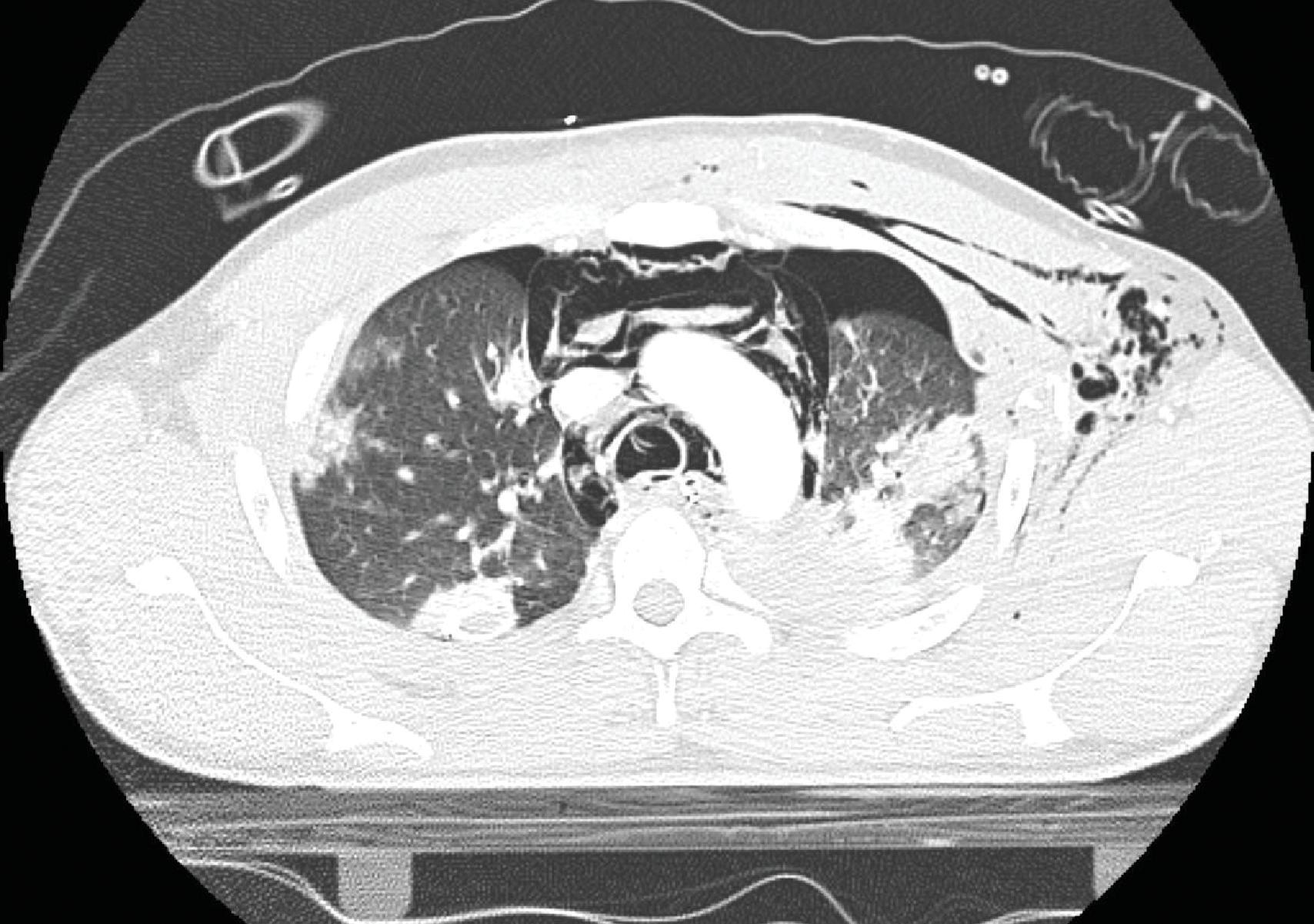
To help guide decision making for chest imaging, the National Emergency X-Ray Utilization Study (NEXUS Chest) screening tools have been developed and shown to have a sensitivity greater than 99% for thoracic injuries of major clinical significance ( Boxes 1 and 2 ).
Age >60 years
Rapid deceleration mechanism
Fall >20 feet
Motor vehicle crash >40 mph
Chest pain
Intoxication
Abnormal alertness or mental status
Distracting injury
Chest wall tenderness
* All criteria absent: Very low risk for intrathoracic injury and chest imaging not indicated.
Abnormal chest x-ray
Distracting injury
Chest wall tenderness
Sternum tenderness
Thoracic spine tenderness
Scapula tenderness
Rapid deceleration injury
* All criteria absent: May forgo chest CT.
We still believe a chest x-ray is essential in evaluating thoracic trauma; however, tension pneumothorax or massive hemothorax should be diagnosed clinically.
Blunt chest wall trauma varies from an isolated rib fracture to bilateral multiple rib fractures caused by crush mechanisms of injury, leading to significant respiratory distress resulting from pneumothorax, hemothorax, or marked pulmonary contusion. Mortality rates following blunt chest wall trauma range from 4% to 20%.
After blunt chest trauma, ribs fractures are the most common injuries, with an overall prevalence of 10% in trauma admissions. Ribs 4 to 10 are the most commonly fractured. These injuries are accompanied by high mortality rates, varying from 10% to 20%, usually resulting from the development of respiratory dysfunction and pneumonia.
An isolated single rib fracture without lung involvement, pneumothorax, or hemothorax is usually treated on an outpatient basis. However, the ideal management of patients with multiple rib fractures or significant chest wall trauma without life-threatening injuries is controversial. It is well known that elderly patients have a reduced ability to cough, reduced vital capacity, and increased incidence of infectious complications following rib fractures as a result of decreased bone density, reduced chest wall compliance, and increased incidence of underlying parenchymal disease.
The primary clinical manifestation of rib fractures is pain. Other clinical signs include tenderness to palpation and crepitus. Rib fractures are confirmed with a chest x-ray or by chest CT. Approximately 55% of rib fractures are missed on routine chest radiographs. Special views, including an oblique view, may increase sensitivity but are not commonly used during the initial evaluation of a trauma patient. CT scans are the most sensitive study to diagnose rib fractures.
Multiple rib fractures are the hallmark of severe trauma as a result of high-energy transfer. These patients should undergo a complete evaluation to rule out intrathoracic and abdominal injuries. Fractures of the lower ribs (9 to 12) are associated with an increased incidence of solid organ injuries (liver and spleen), and fractures of the upper ribs (1 to 3), clavicle, or scapula are associated with major thoracic vascular injuries as well as blunt cerebrovascular injuries.
In addition to rib number, the total number of fractures also dictates risk, with each additional rib fracture increasing the risk of pulmonary complications and death. Fracture location within the rib also affects patient outcome. In general, lateral and subscapular fracture lines produce the most pain, whereas posterior or anterior fracture lines are usually better tolerated. In addition, the degree of displacement, overlap, and angulation of the fracture all contribute to changes in pulmonary mechanics, pain, and injury to surrounding structures such as the intercostal bundle, lung, and diaphragm.
The patient’s age also augments the increased risk of poor outcomes following chest wall trauma. Elderly trauma patients (>65 years of age) are particularly susceptible to deterioration after chest wall trauma. They have an overall mortality rate of 22% and a pneumonia rate of 33% compared with 10% and 17%, respectively, in younger patients.
In this particular patient population, pain control and aggressive pulmonary toilet should be implemented early, with a low threshold for intubation. Care should be taken to avoid fluid overload because it may further impair respiratory function. Pneumonia is the most frequent complication, particularly in the elderly, aggravating chronic lung diseases, increasing ventilator days, and significantly contributing to mortality.
Inadequate pain control significantly contributes to complications following rib fractures such as atelectasis and pneumonia. Pain control is attempted initially with oral or intravenous analgesics. Intercostal nerve blocks with bupivacaine are effective for pain control; however, they are not feasible for multiple fractures as they require frequent injections.
Epidural analgesia is adequate for patients with multiple or bilateral fractures, and it provides sufficient pain control and appropriate pulmonary toilet, decreasing the number of complications.
A flail chest occurs when three or more contiguous ribs are broken in two places, creating a segment of bone and muscle that can move independently of the thoracic wall. It can also occur following costochondral separation. Fractures can be located in the anterior, lateral, or posterior chest wall. Flail chest occurs in 10% to 15% of patients sustaining major chest trauma, and the chance of having an intrathoracic injury increases several-fold. Flail chest represents the most severe form of chest wall injury after blunt trauma, with more than 80% of patients needing ICU admission, more than 50% requiring mechanical ventilation, and an overall mortality rate of 16%.
Closed traumatic brain injury is the most frequent associated extrathoracic injury, contributing to higher morbidity and mortality rates. Isolated flail chest carries a low mortality rate in younger patients.
The fractured segment of the chest wall moves paradoxically with spontaneous respirations, pulling inward with inspiration secondary to the negative intrathoracic pressure. The paradoxical respiratory movement can cause significant pain to the patient, leading to a respiratory pattern characterized by rapid shallow breaths and resulting in atelectasis and hypoxia caused by pain. Additionally, the force required to create a flail segment is excessive and usually results in significant underlying pulmonary contusion, further increasing hypoxia. Sequential measurements of forced vital capacity, tidal volume, and inspiratory force are helpful to predict which patients will require ventilatory support. The pathophysiologic effects may be present immediately or may progress over several hours and present as late respiratory decompensation. Lastly, the flail segment may be associated with hemothorax or pneumothorax, which is treated by tube thoracostomy in most instances.
Several scoring systems have been developed to quantify the severity of chest wall injury. The RibScore, which involves several detailed radiographic parameters related to rib fracture pattern, has been recently proposed ( Box 3 ). This score is highly predictive of adverse pulmonary outcomes and is helpful in predicting which patients may benefit from surgical stabilization of rib fractures (SSRF).
≥6 rib fractures
≥3 bicortical displaced fractures
≥1 fracture in each anatomic area †
Flail chest
Bilateral fractures
First rib fracture
* 1 point is assigned for each variable. RibScore ≥4 may benefit from surgical stabilization.
† Defined as anterior, lateral, and posterior.
Treatment of the flail segment and multiple rib fractures with similar physiologic impact as a flail chest varies according to the patient’s clinical presentation. The great majority of patients will undergo conservative (nonsurgical) management. For simple unilateral fractures involving no more than three ribs, young patients with adequate pain control on oral analgesics and without comorbidities can be managed successfully as outpatients. All other patients should be considered for admission, and there should be a low threshold to admit patients with high-risk features to the ICU ( Box 4 ). If stable from a respiratory standpoint, supplemental oxygen, aggressive pulmonary toilet, and adequate analgesia are enough. Pain can be controlled with oral or intravenous analgesics, patient-controlled analgesia (PCA), intercostal nerve blocks, paracostal catheters, which deliver a continuous stream of local anesthetic, or with epidural anesthesia. If a paracostal catheter is used, the anesthetic regimen is usually a bolus dose of 0.25% bupivacaine (20 mL) followed by a continuous infusion (0.125% at 12 mL/h) by either a pump or an elastomer reservoir. Because of the overuse of opioids and the risk of chemical dependency, a multimodal therapy approach has been proposed ( Box 5 ).
Admission if ≥2 of the following are present after pain control with oral medication:
Respiratory rate >18
Incentive spirometry <75% predicted
Numeric pain score ≥6
Poor cough
Age ≥65 years
≥3 fractures
If admission criteria are met, ICU admission if ≥1 of the following are present:
Age ≥65 years
≥6 fractures
Incentive spirometry <60% predicted
Flail chest
>4 L oxygen required to maintain SpO 2 >90%
Associated injury requiring ICU admission
Incentive spirometry
Ibuprofen 800 mg PO q6h
Gabapentin 100 mg PO TID
Diazepam 5–10 mg PO QD
Oxycodone PRN
Incentive spirometry
Ambulation
Ibuprofen 800 mg PO q6h
Gabapentin 100 mg PO TID
Diazepam 5–10 mg PO QD
Oxycodone PRN
Intravenous narcotics PRN
Consider epidural or paravertebral catheter
Consider surgical stabilization of rib fractures
Several studies have shown that epidural pain control is superior to other methods and have demonstrated that epidural analgesia after chest wall injuries is associated with decreased ventilator days, fewer pulmonary complications, and shortened ICU and hospital length of stay, primarily when used in older adult patients with multiple fractures. Current guidelines strongly recommend placing an epidural catheter for patients older than 65 years of age with four or more rib fractures. Most patients are eligible for epidural analgesia. Absolute contraindications include increased intracranial pressure, localized infection or rash, and inability to maintain the position for catheter placement, while relative contraindications include a history of spine surgery, spinal fracture, instability near the desired level of epidural placement, severe aortic stenosis, mitral stenosis, or pulmonary hypertension, uncorrectable coagulopathy, and ongoing vasopressor requirement.
In patients who develop respiratory distress, intubation and positive pressure ventilation are the treatment of choice. The intubation allows more aggressive pain management and sedation; the positive pressure ventilation can recruit an atelectatic lung and support the contused lung to improve oxygenation. Additionally, the positive pressure ventilation splints the flail segment so the paradoxical motion is halted and the entirety of the thoracic wall can move in synchrony, relieving pain and allowing healing of the soft tissue and bones.
SSRF has gained attention in recent years. The routine use of SSRF is still controversial, and the indications are being better defined as more studies are conducted. The absolute and relative indications for operative intervention in rib fractures are presented in Box 6 . Over the past 15 years, several studies, including randomized controlled trials and meta-analyses, have documented the efficacy of SSRF, primarily in patients with flail chest. These studies have consistently reported shorter recovery time, shorter ICU and hospital length of stay, decreased incidence of pneumonia, and shorter duration of mechanical ventilation following the procedure. The timing of SSRF also remains controversial. Some have advocated SSRF after certain clinical variables become apparent (i.e., failed ventilator wean, intractable pain); however, earlier repair has definite advantages. Inflammation around the fractures peaks between 3 and 5 days postinjury, and pain from rib movement during respiration can cause progressive splinting, atelectasis, and potentially respiratory failure. It seems that SSRF within 72 hours of patient presentation provides the best window for technical success and prevention of complications.
Crushed chest with marked chest wall deformity
Flail chest
Rib fracture nonunion with chest wall deformity
Open rib fracture
Intractable pain
Persistent paradoxical respiratory movement
In most cases, SSRF is accomplished by a muscle-sparing technique. Anterior fractures are approached via a submammary incision in the supine position, with the elevation of a pectoralis flap. For isolated lateral fractures of 3 to 5 contiguous ribs, an 8- to 10-cm longitudinal incision after the anterior border of the latissimus dorsi muscle and centered over the middle fracture usually provides adequate exposure. The serratus anterior muscle fibers are split, thereby exposing the fractures. Alternatively, extensive lateral and posterior fractures involving five or more contiguous ribs typically are best approached through a standard posterolateral thoracotomy incision. Details of the procedure are shown in Figure 2 .
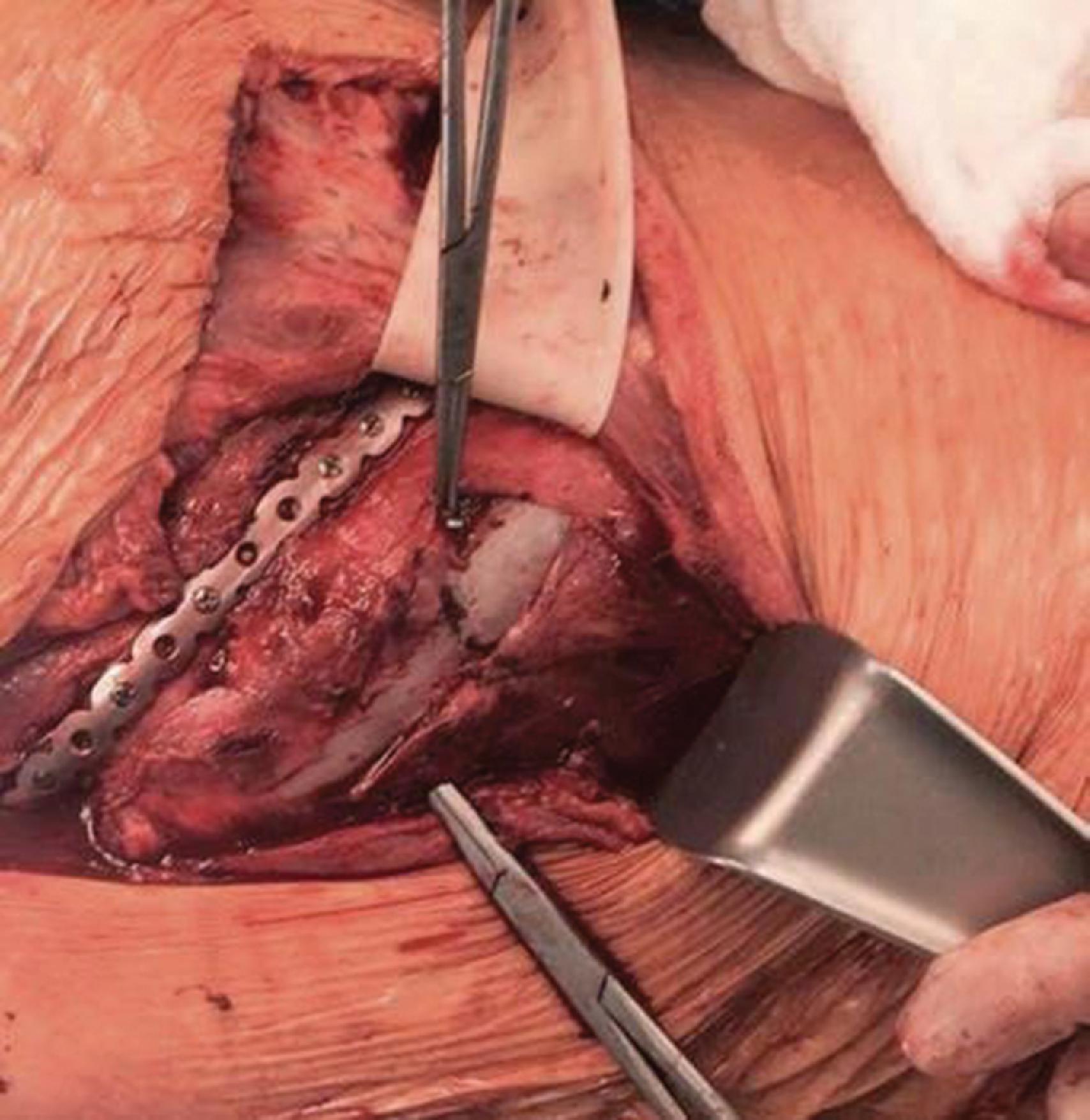
One recent meta-analysis focused on the potential reduction of complications, hospital-related end points, pulmonary function, and pain scores following SSRF. The study showed that surgical fixation of fractured ribs leads to a shorter duration of mechanical ventilation, shorter ICU and hospital stay, lower incidence of pneumonia, lower mortality rate, less chest wall deformity, and less need for tracheostomy when compared with those treated conservatively. Interestingly, there was no difference in pulmonary function and pain scores between groups. Other meta-analyses have shown similar results, although the heterogeneity of the data is high, and better designed future studies focusing on indications, timing, and long-term follow-up are needed.
A systematic review of 48 studies focusing on complications and outcomes following rib fracture fixation was recently published. The authors reported that the overall risk of surgery- and implant-related complications was 10.3%, wound infection occurred in 2.2%, and fracture-related infection occurred in 1.3%. Pulmonary complications occurred in 31%. The overall mortality rate was 2.9%, with none directly related to SSRF. Studies reporting on long-term quality of life reported good quality of life after rib fracture fixation.
Although SSRF has been frequently studied in patients sustaining flail chest, its efficacy in patients with severe but non-flail chest has only been reported recently. In a multicenter, prospective, controlled clinical trial (12 centers) with 110 patients comparing SSRF within 72 hours to medical management, the authors reported outcomes in a 2-week follow-up. The surgical group had lower pain scores and higher quality of life scores as measured by the disability score. Narcotic consumption and pleural space complications were also lower in the operative group.
More recently, a thoracoscopic approach has been used for SSRF with the added advantages of being minimally invasive, allowing for extensive irrigation and complete evacuation/aspiration of retained pleural blood ( Fig. 3 ).

Although rare, sternal fractures may occur following blunt mechanisms, including motor vehicle accidents and falls. The presence of a fractured sternum suggests significant energy transfer to the anterior chest wall. Signs and symptoms include chest pain, particularly over the sternum and crepitus. A hematoma over the sternum or across the chest may be seen, and it is a common occurrence after frontal car crashes in patients wearing a three-point seatbelt. A lateral x-ray usually confirms the diagnosis, but more subtle fractures are only diagnosed by chest CT. Sternal fractures also constitute a marker for serious associated injuries, including myocardial contusion, myocardial rupture, esophageal perforation, airway injury, and thoracic aortic rupture.
Treatment of sternal fractures is usually conservative, although patients with significant chest wall instability may require open reduction and internal fixation.
A pneumothorax occurs when air from an injured lung or airway is trapped within the pleural cavity, increasing the normal negative intrapleural pressure. It may be caused by penetrating or blunt mechanisms. Following blunt trauma, pneumothorax is caused by rib fractures penetrating the lung parenchyma or by lung injuries without chest wall involvement. Deceleration injuries and sudden increases in intrathoracic pressure also may cause pneumothorax.
Clinical findings suggestive of a pneumothorax include decreased breath sounds, hyperresonance to percussion, and decreased expansion of the affected lung during inspiration. Pneumothoraces are classified according to the volume of lung loss or collapse identified on chest x-ray or by respiratory and systemic signs. In a small pneumothorax, the volume loss is one-third of the average lung volume. In a large pneumothorax, the lung is completely collapsed, but there is no mediastinal shift or associated hypotension.
Tension pneumothorax is the most challenging and life-threatening of all breathing problems. It occurs when air continuously enters the thoracic cavity from the lung, airway, or atmosphere and cannot escape. The pressure causes collapse of the lungs preventing oxygenation and ventilation on the ipsilateral side, and it eventually causes deviation of the mediastinum to the opposite side. This causes compression of the superior and inferior vena cava, decreasing preload to the heart and resulting in hypotension. Tension pneumothorax should be recognized immediately by air hunger, hypoxia, tachypnea, hyperresonance, unilateral absence of breath sounds, deviation of the trachea away from the affected side, distended neck veins, hypotension, and tachycardia. The tracheal deviation may be challenging to visualize and may be prevented if the patient is intubated. Distended neck veins may not be present if the patient is hypovolemic.
Tension pneumothorax may be confused with pericardial tamponade as both result in distended neck veins, a feeling of impending doom or restlessness, and hypotension. However, tamponade will result in muffled heart sounds and does not cause tracheal deviation or asymmetric breath sounds.
Tension pneumothorax is diagnosed clinically, constituting a life-threatening emergency. Chest x-rays are not necessary to confirm the diagnosis, and delays to definitive treatment significantly increase the risk of circulatory collapse and cardiorespiratory arrest.
If tension pneumothorax is suspected, emergent decompression must be performed. ATLS principles recommend needle decompression with large-bore needles or angiocatheters placed in the second intercostal space in the midclavicular line. In obese patients, the needle may be inserted in the fifth intercostal space in the anterior axillary line. If the needle is placed correctly, a rush of air should be observed with an immediate improvement in vital signs as the tension pneumothorax is converted to a simple pneumothorax ( Fig. 4 ). This should then be followed by placing a chest tube for more permanent decompression of the affected hemithorax and draining any blood that may be associated with the tension pneumothorax. Reexpansion of the lung and reapproximation of the pleural surfaces usually seal the lung defect.
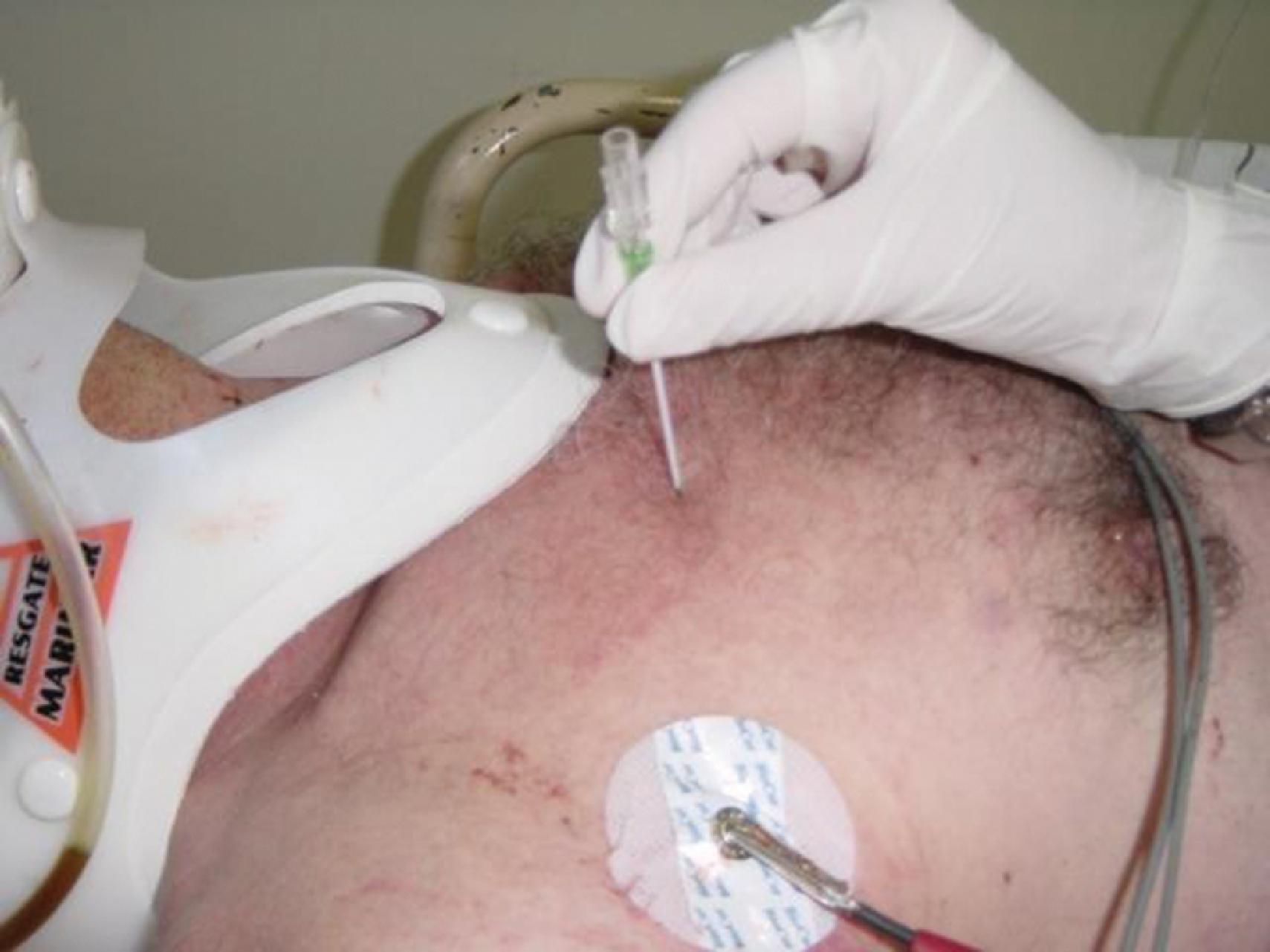
Open pneumothorax, also known as a sucking chest wound, occurs when there is a defect on the chest wall (e.g., large-caliber gunshot wounds, traumatic thoracotomy) large enough to exceed the laryngeal cross-sectional area, allowing the air to enter from the exterior into the pleural cavity and leading to lung collapse caused by rapid equilibration between the intrathoracic pressure and the atmospheric pressure. The increased intrathoracic pressure also causes mediastinal shift and decreased venous return. Signs and symptoms include hypoxia, hypercarbia, hypotension, and respiratory and circulatory failure.
Management of an open pneumothorax includes applying an occlusive dressing and placing a chest tube before closing the chest wall defect to avoid development of a tension pneumothorax. When the initial assessment is completed and the patient is stable, the wound should be cleansed, debrided, and closed in the operating room.
Occult pneumothorax is defined by the presence of a pneumothorax seen on CT but not seen on conventional chest x-ray. The incidence of occult pneumothorax in trauma patients varies from 2% to 10%. The critical issues related to occult pneumothoraces are determining whether or not they have any clinical relevance and trying to identify those that have the potential to grow and cause problems, particularly in patients undergoing positive pressure ventilation, and determining whether or not they should be treated preemptively by tube thoracostomy. A recent multi-institutional prospective observational study sponsored by the American Association for the Surgery of Trauma (AAST) was carried out to elucidate these issues.
The authors analyzed 588 cases of occult pneumothoraces. Of these, 121 patients (21%) underwent immediate tube thoracostomy, and 448 (79%) were observed. Observation failure, defined by the need for tube thoracostomy after a period of observation, occurred in 27 (6%). The observation failure rate of patients undergoing positive pressure ventilation was 14% (10 of 73). Increased hospital and ICU length of stay and ventilator days were observed in the failure of observation group. Univariate analysis identified the size of the occult pneumothorax (7 mm), use of positive pressure ventilation, progression of the occult pneumothorax (seen on subsequent chest x-ray films), respiratory distress, and the presence of a hemothorax as independent factors associated with failure of observation. Multivariate regression analysis identified only the occult pneumothorax and respiratory distress progression as significant predictors of failed observation. Because no patients who failed observation developed a tension pneumothorax or experienced any adverse events, the authors concluded that patients with occult pneumothorax could be carefully monitored and observed without tube thoracostomy.
Blood may accumulate in the pleural cavity following blunt or penetrating injuries. Depending on the nature of the injury, bleeding may vary from minor to massive. Symptoms depend on the amount of blood accumulated in the pleural space. On physical examination, breath sounds may be decreased on the side of the injury. A chest x-ray obtained in the supine position may reveal accumulations of blood greater than 200 cc; however, a supine film may demonstrate a diffuse haziness or none at all. The pleural space can accumulate up to 3 L of blood.
Hemothoraces are initially treated by chest tube placement. In approximately 85% of cases, the bleeding will stop as the lung is reexpanded as a result of the low pressure in the pulmonary circulation. A small number of patients will have continued bleeding and will require a thoracotomy. These are usually injuries in systemic arteries (intercostal or internal mammary artery) or veins, major pulmonary vessels, or the heart.
Massive hemothorax may present with tension physiology similar to tension pneumothorax. Hypotension may be a result of decreased preload from tension physiology as well as from massive blood loss ( Fig. 5 ). Treatment includes immediate placement of a chest tube in the affected side. Blood loss of greater than 1500 mL defines a massive hemothorax and is an indication for operative exploration.
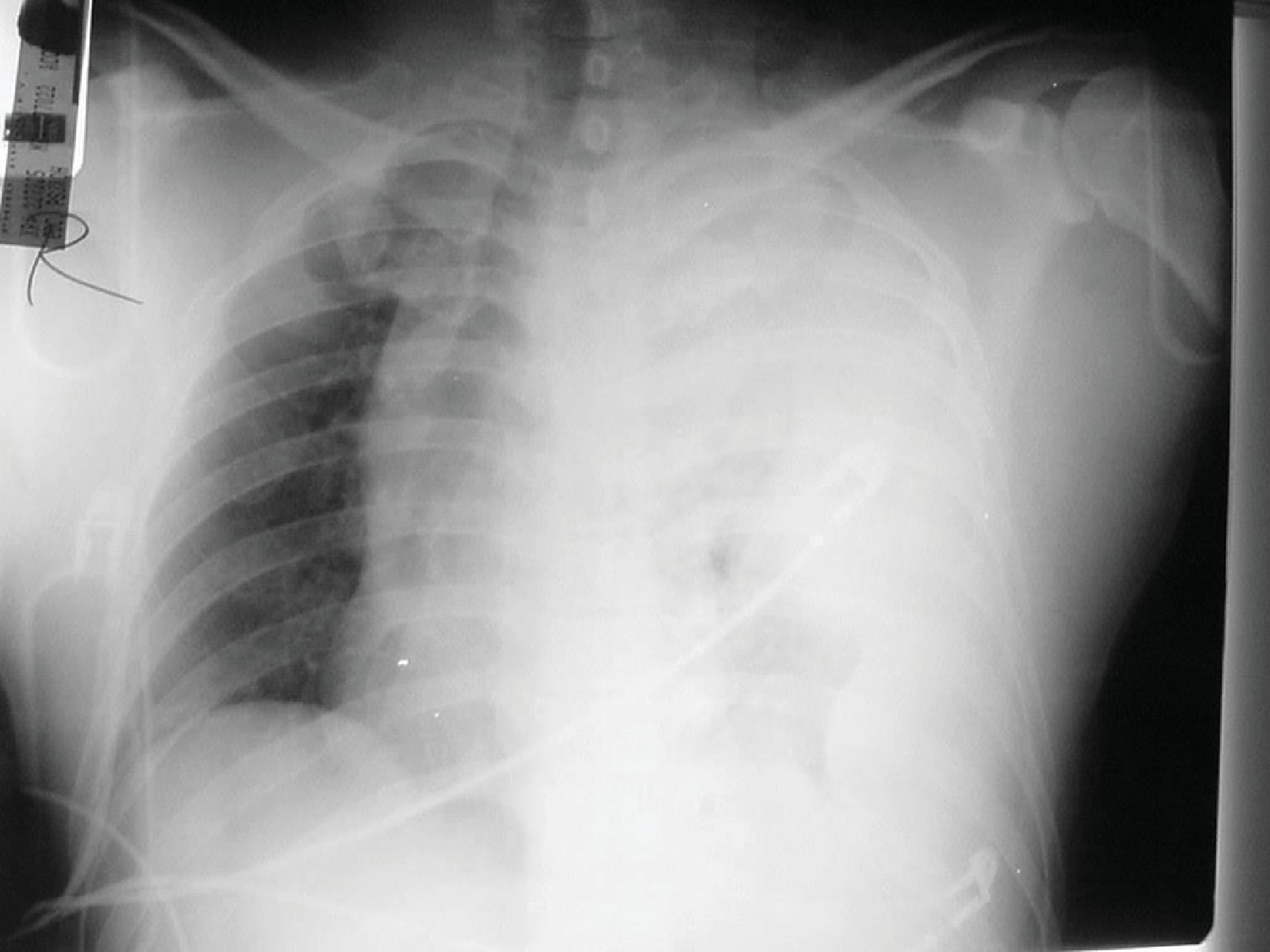
Additional indications for thoracotomy include massive continuous air leak, which may indicate massive parenchymal lung injury or injury to a major airway, and blood loss of 200 mL/h for greater than 4 hours. Shed blood should be collected in a sterile fashion so it may be autotransfused.
Although common (approximately 10%–15% of hemothorax is treated by tube thoracostomy), the true incidence of retained hemothorax is unknown. Retained hemothorax is not only a complication of chest trauma and tube thoracentesis, but it is also recognized as a risk factor for the development of posttraumatic empyema and fibrothorax. A recent study revealed a 26.8% risk of empyema with retained hemothorax compared with only 2% of patients who had complete evacuation. Other independent risk factors for empyema included rib fractures, Injury Severity Score of 25 or more, and the need for additional procedures to treat the hemothorax.
In modern trauma centers, the diagnosis of retained hemothorax is based on CT images of the chest. It seems to be a reliable method to characterize and quantify the volume of a retained clot in the pleural cavity.
Treatment strategies include observation, image-guided drainage, thoracostomy, intrapleural fibrinolytics, video-assisted thoracoscopy (VATS), and thoracotomy. In recent years, trauma surgeons have preferred to use less-invasive modalities initially, leaving the open thoracotomy approach for cases that do not resolve by less-invasive methods.
A recent AAST multi-institutional prospective observational trial was carried out to determine current management strategies used in modern trauma centers in North America. The authors analyzed 328 cases of retained hemothorax over 2 years from 20 centers. Successful observation occurred in cases of hemothorax volume less than 300 cc. VATS was used in 33.5% of patients. Factors related to its success included hemothorax volume up to 900 cc, absence of a diaphragmatic injury, and use of periprocedural antibiotics for thoracostomy placement. Of note, several patients required more than one and sometimes more than two VATS procedures to completely evacuate the pleural cavity of retained blood. Thoracotomy was necessary in 20.4%. The overall incidence of empyema was 26.8%.
The timing of VATS to treat retained hemothorax is still controversial. However, in recent years it seems that consensus is building around the concept that early VATS (between 3 and 5 days post–chest tube placement) is accompanied by more favorable outcomes and less need for reintervention or thoracotomy and extensive decortication.
In the pediatric age group, rib fractures are less common than in adults because of the compliant nature of the chest wall and the presence of more flexible ribs. Because of the increased flexibility of the ribs, which fracture less often, force is transmitted to the lung parenchyma, causing significant pulmonary contusion. It is essential to recognize that when rib fractures occur in the pediatric group, they are accompanied by a higher incidence of other internal associated injuries.
The presence of rib fractures in infants and toddlers should raise suspicion for nonaccidental trauma. Several studies have shown rates of child abuse varying from 56% to 82% when children 0 to 36 months of age present with posterior rib fractures.
As opposed to the current trend of adult patients receiving whole-body CT following blunt injury, in the pediatric age group, a chest x-ray is still valuable and sensitive as a screening test to aid in the diagnosis of significant chest injuries, limiting the exposure to radiation from unnecessary CT scans.
Unquestionably, the sensitivity of chest CT is higher than plain chest x-rays in diagnosing the so-called occult pneumothorax and hemothorax as well as rib fractures; however, the clinical relevance of occult hemothorax and pneumothorax in the pediatric population is still unclear as most patients do not require management changes.
The use of eFAST in the pediatric trauma population performs well in diagnosing pneumothorax and hemothorax, with sensitivity and specificity approaching 100% in the hands of experienced examiners. The absence of lung-sliding and comet tail artifacts are ultrasonographic signs suggestive of a pneumothorax. The diagnosis of rib fractures by ultrasound is possible but operator-dependent.
Clinical signs and symptoms of pneumothorax and hemothorax in children are similar to those found in the adult population. However, an astute clinician must recognize that right mainstem intubation, which occurs more often in young children, is a cause of decreased breath sounds without pneumothorax. In addition, severe gastric distention caused by bagging may also be a confounding factor when examining the chest of an injured child.
The management of pneumothorax and hemothorax in the pediatric age group is also no different than in adults. The great majority of cases will satisfactorily resolve after placing a chest tube (when indicated). An emergency thoracotomy for trauma is rarely needed in children. The indications include hemorrhage greater than 20% to 25% of blood volume or loss of 4% of blood volume per hour after chest tube placement. Rib fractures should be treated with aggressive pain management, and selected patients may require escalation to regional blocks or epidural analgesia.
Trauma is the leading cause of death in those under age 40. In patients with multiple trauma, thoracic injuries have a mortality of 20% to 25%, second only to head trauma. Surgical intervention is required in only 10% to 15% of patients with thoracic trauma. Thoracic injuries include fractures of the sternum, ribs, or spine, and injuries to heart, lungs, great vessels, and diaphragm.
This chapter focuses on the anatomy, diagnosis, injury patterns, and treatment of pneumothorax, hemothorax, pulmonary contusion, pulmonary laceration, and pulmonary vascular injury.
Initial evaluation of trauma patients adheres to the Advanced Trauma Life Support algorithm, ensuring rapid treatment of life- and limb-threatening conditions. Assessments and interventions are done sequentially, or with a larger team, simultaneously following a prearrival briefing and assignment of roles. Unequal, absent, or diminished breath sounds, crepitus, or rib fractures should prompt the surgeon to consider pulmonary parenchymal injuries.
Radiologic studies completed during the secondary survey include chest and pelvis radiographs and an extended focused assessment with sonography in trauma (eFAST) exam, which includes thoracic examination for pneumothorax or hemothorax in addition to the traditional four views (cardiac, right upper abdomen, left upper abdomen, and suprapubic). In an unstable patient with high clinical concern for a pneumothorax or hemothorax, a tube thoracostomy should be performed immediately; confirmation imaging before placement is unnecessary.
Optimal visualization of the thoracic cavity during eFAST exam can be obtained by sliding the probe from the right or left upper quadrant views cranially and dorsally until the “spine sign” is seen (fluid present provides visualization of vertebral bodies above diaphragm) identifying hemothorax. The sensitivity for detection of hemothorax is 92% and specificity 100%. The probe should then be moved to the anterior thoracic view at the highest point of the chest wall (second intercostal space) to detect the presence or absence of pleural lung sliding. Pneumothorax is indicated by the absence of pleural lung sliding, the “marching ants” sign, or “seashore sign.” A normal view will show a static parietal pleura overlying mobile, homogenous, granular pulmonary tissue. Lack of comet tail artifact or hyperechoic reverberation artifact extending upward from the pleural line represents alveolar or interstitial pulmonary edema. The size of a pneumothorax measured on ultrasound correlates well with CT. A chest radiograph can demonstrate the presence of a hemo- or pneumothorax. In a stable patient with blunt trauma, CT scans are the next step in evaluation ( Fig. 1 .)
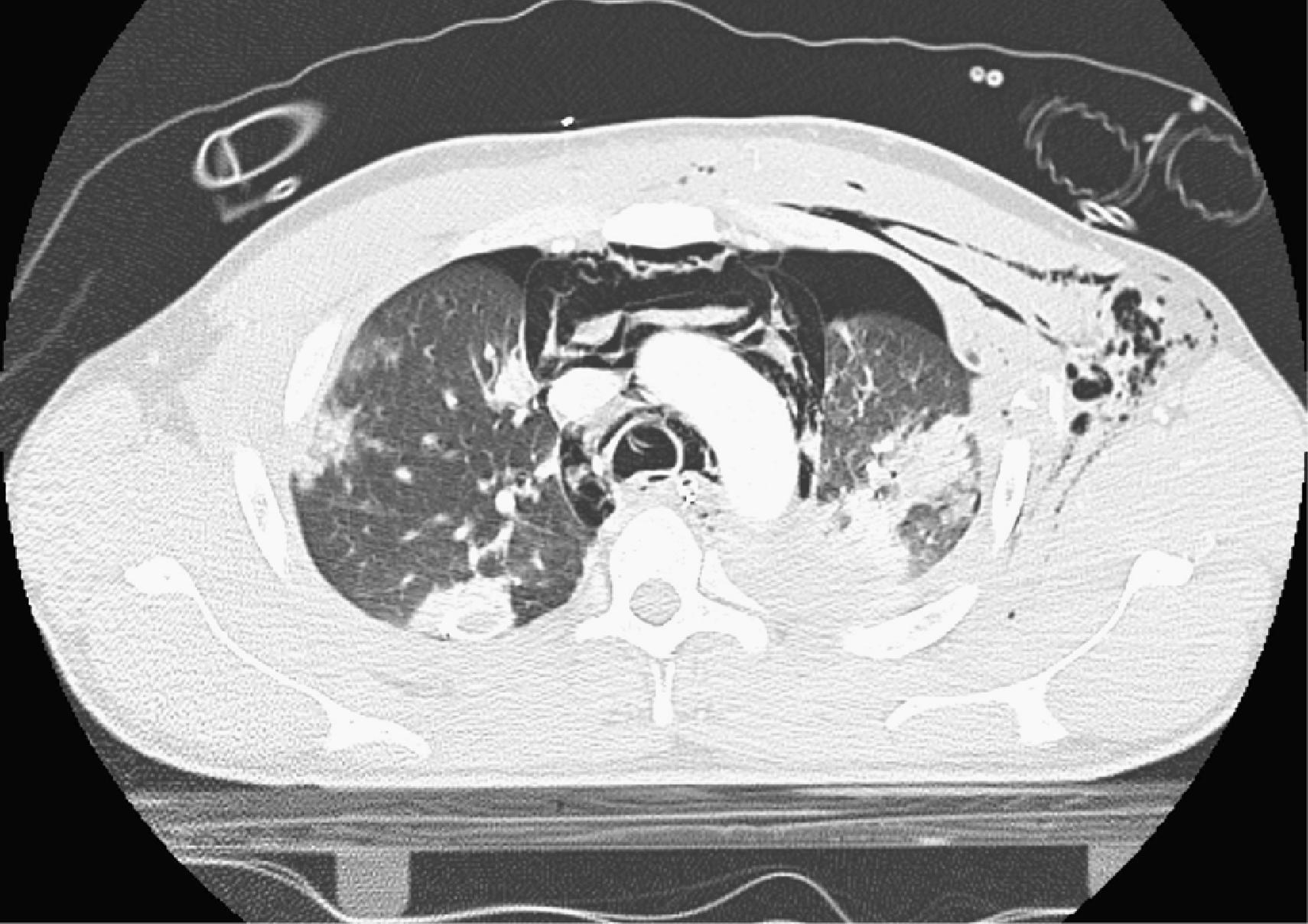
Lung parenchyma is covered by visceral pleura; the interior of the chest wall is covered by the parietal pleura. The left lung has upper and lower lobes divided by an oblique fissure, further subdivided into 10 segments, while the right lung has upper, middle, and lower lobes divided by oblique and horizontal fissures and includes eight or nine segments. Further divisions are based on segmental bronchi. The pulmonary vasculature and bronchi converge at the hilum, which is located at the medial aspect of both lungs and includes, from anterior to posterior, the vein, artery, and bronchi (one on the left, two on the right).
Pulmonary parenchymal injuries include contusions, lacerations, pulmonary vascular injury, and secondary pneumothorax and hemothorax. Cardiac, great vessel, and chest wall injuries will be discussed elsewhere. The American Association for the Surgery of Trauma (AAST) lung injury grading system is useful to describe injury severity ( Table 1 ).
| Grade * | Injury Type | Description of Injury | ||
|---|---|---|---|---|
| I | Contusion | Unilateral, <1 lobe | ||
| II | Contusion | Unilateral single lobe | ||
| III | Laceration Contusion |
Simple Pneumothorax Unilateral, >1 lobe |
||
| IV | Hematoma Laceration |
Nonexpanding intraparenchymal Major (segmental/lobar) air leak |
||
| V | Vascular | Hilar vessel disruption | ||
| VI | Vascular | Total uncontained transection of pulmonary hilum |
Pulmonary contusions are due to direct or indirect damage of the pulmonary parenchyma, causing alveolar and capillary tears, and resulting in blood and interstitial fluid leakage into the alveoli and tissues. Initially there is hematoma formation, which leads to protein infiltration and edema and loss of physiologic structure. This leads to impaired function and reduced gas exchange and pulmonary compliance with increased vascular resistance. In severe cases, the pulmonary inflammatory response to injury can lead to acute respiratory distress syndrome (ARDS). The typical mechanism of injury is rapid deceleration of the body such as a motor vehicle collision (MVC) or fall from height. Severity of the lung injury is difficult to determine based on imaging alone, and the appearance of the contusion does not correlate well with the clinical impact on the patient. The exact mechanism is not well understood; however, several have hypothesized that molecular mechanisms of inflammatory response, immunologic status, and aspiration are contributing factors. The location of the contusion is usually directly at point of impact and often associated with rib fractures. Contrecoup contusions can be seen as well.
The Murray Lung Injury Score may be used to classify the clinical severity of acute lung injury (ALI) ( Table 2 ). A chest radiograph, blood gas, and ventilator settings are collected to calculate the score.
| Classification | 0 | 1 | 2 | 3 | 4 |
|---|---|---|---|---|---|
| Chest x-ray Infiltrates/quadrant |
No | 1 quadrant | 2 quadrants | 3 quadrants | 4 quadrants |
| Hypoxemia PaO 2 /FiO 2 , mm Hg |
≥300 | 225–299 | 175–224 | 100–174 | ≤100 |
| PEEP Setting, cm H 2 0 |
≤5 | 6–8 | 9–11 | 12–14 | ≥15 |
| Compliance Static, mL/cm H 2 0 |
≥80 | 60–79 | 40–59 | 30–39 | ≤29 |
* Classifies severity of acute respiratory distress syndrome and predicts need for extracorporeal membrane oxygenation in treatment.
Pulmonary contusions are diagnosed with a chest radiograph or a thoracic CT scan, which is highly accurate and able to detect even clinically insignificant contusions. Treatment is supportive and includes adequate oxygenation, euvolemia, pain management, and, in the most severe trauma patients, intubation with attention to ventilation parameters, reducing barotrauma by use of low tidal volumes (6–8 mL/kg of ideal body weight) and PEEP. The prognosis is difficult to determine because imaging does not correlate well with the severity of contusions, nor are preexisting pulmonary comorbidities included in the available indices.
Laceration to the parenchyma may be caused by blunt trauma with associated rib fractures or from penetrating trauma that can sever large vessels causing hemodynamically significant bleeding. This diagnosis is assumed if a pneumothorax or hemothorax is present on CT scan. If the lesion is small, observation alone is adequate; however, a chest tube should be placed if sizable or the patient is unstable. Rarely, operative intervention is required and is discussed later in this chapter.
Traumatic pneumatoceles (Fig. 2) develop after intraparenchymal laceration and air and fluid leak into the newly developed cavity. Typically management is nonoperative and involves pain control and pulmonary hygiene. Rarely, infection may develop in the cavity requiring antibiotics and/or drainage. Thoracotomy is rarely required and only after nonoperative minimally invasive methods have failed.
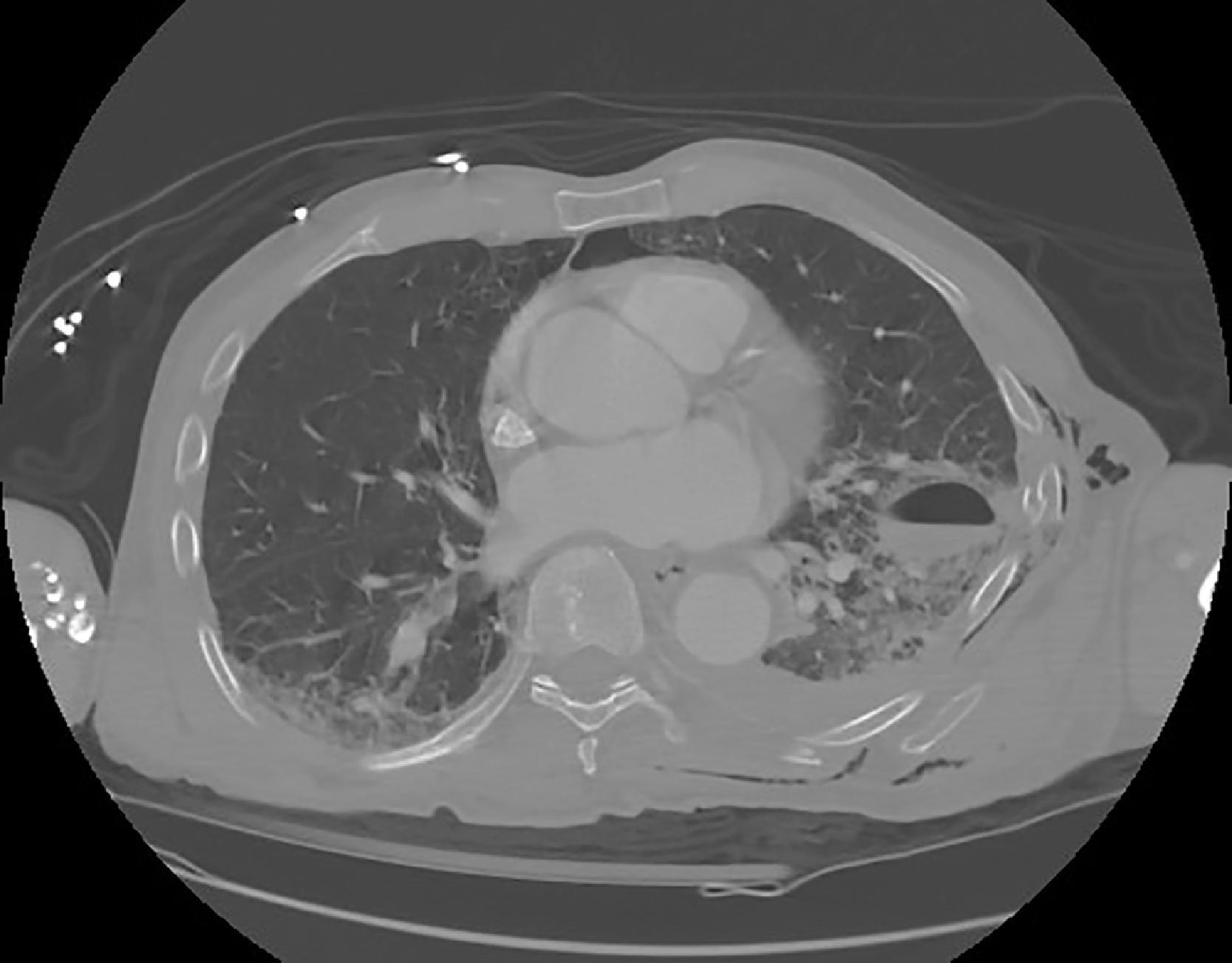
A pneumothorax occurs when air from a pulmonary injury is trapped in the pleural space between the lung and chest wall, increasing the normally negative intrapleural pressure. These may be due to rib fractures puncturing the lung or deceleration injuries. Diagnosis is made on physical examination (decreased breath sounds, crepitus, hyperresonance to percussion) and confirmed with ultrasound, chest radiograph, or CT scan. If a patient is unstable, prompt pleural drainage catheter or tube thoracostomy is indicated.
A pneumothorax that occupies less than 10% to 20% of the chest cavity or measures <2 cm in an asymptomatic patient does not require a chest tube. This patient can be observed for a few hours or overnight at the physician’s discretion. A larger pneumothorax or any symptomatic patient (hypoxia, tachypnea, labored breathing, painful breathing, extensive subcutaneous emphysema), open pneumothorax, tension pneumothorax, or patients requiring mechanical ventilation should generally have a chest tube placed expeditiously.
Tension pneumothorax indicates that air is continuously released from the lung and is unable to escape the chest cavity, causing complete collapse and shift of the mediastinum toward the opposite side, kinking the vena cava and resulting in hypotension due to reduced cardiac preload. On physical examination, one finds tachycardia, hypotension, asymmetric breath sounds, and distended neck veins; chest radiograph will show tracheal deviation and lung collapse.
Open pneumothorax due to a sucking chest wound occurs when there is a large chest wall defect that allows air into the pleural cavity, causing the lung to collapse as it equalizes with atmospheric pressure. A dressing that is occlusive on three of four sides should be placed to act as a one-way valve. However, this can progress to tension physiology and requires immediate chest tube placement at a site away from the wound. An occlusive dressing should then be placed; eventually, operative debridement and closure of the wound should be performed.
Hemothorax is the presence of blood in the thoracic cavity, varying from a minimal amount seen on CT scan to a massive hemothorax, filling the entire hemithorax ( Fig. 3 ). Physical examination reveals decreased breath sounds and dullness to percussion. Often there is an associated pneumothorax. If hemothorax in a hemodynamically unstable or compromised patient is suspected, tube thoracostomy should be performed immediately. If the patient is stable, imaging should be pursued—chest radiograph, eFAST, or CT scan. Extended FAST exam has a sensitivity of 77% and a negative predictive factor close to 100%. Thoracic CT scan is the gold standard for detection of hemo- or pneumothorax; however, it is less than ideal in an unstable patient.
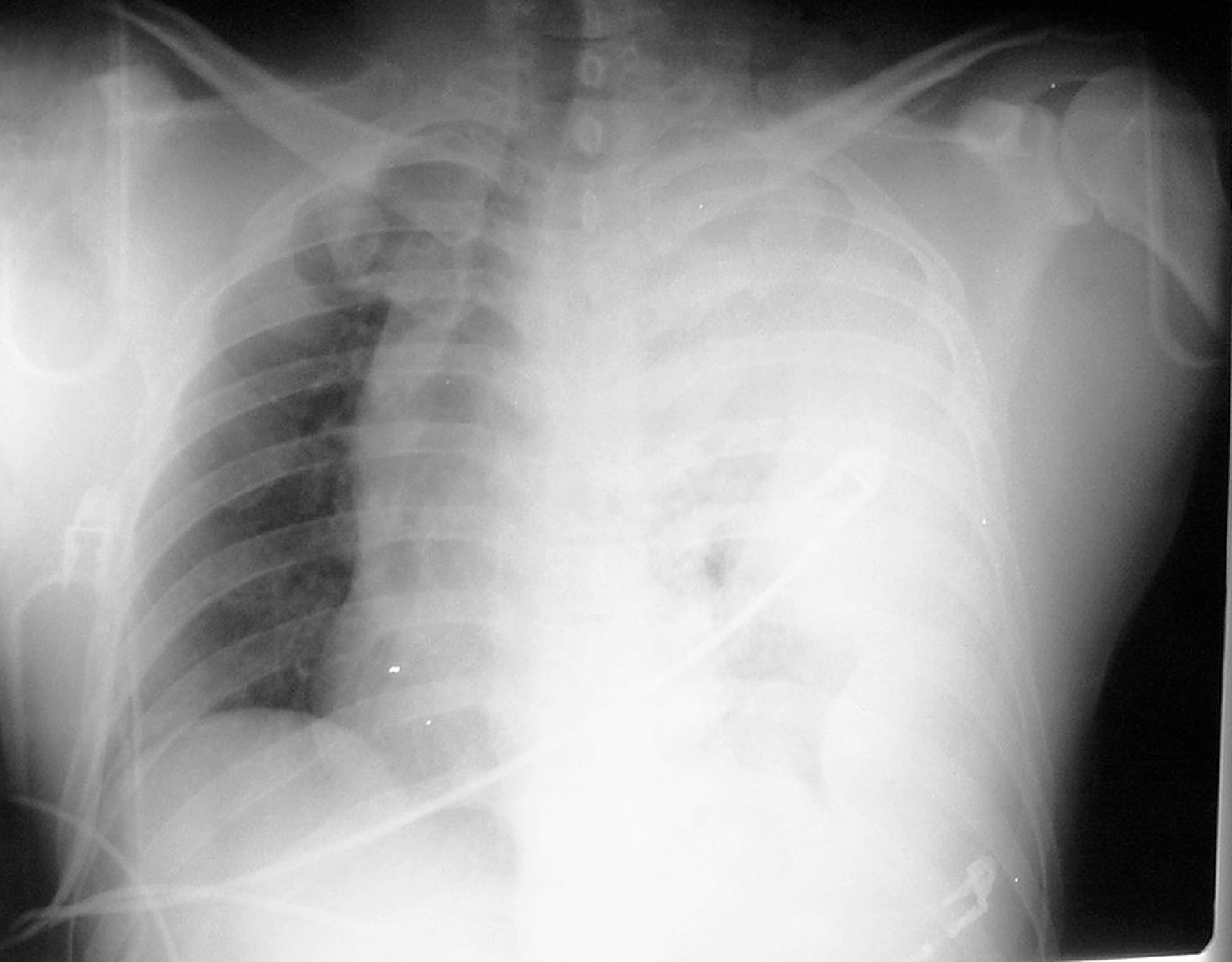
The initial decision point in the treatment of pulmonary injury is whether intervention is required. The physician must assess the patient’s clinical stability: vital signs, oxygen requirements, and other injuries. Some thoracic injuries such as tension pneumothorax can be fatal. However, lifesaving tube thoracostomy can be performed quickly when the appropriate supplies are available. More invasive interventions including thoracotomy and video-assisted thoracoscopic surgery have specific indications ( Table 3 ).
| Thoracotomy | Immediate | Urgent | Delayed |
| Setting | Emergency room: upon arrival and assessment | Operating room: within 1–4 hr | Operating room: >24 hr |
| Injury | Patients in extremis after penetrating chest injury | Cardiac, lung esophagus, tracheobronchial, great vessel injuries, aortic rupture | Retained hemothorax, posttraumatic empyema, delayed tracheobronchial injuries, intracardiac injuries |
Emergent thoracotomy after chest tube placement for hemothorax is guided by initial output >1.5 L or >200 mL/h over 4 hours. Guidelines for urgent/delayed thoracotomy or video-assisted thorascopic surgery (VATS) for pulmonary injuries are continuous air leak, retained hemothorax, empyema, or trapped lung.
Even if the patient does not require operative intervention, supportive measures are essential. Supplemental oxygen, appropriate multimodal pain control, nebulizer treatments, incentive spirometry, early ambulation, and maintenance of euvolemia are important steps in the treatment of pulmonary injuries.
In a patient with a pneumothorax requiring prompt intervention, needle decompression can be performed by inserting a large bore needle or angiocatheter in the second intercostal space at the midclavicular line (or laterally at the midaxillary line in the 4th or 5th intercostal space); this results in an immediate rush of air and symptomatic improvement. In obese patients or those with a thick pectoralis muscle, it can be difficult to reach the thoracic cavity with available needles. In a trauma center, an experienced physician can place a tube thoracostomy quickly.
Position the patient supine with ipsilateral arm extended overhead for lateral placement (fourth or fifth intercostal space midaxillary line). There are many different kits produced for percutaneous chest tube insertion, but all include some variation of the Seldinger technique. The steps in insertion include prep and drape, infiltration of local anesthetic, 5 mm skin incision, insertion of needle, aspiration, wire placement, removal of needle, insertion of dilator, and finally, placement of pigtail or small-bore chest tube, with connection to Pleur-Evac on −20 cm H 2 O suction, and suturing it in place.
These can be helpful for isolated pneumothoraces as there is a smaller incision and less pain, still providing effective drainage. Data are conflicting on the effectiveness of small-bore chest tubes for drainage of hemothorax. However, some have shown that 14 French (Fr) percutaneously placed chest tubes had comparable initial output and effectiveness in draining hemothorax.
The patient is placed supine with the ipsilateral arm extended overhead for lateral placement (fourth or fifth intercostal space in the midaxillary line); it is helpful to place a soft restraint around the wrist to hold it in place. Prep and drape the patient’s anterolateral chest. Landmarks to include in the sterile field are the nipple medially, axillary hairline superiorly, lower ribcage inferiorly, and the bed laterally. Identify the fourth or fifth intercostal space at the midaxillary line; this usually correlates to the nipple level in men or inframammary fold in women. Inject local anesthetic, making a wheal in the skin and injecting more in the pleura at the proposed entrance site. Local anesthetic blocking of a rib above and a rib below will provide a better field of anesthesia. Intravenous conscious sedation may facilitate placement.
Perform a 2 cm transverse incision with a scalpel through the skin, next using scissors or a hemostat to spread through subcutaneous tissue, creating a short tract superior, until able to palpate the chest wall. Use a hemostat to feel the rib and then slide it just above that rib, taking care to avoid the intercostal neurovascular bundle running inferior to the rib above. Push the hemostat through the intercostal muscle and into the chest. A pop is usually heard and felt; a rush of air or blood may occur. Insert a finger through the interspace into the chest, sweeping the lung away, checking for adhesions, and confirming chest entry. Spread with a hemostat and insert a chest tube through this hole, guiding it superior and posteriorly by holding the exterior portion of the tube anterior and inferiorly. Confirm that the last drain hole is securely inside the chest. Once satisfied with placement, attach to wall suction at −20 H 2 O using a Pleur-Evac and suture the tube in place, with 0 or 2-0 silk. Before breaking down the sterile field, obtain a portable chest radiograph to ensure correct positioning of the tube. If the sterile field remains intact, the tube can be manipulated. Secure chest tube connections with tape or zip ties (i.e., a ratcheting cable tie). Remove the tube as soon as the air leak is resolved and drainage decreases (<200 cc serosanguineous drainage).
Previous recommendations advocated for a large bore chest tube (36–40 Fr) for hemo- or pneumothorax. However, more recent studies did not show a benefit to a larger tube, and a smaller 28Fr tube or even a 14Fr percutaneous catheter can be considered. Current Eastern Association for the Surgery of Trauma (EAST) guidelines for the prophylactic administration of antibiotics do not support routine administration.
The benefits of tube thoracostomy insertion usually far outweigh the risks for all patients. Surgeons must be aware of the potential for complications. Vascular injuries, most commonly the intercostal artery or vein, can require suture ligation, interventional radiographic embolization, or thoracotomy to resolve. More significant injuries are rare but include injuries to the heart, lung parenchyma, diaphragm, or intraabdominal organs (stomach, spleen, liver, colon, other). Also reported are pleural shock (exceedingly rare vagal reflex resulting in cardiac arrest after reexpansion that should be treated with cardiopulmonary resuscitation algorithms), expansion edema, wrong side placement, fistulas including bronchopleural/chyle, empyema, pneumonia, and pain.
Patients requiring emergency department (ED) thoracotomy arrive in extremis, and the decision to proceed is based on rapid decision making by the trauma team leader. Determination of survivability of the patient’s injuries, ability to control hemorrhage, duration of time without a palpable pulse, and the presence of cardiac activity on ultrasound are factors that must be considered. A patient with penetrating chest trauma with minimal downtime has the greatest likelihood of survival after opening the chest in the ED.
Once the decision has been made, one person should continue cardiopulmonary resuscitation, and the patient should be positioned supine with the left arm extended overhead ( Fig. 4 ). Using a No. 10 scalpel blade, perform a left anterolateral thoracotomy that extends from the sternum below the nipple to the midaxillary line through skin, soft tissue, and muscle. This should expose the intercostal space, which is opened along the upper margin of the rib into the axilla. Push the lung away, and use scissors to open the pleura along the length of the incision. Place a Finochietto self-retaining retractor with handle facing down toward the bed to spread the ribs. If necessary, a scalpel, Lebsche knife, or trauma shears can divide costochondral junctions or across the sternum. Evacuate blood from the chest and control identified injuries. Cardiac, major vessels, pulmonary, and chest wall injuries may be a source of hemorrhagic shock. Massive pulmonary hemorrhage may be controlled by freeing the inferior pulmonary ligament and twisting the lung at the hilum. Once these injuries have been identified and stabilized, cross-clamp the thoracic aorta by opening the posterior mediastinum, then proceed to the OR for definitive repair.
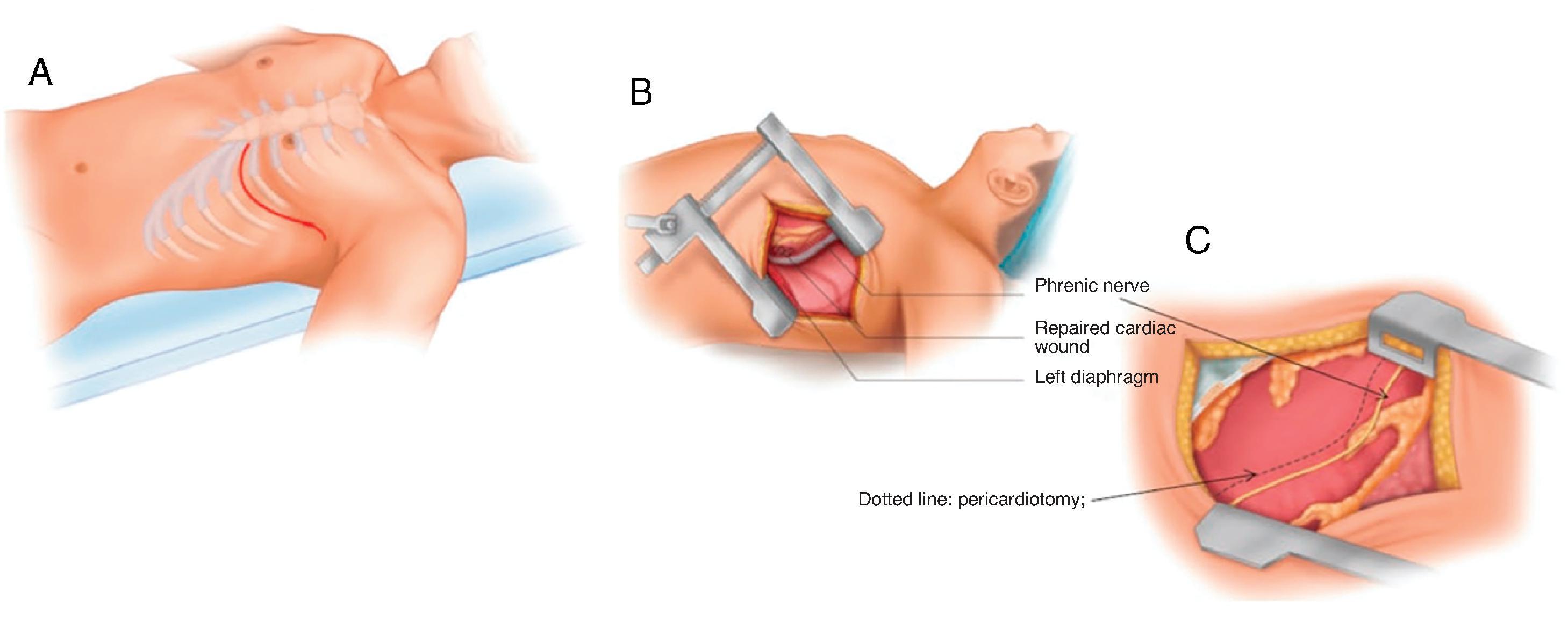
Indications for VATS include diagnostic evaluation of the diaphragm or other thoracic structures in a stable patient, empyema, persistent air leak, or retained hemothorax that has clotted and can no longer be drained by a chest tube. Suspicion may be raised by the appearance on chest radiograph; however, a noncontrast chest CT scan better quantifies the residual blood.
A dual-lumen endotracheal tube should be used to allow for single lung ventilation during the procedure. The patient should be placed in a lateral decubitus position with the operative side up, prepped, and draped. Typically, two or three 2-cm incisions are triangulated low on the chest. A 10-mm angled scope is inserted through a trocar in one incision while a combination of long-ringed forceps and suction are used to remove any remaining blood and strip off any formed rind from the lung and chest wall. This will facilitate full lung expansion and prevent it from becoming trapped by adhesions. One or two chest tubes should be placed and secured after the conclusion of the case to allow continued drainage.
For most patients, treatment with a well-placed chest tube will be adequate. However, for the few that do require thoracotomy, indications usually include either persistent air leak or hemorrhage. There are multiple less common indications for delayed thoracotomy such as chyle leak, trapped lung, or need for rib fixation.
In contrast to ED thoracotomy, an urgent or delayed thoracotomy is typically through a posterolateral incision on the injured side. This will give better exposure for pulmonary injuries. First, anesthesia should intubate with a dual-lumen tube, and then the patient should be positioned with a bean bag in lateral decubitus with arms extended anteriorly and supported 90 degrees at the shoulder on a Mayo table with pillows. A posterolateral thoracotomy at the fifth intercostal space should be made and a rib spreader placed. If better exposure is required, the fifth rib may be resected. Initially, evacuate fluid and clot to improve visibility, divide the inferior pulmonary ligament to provide better exposure and mobility of the lung, and repair identified injuries.
Thoracic trauma can be managed nonoperatively with supportive measures and a chest tube in 90% of patients. For the remaining 10%, anatomic lung resection is rarely needed; in fact, less than 1% of patients will require it. More common techniques include simple suture repair, nonanatomic wedge resection, or tractotomy ( Fig. 5 ). Penetrating injury to the pulmonary hilum is likely to be associated with other fatal mediastinal injuries, reducing the frequency of formal lobectomy or pneumonectomy ( Fig. 6 ).
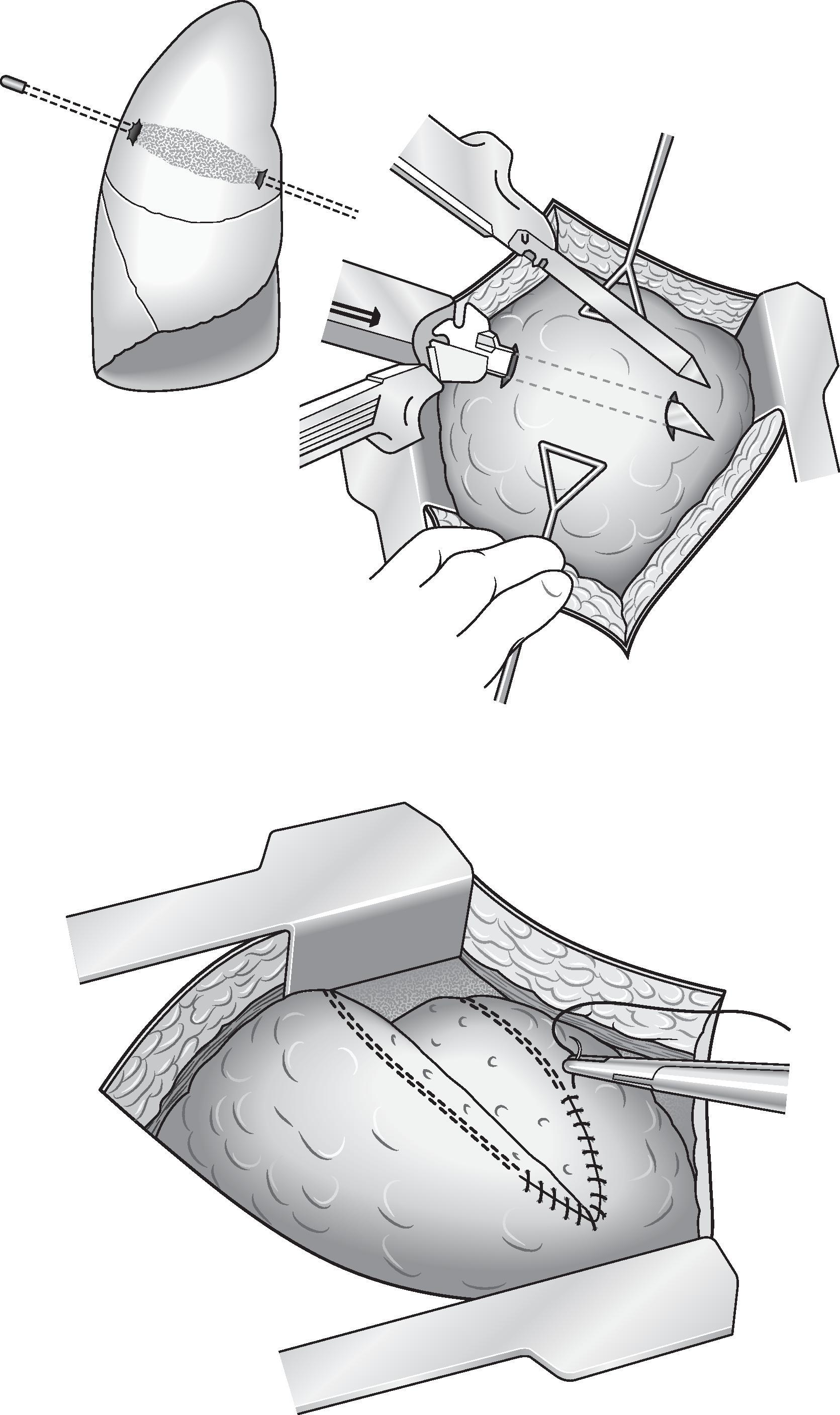

In a patient with a persistent air leak and an injury amenable to suture repair, large horizontal mattress and pledgeted sutures can be used to approximate the tissue. A stapled wedge resection may be performed by grasping the tissue to be resected with Allis clamps, elevating it, and firing a stapling device below the grasper. Multiple staple loads can be used to complete the resection if necessary. It can be tempting to just oversew lung tissue for bleeding; however, this does not resolve the issue but traps the hemorrhagic source deep in the lung, forcing the blood into the parenchyma or tracheobronchial tree leading to hemoptysis, aspiration, pneumonia, and ARDS. In this scenario, a tractotomy should be undertaken. Tractotomy opens the lung parenchyma along the tract of the injury to allow for better exposure of the bleeding vessel, which can then be directly oversewn with a 3-0 polypropylene suture; a second suture can be used to close the tractotomy after bleeding has been controlled.
If hilar bleeding is encountered after entering the chest, hilar control should be obtained expeditiously by placing a large clamp across the hilum or dividing the pulmonary ligament up to the pulmonary vein and then twisting the lung. If both lung and artery are injured, pneumonectomy may be indicated; however, the mortality after this operation in the emergent setting is extremely high at 50% to 100%. Death occurs due to acute right heart failure. Extracorporeal membrane oxygenation (ECMO) may be considered, however. If heart failure develops over several days after surgery, then medical management can be attempted, and the prognosis is slightly better.
Delayed thoracotomy for incompletely drained hemothorax will result in either resolution, infection (posttraumatic empyema), or trapped lung; therefore, VATS or thoracotomy should be considered if the patient fails chest tube drainage. Operation should include irrigation and decortication, removing all blood, fluid, and clot from the pleural space as well as peeling all fibrinous exudate off the lung and inner chest wall. Before closing, after placement of chest tubes, anesthesia should inflate the lung under direct visualization to confirm full expansion.
Management of patients who have sustained traumatic injuries, whether blunt or penetrating, isolated or multisystem, requires a team-based approach and systematic evaluation. This chapter provides an overview of managing pulmonary injuries, including pulmonary contusion, laceration, pneumatocele, pneumothorax, and hemothorax. These injuries are often associated with each other, as well as with rib fractures, cardiac injuries, and, more commonly, with blunt mechanisms, and other nonthoracic injury patterns. Discussions on incidence, anatomy, injuries, and both nonoperative and operative management strategies are included.
The abdomen remains one of the most critical and vulnerable anatomic regions in blunt trauma. Before focusing on any specific management strategy for a patient who has sustained blunt abdominal trauma, an initial assessment of the entire patient is imperative. The concept of initial assessment includes four essential components: a rapid primary survey, resuscitation, a detailed secondary survey (evaluation), and reevaluation. Integrated into primary and secondary surveys are often necessary adjunct interventions, such as electrocardiographic monitoring, arterial blood gas determination, pulse oximetry, insertion of a urinary and/or gastric catheter, and obtaining necessary x-rays and other diagnostic studies, when applicable. The management of blunt abdominal trauma continues to evolve more in the nonoperative arena. The workup has shifted largely from the use of a physical examination, plain x-rays, laboratory findings, and diagnostic peritoneal lavage to physical examination and liberal the use of computed tomography (CT) and ultrasonography. Treatment for visceral injury has traditionally been surgical. However, many forms of solid organ injury can now be successfully managed nonoperatively or with minimally invasive and interventional radiology techniques. Nonoperative management of the multiple injured trauma patient at level 1 trauma centers, with state-of-the-art techniques, has conclusively shown significantly improved patient outcomes and survival.
Diagnostic peritoneal lavage has now been essentially supplanted by the adoption of focused assessment with sonography in trauma (FAST). The utilization of diagnostic peritoneal lavage has diminished substantially. Originally described by Root in 1965, diagnostic peritoneal lavage (DPL) was once a mainstay in the management of blunt abdominal trauma for over four decades. Before the era of routine CT scanning, it was used as a screening tool to evaluate patients having blunt or penetrating abdominal trauma with an accuracy rate reported between 92% and 98%. CT and FAST are now the diagnostic modalities of choice assessment of the injured patient. However, DPL remains an excellent tool for further workup of occult bowel injury or when FAST is not available or has questionable findings. In the workup for occult bowel injury, traditional parameters ( Table 1 ) should be used to guide therapy. When FAST is not an option, a diagnostic tap is usually all that is necessary, and exploration is indicated when there is aspiration of greater than 10 mL of gross blood.
| Any Viscus | Bowel |
|---|---|
| 10 mL gross blood | Bacteria |
| >100,000 red blood cell/mm 3 | Bile |
| >500 white blood cell/mm 3 | Food particles |
| >75 IU/L amylase |
The pitfalls of DPL are a relatively high false-positive rate, risk of creating visceral injury, and poor sensitivity for detecting injury to retroperitoneal structures such as the pancreas and duodenum. Iatrogenic events are minimized if a Foley catheter and nasogastric tube are placed before the procedure. Patients with pelvic fractures and suspected retroperitoneal hematoma or pregnant females should undergo a supra-umbilical approach.
In the diagnostic assessment of the acutely injured patient, the bedside ultrasonography for detection of cardiac and intra-abdominal injury is considered the standard of care. Because focused abdominal sonography for trauma is noninvasive, this diagnostic modality allows the operator to perform an examination simultaneously during the initial resuscitation and stabilization of a multiple injured trauma patient. Due to the relative insensitivity of the abdominal examination in the severely injured patient, this technique may provide evidence of significant hemorrhage early in the course of an evaluation. An ultrasound probe is used to examine four key windows for fluid; the subxiphoid area permits visualization of the pericardium, the left subcostal area permits visualization of the splenorenal recess, the right subcostal area permits visualization of Morison’s pouch, and the suprapubic area permits visualization of the pelvic cul de sac ( Fig. 1 ). The presence of fluid may indicate cardiac tamponade, hollow viscus perforation, hemoperitoneum, or ascites. False-positive results secondary to preexisting ascites or false-negative results caused by operator error and/or body habitus are the main limitations. Scanning the suprapubic area with distension of the urinary bladder will enhance the sensitivity of the exam for the detection of pelvic fluid.
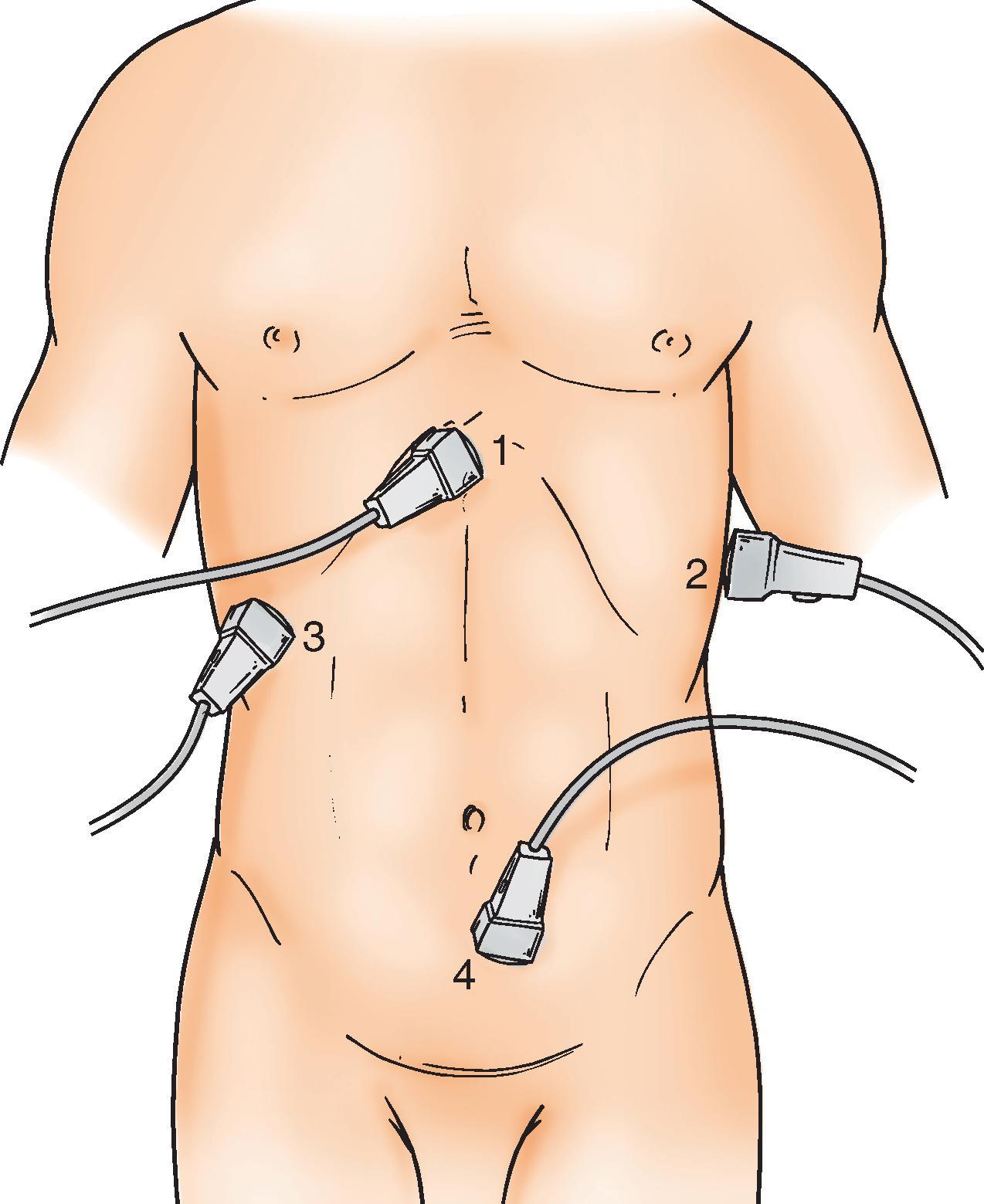
A threshold of at least 200 mL of fluid in the abdominal cavity is necessary for detection, and intraabdominal injuries must be associated with the presence of this much free fluid for a positive finding. Reported sensitivities range between 73% and 88%, and specificities range between 98% and 100%. Accuracy rates range from 96% to 98%. FAST is an inexpensive, rapid, portable, noninvasive technique that can be performed in serial fashion if there is a change in patient stability. Additionally, it obviates the risk of exposing pregnant female patients to radiation. Positive findings in stable patients can be further evaluated with CT, while unstable patients with a positive finding should prompt emergent exploration in the operating room.
Steady advances in the technology and speed of CT have continued to be an intergral part of the diagnostic management of trauma patients. Multidetector scanners have drastically improved resolution and accuracy of these imaging studies. Negative predictive values as high as 99.63% have been reported for patients sustaining significant mechanisms of blunt trauma, allowing the use of CT as a reliable and noninvasive screening tool for patients with blunt abdominal trauma. In light of modern-day CT capabilities, prospective data have demonstrated that patients with a signinficant mechanism and a benign abdomen can be released from the emergency department if a CT scan of the abdomen shows no evidence of visceral injury, provided that there are no other reasons for hospitalization.
CT reliably identifies injuries in solid organs such as the spleen, liver, and kidney because of the associated vascular nature demonstrating disruption of normal architecture, associated free fluid, and the so-called vascular blush. Established grading scales continue to be used for accurate classification and determination of management ( Tables 2–4 ).
| Grade * | Injury Description | |
|---|---|---|
| I | Hematoma | Subcapsular, <10% surface area |
| Laceration | Capsular tear, <1 cm parenchymal depth | |
| II | Hematoma | Subcapsular, 10%–50% surface area; intraparenchymal, <5 cm in diameter |
| Laceration | 1–3 cm parenchymal depth that does not involve a trabecular vessel | |
| III | Hematoma | Subcapsular, >50% surface area or expanding; ruptured subcapsular or parenchymal hematoma |
| Laceration | Intraparenchymal hematoma >5 cm or expanding >3 cm parenchymal depth or involving trabecular vessels | |
| IV | Laceration | Laceration involving segmental or hilar vessels producing major devascularization (>25% of spleen) |
| V | Laceration | Completely shattered spleen |
| Vascular | Hilar vascular injury that devascularizes spleen |
| Grade * | Injury Description | |
|---|---|---|
| I | Hematoma | Subcapsular, <10% surface area |
| Laceration | Capsular tear, <1 cm parenchymal depth | |
| II | Hematoma | Subcapsular, 10%–50% surface area; intraparenchymal, <10 cm in diameter |
| Laceration | 1–3 cm parenchymal depth, <10 cm in length | |
| III | Hematoma | Subcapsular, >50% surface area or expanding; ruptured subcapsular or parenchymal hematoma |
| Laceration | Intraparenchymal hematoma >10 cm or expanding >3 cm parenchymal depth | |
| IV | Laceration | Parenchymal disruption involving 25%–75% of hepatic lobe or 1–3 Couinaud segments within a single lobe |
| V | Laceration | Parenchymal disruption involving >75% of hepatic lobe or >3 Couinaud segments within a single lobe |
| Vascular | Juxtahepatic venous injuries (i.e., retrohepatic vena cava/central major hepatic veins) |
|
| VI | Vascular | Hepatic avulsion |
| Grade * | Injury Description | |
|---|---|---|
| I | Contusion | Microscopic or gross hematuria, urologic studies normal |
| Hematoma | Subcapsular, nonexpanding without parenchymal laceration | |
| II | Hematoma | Nonexpanding perirenal hematoma confined to renal retroperitoneum |
| Laceration | Parenchymal depth of renal cortex (>1.0 cm) without urinary extravasation | |
| III | Laceration | Parenchymal depth of renal cortex (>1.0 cm) without collecting system rupture or urinary extravasation |
| IV | Laceration | Parenchymal laceration extending through the renal cortex, medulla, and collecting system |
| Vascular | Main renal artery or vein injury with contained hemorrhage | |
| V | Laceration | Completely shattered kidney |
| Vascular | Avulsion of renal hilum that devascularizes kidney |
* Advance one grade for bilateral injuries, up to grade III. Modified from Moore EE, Shackford SR, Pachter HL, et al. Organ injury scaling: spleen, liver, and kidney. J Trauma . 1989;29:1664.
Detection of bowel injury via CT in patients who are intoxicated, are intubated, or have associated closed head injury or other distracting injuries can present a diagnostic challenge in the absence of a reliable abdominal exam. The incidence of blunt bowel injury varies from series to series but is generally reported in the 1% to 5% range in all blunt trauma patients admitted to level 1 trauma centers. A high index of suspicion is predicated on mechanism of injury and physical exam findings, such as abdominal wall ecchymosis, tattooing, and/or seat belt sign. CT findings may be overt, such as extravasation of oral contrast or pneumoperitoneum, or more commonly subtle, such as bowel wall thickening, stranding of the mesentery, or free fluid in the absence of solid organ injury. Indirect findings may be fairly nonspecific and secondary to bowel edema from resuscitation or preexisting ascites. Reproductive-age females may have a small amount of normal or “physiologic” pelvic fluid present, sometimes adding to the complexity of the evaluation. Patients on positive pressure ventilation or with significant barotrauma may develop mediastinal or subcutaneous emphysema that can track through the peritoneum or retroperitoneum and give the appearance of free air. Great care in the radiologic interpretation and close clinical correlation are necessary in such cases. The liberal use of diagnostic modalities (e.g., abdominal CT) in the hemodynamically normal injured patient may prevent nontherapeutic laparotomies. Obviously, when significant doubt remains, abdominal exploration may be required to confirm an injury.
The role of oral contrast in the evaluation of the acutely injured patient has recently come into question. Little time is usually available in the emergency setting to permit adequate opacification of the small bowel. Patients are further at risk for aspiration of the contrast media, and administration often requires placement of a nasogastric tube. There have been several reports that have shown that elimination of oral contrast media does not lead to an increased incident of missed bowel injury. Many centers have now safely eliminated the use of oral contrast media from their routine trauma protocols, expediting management and ease of patient care. Resuscitation edema may cause a hazy appearance around the head of the pancreas and duodenal c-loop, raising the question of a pancreas or duodenal injury. Further clarification in this situation can be obtained when it occasionally occurs via repeat CT scan with the administration of oral contrast and the injection of 300 to 500 mL bolus of air down the nasogastric tube to make pneumoperitoneum obvious.
CT may also be of great importance in identifying patients with arterial hemorrhage related to pelvic fracture. CT imaging may demonstrate an arterial blush or large hematoma in the vicinity of a pelvic fracture, indicating the need for pelvic arteriography, pelvic packing, or pelvic external fixation. A “CT cystogram” may also be helpful and eliminate redundancy of x-ray evaluation. The Foley catheter is clamped after placement in the trauma bay. Real-time interpretation of the CT scan is performed by the evaluating physician, which may dictate further delayed images or a formal cystogram.
Although CT can be an important diagnostic modality in the assessment of the trauma patient, it is contraindicated in the hemodynamically unstable patient who is in shock.
There is no place for nonoperative management of hollow viscus injury, and the nemesis of nonoperative management of blunt abdominal trauma is therefore the missed bowel injury and all of its catastrophic consequences. Otherwise, most management is straightforward and involves debridement and primary repair for nondestructive injuries and resection with primary repair versus stomal formation for destructive injuries.
There are two basic types of findings of bowel injury on CT scan: direct and indirect. Direct findings are usually straightforward if present and amount to extravasation of oral contrast (if administered) and free air, which have been reported to occur 4% and 28% of the time, respectively. Indirect findings include mesenteric hematoma or contrast blush, bowel wall edema, unexplained free fluid, “fat streaking,” and bowel loops that do not opacify with intravenous contrast.
Mesenteric hematoma is nonspecific and can occur from associated injuries, such as pelvic fractures or renal injuries, with hematomas from these structures expanding into the bowel mesentery. However, a vascular blush in the leaves of the mesentery is indicative of active hemorrhage until proven otherwise and is a general determinant for immediate operative exploration. Bowel wall edema and ascites are common in blunt trauma patients, can occur from resuscitation of other injuries, and do not necessarily connote bowel injury. Free fluid in the absence of solid organ injury can be further evaluated with DPL or diagnostic peritoneal aspiration (DPA) if the abdominal exam is unreliable. Fat stranding can occur with mesenteric contusion and does not necessarily portend an operative indication. Unopacified bowel loops can indicate vascular disruption of the mesentery or simply result from poor contrast timing in an underresuscitated patient. These findings increase the likelihood of finding an injury at exploration, and multiple findings enhance the evidence of identifying a bowel injury.
Appreciation of the American Association for the Surgery of Trauma (AAST) organ injury grading scale is helpful in describing wounds of the bowel. Grade I injuries are contusions and partial-thickness lacerations of the bowel wall without perforation. Grade II injuries are full-thickness wounds involving less than 50% of the bowel wall circumference. Grade III injuries are lacerations involving greater than 50% of the bowel wall circumference without complete transection. Grades IV and V injuries represent complete transection of the bowel wall and transection with segmental tissue loss and/or devascularization of the mesentery, respectively. The terms destructive and nondestructive simplify the terminology; nondestructive wounds are injuries that can be managed with debridement and primary-suture enterorrhaphy and are classified as grades I and II. Destructive wounds require resection of an entire segment of the bowel as a result of loss of bowel integrity or devascularization of the mesentery and are classified as grades III to V ( Tables 5 and 6 ).
| Grade * | Type of Injury | Description of Injury |
|---|---|---|
| I | Hematoma | Contusion or hematoma without devascularization |
| Laceration | Partial thickness, no perforation | |
| II | Laceration | Laceration <50% of circumference |
| III | Laceration | Laceration ≥50% of circumference without transection |
| IV | Laceration | Transection of the small bowel |
| V | Laceration | Transection of the small bowel with segmental tissue loss |
| Vascular | Devascularized segment |
| Grade * | Type of Injury | Description of Injury |
|---|---|---|
| I | Hematoma | Contusion or hematoma without devascularization |
| Laceration | Partial thickness, no perforation | |
| II | Laceration | Laceration ≤50% of circumference |
| III | Laceration | Laceration >50% of circumference |
| IV | Laceration | Transection of the colon |
| V | Laceration | Transection of the colon with segmental tissue loss |
The distinction between destructive and nondestructive wounds is important in terms of the prescribed management. Nondestructive wounds of the large or small bowel can generally be repaired without further consideration. Most small bowel destructive injuries should be resected and reconstituted unless damage control conditions prevail. In contrast with the small bowel, the management of colon injuries has received great scrutiny. Ushering in the dawn of modern day trauma surgery, the World War II military experience dictated that all colon wounds, destructive or not, be managed by colostomy. This philosophy remained surgical dogma until the 1980s. In a comprehensive review of the literature since 1979, primary repair of the colon for nondestructive wounds was shown to have a leak rate of 1.6%. Compared with patients receiving colostomy for similar types of wounds, the incidence of intraabdominal abscess was 4.9% for primary repair and 12% for colostomy, and the overall complication rate was 14% for primary repair and 30% for colostomy. Mortality rates were similar, at 0.11% for primary repair and 0.14% for colostomy. These findings clearly show the superiority of primary repair for nondestructive wounds of the colon.
Several risk factors for anastomotic failure pertaining to destructive colon injury have been addressed in the literature: hypotension, shock, interval from injury to operation, amount of fecal contamination, associated organ injury, transfusion requirement, and comorbid disease. No data have conclusively shown that any of these risk factors increase the likelihood of anastomotic failure. Patients with massive blood loss or shock may be better served by undergoing a damage control procedure, with delay of definitive repair. An interval from injury to repair greater than 12 hours can be a relative contraindication to definitive repair if there is widespread (greater than one quadrant) fecal contamination. Greater than one or two organ system injuries has been a concern, but this may just be a marker for degree of shock and overall physiologic derangement. Comorbidities, such as AIDS and cirrhosis, deserve special consideration, and these patients may be better off with the establishment of an ostomy. Patients with any of these risk factors have a higher incidence of intraabdominal abscess and overall complication rates.
Notwithstanding the caveats of the previously mentioned comorbidities, colonic resection and primary anastomosis for destructive wounds would be permissible in most trauma settings. In a collective review of 207 patients reported in the literature, management of destructive bowel injury with resection and primary anastomosis had a reported leak rate of 7.2%, with a mortality rate of 1.7% attributable to the colon wound. In the largest single-institution experience, Murray showed a leak rate of 11% in 112 patients undergoing resection and primary anastomosis for destructive colon wounds, with two deaths related to leaks. However, the ultimate decision for the choice of operation should be up to the discretion of the surgeon, at the time of operation, and on a case-by-case basis.
At laparotomy, the bowel should be examined in its entirety after all other sources of major bleeding are controlled. Small injuries should be noted and tagged with an identifiable suture for easy reference. Larger wounds contributing to ongoing soiling can be temporarily controlled with a “whip stitch” (quick running suture) or Babcock clamps. Mesenteric injuries are identified, and active bleeding is controlled appropriately. Attention should be directed to the location of the superior mesenteric artery for injuries encroaching on the root of the mesentery. Mesenteric hematomas should be explored with ligation of injured vessels and mesenteric defects closed by careful reapproximation of the peritoneal edges so as not to compromise any associated vasculature. Bowel viability should be noted in relation to any mesenteric injury. Clusters of grade I and II injuries may be resected or individually repaired depending on the particular injury pattern. In blunt trauma, there is usually only one or two grade I or II wounds that can be repaired primarily or one or more devitalized segments that require resection.
Small, superficial grade I injuries can be left alone while deeper, longer grade I injuries can be closed with a simple running suture or interrupted Lembert sutures. Grade II wounds should be debrided back to healthy, viable bowel and closed transversely to prevent narrowing of the lumen of the bowel. Single-layer running or interrupted closure is generally sufficient for repair of the small bowel. When there is significant bowel wall edema, peritonitis, or soiling, a two-layer closure with a running inner layer and interrupted Lembert outer layer may be preferential. Grade I colon wounds may be managed with single-layer closure. However, grade II colon wounds should be closed in two layers for added protection.
The leak rate associated with stapled versus hand-sewn anastomosis for destructive wounds of the bowel has been an area of ongoing controversy. In two retrospective studies totaling 284 patients undergoing stapled versus hand-sewn anastomosis, Brundage showed that hand-sewn procedures had lower leak rates. Two other retrospective studies totaling 484 patients showed no difference in the leak rate of stapled versus hand-sewn procedures. Brundage’s two studies included 78 colon wounds, while the other studies were confined only to the small bowel. Stapled procedures may be a little quicker, particularly if there is more than one anastomosis. In general, the technique chosen according to the literature can be a matter of surgeon preference. However, with edematous bowel, the hand-sewn technique is a more prudent approach.
The spleen is the most commonly injured intraabdominal organ, followed by the liver and small bowel in blunt trauma patients. The spleen’s location in the left upper quadrant lends susceptibility to injury from broken ribs, deceleration, and blunt percussion forces. Clinically, patients with splenic injury may present with hypotension, left upper quadrant pain or tenderness to palpation, or diffuse peritonitis from extravasated blood. Referred pain to the left shoulder on deep inspiration in face of splenic hematoma is known as Kehr’s sign.
Most series indicate that approximately 60% to 80% of patients presenting with blunt splenic injury can be managed nonoperatively at level 1 or 2 trauma centers. Facilities without the resources and experience of a bona fide trauma team may not safely meet the demands of nonoperative management and should consider patient transfer. Patients selected for nonoperative management must have normal vital signs, be free from peritoneal signs or other concern for hollow viscus injury, and have no evidence of free extravasation of intravenous contrast from the splenic parenchyma ( Fig. 2 ).
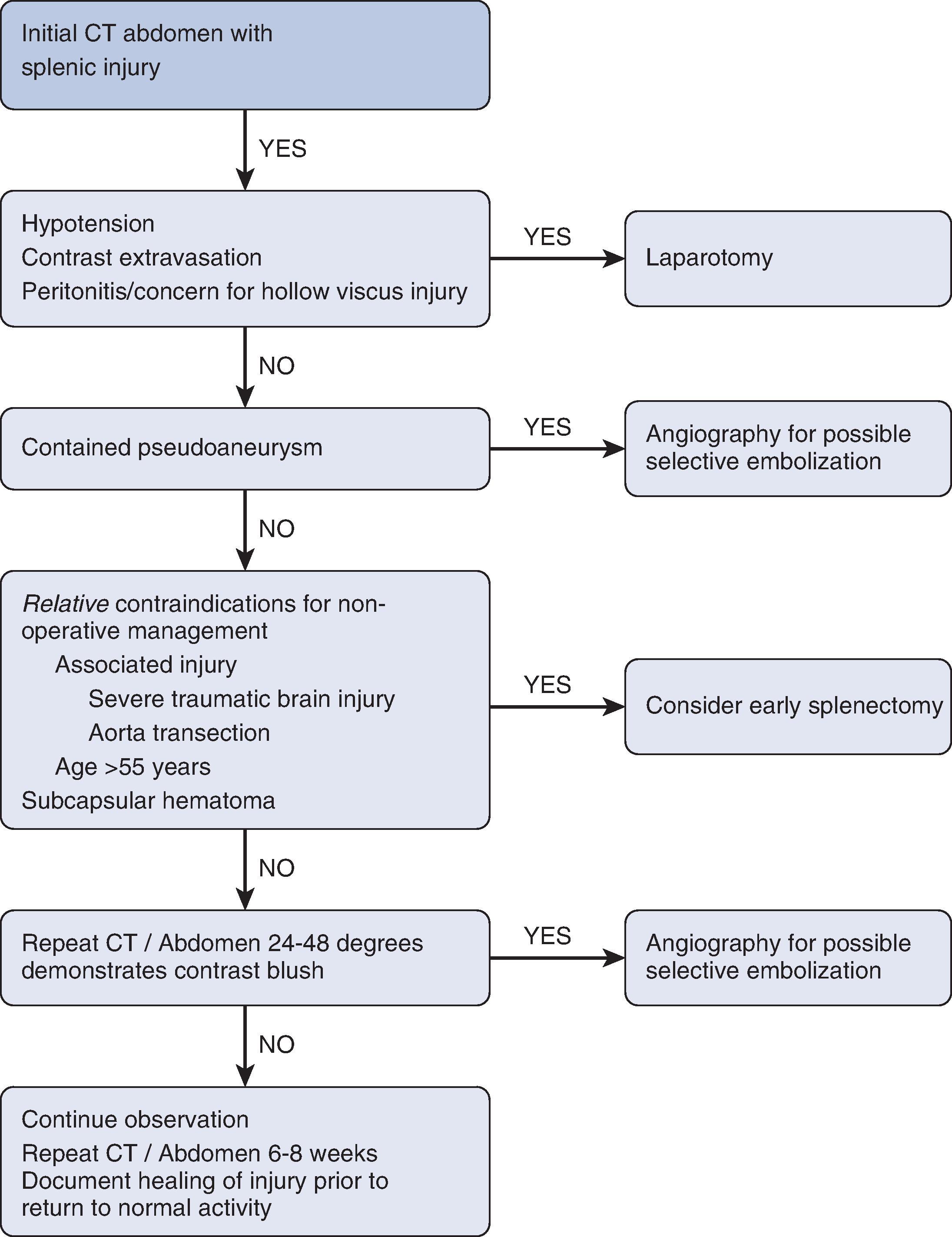
Considerable debate remains regarding risk factors for failure of nonoperative management. Higher AAST splenic injury grade, age greater than 55 years, moderate to large hemoperitoneum, subcapsular hematoma, and portal hypertension have all been suggested to increase the risk of failure. Early reports in the evolution of nonoperative management regarding AAST grade did not demonstrate higher failure rates for higher grade injury. More recent reports using high resolution multidetector CT scanners allow better assessment of injury grade. The data from these studies show that patients with injury grades III to V are at increased risk for nonoperative failure. Age continues to be a controversial subject matter in the literature, with numerous reports claiming that age greater than 55 years is or is not a risk factor for failure. Documentation of a moderate or large hemoperitoneum is suggestive of a major injury and should be considered a significant factor in individual patient assessment.
Patients with a splenic subcapsular hematoma or a history of portal hypertension are specific subgroups of patients that deserve special consideration. These patients are at increased risk for delayed rupture 6 to 8 days following injury and may already be discharged from the hospital if they have isolated injury. Furthermore, splenic embolization is not a very effective treatment of this condition because it usually necessitates coiling of the main splenic artery, which can lead to significant pain and abscess formation. History of portal hypertension or cirrhosis, while not absolute contraindications to nonoperative management, certainly should serve as a caveat. The general risks of laparotomy in Child-Pugh B or C cirrhosis must be carefully weighed against the risk of ensuing and worsening coagulopathy. This scenario may, indeed, dictate the need for splenic artery embolization. None of these risk factors alone should dictate the decision to proceed immediately to operative intervention. Nonoperative management does reduce hospital length of stay and transfusion requirement; however, the morbidity of splenectomy should remain low in any surgeon’s hands. Overall, the patient’s condition, including comorbidities, coagulopathy, and other problems (such as traumatic brain injury, aortic injury, and suspicion for concomitant hollow viscus injury) factor into the decision-making process. Patients undergoing nonoperative management should never succumb to splenic hemorrhage.
Approximately 20% of patients initially undergoing nonoperative management of blunt splenic injury require further intervention. Failure has been associated with the presence of a contrast blush in up to two-thirds of these patients. The presence of a contained contrast blush within the parenchyma of the spleen represents pseudoaneurysm formation of a branch of the splenic artery. Angioembolization is now commonly used to selectively occlude the arterial branches containing these injuries. Implementation of this salvage technique at centers that routinely screen for the presence of pseudoaneurysm has increased the success of nonoperative management to 90% or greater. Pseudoaneurysm formation has been observed in even grade I and II injuries and may not be present on initial imaging.
Long-term data are unavailable concerning the risk of outpatient or delayed rupture, but the incidence is low and has been reported to be about 1.4%. The average date to readmission for delayed splenectomy after discharge was 8 days in this study. Lower-grade (I, II) injuries tend to heal more quickly, and almost all injuries are healed by 5 to 6 weeks. However, approximately 20% of blunt splenic injuries will not show complete healing and may be at risk for pseudocyst formation. A CT scan should be repeated in 6 weeks for grades I and II injuries and 10 to 12 weeks for grades III to V injuries before allowing patients to return to normal activity.
Patients requiring urgent or emergent intervention for splenic hemorrhage may develop hypothermia, coagulopathy, and visceral edema. The most expeditious and safest course of action under these conditions is removal of the spleen. The general assumption of abdominal exploration for trauma is that there are known and, possibly, unknown injuries. The operative approach is via a midline vertical incision that allows the best exposure and facilitates temporary abdominal closure should visceral edema or damage control measures be necessary.
With respect to performing a splenectomy, an OMNI retractor can be used to expose the left upper quadrant. The spleen is retracted medially, with some downward compression, while taking down the posterior attachments with the cautery. Once these attachments are freed, the spleen can be mobilized medially for optimal exposure. The assistant stands on the left side of the table and supports the spleen while the surgeon ligates short gastric and hilar vessels. Being careful to avoid the tail of the pancreas, a large clip, placed on the specimen side of the splenic hilum, will reduce back-bleeding and expedite the procedure. Once the spleen has been removed, the splenic fossa is meticulously inspected for further bleeding with a rolled laparotomy pad.
Hemodynamically stable patients found to have small to moderate amounts of parenchymal hemorrhage, at laparotomy, may be candidates for splenic preservation. The spleen is mobilized into the wound using the same technique as for splenectomy. The injury to the spleen is assessed, and a decision is made whether to resect a portion if the parenchymal injury extends into the hilum or if arterial bleeding is coming from within the splenic laceration itself. If the decision is made to resect the upper or lower pole, the parenchyma is divided with the cautery, and the associated hilar vessels are taken with clamps and ties. Any arterial bleeding from the parenchyma is controlled with suture ligature, and the cautery is used to control oozing from the parenchyma. A tongue of omentum is then sutured into the laceration or to the raw surface of the remaining spleen in the case of a partial splenic resection. Approximately 50% of the spleen is required to preserve adequate phagocytic and immunologic function. If this cannot be achieved, a splenectomy is probably the best option.
The incidence of overwhelming post-splenectomy infection (OPSI) following trauma is not well understood because it may not be appreciated when it occurs, along with the fact that it is not routinely reported. However, the reported incidence of OPSI in adult patients undergoing splenectomy for all causes is 0.9% with a mortality of 0.8%. The risk of OPSI in adults following trauma is felt to be lower than the incidence seen after splenectomy for hematologic disorders such as immune thrombocytopenia, lymphoma, and thalassemia. Children are at greater risk for OPSI and should receive prophylactic penicillin V 125 mg twice daily until 3 years of age and then 250 mg twice daily until 5 years of age. Currently, anyone older than 2 years of age should receive the 23-valent pneumococcal vaccine and a one-time dose of the H. influenza and meningococcal vaccine. A one-time booster dose of the pneumococcal vaccine is recommended 5 years after the original vaccine.
Blunt trauma contributes over 75% of the mechanisms of injury for most trauma centers in the United States. The liver, the largest solid organ in the body, is one of the most frequently injured abdominal organs by either blunt or penetrating mechanisms. Fortunately, the majority of hepatic injuries are low-grade injuries and require no surgical repair ( Table 7 ). Suspicion of liver injury is predicated on several factors including clinical suspicion derived from the mechanics of the crash, hemodynamic state of the patient, and findings obtained during abdominal examination ( Fig. 3 ). High-energy crashes involving application of force to the upper abdomen or to the right thoracoabdominal area should arouse immediate suspicion of a possible hepatic injury. Hemodynamic lability, although not an exclusive feature of liver injury, mandates evaluation to exclude it as the source of the hemorrhage. Tenderness in the right upper quadrant, in the absence of other signs, can be suggestive of subcapsular hematoma requiring attention and further evaluation. Unfortunately, the physical examination is not perfect and has a false-positive rate of approximately 50% and a false-negative rate of 40%.
| Grade | Type of Injury | Description of Injury |
|---|---|---|
| I | HematomaLaceration | Subcapsular, <10% surface areaCapsular tear, <1 cm parenchymal depth |
| II | HematomaLaceration | Subcapsular, 10%–50% surface areaIntraparenchymal <10 cm in diameterCapsular tear 1–3 parenchymal depth, <10 cm in length |
| III | HematomaLaceration | Subcapsular, >50% surface area of ruptured subcapsular or parenchymal hematoma; intraparenchymal hematoma >10 cm or expanding>3 cm parenchymal depth |
| IV | Laceration | Parenchymal disruption involving 25%–75% hepatic lobe or 1–3 Couinaud segments |
| V | LacerationVascular | Parenchymal disruption involving >75% of hepatic lobe or >3 Couinaud segments within a single lobeJuxtahepatic venous injuries, (i.e., retrohepatic vena cava/central major hepatic veins) |
| VI | Vascular | Hepatic avulsion |
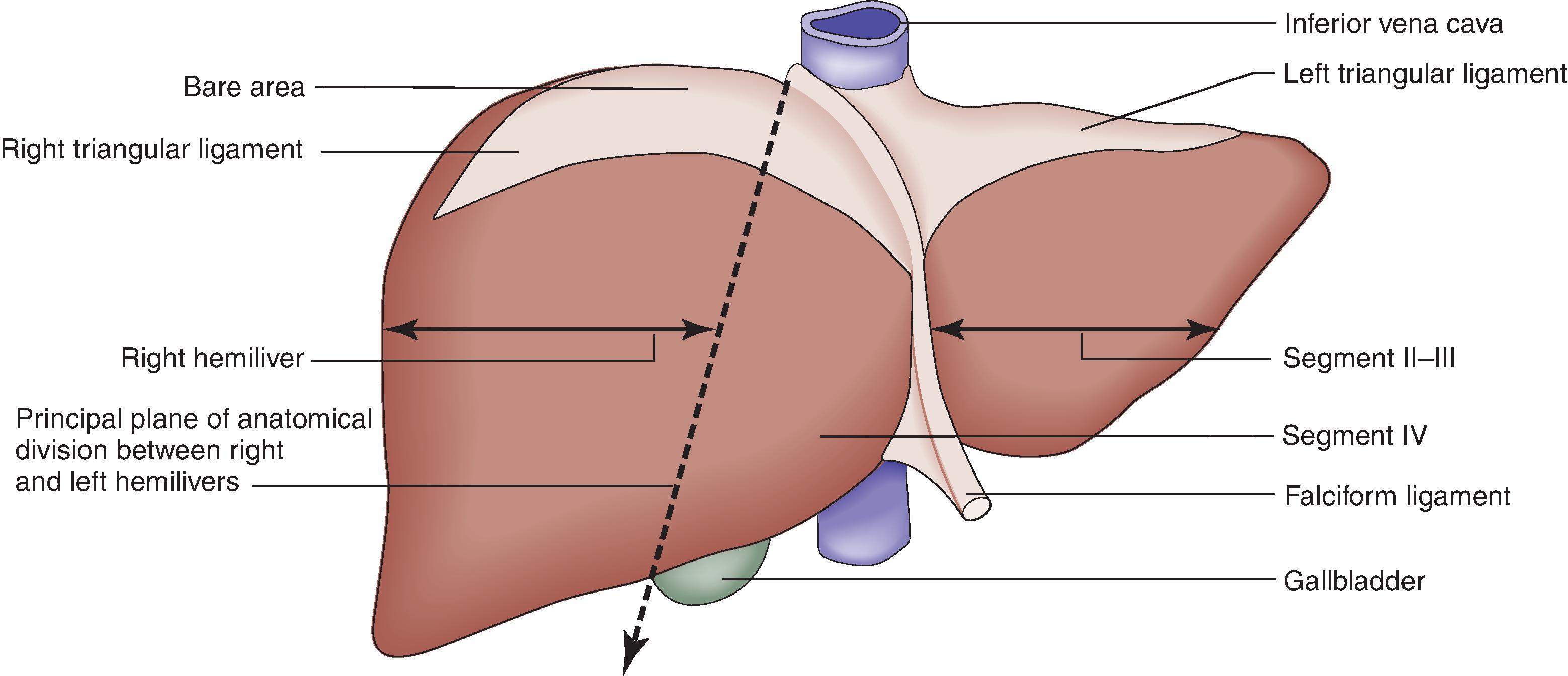
The additional methods available to evaluate the abdomen include FAST, CT, and diagnostic peritoneal lavage. FAST has become a highly reliable test used when seeking to determine whether there is blood in the abdomen in a patient who is hemodynamically labile. In the stable patient in whom liver injury is suspected, the use of CT has become widespread. Several classification schemes have been described for liver injuries, but the grading scheme proposed by the AAST is now in wide use (see Table 7 ).
With hepatic injuries, the paramount decision is to determine if and what intervention is needed to control hemorrhage. Hemodynamic instability mandates expeditious operative management or angiography/embolization (if the patient can be stabilized with volume resuscitation to make transportation to the radiographic suite less risky for the patient). The hemodynamically stable patient may be evaluated by any of the methods noted earlier. Minor grade I or II injuries frequently require no operative intervention. When diagnosing by CT scan, the surgeon must be cognizant of the magnitude and anatomy of the liver injury. Contusion contained within the liver capsule or minor laceration, such as in grade I or II injuries, may be observed. These diagnoses together constitute most liver injury cases, accounting for 60% to 70%. Grade III injuries (deeper, larger wounds with more tissue destruction) occur in approximately 25% of cases. Grade IV and V injuries, involving large amounts of tissue destruction, have an incidence of 7% and 3%, respectively, and they are highly lethal. It should be emphasized that evidence of blood in the peritoneal paracolic gutters, in the pelvis, or tracking along the periportal triads is suggestive of a more significant injury than the liver anatomy may indicate. Also, the concomitant existence of hollow viscous injury occurs in 5% to 20% of major hepatic injuries, which mandates exploration.
In addition, it is important to realize that massive parenchymal injuries can occur with surprisingly little bleeding and that minor lacerations may bleed profusely. An understanding of the tissue architecture of the liver is a prerequisite to successful management. Most blunt lacerations may occur along segmental fissures because the vascular and biliary duct structures are moderately shear resistant. This explains why a large stellate or “bear claw” laceration may be seen, with little or no intraperitoneal blood in a hemodynamically stable patient. This can be managed nonoperatively with observation. Nonoperative treatment of the stable patient sustaining a blunt liver injury is the management approach of choice today. Table 8 highlights the reported failure rates for nonoperative management of hepatic trauma.
| Study (Yr) | Number of Patients | Immediate Surgery (%) | Overall Failure Rate (%) | Liver Failure Rate (%) | Other Failure Rate (%) | |||||
|---|---|---|---|---|---|---|---|---|---|---|
| Meredith (1994) | 116 | 48 | 3 | 3 | 0 | |||||
| Croce (1995) | 136 | 18 | 11 | 5 | 6 | |||||
| Pachter (1996) | 404 | 53 | 1.2 | 0.7 | 0.5 | |||||
| Malhotra (2000) | 661 | 15 | 7 | 3 | 4 | |||||
| Velmahos (2003) | 78 | 29 * | 15 | 0 | 15 | |||||
| Christmas (2005) | 561 | 32 † | 1.8 | 0.4 | 1.4 |
Conversely, the deceleration forces are responsible for a shear effect that can result in avulsion of the hepatic veins from the vena cava or major branches of the portal venous or hepatic venous systems. Hemorrhage is devastating, difficult to control, and responsible for the high mortality rate seen with such injuries.
Once the decision to operate has been made, the surgeon must proceed in an orderly fashion to a fully equipped operative theater that includes the capabilities of invasive monitoring. Before opening the abdomen, the surgeon must ensure that there is optimal venous access. Large-bore central access is essential. The prudent, historic dictum is that access should be from the upper torso in the event there is a retrohepatic caval injury. The blood bank must be notified of the potential for massive transfusion of packed cells and blood components to treat the often associated coagulopathy. The development of blood salvage systems has greatly improved the care of these patients; shed blood from the operative field can be washed and reinfused, provided there is no evidence of gastrointestinal contamination. Infusion systems are available that allow rapid delivery of large volumes of warmed fluid to help minimize hypothermia and hypovolemia. Hypothermia is a common cause of coagulopathy and must be aggressively defended against. Invasive monitoring capabilities are essential in the management of these critically injured patients.
Optimal surgical exposure is essential and starts with performing a midline vertical incision for expedient entry into the abdominal cavity. The incision should extend from the xiphoid process to the symphysis pubis. Such an approach allows, if necessary, relatively easy extension into the thorax through either a median sternotomy or a lateral thoracotomy.
Performing a celiotomy could potentially decompress the tamponade, thereby necessitating expeditious vascular control. The need to perform an emergency thoracotomy for vascular control of the aorta before opening the abdomen is rarely indicated. Such control of the bleeding can usually be obtained with the assistant’s manual compression of the liver.
Once the abdomen is open, a rapid assessment of the injury is made and priority management begun. All clots are evacuated, and the four quadrants are packed to control bleeding. A sequential examination is then carried out with priority given to control of blood loss followed by control of any enteric content spillage.
The general approach to the liver injury requires adequate visualization of the anatomic features of the injury. This may require mobilization of the liver along the falciform and triangular ligaments. Full mobilization of the liver allows delivery onto the abdominal wall that can often facilitate suture repair of a hepatic wound in a difficult area. When mobilizing the liver, care must be taken that the hepatic veins are not injured. The coronary ligaments are in close proximity to the hepatic veins. Also, the surgeon must be cautious during the mobilization of the liver that venous return through the vena cava is not obstructed for a prolonged period. Hemorrhage control during mobilization can often be done by the assistant’s applying direct pressure with laparotomy packs, compressing the liver between the hands.
As noted previously, most of the injuries encountered are grade I or II and require little more than simple suture repair. Grades III, IV, and V injuries require an organized approach for successful control of hemorrhage, which includes manual compression, direct ligation, or clipping of lacerated vessels, along with sophisticated techniques for more complex wounds.
Vascular occlusion of the portal triad (performing the Pringle maneuver) is a useful method of controlling hepatic arterial and portal venous inflow to the liver. A noncrushing or vascular clamp can be applied to the porta hepatis and safely left in place for approximately 45 minutes, although the specific duration threshold is not known for the hemodynamically labile patient. Also, an umbilical tape placed around the porta hepatis structures can be used for such control. If this maneuver markedly reduces the liver’s bleeding, the parenchymal injury can be assessed and a method of repair decided on. However, if hemorrhage persists, then an intrahepatic portal vein injury or a major hepatic vein injury must be suspected.
Proceeding with hepatotomy for localization and control of hemorrhage requires fastidious cooperation between the surgeon and the first assistant. With the depth of the hepatic wound exposed, it is usually the first assistant who controls the bleeding. The finger-fracture technique for hepatotomy, with the first assistant compressing the liver, is very effective. The operating surgeon using the fingertips or the handle of a scalpel to separate the liver parenchyma and the assistant using a multiple loaded clip applier, made popular for laparoscopic cholecystectomy, ligate severed vessels. Nonabsorbable suture ligation can also be performed to control vessels as each is encountered. Knowledge of the anatomy of the liver (along with reported anatomic variants) is a prerequisite to this approach. The confluence of the left and middle hepatic veins must be kept in mind to avoid overzealous ligation ( Fig. 4 ). Likewise, the position of the inferior vena cava and the hepatic veins to the caudate lobe should be noted to avoid unnecessary injury that may complicate the surgical management. The placement of random deep sutures is fraught with difficulty. Failure of the above-mentioned maneuvers to control hepatic bleeding means that the surgeon either has not adequately identified the source or is dealing with coagulopathic bleeding (or both).
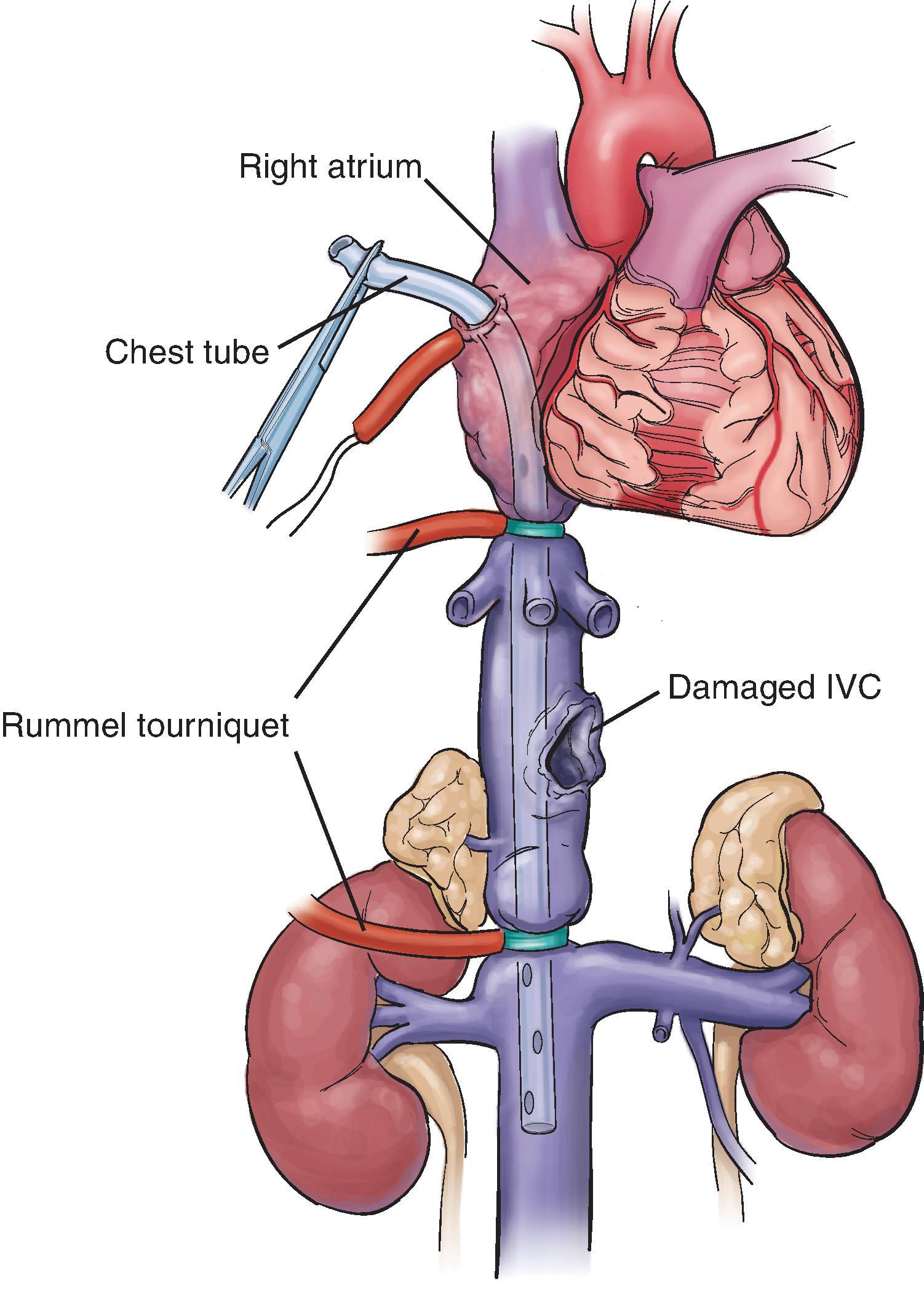
Although specific ligation of the hepatic artery or portal vein branch supplying a specific portion of the liver is rarely needed, the suspected branch should be isolated, and its occlusion should control hemorrhage while the Pringle maneuver is released. If such is the case, then the identified branch should be ligated.
Being able to perform a tractotomy of a missile wound should be in a surgeon’s armamentarium when dealing with penetrating hepatic injury. In addition, a variety of methods designed for tamponade of the bleeding missile tract have been described, using various materials. Bluett et al. described a tamponade device with multiple Penrose drains dragged through the liver tract. However, it is more preferable to open the liver and suture or clip-control the bleeding site directly, if possible.
Liver injury infrequently follows the anatomic lines of demarcation delineating the right and left lobes, much less the segments. Anatomic resection, a once popular approach, is associated with high mortality rates. This technique has been essentially abandoned. Resectional debridement of a devitalized liver is not a formal lobectomy but rather a completion of the injury to remove nonviable hepatic tissue and to facilitate vascular control. This usually entails a degree of finger fracture through uninjured liver, which allows visualization of the bleeding raw surface and more direct control. Application of specific liver clamps designed to aid in lobectomy, such as the Lin clamp, is difficult because of positioning of the injury laceration and maneuvering around the clamp.
Once the bleeding has been controlled, the large, raw surface of the liver can be problematic, as persistent oozing of bile or blood continues. A viable omental patch sutured to the liver bed is an excellent homeostatic agent and internal drain. Stone and Lamb popularized the omental pack in their initial report. Fabian and Stone reported 90% successful hemostatic control with this procedure. For large, raw liver surfaces resulting from debridement or tractotomy, the omental patch held in place with several liver sutures is an excellent hemostatic agent. Also, utilization of the argon beam coagulator is another option in addressing bleeding of raw liver surfaces. The argon gas removes the blood from the hepatic tissue, and ionizing energy is transmitted. A maximum of 110°C is achieved, and an eschar is formed.
An alternative to surgical repair of the injured liver is a mesh wrap intended to provide compression, to control bleeding, and to close parenchymal defects. Delaney et al. reported success in six liver injuries controlled in this manner. Brunet et al. reported 35 liver injuries wrapped for control. Sequential CT examination of the patients demonstrated progressive restoration of normal liver architecture.
The premise underlying much of the preceding discussion is that liver bleeding can be controlled. However, even when advanced techniques of liver control are used, hemorrhage control can be precarious, at best. A critical error that can be made when dealing with major liver injury is to continue operative intervention in the face of a hypothermic (less than 32°C), acidotic patient who has developed coagulopathy. Although the specific time to make a decision to pack the liver and restore normothermia and coagulation factors is not always clear, the operating surgeon should always have a low threshold to incorporate packing and prepare the patient to be expeditiously transferred to the intensive care unit for aggressive resuscitation and monitoring or to the angiography suite for angioembolization. Once a patient has required a 10-U transfusion, packing should be seriously considered. Patients with severe injuries, hypothermia, refractory hypertension, coagulopathy, and acidosis need early packing. It must be emphasized that large-vessel bleeding must be controlled before packing can be effective.
Perihepatic packing was popularized during World War II. The high incidence of complications plus the advent of more sophisticated techniques for control of liver bleeding led to the demise of packing until its revival in the 1970s. The major indications for perihepatic packing were postrepair coagulopathy that developed or an extensive subcapsular hematoma or capsular avulsion. They reported a 57% survival rate in their series. It is also a valuable adjunct to resectional debridement and tractotomy. The use of a folded, disposable plastic drape is helpful. It is placed against the liver, and the packs are placed on it to prevent the laparotomy pads from adhering to the liver and possibly minimize the recurrent bleeding on removal of the packs. Gauze packs are then placed to compress the liver. The packs should be placed at both the superior and inferior surfaces of the liver. The packing should be tight enough to control the bleeding but not so tight that it unnecessarily compresses the renal vessels and possibly the inferior vena cava, resulting in intraabdominal hypertension. Patients who have undergone packing will require continued sedation with mechanical ventilation until pack removal because of the interference of optimal diaphragmatic movement. Abdominal wall closure is rapid and is performed by towel clips or by running a nylon suture in the skin. Utilization of silo-like closures with sterile towels and plastic drapes should be used to minimize fluid loss and to maintain abdominal pressure. In addition, there should always be a high index of suspicion for the development of intraabdominal compartment syndrome.
Pack removal can be planned when the patient has regained normothermia and coagulation parameters have been normalized. This usually occurs within 24 to 72 hours. Packs are then removed during a second operation, and the surgical team again must be prepared to manage bleeding. Repacking at the second operation might be indicated. The complication rate of packing is appreciable. There is an increased incidence of sepsis in a group of patients subjected to liver packing. An additional benefit of liver packing is that it may allow transport of a critically ill patient to the angiography suite for angioembolization or from one center to a definitive treatment center where the liver injury can be treated.
The lethality of juxtahepatic venous injuries in blunt hepatic trauma and the management challenges of definitively addressing such injuries have been well chronicled. Fortunately, such liver wounds are seen infrequently. However, the downside is that very few acute care surgeons are familiar with and comfortable operating in this specific setting. Depending on the specific series, the mortality ranges from 50% to 80%, with massive hemorrhage being the overwhelming cause of death.
The deadly nature of this injury is a result of the difficulty in expeditiously getting access to the injury site. The retrohepatic vena cava and major hepatic veins are within the depth of the least mobile area of the liver, making exposure and direct control of bleeding very challenging. Attempting to rotate the liver in an effort to access the injury can actually extend the wound and cause increased bleeding. Also, such a misguided effort could result in a fatal air embolus.
Detailed knowledge of the pertinent anatomy is imperative for any surgeon attempting an operative management strategy. The juxtahepatic vena cava, which is within the “bare area” of the liver, extends for approximately 7 cm and is bordered by the phrenic veins and the right adrenal vein, cephalad and caudad, respectively. Approximately 3 cm above the most superior aspect of the retrohepatic vena cava, the inferior vena cava enters the right atrium. The retrohepatic cava is an extraparenchymal structure. The three major hepatic veins, along with their tributaries, enter directly into the anterior aspect of the retrohepatic vena cava. This anatomy is relatively constant, with major anomalies being uncommon. Although the course of the extraparenchymal hepatic veins is short, the intraparenchymal veins have a long course. Substantial blunt trauma can lacerate/avulse either or both.
Probably because of its highly lethal nature, juxtahepatic venous injuries are infrequently managed. Surrounding structures can provide a tamponade effect and contain juxtahepatic venous hemorrhage. Such structures include the liver, the diaphragm, and the suspensory ligaments of the liver. Adequate containment of hemorrhage by these structures might allow an attempt at expectant or nonoperative management. However, if these supporting structures are disrupted, substantial bleeding will ensue. As a consequence, overly aggressive or injudicious hepatic mobilization can result in uncontrollable hemorrhage.
Juxtahepatic injuries, which can be caused by blunt or penetrating injuries, are often classified as type A or B, with the former being hepatic venous wounds that are intraparenchymal and the latter being extraparenchymal venous wounds. Both type A and B injuries can occur together. In addition, there can be associated injuries to the portal vein and its tributaries, which occur more frequently with type A wounds. Fortunately, the extraparenchymal hepatic venous or the associated retrohepatic caval injuries are infrequent. Penetrating wounds to this anatomic region or the sheer forces from blunt injury are the predominant mechanisms of injury. Irrespective of the reported series on the management of juxtahepatic venous injuries, the mortality rates are overwhelmingly high.
There are, basically, three operative approaches in the management of juxtahepatic venous injuries: (1) direct repair of the venous wound(s), (2) surgical resection, and (3) pressure application (containment/tamponade measures) with reinforcement of the natural containment structures that have been disrupted. Although there have been several reports of the specific strategy and efficacy of operative exposure and direct repair of juxtahepatic venous injuries, the success is sporadic and overall outcomes dismal. In 1966, Feldman was credited with reporting the first successful application of direct suture repair of a juxtahepatic venous injury. In 1968, Schrock introduced the concept of vascular insolation with the utilization of an atriocaval shunt (see Fig. 4 ). However, the majority of surgeons have abandoned atriocaval shunting because of the challenges related to the technique and the overall dismal outcomes. The paramount principle in establishing vascular isolation is obtaining proximal and distal control of all vessels to totally isolate the liver. The Heaney maneuver advocates a more expedient approach to achieve vascular isolation ( Fig. 5 ) to surgically address juxtahepatic venous injuries and other complex liver wounds. At all times, it is imperative that the patient is optimally resuscitated and closely monitored. Another alternative, with respect to achieving vascular isolation in an effort to access retrohepatic wounds, is the establishment of a venovenous bypass ( Fig. 6 ). This approach necessitates cannulation of the femoral vein and the axillary vein in the upper arm. The cannulas are connected by a heparin-coated tubing, with a flow assisted by a centrifugal pump. Both suprahepatic and intrahepatic clamps are required for the venovenous bypass. Along with inexperience in the above techniques, major blood loss with associated coagulopathy precludes successful utilization of any of the shunting interventions. Operative hepatic resection, in an effort to access these retrohepatic wounds, is associated with a high mortality rate and should not be attempted.
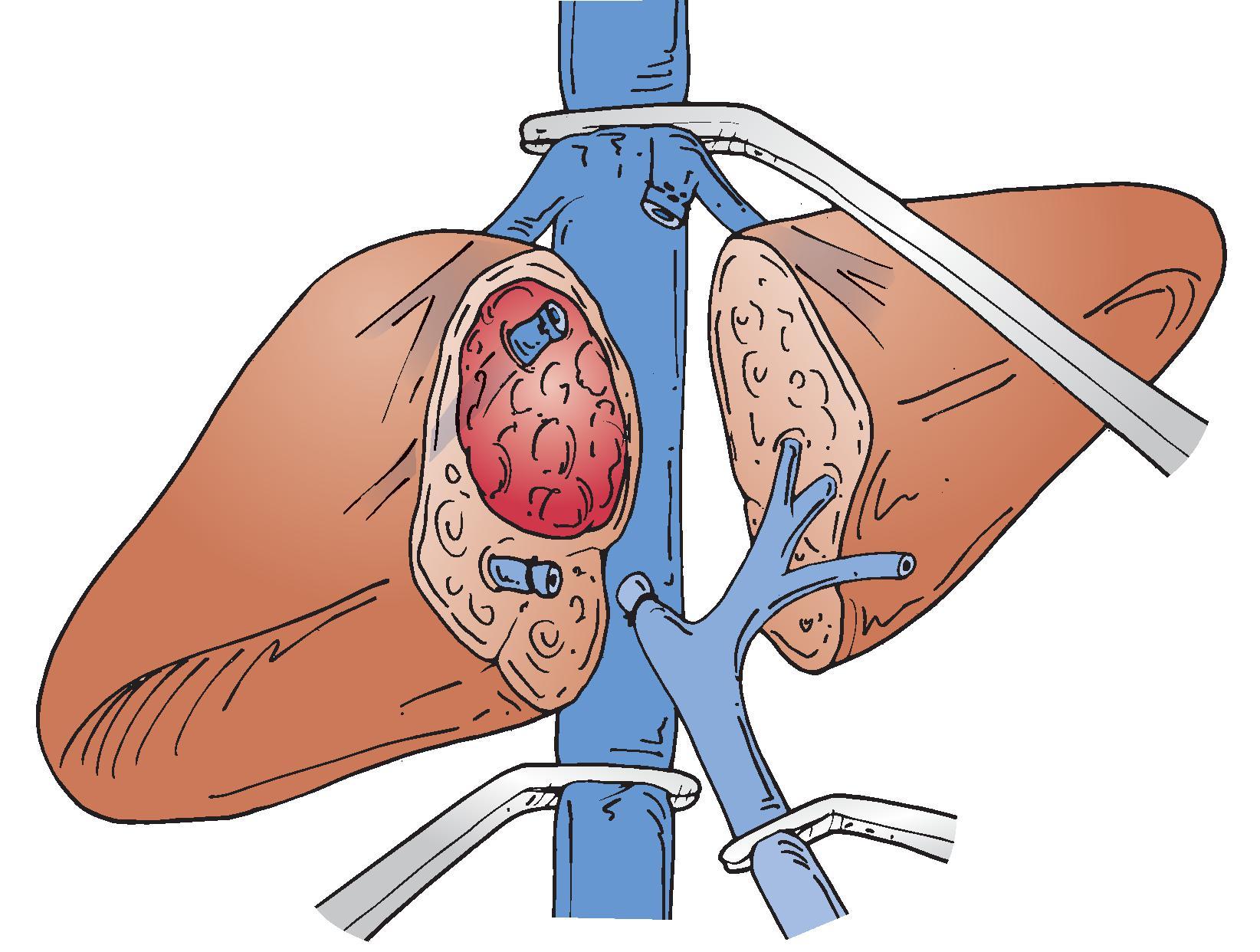
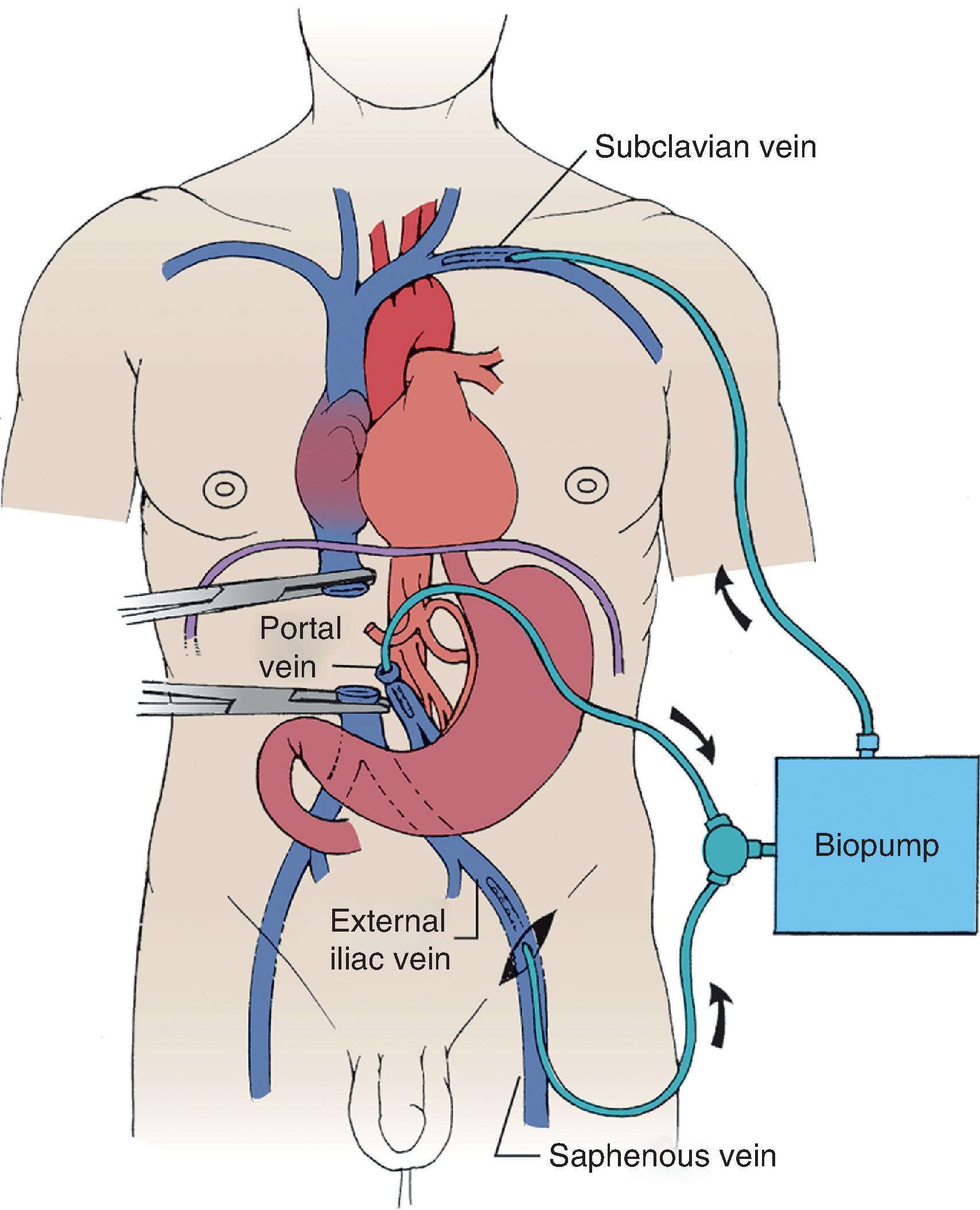
Because of the inherent and overwhelming risks of surgical management of these complex injuries, tamponade with containment followed by angiography and possible embolization has become a viable option (when possible) in the management of juxtahepatic venous injuries. Such an approach often requires temporarily leaving the abdomen open. Although omentum has been proposed to create the tamponade effect, gauze packing is more expedient and effective. Pachter et al. described a “nonshunting approach” that consists of four components: (1) manual compression and aggressive fluid resuscitation; (2) prolonged portal triad occlusion (mean occlusion time, 46 minutes); (3) rapid and extensive finger fracture for vascular control, almost always through normal hepatic parenchyma to the site of injury; and (4) wide mobilization of the hepatic attachments with medial rotation of the liver to provide access to both the retrohepatic cava and the hepatic vein. In their series, six of the nine “nonshunted” patients survived.
Injuries to the porta hepatis are rare, usually complex, and highly lethal. Review of the recent literature showed three large series that cumulatively report 180 patients treated between 1965 and 1994. These injuries are usually penetrating, occurring in 50% to 100% of the populations reported. Isolated injuries to the portal structures occur and are far more survivable than are multiple injuries. Overwhelming hemorrhage is the usual cause of death in all reported series.
The porta hepatis is composed of the hepatic artery, extrahepatic bile duct system, and portal vein. The proximity of these structures to other major structures and their relatively difficult exposure explains their high lethality. In the multi-institutional survey compiled by the Western Trauma Association and reported by Jurkovich et al., an overall 51% mortality rate was recorded. When broken down, the morality rate in single-structure injuries is still 45%, whereas the mortality rate in multiple-structure injuries increases to 80%. This is in line with results in other reports in the literature.
Injuries to the portal vein are responsible for most deaths ascribed to trauma to the portal structures. Once identified and the bleeding controlled, the question of repair versus ligation must be addressed. Ligation of the portal vein can be tolerated in that there will be decompression of the portal hypertension by collateral vessels. Unfortunately, in patients subjected to ligation of the portal vein, the mortality rate is as high as 90%. This is in disagreement with survival rates of 50% to 80% reported previously by Pachter et al. and Stone et al. Patients treated by ligation of the portal vein have greater circumferential disruption of the vein and overwhelming hemorrhage, and ligation is used as a rapid method of bleeding control. Repair of the portal vein is used with lesser degrees of injury (less than 25% in circumferential injury) and is reported to have increased survivability. Many of the deaths occur because of massive hemorrhage before a repair can be accomplished. When confronted with a portal venous injury, repair is preferable to ligation, although ligation is an acceptable option. Second-look laparotomy to check for bowel viability has been advocated when the portal vein has been ligated.
The liver receives a dual blood supply from the hepatic artery and the portal vein, allowing ligation of the hepatic artery without absolutely compromising hepatic blood supply. Lobar artery ligation is well tolerated, but the overall mortality rate remains in excess of 40%.
Bile duct injuries are uncommon, even in this relatively uncommon injury cluster. Partial circumferential disruption can be treated by primary repair as well as demonstrated from the experience with iatrogenic bile duct injury at the time of cholecystectomy. Complex or complete disruption of the ductal tree is best managed by biliary-enteric anastomosis. End-to-end anastomosis has an excessive stenosis rate. Adequate drainage of the area is essential because bile leaks can occur. On rare occasion, stenting and external drainage have been used in an unstable patient, with biliary reconstruction accomplished at a later date.
The key to the diagnosis of bile duct injury is suspicion that the injury has occurred. Evidence of bile staining and the presence of a duodenal injury should prompt investigation that is best done by an intraoperative cholangiogram. Small injuries may be missed at initial exploration. Endoscopic retrograde cholangiopancreatogram with stenting may provide diagnostic therapeutic answers if a patient develops a biloma subsequent to a missed injury.
Bleeding remains the leading cause of preventable death in trauma patients who reach the hospital. Both penetrating and blunt trauma can lead to life-threatening injury of the abdominal vasculature. Traumatic injury to vessels may occur via direct laceration and transection or blunt injury resulting in dissection or thrombosis. Although endovascular treatment of abdominal vascular injuries has become increasingly utilized, the unstable patient with active hemorrhage will still require open surgical intervention. Appropriate management of these patients centers on prompt recognition of the injury, rapid exposure, and control of hemorrhage. Despite advances in technology, mortality from abdominal vascular injury remains high, and survival of these patients hinges on rapid exposure and control of the hemorrhage. Resuscitative endovascular balloon occlusion of the aorta (REBOA) is gaining popularity as an adjunct for controlling major intraabdominal hemorrhage. The technique was first described in 1953 during the Korean War by Dr. Lt. Colonel Hughes on three soldiers in hemorrhagic shock. The surgeon placed a Foley catheter through the femoral artery to provide proximal vascular control. Although none of the three patients survived, Lt Colonel Hughes noted temporary improvement with inflation of the balloon. However, the procedure was not widely adopted during this time, likely because of concerns regarding the technical difficulty of the procedure and availability of the equipment needed. In 2000, Greenberg and colleagues described the use of an aortic balloon occlusion device to control hemorrhage before endovascular repair for ruptured abdominal aortic aneurysms in three patients. As the use of aortic balloon occlusion has continued to increase in the field of vascular surgery, it has also recently gained momentum as an effective method of obtaining proximal control in the setting of life-threatening abdominal or pelvic trauma.
The goal of REBOA is to provide proximal control of abdominal vascular hemorrhage before transport to the operating room or angiography suite ( Fig. 7 ). After the groin has been prepped, the common femoral artery is accessed with a standard hollow 18-gauge vascular access needle. It is important that incorrect placement, either too proximally into the iliac artery or too distally into the superficial femoral artery, be avoided. As many of these patients may not have a readily palpable femoral pulse, the artery can be accessed using standard anatomic landmarks, using ultrasound guidance, or via direct exposure through an open cutdown. Once the artery is accessed, a 0.035-inch wire is fed through the needle in standard Seldinger fashion. Traditionally, a 6Fr vascular sheath and dilator are placed and then upsized to an 11Fr to 14Fr sheath depending on the size of the balloon being used; however, newer “one-pass” sheaths and dilators are currently available for the trauma setting. Once the appropriate size sheath is in place, a stiff Amplatz guidewire is placed through the sheath. The balloon device is then fed over the guidewire to the correct position.
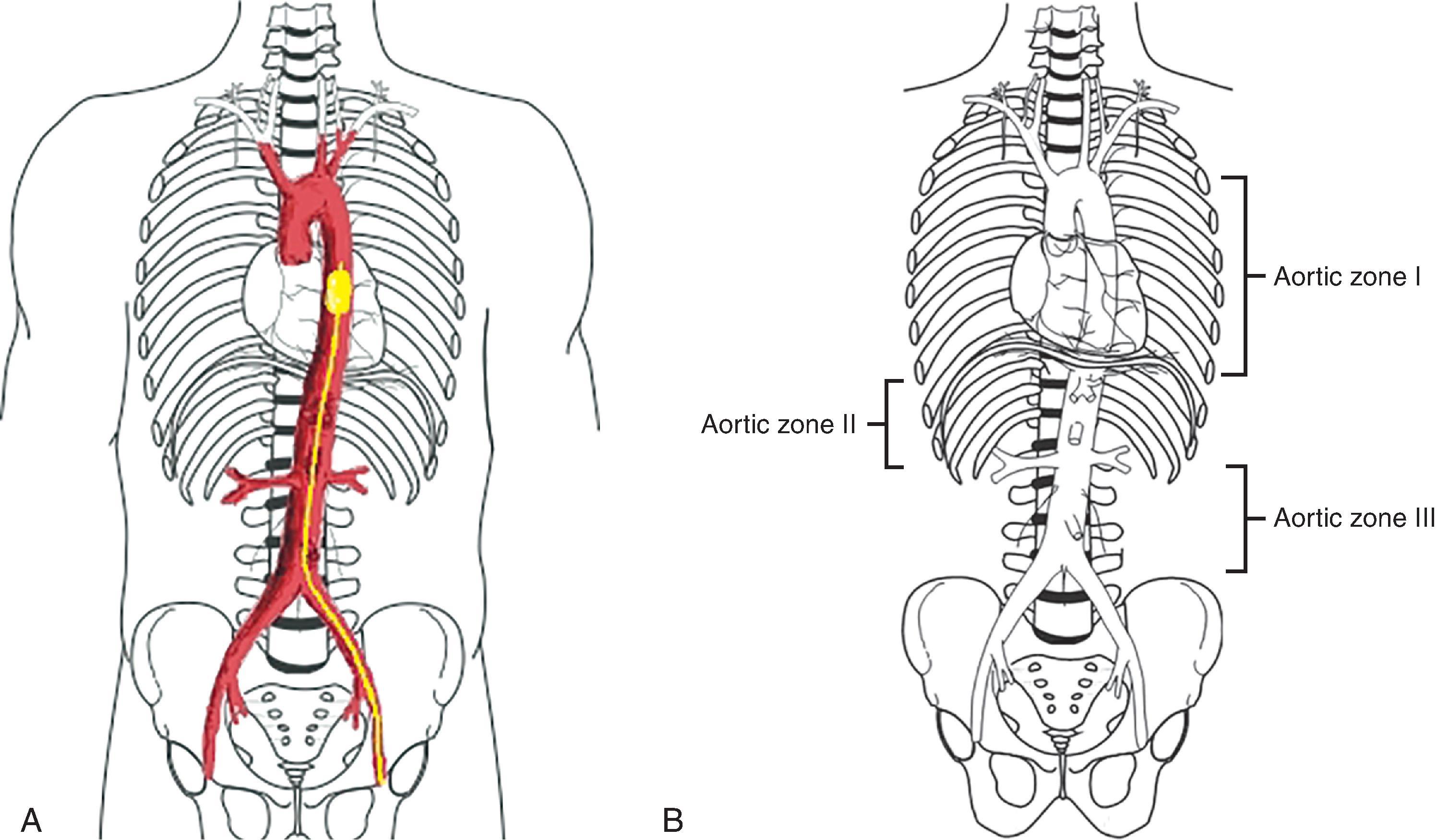
The location of the balloon in the aorta is determined by the presumed location of the trauma, divided into three distinct zones (see Fig. 7 ). Zone I is the proximal zone of the descending aorta between the left subclavian and celiac trunk. Placement of the balloon in this zone is recommended for abdominal and visceral trauma. Zone II encompasses the abdominal vasculature from the celiac artery to the lowest renal artery. Placement of the balloon in Zone II is contraindicated as it is possible to directly occlude the celiac artery, superior mesenteric artery, or renal arteries resulting in organ ischemia. Zone III extends from the lowest renal artery to the aortic bifurcation. Positioning of the balloon in this zone provides proximal control for pelvic hemorrhage while still maintaining perfusion to the abdominal organs. Correct positioning of the balloon can be accomplished with either fluoroscopy, plain film x-ray in the trauma bay, or by physical landmarks.
Once positioned, the balloon is then inflated with either saline or a 1:1 mixture of saline and contrast if fluoroscopy is being utilized. Appropriate filling of the balloon can be confirmed by either visualization of the balloon flattening against the wall of the aorta if using fluoroscopy or loss of a pulse in the contralateral femoral artery. Several animal studies have demonstrated that aortic occlusion times greater than 60 minutes may result in severe physiologic derangement and irreversible organ failure; thus, it is imperative that the surgeon be mindful of the duration of balloon inflation and should limit this to less than 60 minutes. After hemorrhage has been controlled, the balloon should be slowly deflated with ongoing communication between the surgeon and the anesthesiologist as there may be abrupt periods of hypotension as the balloon is deflated.
Concerns regarding the use of REBOA focus on incorrect placement of the device, effectiveness in controlling hemorrhage, and potential for organ ischemia. One of the initial case series in 1989 documented the use of REBOA in trauma patients and found that trauma surgeons were able to appropriately position and deploy the balloon, and the balloon was able to control hemorrhage in 11 of 21 patients with refractory hemorrhagic shock. Brenner and colleagues published a recent case series of six trauma patients with severe hemorrhagic shock in whom REBOA was utilized before angiographic or surgical control of the hemorrhage. REBOA resulted in an average increase in systolic blood pressure of 55 mm Hg, and none of the patients died as a result of hemorrhage. Additional studies have shown similar rates of successful placement and control of hemorrhage in patients with both blunt and penetrating abdominal trauma.
Although in many situations, the most effective method to control hemorrhage will be direct control via laparotomy or embolization, REBOA is a technically feasible and potentially life saving adjunct in the patient with refractory and end-stage hemorrhagic shock. As the technology for REBOA devices improves and more clinical research is performed, REBOA will likely become more widespread as a rapid and effective method of hemorrhage control before definitive surgical repair for life-threatening abdominal and pelvic trauma.
Although laparotomy is the standard of care for abdominal exploration in hemodynamically unstable trauma patients, there are roles for the use of laparoscopy for diagnostic and therapeutic approaches to intraperitoneal injuries in the hemodynamically stable trauma patient. The enhancements of diagnostic tools such as ultrasound and CT have certainly advanced noninvasive diagnostic capabilities, but limitations remain in the diagnostic accuracy for certain injuries. The identification of blunt traumatic bowel injuries, mesenteric injuries, and diaphragmatic injuries can be a diagnostic dilemma with modern imaging techniques. Laparoscopy can be a very useful diagnostic adjunct. Laparoscopy should be considered in patients who do not have an indication for trauma laparotomy but for whom there is concern for unidentified bowel, mesenteric, or diaphragmatic injury based on initial evaluation and imaging. Diagnostic laparoscopy has been reported to reduce nontherapeutic laparotomy rates up 73% in select trauma patients.
Evidence of intraperitoneal free fluid without detectable solid organ injury, while certainly not diagnostic, is concerning for possible hollow viscous injury or mesenteric injury. Although diagnostic peritoneal lavage can be employed, the relatively high false-positive rate and risk for creating visceral injury may portend a risk for unnecessary laparotomy. An early randomized controlled study comparing diagnostic laparoscopy to DPL found higher diagnostic specificity in the diagnostic laparoscopy group. Serial abdominal examinations and monitoring for the development of peritonitis is also a well-adopted diagnostic maneuver for the identification of occult bowel injury in blunt trauma. However, in a series of blunt bowel and mesenteric injuries, Ekeh et al. identified a 19.3% delay in recognition of bowel or mesenteric injury when utilizing a diagnostic armamentarium of physical examination, CT, DPL, and FAST examination. Laparoscopy can also be a useful diagnostic adjunct for identification of occult bowel injury in the patient with discordant imaging and clinical findings, or the so-called unclear abdomen. If an injury is identified, the case can then be converted to a laparotomy, or, depending on the skill set of the surgeon, the injury may be amenable to repair with minimally invasive techniques.
Acceleration and sudden deceleration injury mechanisms can result in mesenteric lacerations. Mesenteric injuries, including mesenteric bucket-handle injuries, are not always easily detected with CT imaging. Frick et al. reported that 29.7% of mesenteric lacerations lead to small bowel devascularization and subsequent complications in their series. Potentially devastating consequences associated with missed mesenteric lacerations with resulting bowel ischemia and perforation make prompt diagnosis of these injuries essential. Early diagnostic laparoscopy can be a useful tool to identify these injuries in patients with high suspicion for the injury pattern. Further investigation with laparoscopy may be warranted in patients with a “seat belt sign,” imaging that detects free fluid without detectable solid organ injury, imaging that demonstrates evidence of mesenteric injury, or a discrepancy between imaging studies and clinical presentation.
Once a mesenteric injury is identified, the perfusion of the bowel must be assessed. With large tears in the mesentery, it is fairly obvious that the perfusion to the bowel has been sufficiently compromised to warrant bowel resection. For smaller lacerations, perfusion of the bowel can be assessed with indocyanine green (ICG)-enhanced fluorescence screening. Once ICG is injected into the vascular system via the intravenous route, it binds to plasma proteins. Based on the ability of ICG to become fluorescent when excited by near-infrared light, real-time intraoperative organ perfusion can be assessed. This technology is utilized by multiple disciplines including plastic surgeons to assess flap perfusion and colorectal surgeons to assess perfusion of colorectal anastomosis. This technology has been adapted to minimally invasive surgery, and the ability to laparoscopically perform ICG perfusion assessment is available and may be a useful aid in assessing bowel perfusion in mesenteric injuries.
CT has limited sensitivity in identifying diaphragmatic injuries; however, diagnostic laparoscopy is a superior technique to fill this diagnostic void. Furthermore, many diaphragmatic injuries are amenable to laparoscopic repair, as the most common therapeutic minimally invasive procedure in trauma identified in a large trauma database was repair of the diaphragm (19.2%). Diaphragm injuries amenable to laparoscopic repair are more common with penetrating injuries, as blunt diaphragmatic injuries are relatively rarer and are often associated with more significant concomitant injuries because of the substantial applied force to generate the injury. However, in the correctly selected patient without indication for laparotomy, laparoscopy remains a viable option for the diagnosis and treatment of diaphragmatic injuries in blunt abdominal trauma.
The technical approaches to diagnostic laparoscopy can vary, but the principles remain constant. Initial access for insufflation can be achieved with a variety of maneuvers including the open Hasson method, Veress needle technique, and direct optical trocar insertion. The surgeon’s experience as well as the clinical variables may dictate the optimal method for initial peritoneal access. The open Hasson technique at the umbilicus can be a safe modality for peritoneal entry but can be very challenging in the obese patient. A history of various prior abdominal operations may also dictate the chosen technique for initial entrance.
Once access is obtained, pneumoperitoneum should be slowly established with close monitoring for any physiologic alterations. Insulation pressure should not exceed 15 mm Hg, and sometimes lower pressures are sufficient for adequate visualization and exploration. Pneumoperitoneum should be released if ventilatory difficulties are encountered or hemodynamic compromise develops. A 0-degree or 30-degree laparoscope can be utilized for exploration. Additional trocar placement location is often dictated by the suspected injured region. However, when suspicion for injury remains uncertain, beginning with two paramedian trocars on either side of the umbilicus at about the midclavicular line in addition to a trocar at the umbilicus is an adequate arrangement to achieve sufficient exploration. Additional trocars can be placed under direct visualization as needed to achieve further diagnostic or therapeutic maneuvers.
After establishing operative access with the trocars, the peritoneal cavity is explored in a systematic manner similar to an open exploration with visualization of all four quadrants. Operating table position manipulation can assist in fully evaluating for injuries in all four quadrants. Tilting the table in the reverse Trendelenburg position can facilitate exploration of bilateral upper quadrant structures including the liver, spleen, diaphragm, and stomach, while positioning the table in the Trendelenburg position can assist in visualization of the pelvic viscera. After lifting the omentum cranially, the small bowel can be run from the ileocecal valve to the ligament of Treitz utilizing atraumatic graspers. Care should be taken to ensure that the bowel is completely evaluated during this exercise including the mesenteric and antimesenteric borders, and the mesentery should be thoroughly examined as well at this time. If there is concern for a posterior gastric or pancreatic injury, the lesser sac can also be explored laparoscopically. Significant hemoperitoneum, dilated bowel limiting the working space, or the surgeon’s technical limitations can all be a hindrance to satisfactory exploration. A low threshold should be had for conversion to laparotomy if the surgeon is not confident in the laparoscopic exploration or missed injuries are suspected.
Complications from laparoscopy can result from access-related injuries, insufflation-related issues, iatrogenic injury during exploration, and inadequate visualization of injuries. Initial access can be achieved via a variety of techniques as described, but all of these maneuvers have the inherent risk of injury to structures along the path of entry including vascular, hollow viscous, and solid organ injury. Gas insufflation can lead to decreased cardiac output from decreased venous return causing hypotension and bradycardia. Capnothorax can also result if there is any violation of the diaphragm and can lead to tension pneumothorax physiology. Issues related to insufflation can generally be resolved with desufflation but may prohibit the utility of laparoscopy. Because of the associated increase in intracerebral pressure with pneumoperitoneum, laparoscopy is contraindicated in severe traumatic brain injury patients. Venous gas embolism is a very rare complication of laparoscopic surgery that infrequently results in a clinically significant event. Iatrogenic visceral injuries are most commonly associated with trocar insertion, direct mechanical instrumentation, and inadvertent electrocautery thermal injury. Missed hollow viscous injury was a significant dilemma in the infancy of laparoscopy in trauma; however, more recent, albeit small, studies have reported a 0% to 0.5% missed injury rate in laparoscopic evaluation of blunt trauma cohorts.
Laparoscopy is a safe and effective diagnostic tool in select trauma patients and can have therapeutic capabilities in the hands of the surgeon with advanced laparoscopic skills. The widespread adoption and progression of minimally invasive surgical techniques certainly adds to the diagnostic and therapeutic armamentarium of the trauma surgeon, but careful patient selection must be judiciously exercised when employing these techniques.
In addition to the management of abdominal trauma that has been underscored throughout the chapter for blunt trauma, there are several proposed treatment paradigms for many of the injuries sustained in trauma. However, the standard-of-care management for an individual is heavily dependent on the resources and personnel available along with transport options, if any. There are resource-rich trauma systems throughout the country, with highly qualified personnel. However, these systems are not uniform throughout the nation, and the concept of regionalization has not been perfected for all regions in the country. The overarching goal remains the same: optimal management for everyone, irrespective of where the patient receives trauma care.
Interventions in the field or emergency department do not control intraabdominal bleeding or gastrointestinal contamination in the patient with a penetrating abdominal wound that causes injury. Therefore, transport and resuscitation in such patients is different from methods used in patients with blunt multisystem trauma. For example, the application of a cervical collar or spinal immobilization in the field is unnecessary unless the patient has a specific complaint at the scene. Rapid transport takes precedence over insertion of intravenous catheters at the scene in urban areas, where a trauma center is only 15 to 25 minutes away. Even with longer transport times to the trauma center, the military concept of hypotensive resuscitation (limited or no resuscitation before operation) is now applied by many civilian emergency medical services during transport. Obviously, this would be inappropriate in a patient with an associated traumatic brain injury. The ideal perioperative systolic or mean arterial blood pressure during hypotensive resuscitation in the symptomatic patient with a penetrating abdominal wound is unknown.
In the emergency department, emergency intubation is indicated in patients with the following:
Profound hypotension (Advanced Trauma Life Support [ATLS] class III or IV shock) or recent cardiopulmonary arrest
Associated wounds to the neck or chest affecting the airway or breathing
Depressed neurologic state secondary to shock, acute alcoholism, or illicit drugs
Extreme agitation preventing evaluation and resuscitation
An identification bracelet is applied to the patient; intravenous lines are inserted into the upper extremities, subclavian veins, or jugular veins; and venous blood is withdrawn for type and crossmatch and routine laboratory testing (“three C s” including c omplete blood count, c hemistry, and c oagulation studies). In the patient with ATLS class III or IV shock, most level I trauma centers will initiate a massive transfusion protocol (MTP) and administer packed red blood cells immediately. Smaller centers or those without an MTP often still administer a crystalloid solution initially and then transfuse when type-specific blood is available. Many centers have moved from damage-control resuscitation with administration of fixed ratios of packed red blood cells, plasma, and platelets to goal-directed hemostatic resuscitation . The latter is based on thromboelastography (TEG) or rotational thromboelastometry.
As resuscitation is ongoing, a surgeon-performed ultrasound examination of the pericardium, peritoneal cavity, and pleural cavities (expanded focused assessment with sonography in trauma [eFAST]) is performed with a 3.5-MHz ultrasound probe in patients with wounds in the abdomen, especially when there are other wounds, such as to the thorax or thoracoabdomen. Although this examination is primarily indicated in patients with blunt multisystem trauma, it also has diagnostic advantages in patients with possible penetrating abdominal trauma. For example, the presence of fluid (blood) in the pericardial sac might prompt a median sternotomy or anterolateral thoracotomy, even before a needed laparotomy, or rapid diagnosis of a hemothorax or pneumothorax (without the need for emergency chest radiography) would prompt insertion of a thoracostomy tube before a needed laparotomy. Finally, the presence of fluid (blood) in the peritoneal cavity confirms that the knife or gunshot wound has penetrated through the abdominal wall.
A patient with one or more classical indications for an emergency laparotomy ( Box 1 ) should be moved to the operating room within 10 minutes of arrival in the emergency department or trauma center. Before this time, an intravenous dose of a second- or third-generation cephalosporin antibiotic is administered.
Hypotension in absence of other site of potential hemorrhage (i.e., penetrating cervical, thoracic, or peripheral vascular wound with active hemorrhage)
Peritonitis on initial or subsequent physical examination
Evisceration of bowel and, in some centers, omentum (controversial)
Bleeding from stomach (hematemesis or bloody return from nasogastric tube) or rectum (bright red blood or hematochezia on finger examination or proctoscopy)
Bleeding from genitourinary tract (exception would be flank wound in stable patient and CT evidence of isolated nonhilar renal injury amenable to observation or angioembolization)
Contrast-enhanced CT demonstrates perforation of gastrointestinal tract, intraperitoneal bladder, or severe (AAST OIS * grade V) solid organ injury.
* American Association for the Surgery of Trauma (AAST) Organ Injury Scale (OIS). Modified from Feliciano DV. Abdominal trauma revisited. Am Surg. 2017;83:1193–1202.
The timing of operation in such patients in a busy trauma center will depend on the patient’s hemodynamic status and associated injuries as well as the hemodynamic status of other patients with penetrating or blunt trauma who are being evaluated simultaneously.
The historic “aggressive” operative approach to abdominal trauma resulted from a concern about missed injuries should a nonoperative approach be chosen. This changed gradually when data on unnecessary or nontherapeutic laparotomies for all mechanisms of abdominal trauma became available through trauma registries. For example, historic nontherapeutic laparotomy rates for penetrating (through the peritoneum) anterior abdominal stab wounds, penetrating wounds of the flank and back, and gunshot wounds in proximity to the abdomen were 25% to 40%, 70% to 85%, and 15% to 27%, respectively.
Just as in patients with blunt abdominal trauma, the diagnosis of peritonitis on a physical examination after a penetrating abdominal wound, particularly a stab wound, may be difficult. This is particularly true in patients who are intoxicated, have ingested illicit drugs, have associated injuries to the brain or spinal cord, or have multiple penetrating wounds in areas adjacent to the abdomen (thoracoabdomen, pelvis, flank, back). When serial physical examinations may not be helpful in hemodynamically stable patients, standard diagnostic adjuncts are used, preferably in a sequence agreed up on by staff trauma surgeons ( Box 2 ).
Local exploration of anterior stab wounds
Diagnostic peritoneal tap/lavage
Surgeon-performed ultrasound examination (FAST)
Contrast-enhanced CT of the abdomen and pelvis
Diagnostic laparoscopy
In patients in whom contrast-enhanced computed tomography (CT) will be part of the diagnostic workup, a 128-slice scanner should be used. This will allow scanning of the trunk to be completed with a limited number of revolutions in a short period of time.
Dual-energy CT in which images are acquired at two different energy levels simultaneously is now available in some hospitals, and attenuation differences allow for suppression of artifacts and enhanced images. This technology is now being used to image the brain and aorta and will soon have an impact on truncal imaging in injured patients.
The obvious goal of further diagnostic evaluation in patients without clear-cut indications for an emergency or urgent laparotomy is to avoid an unnecessary or nontherapeutic laparotomy. Patients undergoing such procedures have a fixed rate of postoperative complications and an extended length of stay as compared with those managed with observation or further diagnostic testing.
One of the common-sense observations about patients with multiple gunshot wounds is that associated hypotension is likely related to one wound (“one bad bullet”). When there is no external bleeding from an injured neck or extremity to explain the hypotension, surgeon-performed ultrasonography is the diagnostic test of choice. As previously noted, an eFAST examination will document whether the hypotension is from pericardial tamponade, intrapleural hemorrhage, or intraperitoneal hemorrhage. An equivocal eFAST examination or lack of availability of an ultrasound machine should prompt an open diagnostic peritoneal tap/lavage in the hypotensive patient, a rarely performed diagnostic test in the modern era.
The thoracoabdomen is defined as the nipple-to-costal margin from the midline to the anterior axillary line. Penetration through the diaphragm into the peritoneal cavity from a wound in the thoracoabdomen will occur in approximately 15% of stab wounds and more than 45% of gunshot wounds ( Fig. 1 ).
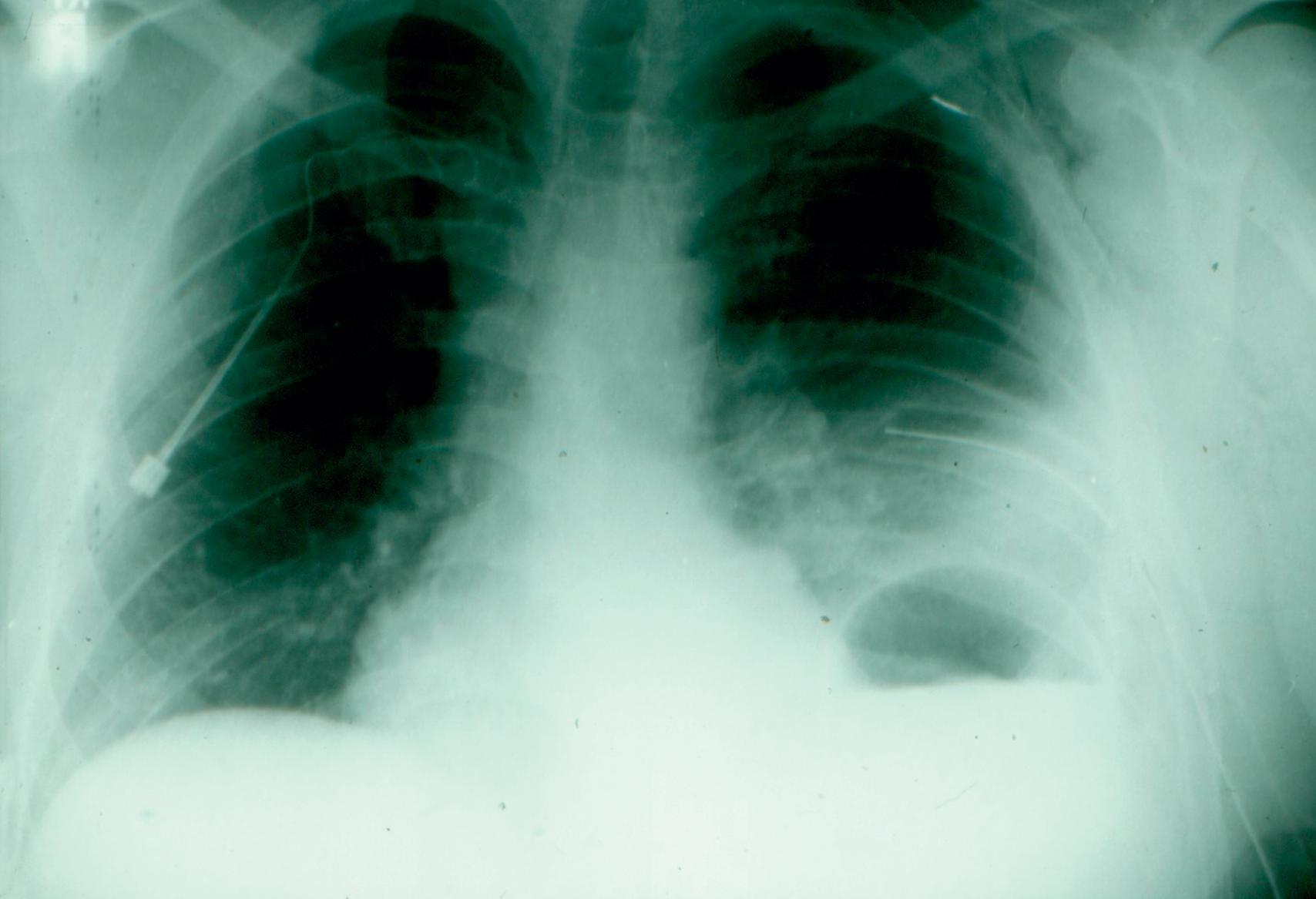
Once again, surgeon-performed ultrasonography is the initial diagnostic test of choice in the patient without an obvious indication for a laparotomy. An ipsilateral pneumothorax or hemothorax can be confirmed, whereas the presence of intraperitoneal fluid (blood) documents that the hemidiaphragm and, possibly, intraabdominal viscera have been injured. An eFAST examination in which no intraperitoneal fluid is visualized is not helpful because only modest bleeding may result from a penetrating wound of the hemidiaphragm alone.
In the modern era, documentation of intraperitoneal fluid (blood) in the asymptomatic or mildly symptomatic patient after a thoracoabdominal wound does not prompt an immediate laparotomy. With a wound in the right thoracoabdomen , triple-contrast (intravenous, oral, rectal) CT is performed to evaluated the liver, right kidney, duodenum, and colon. This is a labor-intensive study for the radiology technician because all three contrast agents are administered simultaneously. In addition, metallic fragments from a bullet may create enough “scatter” to compromise the accuracy of one of the contrast studies. A patient with a wound to the liver or right kidney only without extravasation of contrast (no active bleeding) is managed nonoperatively with serial physical examinations for 24 to 36 hours. If desired, healing of the injury to the liver or right kidney can be evaluated on a follow-up CT examination in 5 to 7 days. In such a patient, the small penetrating wound in the right hemidiaphragm is not fixed. This is because omental herniation through the right-sided defect essentially never occurs, and the complication of a bronchobiliary fistula is so rare. A triple-contrast CT is performed after a penetrating wound to the left thoracoabdomen as well, with the goal of evaluating the liver, spleen, left kidney, stomach, and colon. Even if a patient has a nonbleeding wound to the left lobe of the liver, spleen, or left kidney and no extravasation of gastrointestinal contrast, the wound to the left hemidiaphragm must be repaired. This will prevent herniation of the omentum into the left hemithorax secondary to the negative intrapleural pressure of respiration. This can be accomplished via a laparoscopic approach depending on the surgeon’s expertise.
Because of the labor-intensive nature of triple-contrast CT, some centers choose to perform diagnostic laparoscopy instead after a wound to the left thoracoabdomen. An equivocal triple contrast CT after a wound to either the right or left thoracoabdomen should be followed by diagnostic laparoscopy as well. Using a 30-degree laparoscope with the patient under general anesthesia in the operating room will allow for a careful inspection of the ipsilateral hemidiaphragm and intraabdominal viscera.
The anterior abdomen is defined as the area from the costal margins to the inguinal ligaments between the anterior axillary lines. Historic data have documented that stab wounds in this location penetrate the peritoneal cavity only 25% to 33% of the time. Even in patients with documented peritoneal penetration, only 50% to 55% will present with overt indications for a laparotomy. In the remaining 45% to 50% who undergo serial physical examinations, only half will eventually become symptomatic and require laparotomy.
A local wound exploration under semisterile conditions and local anesthesia in the trauma room is the first diagnostic maneuver. Contraindications would include the agitated or uncooperative patient or one who is morbidly obese. A very localized layer-by-layer exploration will, at the least, document whether the anterior aponeurosis of the muscular abdominal wall has been penetrated. In many centers, the local wound exploration is terminated at this point and the patient admitted for serial physical examinations or further diagnostic testing. Other centers will continue the exploration through the muscular layers of the abdominal wall to determine whether the posterior aponeurosis, peritoneum, or both have been perforated ( Fig. 2 ). If it can be confirmed that this has not occurred, the wound is irrigated and closed in layers, a tetanus immunization shot is administered, and the patient is discharged.
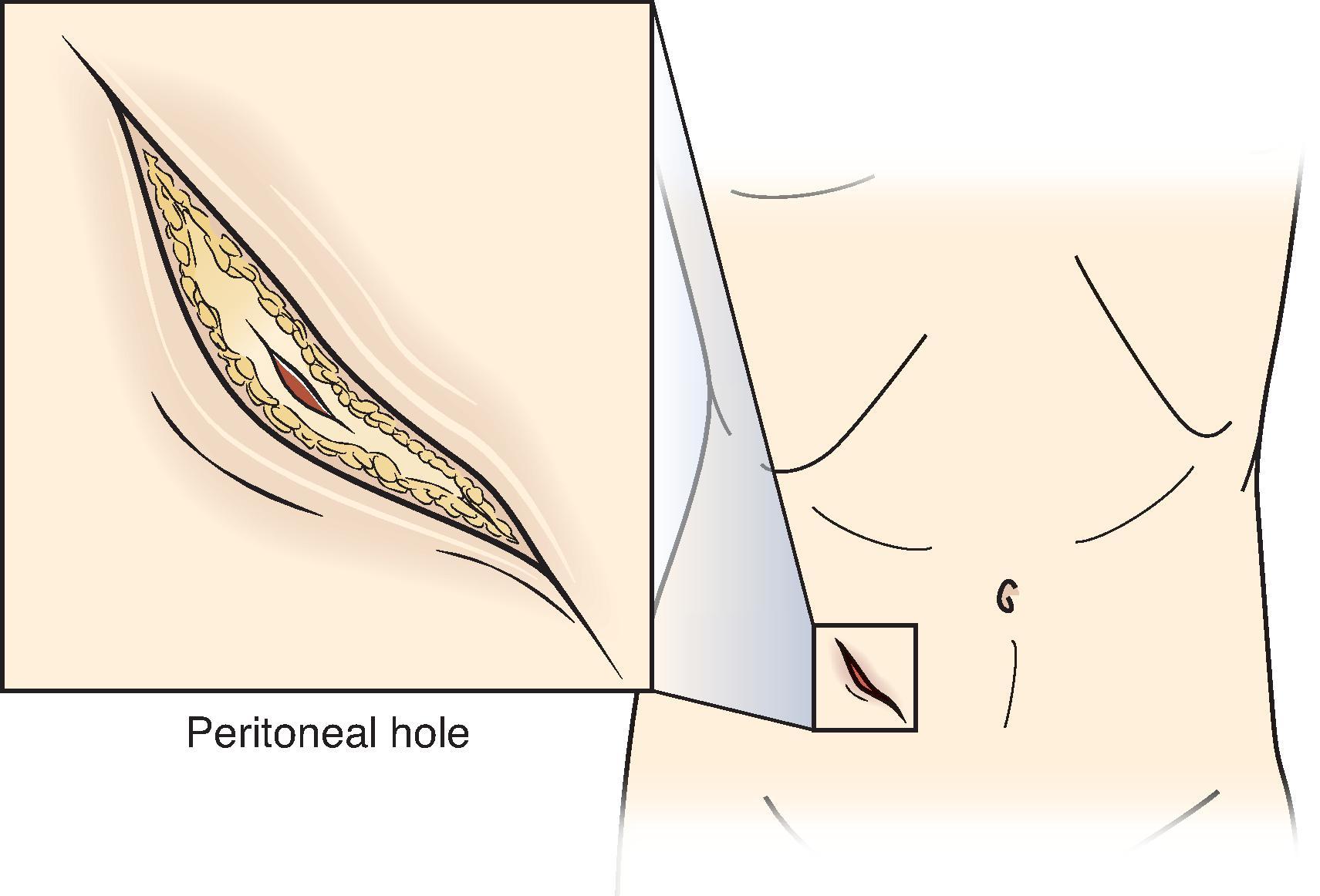
In most centers, an asymptomatic or mildly symptomatic patient with penetration of the anterior aponeurosis or peritoneum will then undergo serial physical examinations every 6 to 8 hours for 24 hours. Almost all patients with continued bleeding from a solid organ, the mesentery, or omentum or peritonitis from a gastrointestinal wound will become symptomatic within 6 to 16 hours. Despite the delay in operative management that inevitably occurs in this small subset of patients, postoperative morbidity is surprisingly low. Another option is to perform a triple-contrast helical CT examination, which has been implemented to assess flank and back wounds for the past 35 years. In one older study of patients with penetrating injury to the torso from the Shock Trauma Center at the University of Maryland, CT accurately predicted the need for laparotomy in 95% of patients.
A historic option in the asymptomatic or mildly symptomatic patient is to perform an immediate diagnostic peritoneal tap/lavage after a “positive” local wound exploration. This option has become less popular over time because of false-positive examinations resulting from intraperitoneal blood related to the injury to the abdominal wall. Also, there has been continuing controversy about whether a red blood cell count of 100,000/mm 3 (as in patients with blunt trauma) or 5000/mm 3 (to pick up a small wound in the hemidiaphragm) should be used to mandate a laparotomy. The accuracy of this approach using a cell count of 100,000 red blood cells/mm 3 or 500 white blood cells/mm 3 ranges from 88% to 92%.
Evisceration of a large piece of omentum (or any piece of bowel) should prompt an emergency laparotomy. This allows for replacement of the omentum into the peritoneal cavity, a complete exploration for associated injuries (theoretically, a higher incidence than if a smaller defect in the abdominal wall), and repair of the abdominal wall. Controversy exists, however, when a small piece of omentum is eviscerated. In such patients, an emergency laparotomy will be nontherapeutic in 20% to 60% of patients. Therefore, some centers will ligate the base of the eviscerated omentum, excise it, return the remainder to the peritoneal cavity, close the defect in the abdominal wall, and perform serial physical examinations for 24 hours. This option is safe and has a delay to operative management essentially the same as if an omental evisceration had not occurred.
The flank is defined as the sixth intercostal space to the iliac crest between the anterior and posterior axillary lines, whereas the back is the tips of the scapulae to the iliac crests posterior to the posterior axillary lines. Wounds in these areas may penetrate the peritoneal cavity or the visceral-vascular area of the retroperitoneum. A historic policy of mandatory laparotomy for penetrating wounds to the flank or back in symptom-free patients has been abandoned over the past 30 years because the aforementioned negative/nontherapeutic rate was 70% to 85%. This was partially related to the often-forgotten thickness of the muscles in young men in these areas.
The two diagnostic options in these patients are serial physical examinations and triple-contrast CT. The concern with serial physical examinations is that perforation of the retroperitoneal duodenum, ascending colon, or descending colon will cause retroperitonitis or a delayed onset of symptoms. One large study of flank wounds in 2007, however, documented that 91% of patients who developed symptoms of an occult injury did so within 6 hours of admission. In addition, no patient observed for 18 hours developed symptoms from an occult injury after this time. Therefore, the 24-hour recommended period for serial physical examinations after presumed or documented anterior stab wounds can be applied to patients with flank or back wounds as well. Should the data described not be convincing for the trauma surgeons in a given center, extending the period for serial physical examinations to 36 hours is certainly appropriate.
As previously noted, triple contrast-enhanced CT examinations to evaluate patients with penetrating wounds to the flank or back were first reported in 1986. Along with the 35 years of experience with this diagnostic approach, the evolution to 128-slice scanners minimizes the risk of missing an occult retroperitoneal visceral or vascular injury ( Fig. 3 ).
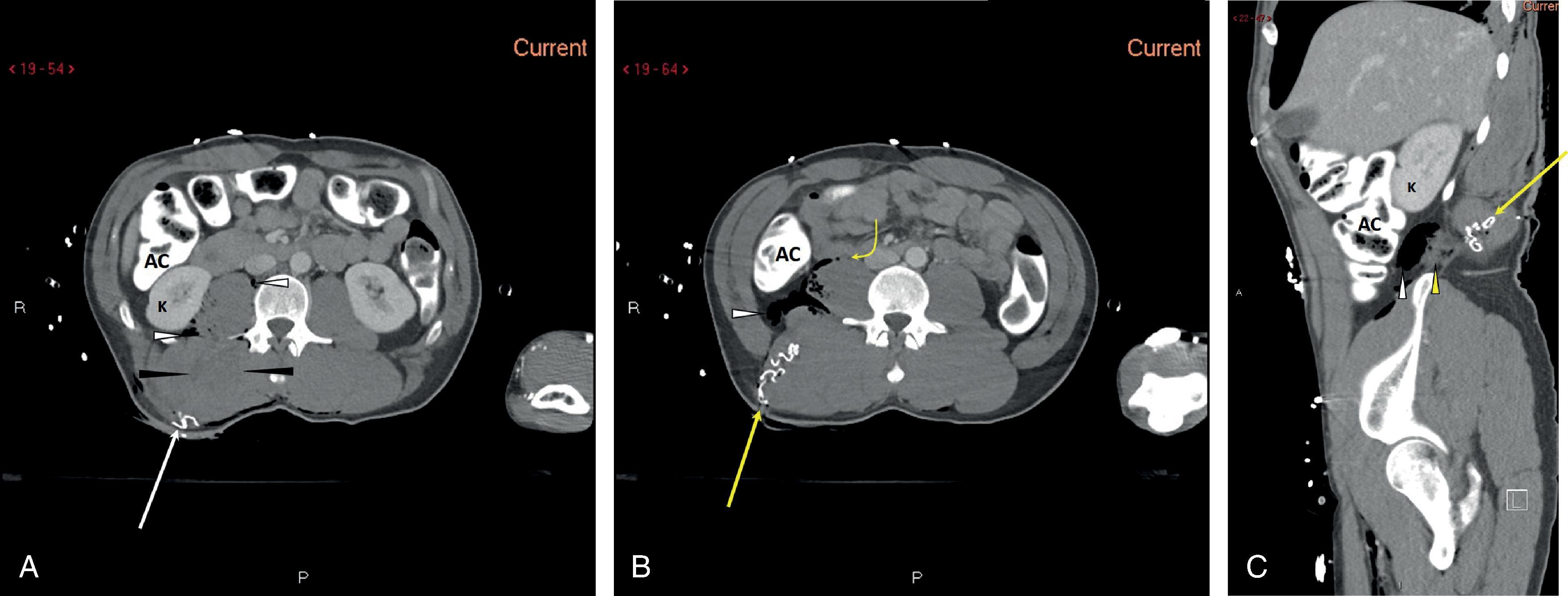
In summary, either serial physical examinations (labor-intensive for surgical team) or triple-contrast CT (labor-intensive for radiology technician) are acceptable diagnostic options, with a delayed diagnosis and laparotomy rate of less than 5%.
In the modern era, there is a tendency for victims facing an assailant holding a handgun to turn away. Also, obesity is present in more than 40% of adults in some states in the United States. This results in numerous patients having oblique missile tracks in proximity to the abdominal contents from the flank to the anterior abdominal wall, from the anterior abdominal wall to the flank, and from one location in the anterior abdominal wall to another.
When physical examination cannot rule out peritonitis, the diagnostic test of choice is abdominal CT with intravenous contrast. A preliminary film will often confirm that the gunshot wound is extraperitoneal. Because the kinetic (muzzle) energy of missiles from handguns is less than 1000 ft lbs (with the exception of a .44 caliber), a shock wave injury to an intraabdominal viscus would be highly unlikely in such a patient. Confirmation of an intraperitoneal track in the patient with a persistent equivocal physical examination should be followed by a triple-contrast CT or a diagnostic laparoscopy in the operating room because 78% to 98% of such patients will have an intraabdominal injury.
Suggestions to choose nonoperative management in asymptomatic patients (e.g., no peritonitis, no hypotension) with gunshot wounds in proximity to the abdomen are now 60 years old. Significant enthusiasm for this approach and large studies on the topic have come from the group at the University of Southern California/Los Angeles County Hospital over the past 25 years. A recent systematic review and meta-analysis of 41 cohort studies with 22,847 patients with abdominal gunshot wounds included 6777 undergoing selective nonoperative management. The pooled estimate of the risk of failure of this approach in 28 studies was 7.0%. Delayed laparotomy was usually precipitated by the development of peritonitis or worsening abdominal tenderness, but the operation turned out to be unnecessary in 28% of these patients. Finally, mandatory use of abdominopelvic CT had a failure rate of approximately one-half that when used selectively.
Therefore, modern selective nonoperative management of gunshot wounds in proximity to the abdomen includes the following: (1) examination of the patient’s abdomen at admission by a senior surgeon, (2) mandatory contrast CT to document whether or not peritoneal or visceral-vascular retroperitoneal penetration has occurred and whether an isolated nonbleeding injury to the liver or kidney is present, (3) “serial” physical examinations for 24 to 48 hours in patients with penetration of the peritoneal cavity or visceral-vascular retroperitoneum. In patients who remain asymptomatic after 24 to 48 hours of observation, specific written instructions are handed to the patient. These state that a new onset of an elevated body temperature, abdominal pain, lightheadedness, hematemesis, rectal bleeding, hematochezia, or hematuria should prompt immediate return to the trauma center. The phone number of the trauma service is included as well.
The patient is placed in the supine position with the upper extremities at the sides. Placing the upper extremities at the patient’s sides allows for easy insertion of self-retaining abdominal retractors and ready access for a median sternotomy. On occasion, there is a high likelihood of the need for a left anterolateral thoracotomy also being performed for an extraabdominal injury (e.g., massive left hemothorax or proximity of missile track to the thoracic esophagus or descending thoracic aorta). In such a patient, the left chest is elevated 30 degrees, and the left upper extremity is rotated superior to the patient. Skin preparation and draping extends from the chin to the knees and encompasses the anterior and lateral trunk. This allows for ready access for retrieval of the greater saphenous vein from the groin and thigh, if needed. Throughout the trauma laparotomy, all of the standard warming maneuvers are used to reverse or prevent hypothermia (increase room temperature, turn up the heating cascade on the anesthesia machine, cover the patient’s head and extremities with a warming device, infuse blood and fluids through a warming device, irrigate tubes [nasogastric, thoracostomy] and open body cavities with warm saline solution if hypothermia is persistent).
In patients with profound preoperative hypotension or a cardiac arrest resulting from presumed intraabdominal hemorrhage, management in the trauma room or operating room has changed over the past 5 years. The addition of a left anterolateral resuscitative thoracotomy with cross-clamping of the descending thoracic aorta is being replaced rapidly by resuscitative endovascular balloon occlusion of the aorta (REBOA). A REBOA device with the balloon inflated at aortic zone I (xiphoid) may restore central blood pressure, slow intraabdominal arterial hemorrhage, and possibly slow intraabdominal venous hemorrhage. Of course, it avoids the extra loss of blood and heat associated with the left anterolateral thoracotomy.
Depending on the patient’s hemodynamic status, the midline incision is not opened until type-specific blood is available in the operating room. Once the peritoneal cavity is opened, blood, clots, and gastrointestinal contents are evacuated using laparotomy pads and a Poole suction device. Sites of hemorrhage in the mesentery, bowel, retroperitoneum, or solid viscera are exposed and controlled with clamps or packing. Then all perforations in the gastrointestinal tract are controlled with bowel, vascular, Babcock, or Allis clamps or a stapling device. Depending on the patient’s hemodynamic status, number and magnitude of gastrointestinal perforations, and associated injuries, the perforations are repaired and the peritoneal cavity is irrigated with a saline-antibiotic solution. Then treatment of injuries to solid organs or to retroperitoneal blood vessels is performed. This sequence is reversed in patients with active visceral or vascular hemorrhage.
As a general rule, the track of a knife or missile wound is followed first, with repair or resection of injuries as needed. Then a formal exploration of every intraabdominal organ including retroperitoneal viscera and vessels, especially those in proximity to the track, is performed. The organs most commonly injured in patients with stab wounds to the abdomen are the liver, small bowel, diaphragm, colon, and stomach. In patients with gunshot wounds, injuries to the diaphragm fall by one-half as compared with stab wounds, and injuries to named abdominal vessels are present in 20% to 25% of patients in large reviews. In any patient with multiple abdominal injuries from a penetrating wound, not just those undergoing a damage-control laparotomy, rapid operative techniques are performed ( Box 3 ).
Single-layer closure of gastrointestinal perforations
Single-layer technique of end-to-end anastomosis
Colon repair instead of colostomy
Delay gastrointestinal reconstruction
Hepatorrhaphy, hepatotomy, resectional debridement, or perihepatic packing instead of formal hepatic resection
Topical agent, suture, or absorbable mesh splenorrhaphy for AASTOIS * grade I to III injury instead of splenectomy
Avoiding placement of drains after visualization or repair of grade I and II hepatic or pancreatic injuries, splenorrhaphy, splenectomy
Single-layer permanent suture repair
Temporary intraluminal shunt instead of complex repair of proximal superior mesenteric artery, common iliac artery, or external iliac artery (same vessels are never ligated without bypass)
Ligation major injury to portal vein, superior mesenteric vein, splenic vein, left renal vein at midline, infrarenal inferior vena cava, common iliac vein, or external iliac vein
* American Association for the Surgery of Trauma (AAST) Organ Injury Scale (OIS).
A damage-control laparotomy is indicated in patients with profound hypothermia (temperature <32°–34°C), metabolic acidosis (pH <7.2), signs of an intraoperative coagulopathy, or some combination of these. This limited laparotomy controls hemorrhage and gastrointestinal contamination only, and it should be completed within 60 to 90 minutes. Leaving the abdominal wall open under a vacuum-assist device or a plastic silo is appropriate after a damage-control laparotomy, when distension of the midgut precludes safe closure or when intraabdominal packs have been inserted. An early reoperation after a damage-control laparotomy is occasionally necessary. This is indicated when there is a continuing need for hourly transfusion of two units of red blood cells after a coagulopathy has been mostly corrected based on monitoring with TEG. Otherwise, a reoperation after an original damage-control procedure is performed when the patient is normothermic, no longer acidotic, not coagulopathic, and has reasonable respiratory and cardiovascular function—usually at 48 to 72 hours. The goals of the first reoperation after a damage-control laparotomy are listed in Box 4 .
Remove and count packs, and confirm the absence of continued bleeding from the liver and retroperitoneum
Inspect all repairs and search for missed injuries
Complete gastrointestinal anastomoses, and/or create a stoma
Insert a nasojejunal feeding tube (avoids gastrostomy or jejunostomy)
Irrigate the abdominal cavity with saline solution containing an antibiotic
Decide if formal suture closure of the linea alba is safe
In patients undergoing laparotomy after abdominal stab wounds, the survival rate is 98%, and only 27% of patients required a blood transfusion in one large review. The most common postoperative complication was an infection in the incision (1.0%).
In patients undergoing laparotomy after abdominal gunshot wounds, the survival rate was 88% (97% in those without an abdominal vascular injury; 61% in those with an abdominal vascular injury) in one large review. The most common postoperative complications were intraabdominal abscess (3.0%), infection in the incision (2.6%), and reoperation for persistent bleeding (2.2%).
Injuries to the diaphragm are relatively uncommon in both blunt and penetrating trauma patients. However, failure to appropriately identify and manage traumatic diaphragmatic injuries (TDI) can lead to serious consequences including compromise of the gastrointestinal tract. With recent advances in imaging modalities and operative techniques, diagnostic and therapeutic approaches to TDI have evolved significantly over the past few decades. The objectives of this chapter are to review the epidemiology, anatomy, and pathophysiology of TDI and discuss current recommendations for evaluation and management of TDI.
A recent study from the National Trauma Data Bank demonstrated that the overall incidence of TDI in trauma patients is 0.46%. Of those, 67% were caused by a penetrating mechanism. A large single-center study including 773 TDI patients over 15 years reported a 40% incidence of right-sided TDI, 57% of left-sided TDI, and 3% bilateral. A higher incidence of left-sided TDI is likely due to the presence of a congenital weakness along the costal and lumber portions of the left hemidiaphragm, and the liver likely provides some degree of protection for the right hemidiaphragm.
The true incidence of TDI, however, is unknown as not all of these injuries are diagnosed during the index presentation. Blunt TDI is typically seen in patients after a motor vehicle collision or pedestrians or bicyclists hit by a vehicle. As blunt TDI is usually caused by high-energy trauma to the thoracoabdominal region, it is a marker for severe associated injuries, and the diaphragm is rarely injured in isolation. Pulmonary injury is the most commonly associated injury, followed by splenic and liver injuries. For penetrating trauma, most TDI are diagnosed in patients with thoracoabdominal gunshot wounds (GSW) or stab wounds (SW). The incidence of TDI following thoracoabdominal GSW is 61%. In a single-center study from a level 1 trauma center in Los Angeles, 37.8% of patients with thoracoabdominal SW were found to have TDI. Similar to blunt TDI, associated intrathoracic and abdominal organ injuries are relatively common in penetrating TDI. In addition to the lung and intraabdominal solid organs, hollow viscus injuries are more commonly seen in penetrating TDI compared with blunt TDI.
TDI left undiagnosed or untreated during the acute phase of treatment can progress to a larger defect size and ultimately chronic traumatic diaphragmatic herniation (TDH) due to radial forces placed on the diaphragm by respiration and the pressure gradient between the thoracic and abdominal cavity. In this latent phase, patients with chronic TDH may not be symptomatic, even with abdominal viscera herniated into the thoracic cavity. If the herniated viscus becomes incarcerated then strangulated, patients can develop symptoms related to mechanical obstruction, ischemia, perforation, and sepsis.
The diaphragm is a dome-shaped musculoaponeurotic barrier that separates the thoracic cavity from the abdominal cavity. It is the main respiratory muscle of the body with expiratory and inspiratory functions. The diaphragm consists of peripheral muscular segments and a central aponeurosis. Muscle fibers originate anteriorly from the xyphoid process of the sternum and laterally, inferiorly, and posteriorly from the costal cartilages and osseous portion of the lower six ribs and the lumber spines ( Fig. 1 ). These fibers insert into the aponeurotic segment known as the central tendon, which underlies the pericardium. There are three openings in the diaphragm. The caval hiatus (T8 level) contains the inferior vena cava and right phrenic nerve; the esophageal hiatus (T10 level) contains the esophagus and bilateral vagus nerves; and the aortic hiatus (T12 level) contains the aorta, thoracic duct and azygous vein. The right dome of the diaphragm is 2 cm higher than the left, accommodating the underlying liver. The arterial supply of the diaphragm comes from superior and inferior phrenic arteries that are direct branches off the thoracoabdominal aorta. Phrenic veins provide venous drainage directly into the inferior vena cava. The diaphragm is innervated by the right and left phrenic nerves that originate from the C3–5 nerve roots. Both nerves pass over the anterior scalene muscle, run along the pericardium, and then terminate on the inferior surface of the diaphragm. Table 1 shows the American Association for the Surgery of Trauma Organ Injury Scale for TDI. Higher-grade injuries are more commonly seen in blunt trauma. Penetrating TDI are often less than 2 cm in size.
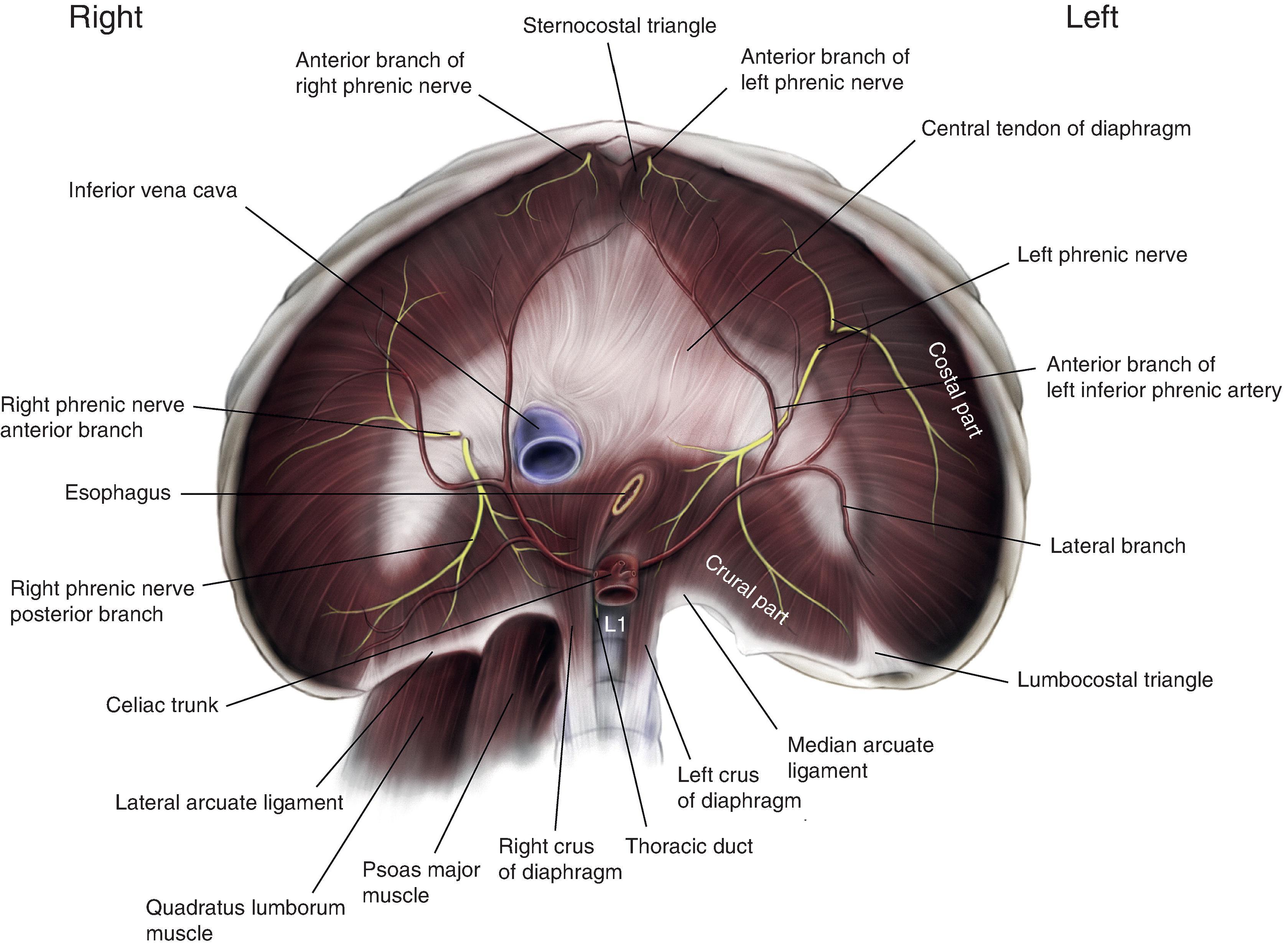
| Grade * | Injury Description |
|---|---|
| I | Contusion |
| II | Laceration ≤2 cm |
| III | Laceration 2–10 cm |
| IV | Laceration >10 cm with tissue loss ≤25 cm 2 |
| V | Laceration with tissue loss >25 cm 2 |
* Advance one grade for bilateral injuries. From Moore EE, Malangoni MA, Cogbill TH, et al. Organ injury scaling. IV: thoracic, vascular, lung, cardiac, diaphragm. J Trauma . 1994;36:299–300.
For patients undergoing laparotomy after blunt trauma, the diaphragm must be inspected for injury. Practically, because it is unusual to have an isolated TDI, the majority are diagnosed intraoperatively during laparotomy performed for other indications. For the rare patient with TDI who does not undergo operative intervention, the diagnosis can be challenging. Patients with TDI are often asymptomatic, particularly those with a small defect, especially on the right side. During the initial trauma assessment, there are no adequately sensitive clinical signs to ensure the definitive diagnosis of an underlying TDI. Although “classic” physical findings such as unilateral decreased breath sounds or bowel sounds heard in the chest have been described as alarming signs of TDI, these are neither sensitive nor specific. Therefore, it is important to have a high index of suspicion for TDI in all patients with evidence of severe thoracoabdominal force application.
The chest radiograph (CXR) obtained during the initial workup is rarely diagnostic of TDI, unless the diaphragm defect is large and intraabdominal contents have herniated into the chest. These classic radiographic signs more common in patients with chronic TDH ( Fig. 2A, B ). Most patients with acute TDI have a normal CXR or nonspecific signs such as an obscured diaphragmatic contour or elevation of the left hemidiaphragm ( Fig. 3A, B ). Historically, the sensitivity of CXR is poor, ranging from 27% to 68% and 17% to 33% for left- and right-sided TDI, respectively. In a recent multicenter study, the diagnosis of TDI was suspected on CXR in only 11% of patients.
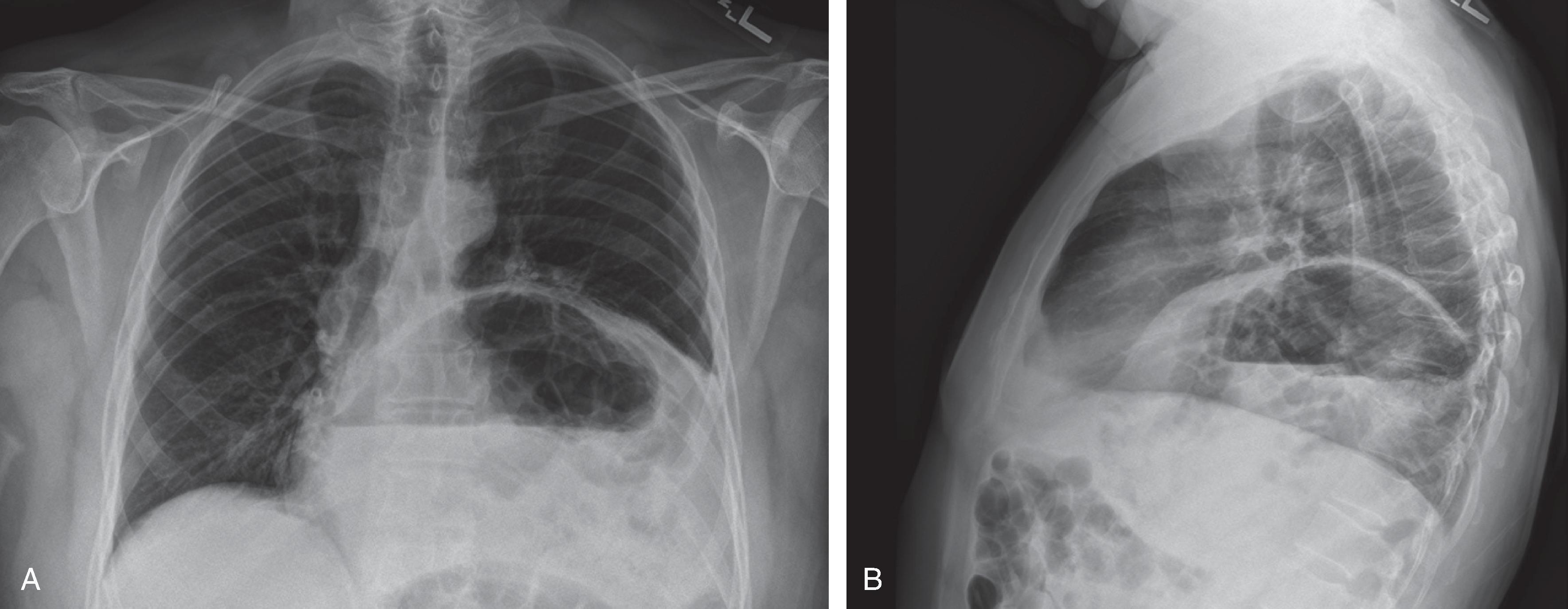
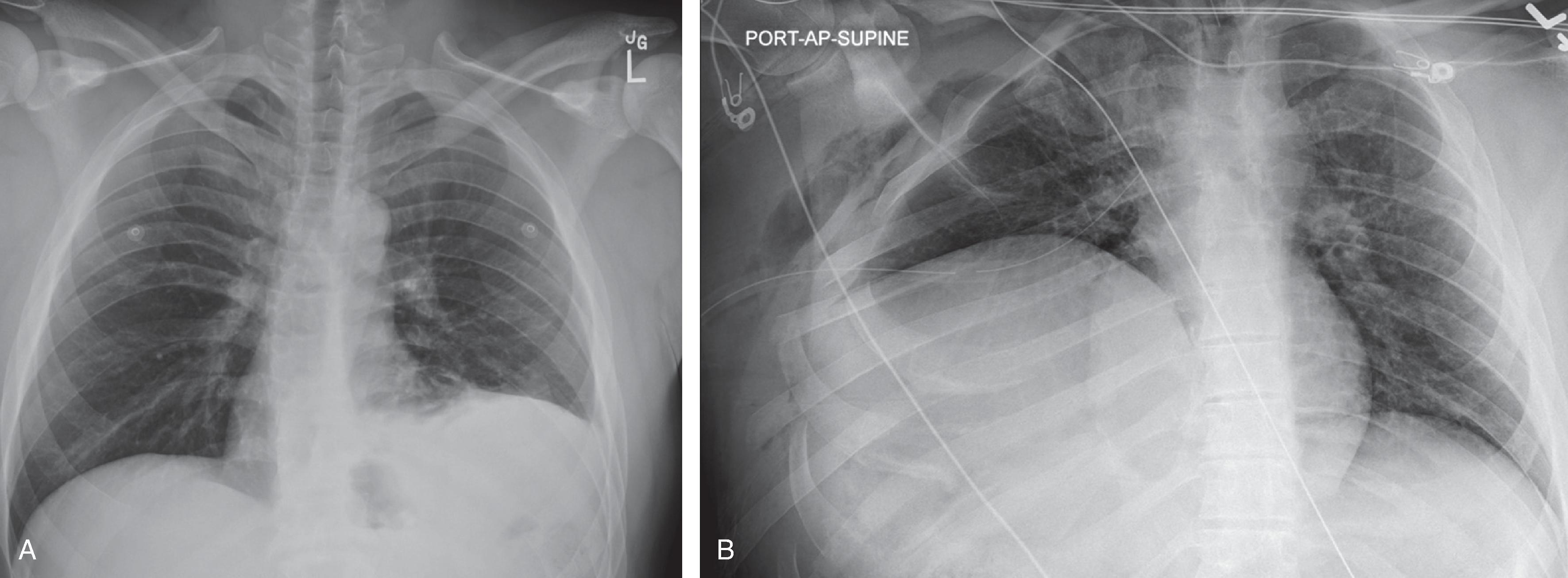
With the increasing use of newer generation multidetector computed tomography (MDCT) as a mainstay of the diagnostic workup in trauma, the diagnosis of TDI is now more frequently made preoperatively. The diagnostic accuracy of MDCT is significantly better than CXR due to advances in data acquisition and multiplanar reformatting. Segmental defects in the diaphragm are the most common and sensitive sign of TDI in blunt trauma ( Fig. 4 ). In addition, several CT findings of TDI and associated visceral herniation have been described ( Fig. 5A, B ). Recent studies have shown MDCT sensitivities upward of 61% to 87% and specificities of 72% to 100% for detecting blunt TDI.
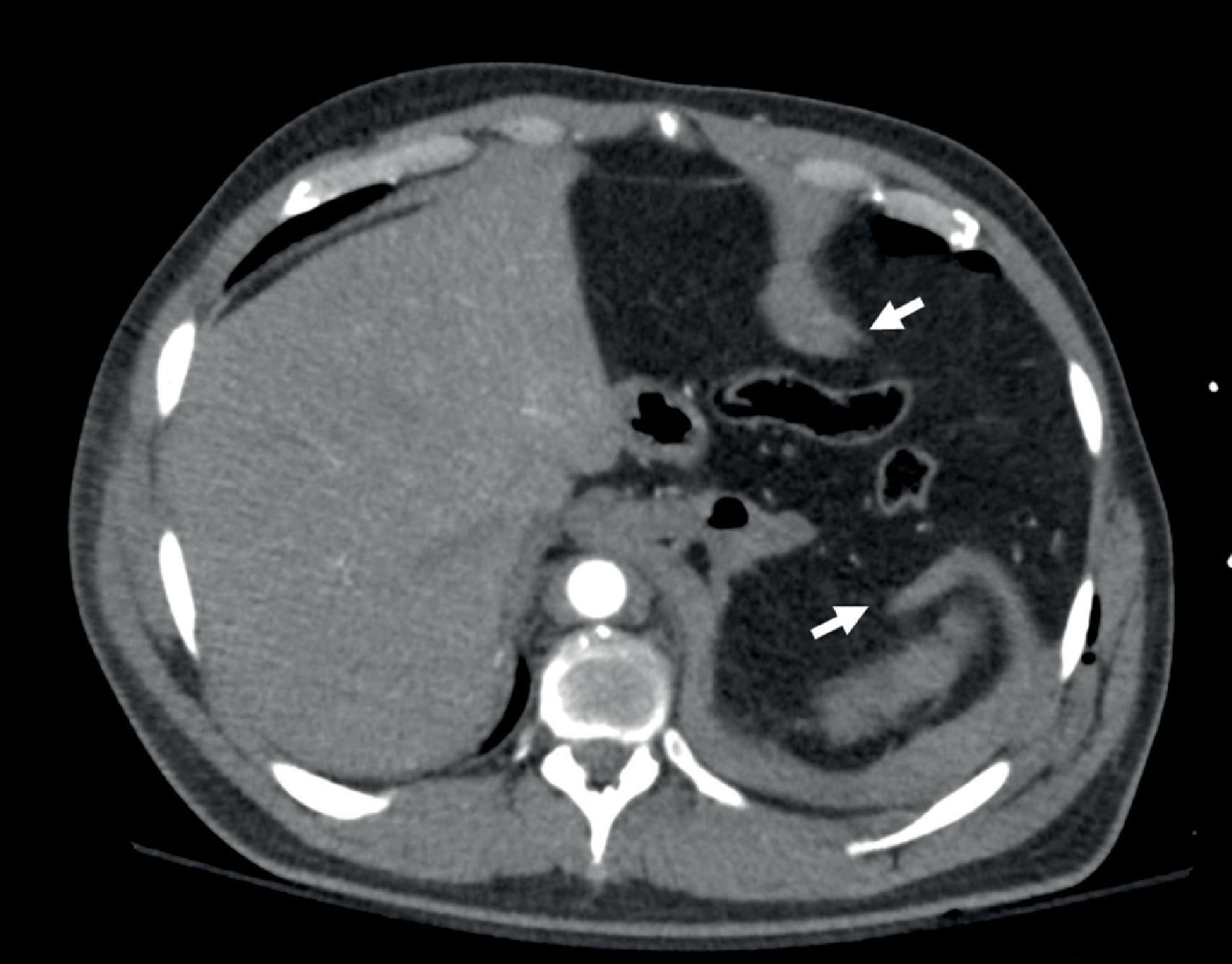
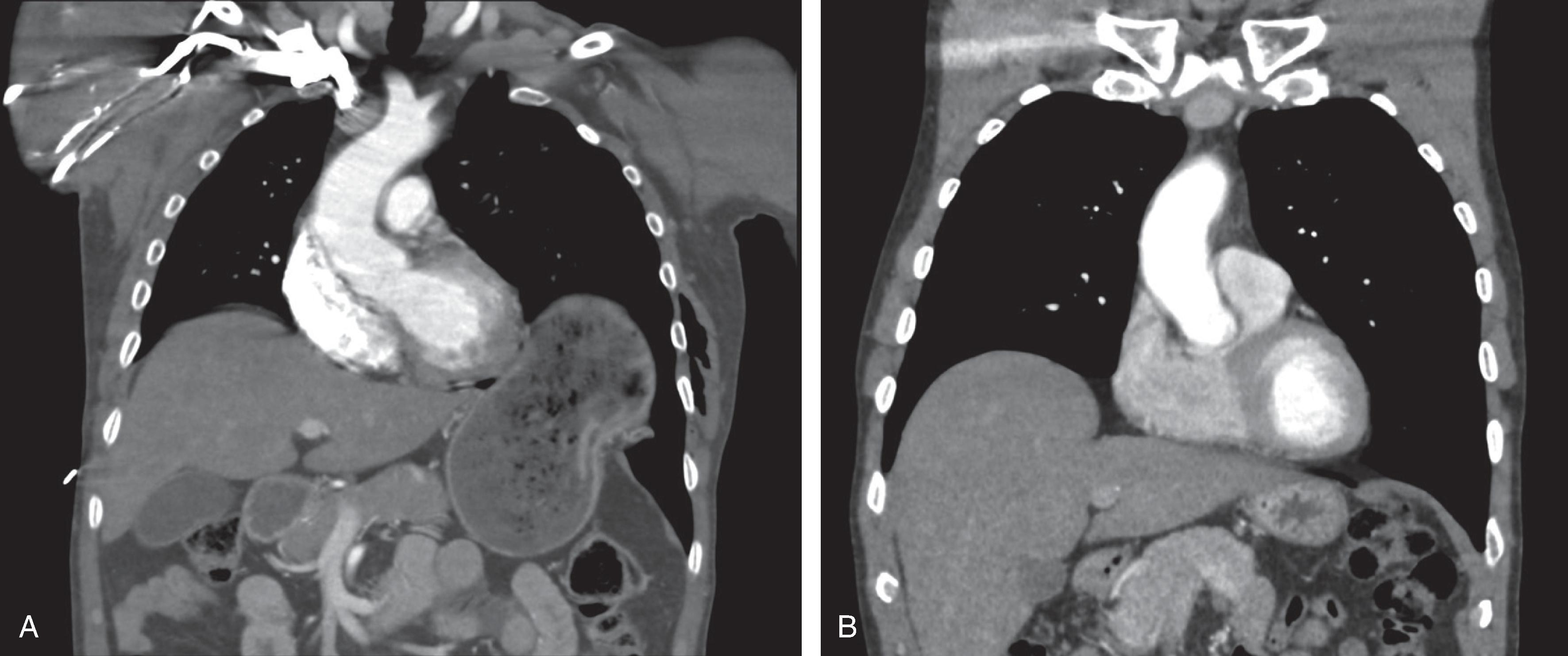
It should be noted that there is no definitive screening modality that is perfectly sensitive for TDI. The gold standard for those with suspicious imaging is direct operative visualization.
For patients who have sustained penetrating thoracoabdominal trauma, the approach is very different from blunt injury. Many of these patients who have been shot or stabbed will undergo urgent laparotomy, and the diaphragm should be visually inspected at this time. For those patients who meet criteria for a trial of nonoperative management, however, reliance on imaging for definitive diagnosis of TDI is even more difficult than in blunt trauma, as the defects are generally very small. Often, the best that can be expected from CT is collateral evidence of injury, for example, with an entrance wound in the chest wall, a visible bullet tract through the lung, a spleen injury on the other side of the diaphragm, or a retained bullet in the abdominal wall. Therefore, our recommendation for patients who have sustained a thoracoabdominal penetrating injury undergoing nonoperative management is to utilize diagnostic laparoscopy for definitive diagnosis. This is a high-yield process; a prospective study performed at our center found an occult TDI rate of 26% in SW and 13% in GSW patients at laparoscopy.
Right-sided injuries are unlikely to result in a clinically significant complication, but for left-sided injuries in the region bounded by the nipple to scapular tip superiorly and costal margin inferiorly ( Fig. 6 ), we start with a 24-hour observation period. If the patient develops peritonitis or any other indications for laparotomy, the diaphragm can usually be inspected at that time. If, however, the patient passes this period of observation, diagnostic laparoscopy is then performed specifically to visualize the left diaphragm, as injuries to the remainder of the hollow viscus have already been excluded ( Fig. 7 ). It is critical that insufflation be performed cautiously. Any evidence of building tension physiology from the TDI, with increasing peak inspiratory or plateau pressures, hypoxia, or hypotension, will require immediate release of pressure and tube thoracostomy. If an injury is found, it can then be repaired laparoscopically. Because the defects in these cases are usually very small, primary repair with a nonabsorbable suture should always be attempted ( Fig. 8 ). Alternatively, if after the period of observation the patient requires a concurrent thoracic procedure, for example, to wash out a retained hemothorax, a video-assisted thoracoscopic approach may be utilized.
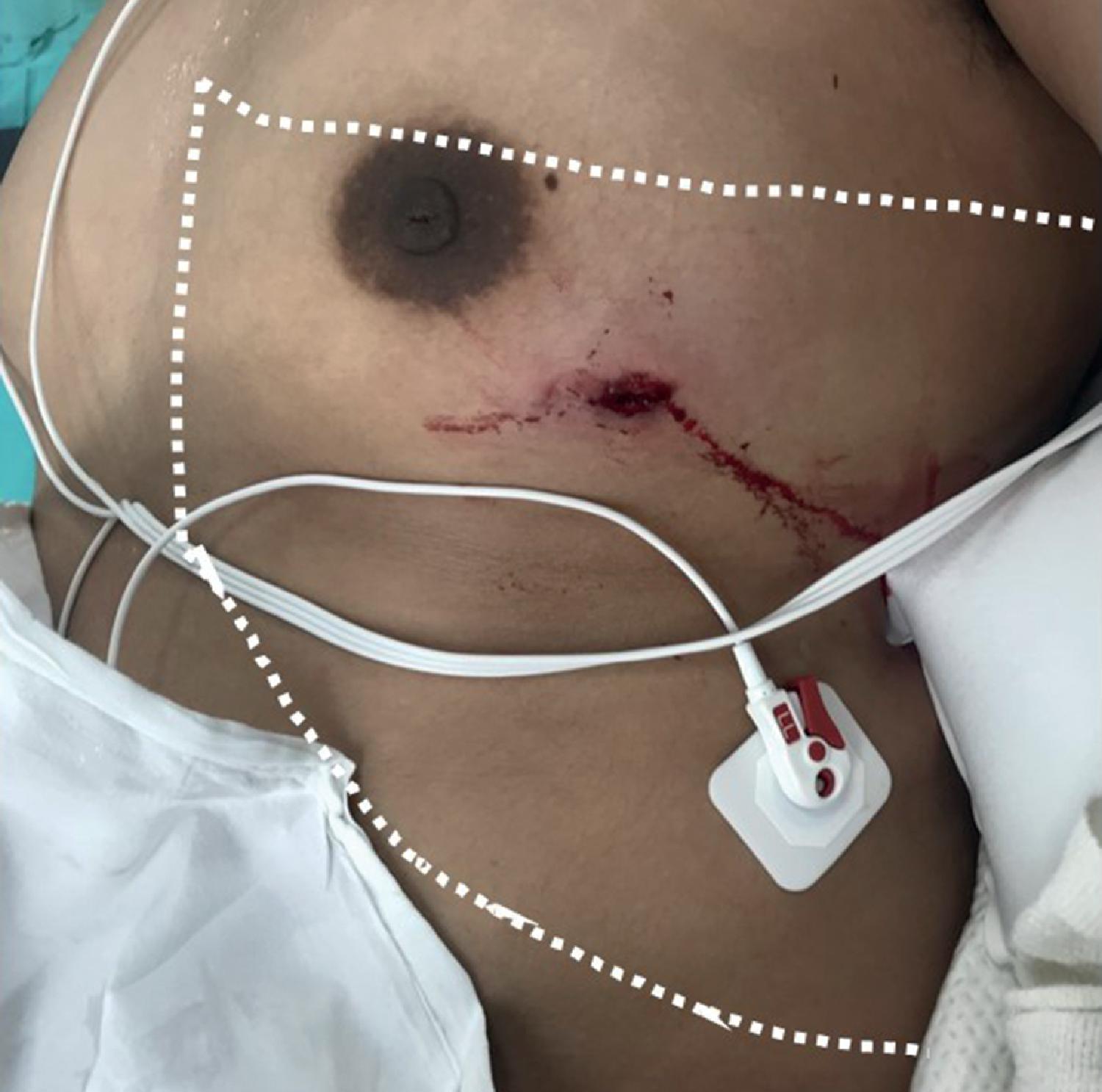
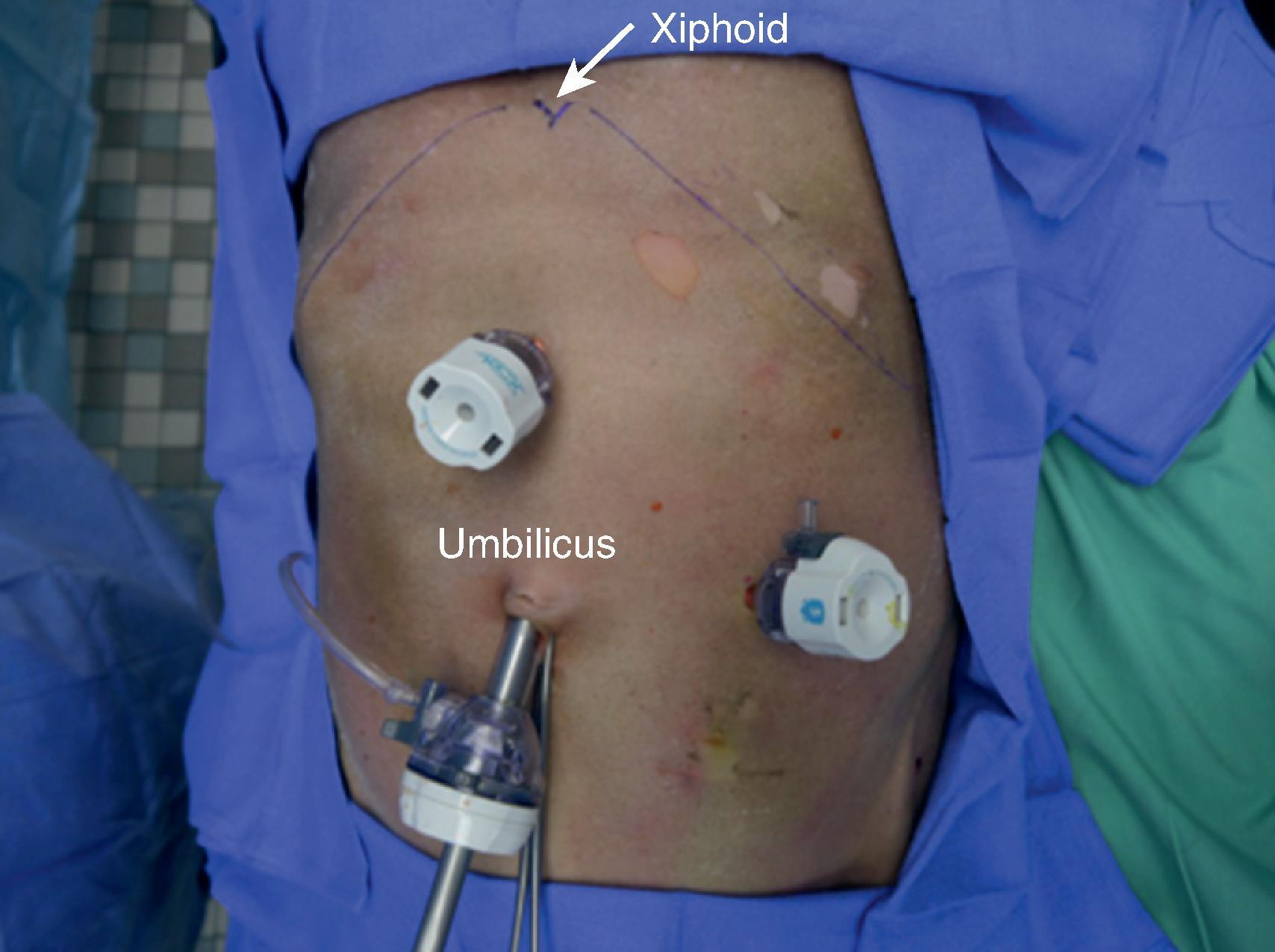
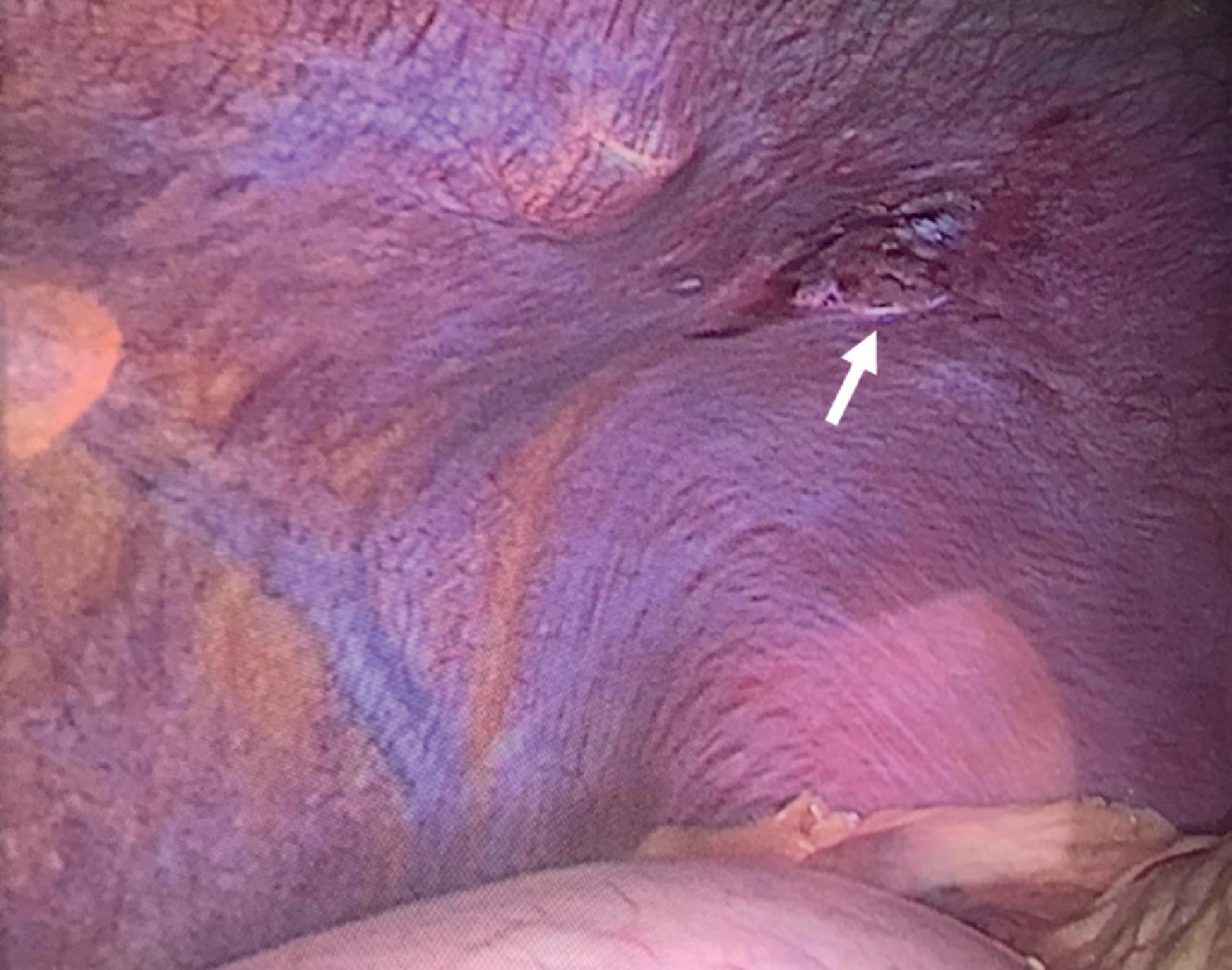
As discussed earlier, due to the high incidence of associated intraabdominal injuries, the majority of blunt diaphragmatic injuries are diagnosed and repaired acutely through a laparotomy performed for other indications. If, however, the diagnosis of TDI is made preoperatively on imaging, the diaphragm can be repaired via laparotomy or thoracotomy. For acute injuries, it is strongly recommended that an abdominal approach using a midline laparotomy rather than a thoracic approach be utilized due to the high incidence of associated intraabdominal organ injuries ( Fig. 9A ).
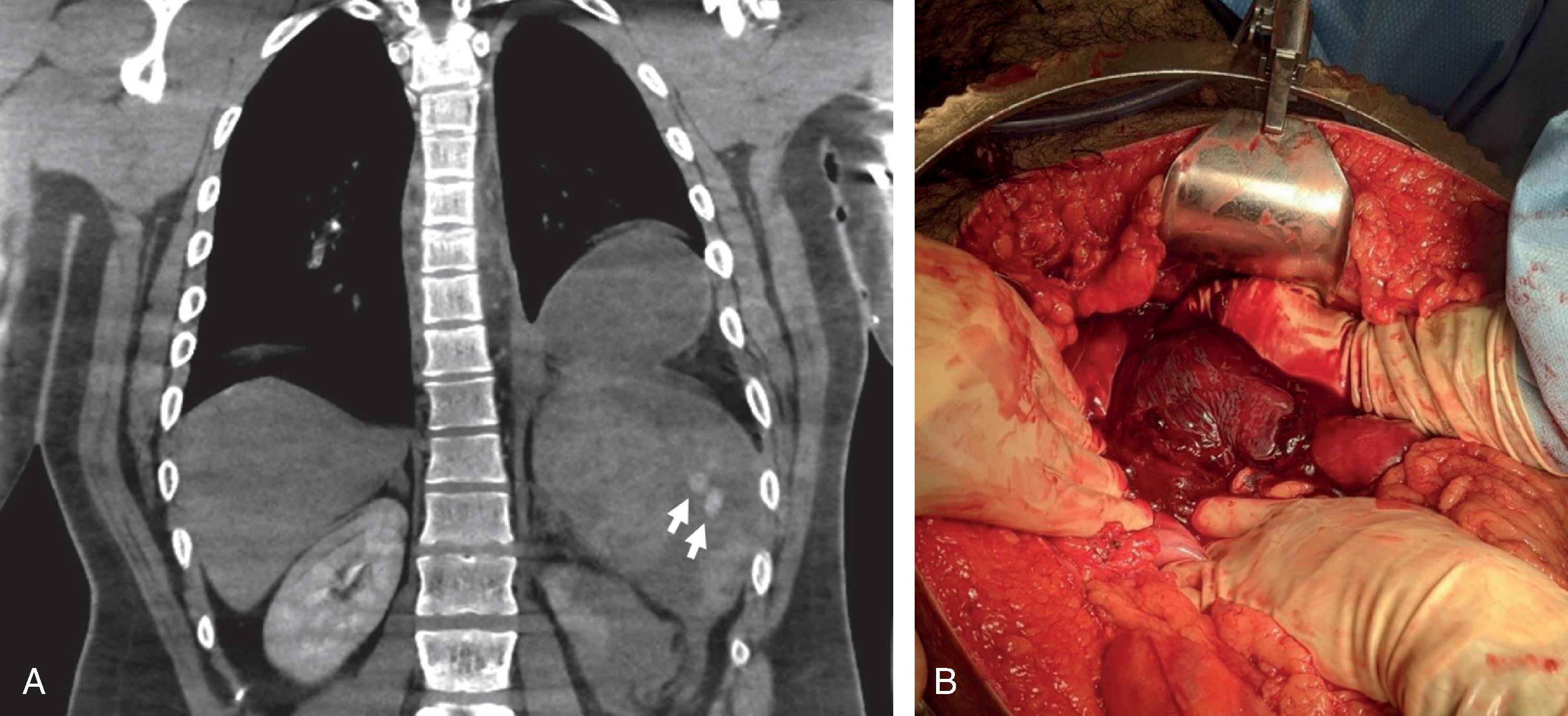
In general, the intraoperative management of TDI includes reduction of any herniated intraabdominal organs followed by repair of the diaphragmatic defect. The left upper quadrant organs such as the stomach, spleen, or colon can be herniated through the diaphragmatic defect. In the acute setting, it is usually easy to reduce these organs back into the abdominal cavity. Positioning the patient in reverse Trendelenburg with the right side down may help with this maneuver. An inspection of the herniated organs is then performed for any associated injuries ( Fig. 9B ). After the reduction of any herniated contents, the diaphragm can be fully evaluated for the defect size and presence of any tissue loss. Allis or Kocher clamps are applied to the wound edges, bringing the defect into the wound for better exposure of the injury ( Fig. 10A ). This maneuver is particularly useful for large defects or those involving the posterior portion of the diaphragm. Intrathoracic injuries can also be evaluated through the diaphragmatic defect and treated at this time if necessary. Any retained hemothorax should be evacuated through the defect and lavage of the thoracic cavity should be performed, especially if there is any significant contamination due to associated hollow viscus injuries. A thoracostomy tube is normally placed at this time.

Before surgical repair of the diaphragm defect, debridement of devitalized edges is usually required. As the diaphragm is very redundant, in the vast majority of cases, even high-grade injuries can be repaired primarily without any negative physiologic effect on pulmonary function. Size 0 or 1 nonabsorbable monofilament sutures are often used for the primary repair of TDI. The type of repair has not been shown to have any association with the incidence of postoperative complications or recurrence rate. Both interrupted figure-of-8, mattress, or simple sutures and running repairs can be performed ( Fig. 10B ). Although it is extremely rare, the use of prosthetic or biologic mesh products may be required for a very large size defect associated with tissue loss. This is extremely rare, and there is insufficient data in the trauma patient population to recommend a specific mesh type. Based on the congenital diaphragmatic hernia evidence and our experience, the use of a tension-free polytetrafluoroethylene (PTFE) mesh is a practical option.
For diaphragmatic injuries that have been avulsed off the chest wall, in most cases, the remnant cuff of diaphragm can be used as a guide to reattachment, as well as an anchor for the sutures. There is a natural redundancy in the diaphragm that will compensate for any tissue loss and allow reconstruction. If, however, the defect is large and it is not possible to reattach the diaphragm to its original location, the natural curvature of the diaphragm facilitates repositioning of the attachment point higher up on the chest wall. By moving the attachment point several rib spaces up, a tension-free repair can usually be achieved. Failing this, prosthetic material can be used to bridge the gap.
For chronic TDH, surgical intervention is usually indicated. For patients in the latent phase, preoperative workup including cardiopulmonary function may be followed by semi-elective repair. In contrast, patients who present with evidence of obstruction or strangulation should be taken for emergent repair, as high morbidity and mortality rates have been documented with any delay. There are two operative approaches for chronic TDH repair, transthoracic and transabdominal. Furthermore, minimally invasive techniques can be considered if tolerated by the patient. There should not be any hesitation converting to an open procedure or opening the cavity on the other side of the diaphragm to facilitate access, content reduction, and reconstruction in cases with severe adhesions or unclear anatomy.
Patient outcomes following TDI are dependent primarily on the burden of associated injuries and physiologic status of the patient. Specific known clinical predictors for mortality following TDI include advanced age, higher injury severity score (ISS), and associated cardiac injury. The mortality rate documented in previous case series ranges from 0% to 35%. Among patients with TDI submitted to the National Trauma Data Bank in 2012, in-hospital mortality was significantly higher in patients who sustained blunt TDI (19.8% vs. 8.8%) with a higher mean ISS (33 vs. 24) compared with penetrating TDI. In addition, the length of hospital and intensive care unit (ICU) stay and ventilator days were longer in the blunt TDI group.
The complications reported in patients with TDI are most often related to their associated injuries. Postoperative complications following diaphragm repair can include a disruption of the repair site, phrenic nerve injury, and surgical site infections. Failure of the diaphragm repair is more commonly seen with large defect size or avulsion injuries following blunt trauma. Paralysis of the hemidiaphragm secondary to phrenic nerve injury may be caused by the traumatic injury itself or can occur during the repair. For diaphragm injuries just lateral to the esophageal or caval hiatus, care must be taken to look for the phrenic nerves to prevent iatrogenic injury. Postoperative infectious complications following the diaphragm repair include subdiaphragmatic abscess and empyema. Although the incidence of empyema is very rare, in patients with TDI who survived more than 48 hours after admission, postoperative empyema was associated with prolonged hospital and ICU stay.
Diaphragmatic injuries are often diagnosed and repaired at the time of laparotomy performed for other associated injuries. For isolated blunt TDI, as the sensitivity of CT is not perfect, a high index of suspicion is required. Acute injuries should be repaired through an abdominal approach. For penetrating left thoracoabdominal injuries in patients undergoing nonoperative management, diagnostic laparoscopy is the mainstay of diagnosis and, if required, treatment. The majority of diaphragmatic injuries can be repaired primarily. For large defects that cannot, a prosthetic bridge can be utilized.
Given its large size and location, the liver is a commonly injured organ in both blunt and penetrating trauma. Although mortality rates from high-grade liver trauma remain significant, evolving management of these injuries has led to improved outcomes. Traditionally, operative intervention alone was considered the standard of care. However, with the introduction of damage-control laparotomy, selective nonoperative management (SNOM), and endovascular intervention, a multi-pronged approach is now crucial in decreasing mortality in these potentially fatal injuries. Although an understanding of liver anatomy is important, liver trauma and the operations to address traumatic injury rarely follow the rules of elective surgery. Operative liver trauma is governed by the principles of rapid hemorrhage control and preservation of maximal parenchymal tissue, particularly at the index operation. Because these patients often present in extremis, the surgeon must have an algorithm and a mental tool kit readily available to act expeditiously in these high-acuity situations.
The initial evaluation of all trauma patients should follow standard Advanced Trauma Life Support (ATLS) principles. The initial hemodynamic status and stability of the patient must be assessed immediately as it will dictate further management. Intravenous access should be obtained on the patient’s arrival. A rapid but comprehensive primary and secondary survey should be done to assess for other injuries along with appropriate x-rays and focused assessment with sonography in trauma (FAST). The FAST examination, although useful in detecting hemoperitoneum, is not specific in identifying the source of intraabdominal bleeding. A positive FAST in the setting of hypotension is typically an indication for operative intervention; however, a positive FAST in and of itself does not require operative intervention.
Once the initial evaluation is complete and appropriate resuscitation initiated, the next phase of management in patients with suspected abdominal trauma is guided by the hemodynamic status and the physical examination. Early blood product resuscitation should be considered in patients with suspected ongoing hemorrhage or hemodynamic instability. Patients with peritonitis belong in the operating room. Patients with ongoing hypotension with a suspected abdominal hemorrhagic source also belong in the operating room, irrespective of peritonitis.
For the hemodynamically unstable patient with suspected ongoing abdominal hemorrhage, a resuscitative endovascular balloon occlusion of the aorta (REBOA) may be considered as a bridge to definitive hemorrhage control. If the source of bleeding is below the level of the diaphragm, a REBOA may be inflated in zone I (between the left subclavian artery and celiac trunk). A chest x-ray is performed to evaluate for thoracic hemorrhagic source or aortic injury. If neither is suspected, a sheath may be placed in the common femoral artery and a REBOA inserted to support hemodynamics en route to the operating room or hybrid suite. The REBOA should be deflated and removed expeditiously along with the sheath to avoid distal ischemia. Placement of a REBOA or other endovascular balloon should not delay transport to definitive hemorrhage control.
If the patient responds to resuscitation or is hemodynamically normal, a CT scan with intravenous contrast may provide additional key clinical information. Cross-sectional imaging allows for further evaluation, not only of hepatic injury but also of the associated injuries that are common in the setting of high-grade liver injury ( Fig. 1 ). The American Association for the Surgery of Trauma (AAST) liver injury grading scale is a standardized way to categorize severity of liver injuries based on imaging ( Table 1 ). Based on the overall clinical picture and the imaging findings, the decision for operative or angiographic intervention can be determined.
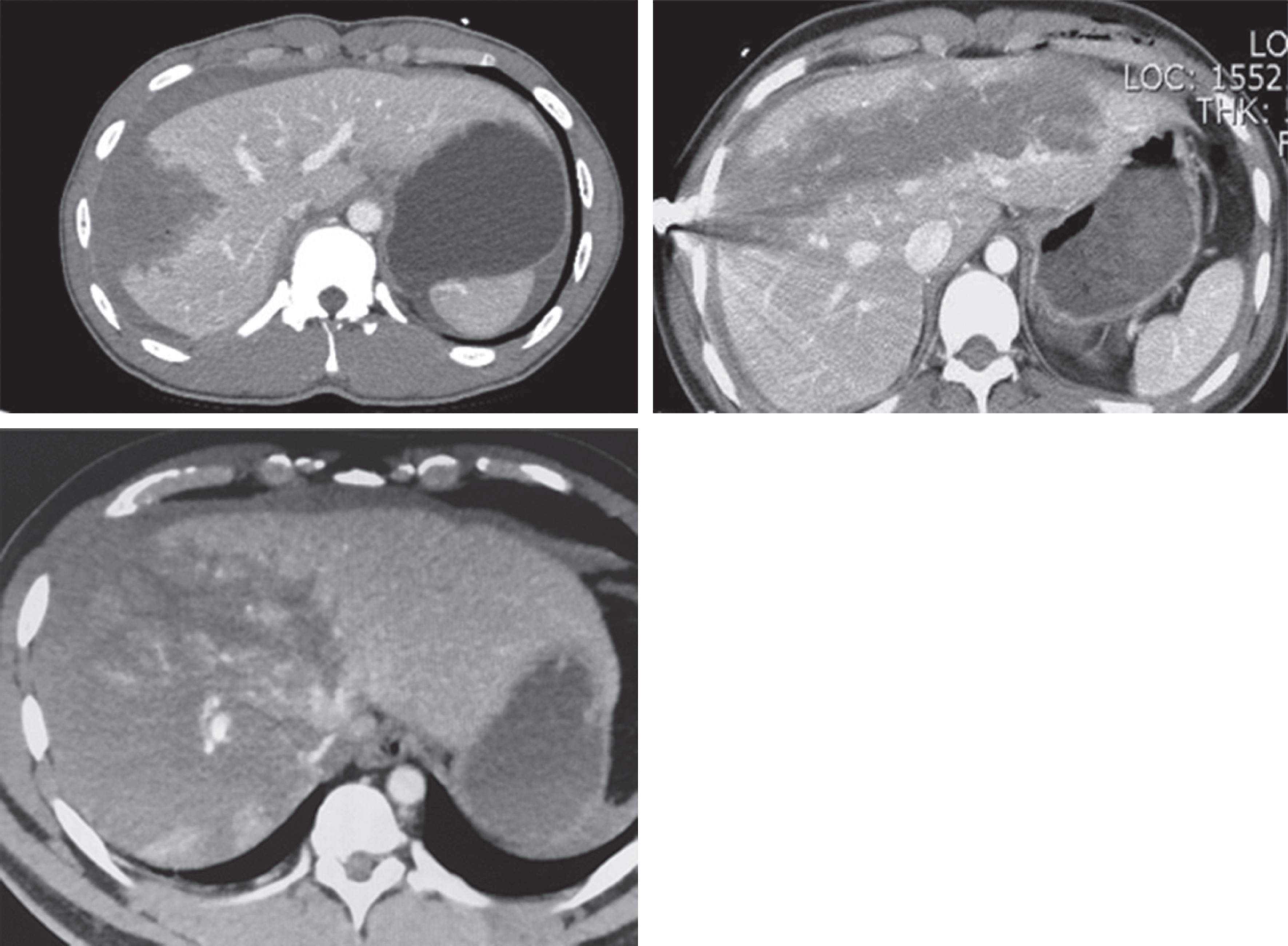
| Grade | Injury | Description |
|---|---|---|
| I | HematomaLaceration | Subcapsular, 10% surface areaCapsular tear, <1 cm parenchymal depth |
| II | HematomaLaceration | Subcapsular, 10%–50% surface areaIntraparenchymal, <10 cm diameter1–3 cm parenchymal depth, <10 cm length |
| III | HematomaLaceration | Subcapsular, >50% surface area or expanding; ruptured subcapsular or parenchymal hematoma>3 cm parenchymal depth |
| IV | Laceration | Parenchymal disruption involving 25%–75% of hepatic lobe or 1–3 Couinaud segments in a single lobe |
| V | LacerationVascular | Parenchymal disruption involving >75% of hepatic lobe or >3 Couinaud segments within a single lobeJuxtahepatic venous injuries (i.e., retrohepatic vena cava/central major hepatic veins) |
| VI | Vascular | Hepatic avulsion |
For trauma patients who remain hemodynamically normal and do not have peritonitis, SNOM for both blunt and penetrating hepatic injuries has become the standard of care. Fundamental to this concept is the use of cross-sectional imaging and reliable serial abdominal examinations to thoroughly evaluate for associated intraabdominal injuries, which can be common in the setting of high-grade liver injury. Although SNOM has long been the standard for blunt abdominal injury, this algorithm in the setting of penetrating trauma has gained recent support. Contemporary studies have shown that isolated penetrating liver injuries managed nonoperatively result in shorter hospital length of stay and fewer complications.
Whether the liver injury is caused by blunt trauma or penetrating trauma, the principles of SNOM are similar and consist of close monitoring to rule out ongoing hemorrhage as well as associated hollow viscus injury. Patients are admitted to a monitored setting with serial laboratory tests and abdominal examinations, ideally by the same provider team. The provider team should consider that an increasing grade of hepatic injury is associated with an increased risk of failing SNOM. Hemodynamic instability or worsening abdominal examination are indicators that the patient is failing SNOM and requires operative intervention. If the patient fails SNOM, expeditious exploration is imperative. Therefore, SNOM might not be possible in rural or austere environments or in the setting of minimal providers, and a lower threshold for operative exploration after initial assessment is prudent.
Endovascular techniques have become a critical component in the management of liver trauma. Patients who are hemodynamically stable or transient responders may be candidates for angioembolization. Typically, a CT scan with intravenous contrast will identify embolization targets based on contrast extravasation or the presence of a pseudoaneurysm or arteriovenous fistula ( Fig. 2 ). Although angioembolization may also be used as an adjunct to operative intervention, many injuries are managed with endovascular techniques alone with high success rates and improvement in overall outcome. Despite the success of endovascular techniques, it is important to remember that some patients will require operative intervention despite successful angioembolization, either for ongoing hemorrhage or for associated hollow viscus injury. In addition, patients who undergo angioembolization must be carefully selected, as liver necrosis is a common complication following embolization.
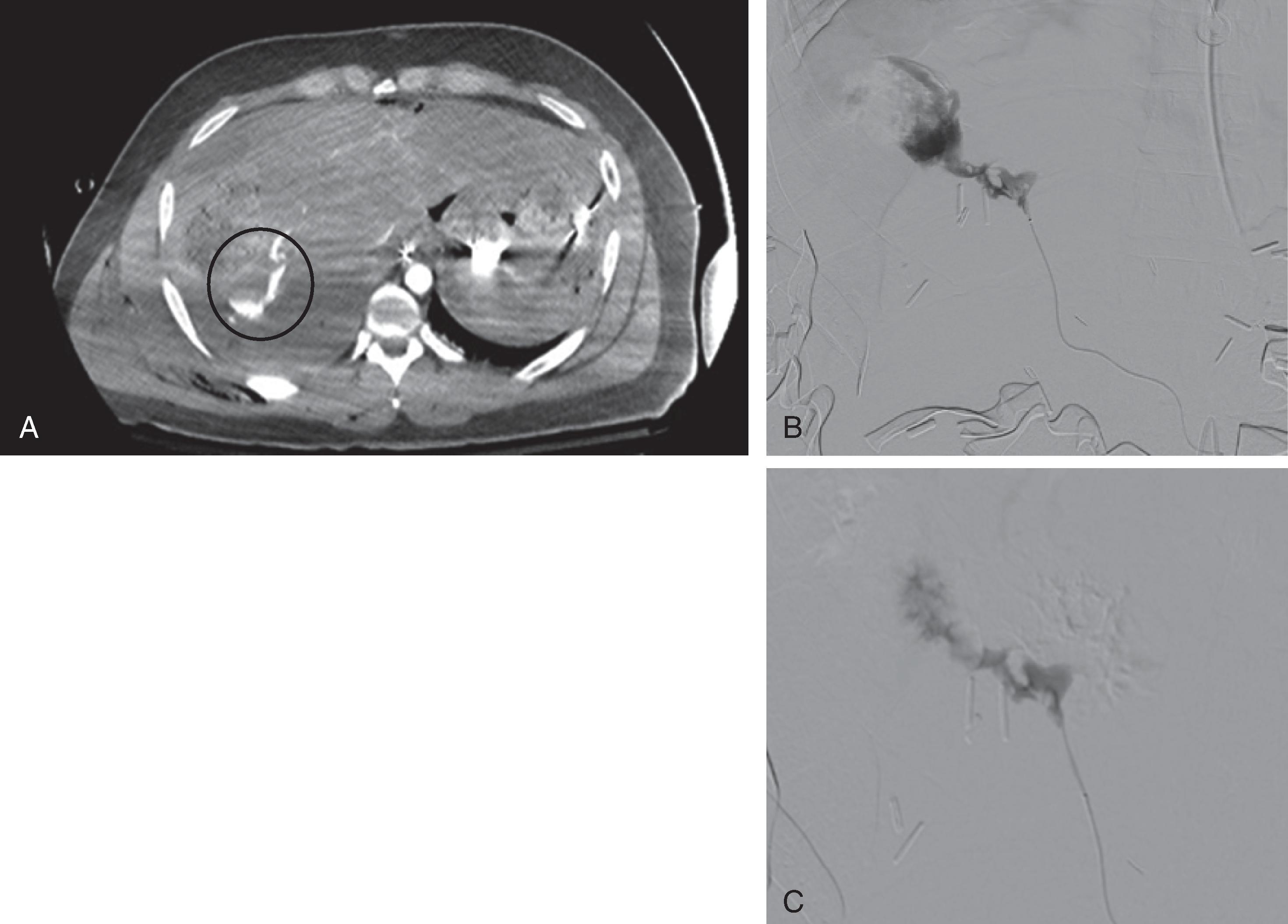
Although SNOM has transformed the algorithms used to manage both blunt and penetrating hepatic injury, a solid understanding of operative technique in tackling these difficult cases is paramount. In patients who require operative intervention for their liver injury, hemorrhage can be brisk, and the operative strategies can be challenging for even the experienced trauma surgeon. For these reasons, massive transfusion protocols should be considered early, and balanced resuscitation with adjuncts such as thromboelastography (TEG) are considered critical. In addition, clear and ongoing communication with the anesthesia team is crucial.
The patient should be prepped from the neck to the knees to obtain adequate exposure and also to have access to vascular structures for hemorrhage control or venous conduit if needed. Adequate central access, preferably above the diaphragm, should be obtained immediately if not done before the patient is brought to the operating room. A midline laparotomy from the xiphoid process down to the pubis symphysis is the initial incision of choice. If additional exposure is needed, particularly for access to the retrohepatic vena cava, a right subcostal extension may be included. Additional access to the dome of the liver and the suprahepatic vena cava can be obtained via a right thoracotomy or a median sternotomy.
Upon entry into the abdomen, a rapid evaluation for hemorrhagic source should be conducted in the standard fashion and sources of gross enteric spillage controlled using temporary techniques. In the setting of liver trauma, the first step is to divide the falciform ligament along the anterior surface of the liver, taking care not to disturb the hepatic veins at the level of the diaphragm. This allows for more effective packing and minimizes traction injury to the liver. The liver is then packed with laparotomy pads, medializing the parenchyma starting from the dome of the liver and placing pads between the diaphragm and the liver posteriorly ( Fig. 3 ). To be successful, the liver should effectively be sandwiched between anterior and posterior laparotomy pads that are tightly packed, taking care not to occlude flow through the inferior vena cava (IVC). This allows for time to inspect the remainder of the abdomen and for anesthesia to progress with their resuscitation. If packing provides hemorrhage control, do not continue with dissection of the liver attachments as doing so can often release the natural tamponade that the attachments provide. Instead, consider the option of damage-control laparotomy with delayed reoperation after taking the patient to the intensive care unit (ICU) for further resuscitation or for angioembolization. If packing is ineffective or if there is increased hemorrhage with anterior displacement of the liver, strongly suspect a retrohepatic vena cava or hepatic vein injury, and begin early preparations for repair.
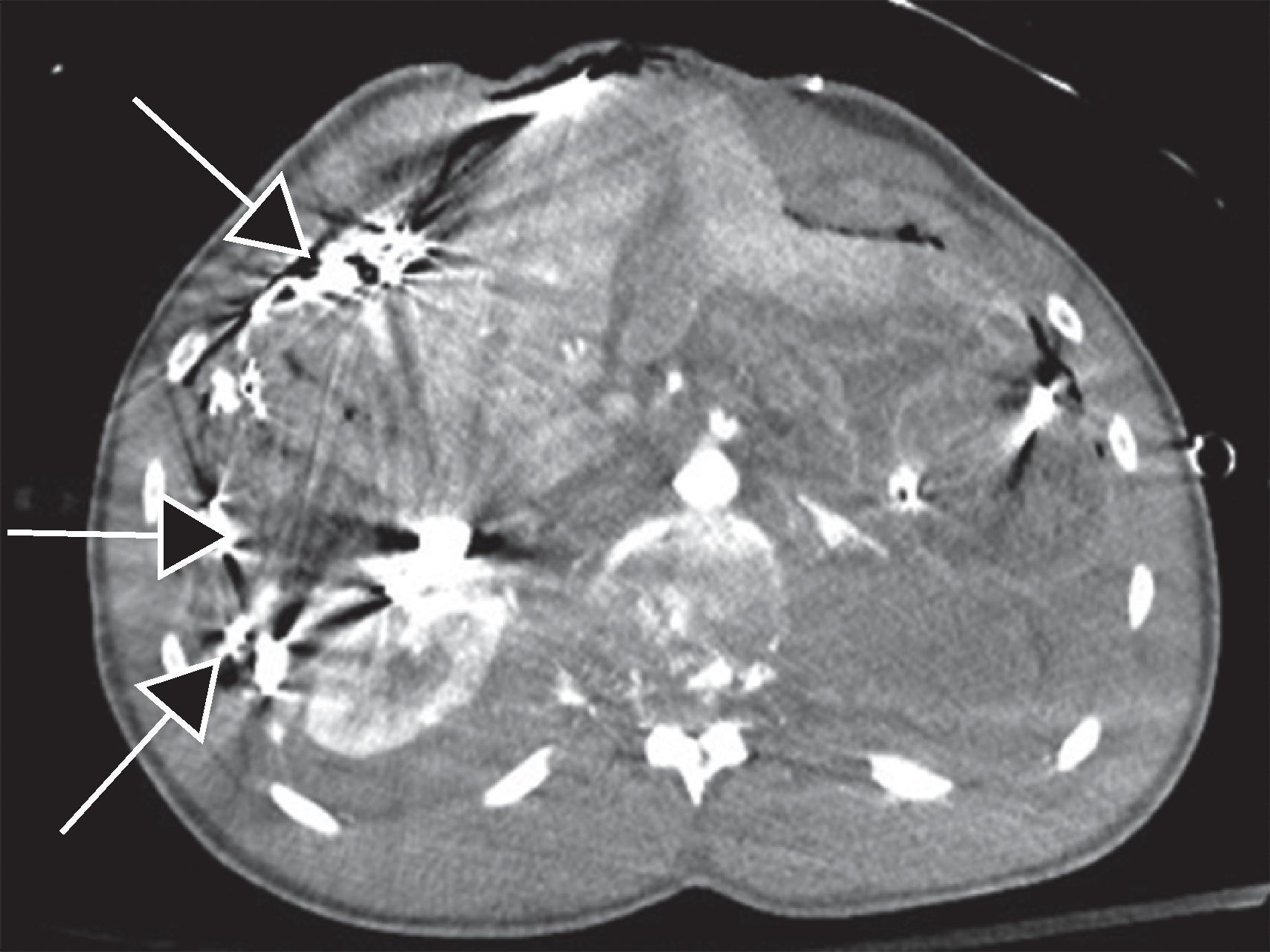
A combination of techniques may be required in the severely damaged liver with the primary goal of rapid hemorrhage control to prevent coagulopathy and further physiologic derangements. For minor lacerations, hemostasis can often be achieved with electrocautery or argon beam coagulation. Topical hemostatics are a useful adjunct, and hemostasis is often achieved with patience, tactical placement, and pressure. Several topical hemostatics are effective, and availability is based on each institution. In addition to topical hemostatics, a tongue of omentum can be used to provide hemostasis in a liver laceration.
Simple sutures with a large, blunt-tipped absorbable suture such as 0 chromic or 0 PDS can be used to reapproximate parenchyma. The liver parenchyma is very fragile, so great care must be taken to incorporate intact liver capsule in the repair to avoid further damaging the parenchyma. Simple interrupted sutures or horizontal mattress sutures allow for adequate approximation of the parenchyma. The sutures must be secured gently to avoid further fracturing of the liver parenchyma.
In the setting of penetrating trauma, placement of a balloon catheter through the tract with gentle inflation of the balloon can aid in immediate hemorrhage control. A Foley catheter, Blakemore tube, or Penrose drain on a red rubber catheter can be used for this purpose. The catheter is inserted and the balloon or lumen inflated until resistance is felt. An occluding clamp is placed on gentle traction at the capsule surface or at the skin to affix the catheter in place. This catheter can be left in place during a damage-control operation and removed at the return operation 24 to 48 hours later.
If local techniques and attempts at topical hemostasis are not successful, this may be indicative of a more severe injury ( Fig. 4 ). Several techniques can help identify and address these injuries. In a complex laceration with devitalized hepatic tissue, finger fracture techniques can delineate the remaining viable tissue. Hemostasis on the exposed edge can be obtained with a combination of the above techniques and direct ligation with suture or surgical clips of bleeding vessels and transected or damaged biliary ducts. For more peripheral injuries, a vessel-sealing device or GIA stapler can be used to perform a tractotomy or to remove nonviable tissue.
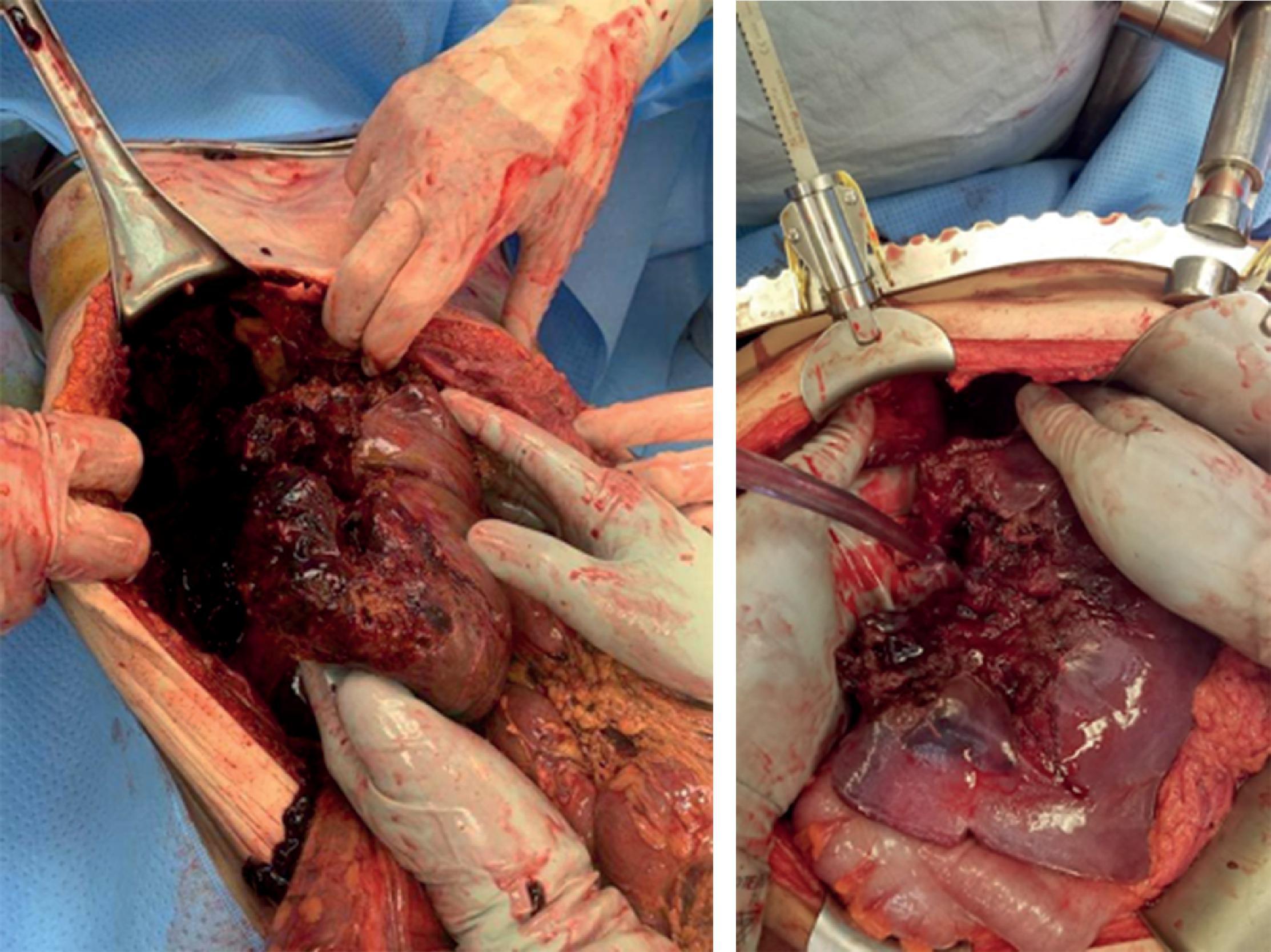
Formal hepatectomies can be considered if there is significant bleeding refractory to all other maneuvers but is avoided if possible. In the setting of trauma, with hemorrhage control as the primary goal, the liver parenchyma is highly forgiving to non-anatomic resection ( Fig. 5 ). Intraoperative consultation for angiography and possible embolization is a valuable adjunct to control intraparenchymal bleeding that is difficult to access surgically and should be considered early based on the injury complex and surgeon’s discretion.
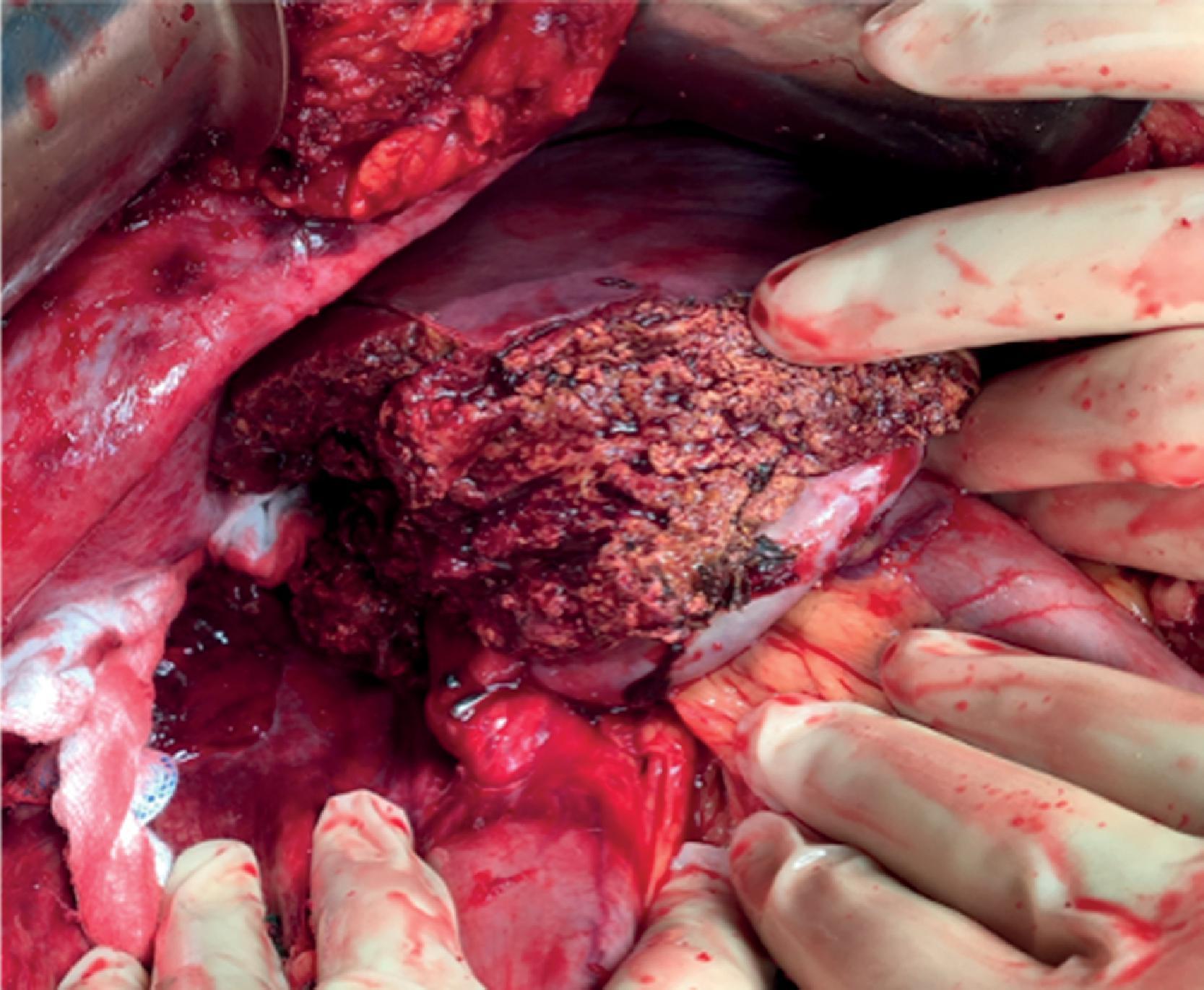
In uncontrolled hemorrhage, another useful adjunct is the Pringle maneuver, or compression of the portal triad, which includes the hepatic artery and portal vein ( Fig. 6 ). The portal triad can be encircled by entering the pars flaccida, or avascular caudal portion of the gastrohepatic ligament, followed by placement of a Rummel tourniquet or vascular clamp around the porta. The Pringle maneuver interrupts hepatic artery and portal vein flow to the liver. Cessation or slowing of ongoing hemorrhage using this maneuver can help identify the specific source of hemorrhage to allow a more controlled repair. The Pringle maneuver can result in significant ischemia to the liver, however, and interruption of flow should be minimized with a maximum occlusion time of 30 minutes.
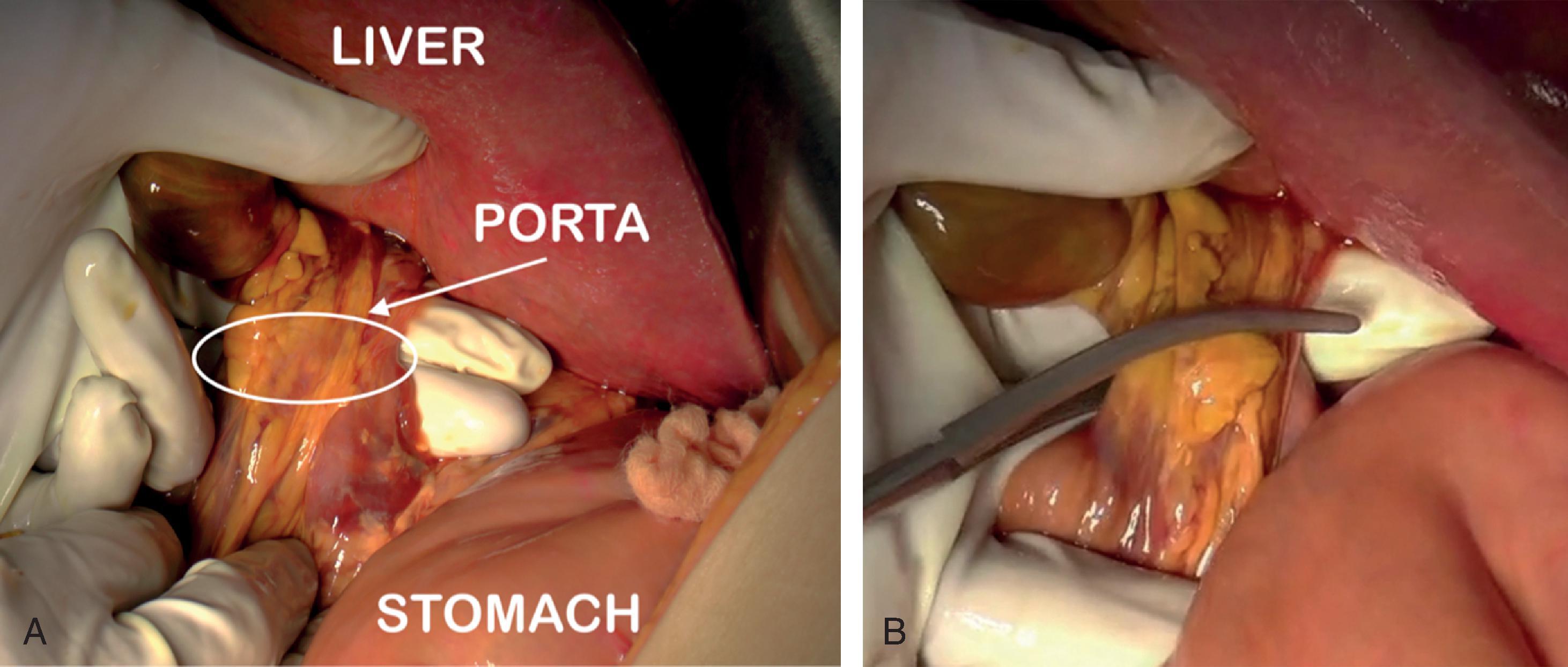
If the patient continues to bleed despite packing and a Pringle maneuver and significantly worsens with anterior mobilization of the liver, a retrohepatic vena cava injury is likely. These injuries are hard to identify and rapidly lethal so the surgeon’s index of suspicion must be high. To access these injuries, the liver must be freely mobilized, a dissection that will release any natural tamponade that existed with the liver attachments. After the falciform is divided, the left triangular ligament is divided to the anterior and posterior coronary ligaments with care to avoid the left hepatic vein. This mobilizes the left lobe of the liver and provides access to the supraceliac aorta. The right triangular ligament is then divided with the goal to medialize the whole right lobe of the liver. Freeing of these attachments should allow for significantly increased exposure and mobility of the liver. Care should be taken when mobilizing the liver as the accessory veins on the posterior surface of the liver are easily avulsed from the retrohepatic vena cava, resulting in prodigious bleeding.
To repair injuries to the retrohepatic IVC or the hepatic veins, additional interruption of blood flow is often required. Consideration of these approaches should occur before mobilization of the ligamentous attachments of the liver. Two options exist for this injury: total hepatic isolation or an atriocaval shunt. Although total hepatic vascular isolation is typically performed using traditional open techniques, endovascular approaches for several of the steps have been well described and should be considered if within the surgeon’s skillset. Total hepatic vascular isolation requires four sites of occlusion. First, the supraceliac aorta is occluded by mobilizing the left lobe of the liver and entering the retroperitoneum at the diaphragmatic hiatus. The esophagus is retracted to the patient’s left, and the aorta is identified on top of the vertebral body between the diaphragmatic crux. A vascular clamp can be used for interruption of the aorta. The second step is occlusion of the porta hepatis, described earlier as the Pringle maneuver. Finally, control of the infrahepatic and suprahepatic IVC is required. The suprarenal infrahepatic IVC is accessed via the Kocher maneuver. The suprahepatic IVC can be accessed by inferior retraction of the dome of the liver above the hepatic veins. In most patients, there is a 1- to 2-cm length of suprahepatic IVC that can be accessed from the intraabdominal approach. However, if the anatomy is not amenable or if there is significant ongoing bleeding obscuring visualization, the suprahepatic vena cava can be accessed via a right thoracotomy or a median sternotomy. If there is consideration for progressing to an atriocaval shunt, a median sternotomy should be considered early in the approach. Early and frequent communication with the anesthesiologist is imperative. Occluding blood flow return to the right atrium typically results in hemodynamic collapse, and ongoing aggressive resuscitation is needed.
To perform an atriocaval shunt, a 28Fr chest tube is prepared by cutting a side hole in the body of the tube at the level of the atrium ( Fig. 7 ). A clamp is placed above and below the newly placed hole. A purse-string suture is placed in the right atrial appendage, an incision is made, and the tube is passed through the atrium and fed down into the IVC. The first clamp is removed, and once the hole is at the level of the atrium and positioned for blood return, the purse-string suture is tightened. A Rummel tourniquet or vessel loop is used to secure the tube at the level of the supra and infrahepatic IVC, creating a shunt across the retrohepatic IVC and an opportunity for injury repair. The shunt should be removed as expeditiously as possible and blood flow restored.
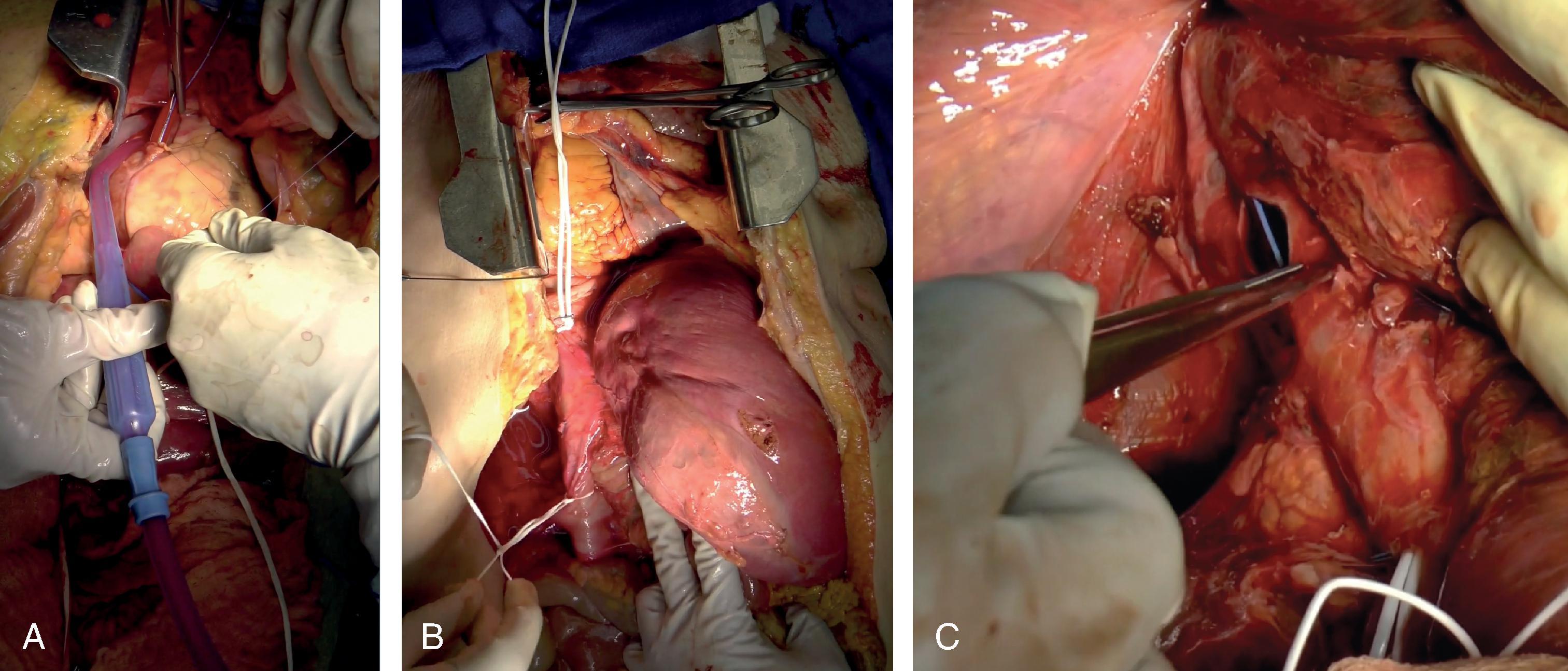
A final option in uncontrollable hemorrhage with complete destruction of the liver parenchyma is to perform a total hepatectomy with portocaval shunt and consider liver transplantation. This is rarely indicated and should only be considered at select centers with the expertise and immediate availability of transplant services.
In the setting of massive hemorrhage and severe liver trauma, damage-control techniques should be prioritized followed by continued resuscitation and warming in the ICU. Prolonged operative time is associated with poor outcomes as a result of irreversible coagulopathy and physiologic derangements.
Postoperatively, patients with significant liver injury should be taken to the ICU for further resuscitation. Monitoring of coagulopathy is crucial, and serial TEG is recommended for guidance of resuscitation. Patients who underwent damage-control laparotomy with temporary abdominal closure should plan to return to the operating room for reexploration in 24 to 48 hours. Any signs of ongoing hemorrhage in the ICU should prompt an earlier return to the operating room.
Severe liver injuries are associated with a high level of postinjury and postoperative complications. In the acute setting, profound coagulopathy from massive blood loss, resuscitation, as well as acute liver damage including ischemia reperfusion injury can occur. Patients require close monitoring with care placed on balanced resuscitation, attention to volume overload and underresuscitation, and appropriate hemodynamic control to maintain perfusion while avoiding vast swings in hemodynamics that might disturb the tenuous balance of hemostasis. Given the high incidence of biliary leaks, wide drainage is recommended after operative exploration before abdominal closure. In the setting of high-volume biliary leaks, early endoscopic retrograde cholangiopancreatography (ERCP) with possible stent placement should be considered. Other potential complications, particularly after high-grade injury, include pseudoaneurysm or hepatic arteriovenous fistulae formation. A CT angiogram is routinely performed 72 hours to 1 week after high-grade injuries to screen for this class of complications. Hepatic necrosis also occurs with high rates after angioembolization or surgical repair of high-grade liver injuries ( Fig. 8 ). Necrosis may manifest as high fevers, tachycardia, and/or leukocytosis and should be evaluated with cross-sectional imaging. Even severe necrosis can often be managed with percutaneous drainage; however, remnant necrotic tissue can lead to abdominal sepsis, and operative intervention may be required.
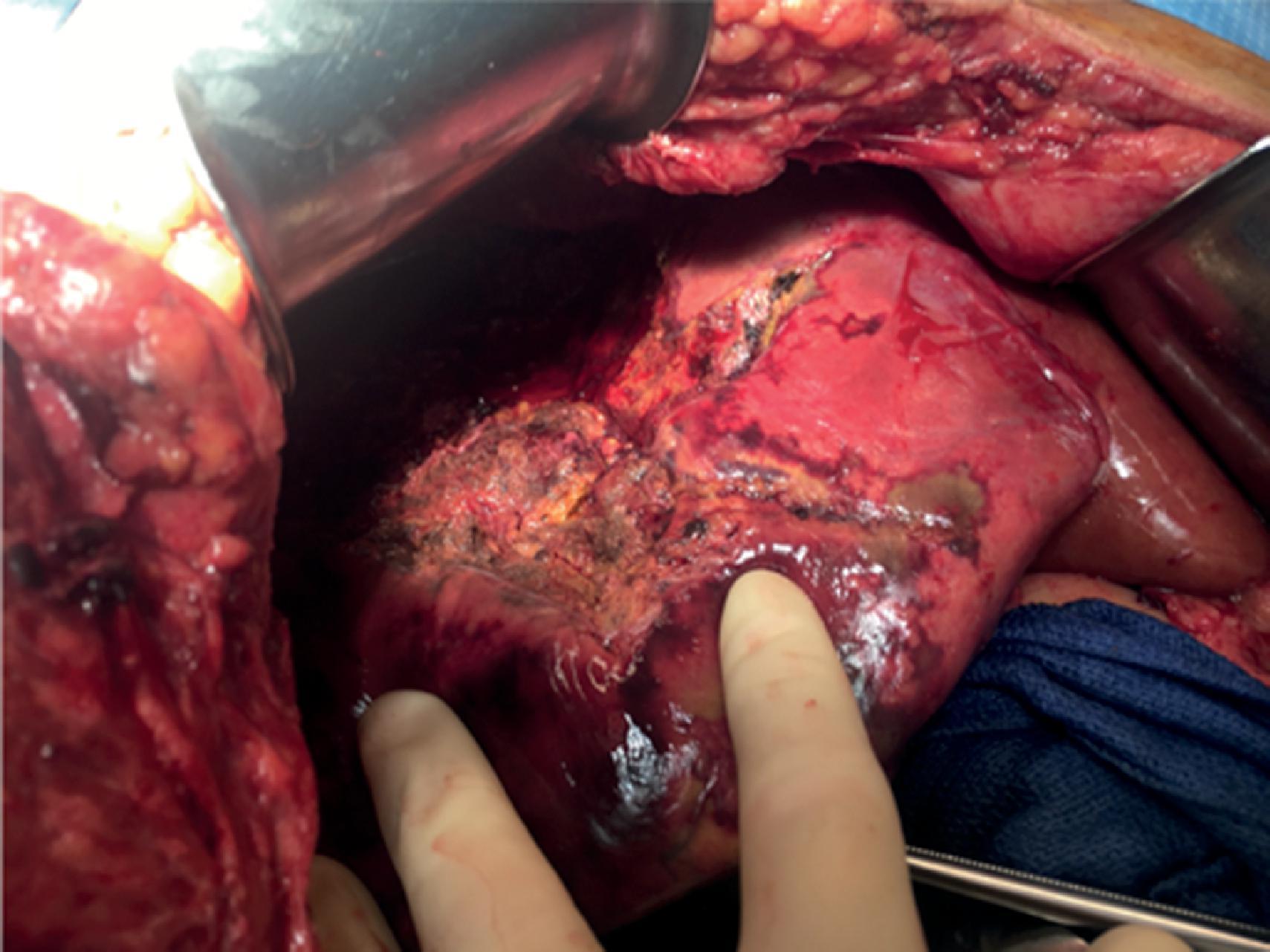
Management of traumatic liver injury encompasses a wide breadth of treatment modalities. The algorithm continues to evolve, with decision making based on the patient’s clinical status. In hemodynamically normal patients or transient responders with no other injuries requiring exploration, SNOM including evaluation with CT and possible angioembolization is now the standard of care. For hemodynamically unstable patients, surgery remains the gold standard. It is imperative that the surgeon has a depth of knowledge regarding hemostatic maneuvers and potential interventions as hepatic injuries can be rapidly lethal.
Trauma to the pancreas and duodenum remain some of the most challenging injuries to diagnose and manage in trauma. The advent of new imaging technologies such as magnetic resonance cholangiopancreatography (MRCP) and therapeutic options including endoscopic retrograde cholangiopancreatography (ERCP) have improved diagnosis and created minimally invasive techniques for management. Still, without a high index of suspicion for injury, delays occur and are common, which result in significant morbidity and mortality within this trauma population.
Become a Clinical Tree membership for Full access and enjoy Unlimited articles
If you are a member. Log in here